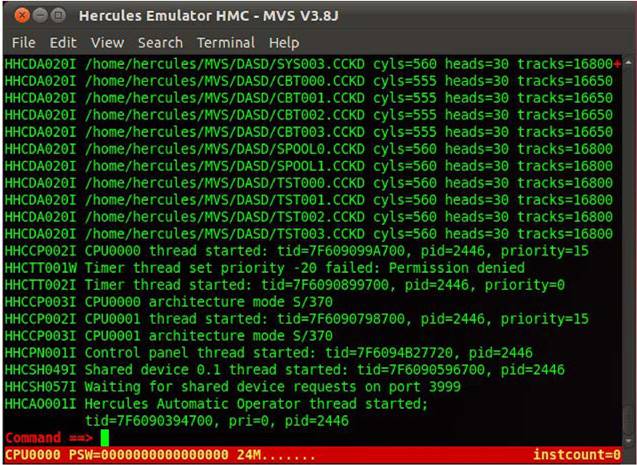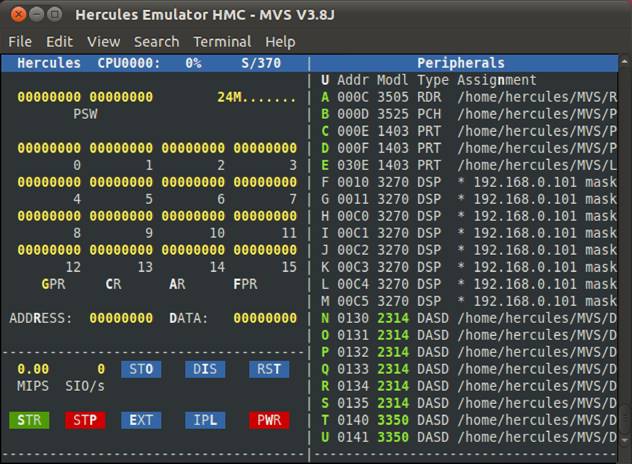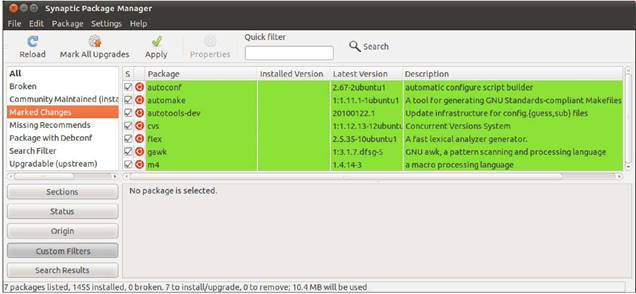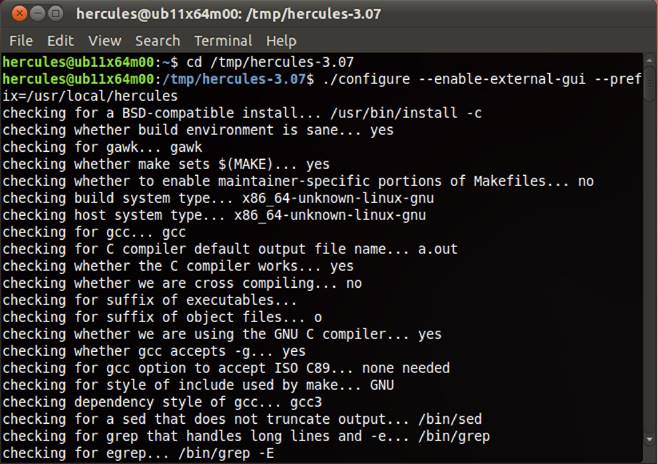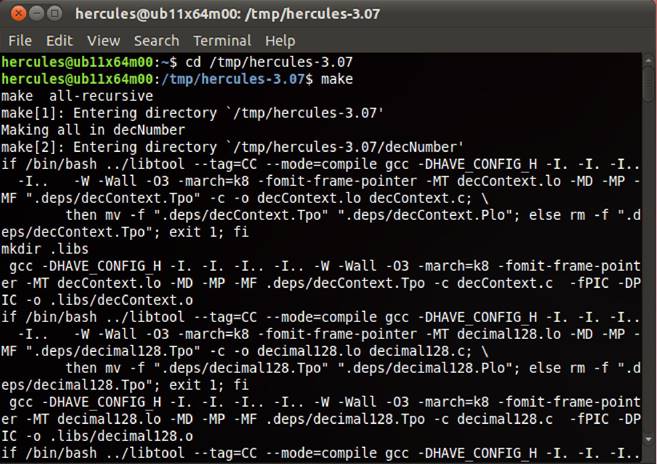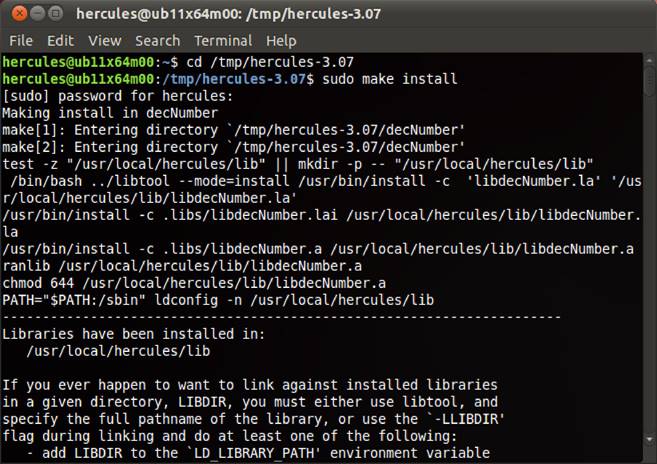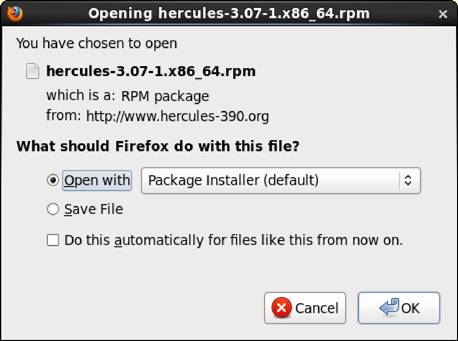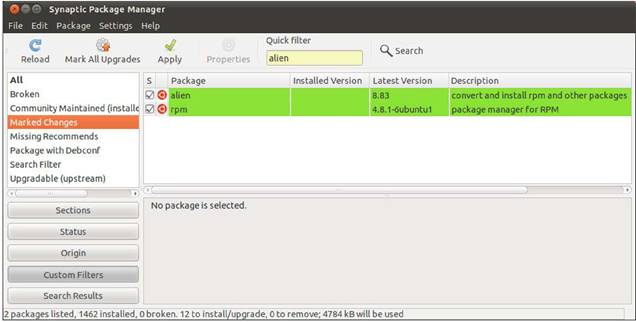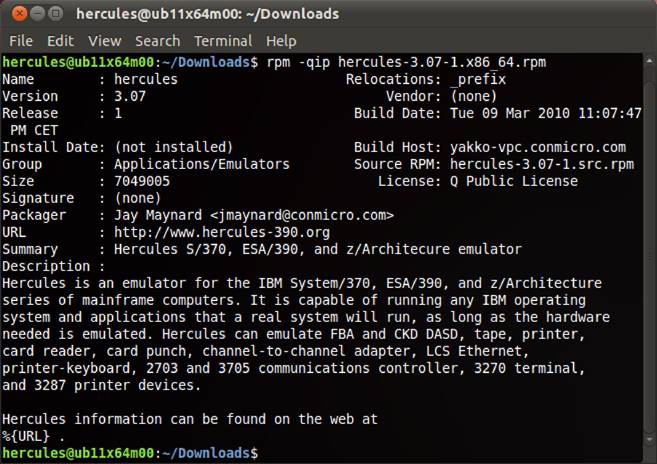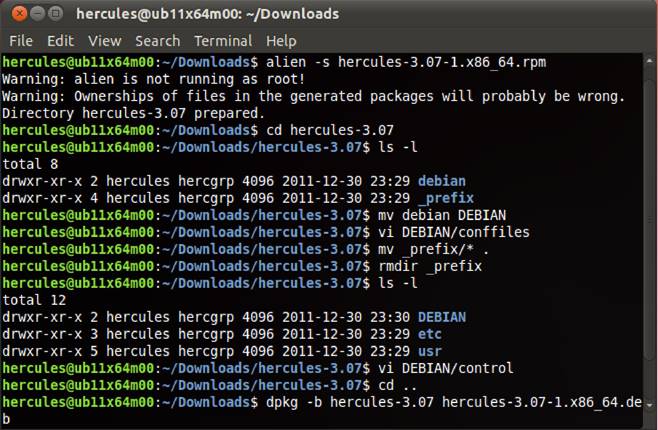Hercules V4.00.0 - Installation Guide - HEIG040000-00
Hercules System/370, ESA/390, z/Architecture Emulator
Hercules – Installation Guide
Version 4 Release 00
Draft - November 21, 2015
Hercules System/370, ESA/390, z/Architecture
Emulator
Hercules – Installation Guide
Version 4 Release 00
First Edition, November 21, 2015
HEIG040000-00
This edition applies to the Hercules S/370, ESA/390 and z/Architecture Emulator Release 4.00.0 and to all subsequent versions, releases and modifications until otherwise indicated in new editions. Make sure you are using the correct edition for the level of software you are using.
This book is a guide to installing the Hercules Emulator and related additional products (both required and optional) under the Microsoft Windows, Linux and Mac OS X operating systems. For guidance in operating or debugging Hercules or for a general overview additional manuals are available.
Please note that some information can be found in more than one manual. This redundancy is not intended to unnecessarily expand the manuals, rather to help to find all necessary information in one place.
This book is mainly intended for people who are responsible for installation and maintenance of the Hercules Emulator. It may also be useful if you are responsible for operating the Hercules Emulator.
 1.4 What you need to know to understand this book
1.4 What you need to know to understand this book
To understand this book you should be familiar with installing software under the Windows, Linux or Mac OS X operating systems. You should also have some experience in using command shells under the mentioned operating systems. Some knowledge of TCP/IP configuration in a small network is required to configure network connectivity.
Last but not least you should be familiar with IBM mainframe environments (hardware and software) and the underlying ideas and concepts as Hercules emulates IBM mainframe hardware.
This book is designed as a step by step installation guide for the Hercules Emulator and related products. You should go through the book chapter by chapter and follow all the instructions given. This should lead to an easy and fast installation without major problems.
Hercules Release: Version 4 Release 00 Modification 0
Publication Number: HEIG040000
SoftCopy Name: HerculesInstallation
Revision Number: HEIG040000-00
Date: November 21, 2015
If you like or dislike anything about this book please send an email to the address below. Feel free to comment on any errors or lack of clarity. Please limit your comments on the information in this specific book and also include the “Revision Notice” just above. Thank you for your help.
Send your
comments by email to the Hercules-390 discussion group:
<wrap>hercules-390@yahoogroups.com</wrap>
Hercules implements only the raw S/370, ESA/390, and z/Architecture instruction set, it does not provide any operating system facilities. This means that you need to provide an operating system or standalone program which Hercules can load from an emulated disk or tape device. You will have to write the operating system or standalone program yourself unless you possess a license from IBM to run one of their operating systems on your PC or use IBM programs and operating systems which have been placed in the public domain.
NOTE: It is YOUR responsibility to comply with the terms of the license for the operating system you intend to run on the Hercules Emulator.
The following is a list of trademark acknowledgments and copyright notices for product and company names mentioned in this book. Other product and company names in this book that are not listed below may be the trademarks or registered trademarks of their respective owners.
·IBM, System/370, ESA/390, z/Architecture, MVS, OS/390, z/OS, VM, VM/ESA, z/VM, VSE, VSE/ESA, z/VSE are trademarks or registered trademarks of International Business Machines Corporation (IBM).
·
|
Minimal
|
(minimum required equipment)
| |
·
|
Moderate
|
(average older PC equipment)
| |
·
|
Average
|
(typical current PC equipment)
| |
·
|
Good
|
(fast, newer PC environment)
| |
·
|
Optimal
|
(recommended server equipment for best performance)
|
It is possible to run Hercules with less than
the minimal recommended hardware but performance of any operating system
executing under the emulator will be severely constrained. For acceptable
performance you will need a configuration categorized as “average” or better.
If you have access to PC hardware categorized as “optimal” the performance of
installed OS’s will be adequate for most practical purposes.
Most modern PC systems are delivered with adequate RAM, Processor
and Disk for Hercules use. It has been stated in previous Hercules
documentation that a Pentium 200 MHz with 32 MB of RAM would be sufficient for
the emulator, however today such a system is no longer practical.
4.1.1 Processor
Hercules does not necessarily depend on the Intel Pentium architecture.
It also has been built, installed and run successfully on an Alpha 21164, SPARC
and on z/Architecture Linux/390 systems. One of the most extravagant
implementations for testing purposes has run OS/360 under Hercules under
Linux/390 under Hercules under Linux/390 under VM/ESA. This is of course an
extreme example of emulation layers. This document however only describes the
implementation of the Hercules Emulator on an Intel based or compatible PC
system.
Hercules will benefit greatly from a fast processor, the faster
the processor the better Hercules will run. If you can employ a multiprocessor
or dual-core system, so much the better. The Hercules Emulator makes extensive
use of multithreading to overlap I/O with CPU activity. A multiprocessor board with
two slower processors will in most cases outperform a uniprocessor board with a
faster processor.
·Pentium with 500 MHz or equivalent processor (minimal)
·Pentium with 1 GHz or equivalent processor (moderate)
·Pentium with 2 GHz or equivalent processor (average)
·Pentium with 3 GHz (Dual or Quad Core) or equivalent processor
(good)
·2 or more Pentium Quad Core processors with 2.66 GHz or equivalent
processors (optimal)
4.1.2 RAM
The more
RAM installed in the system the better Hercules will perform. For maximum
throughput you should set your main and expanded storage sizes in the Hercules
configuration file high enough to eliminate installed operating system paging
operations as much as possible. The S/390 guest system storage is allocated out
of the Linux or Windows host operating system storage so try to provide enough
RAM to your system to eliminate Linux or Windows paging as well.

·128 MB RAM (minimal)
·512 MB RAM (moderate)
·1024 MB RAM (average)
·2048 MB RAM (good)
·4096 MB RAM (optimal)
There is a limit to the memory that the
32-bit version of Hercules can allocate under Windows (usually around 1 GB),
therefore normally 2 GB of installed RAM in the machine should be sufficient to
allow for both Hercules and the host OS. If however you plan to run more than
one instance of Hercules on the same machine, each instance can allocate 1 GB
of RAM for its own use. In this case it makes sense to install more than 2 GB
RAM. This limitation does not apply when using the 64-bit version of Hercules.
Please note that you still can allocate more RAM than is
physically available on the PC to the Hercules emulator for use of the
installed operating system(s). But in this case the Linux or Windows host operating
system has to page out the missing physical RAM to its own swap files which
will seriously degrade Hercules performance.
4.1.3 Disk Storage
The disk storage requirements for Hercules depend entirely on your
requirements. The runtime Hercules system requires only small amount of disk
space. You will need a little more space if you plan to build Hercules from
source code. But still the requirements are quiet modest.
Although Hercules and the necessary software components do not
require very much disk storage, you need enough hard disk space to accommodate
the emulated DASD volumes for the operating system you choose to run under
Hercules.
For a minimal z/OS system with CICS, IMS, DB2, WAS etc., without
any user data, you need at least 15 disks of type 3390 model 3 which requires
42.5 GB hard disk space. If you extend such a system with some user data for
software development etc. you may need 10 to 15 additional 3390 model 3 disks.
This could lead to a total hard disk requirement of 85 GB. If you plan to do
uncompressed backups of all the DASD volumes you can double this number.
The
following table shows how much space is occupied for each virtual DASD volume
on your PC hard disk(s) for some of the supported device types. If you make use
of the compressed CKD DASD feature of Hercules these sizes will shrink
dramatically, usually to about 20 to 30 percent of the original size. Space
savings depend on the actual used capacity within the virtual DASD volumes.

|
Model
|
Cylinder
|
Bytes/Track
|
Bytes/Cylinder
|
Bytes/Volume
| |
3380-J
|
885
|
47’476
|
712’140
|
630 MB
| |
3380-E
|
1’770
|
47’476
|
712’140
|
1.26GB
| |
3380-K
|
2’665
|
47’476
|
712’140
|
1.89 GB
| |
3390-1
|
1’113
|
56’664
|
849’960
|
946 MB
| |
3390-2
|
2’226
|
56’664
|
849’960
|
1.89GB
| |
3390-3
|
3’339
|
56’664
|
849’960
|
2.83 GB
| |
3390-9
|
10’017
|
56’664
|
849’960
|
8.51 GB
| |
3390-27
|
32’760
|
56’664
|
849’960
|
27.84 GB
| |
3390-54
|
65'520
|
56'664
|
849'960
|
55.68 GB
| |
9345-1
|
1’440
|
46’456
|
849’960
|
1.0 GB
| |
9345-2
|
2’156
|
46’456
|
849’960
|
1.5 GB
|
Table 1:
DASD Device Capacity

 5. Performance
As described previously the performance of the Hercules Emulator
depends heavily on the underlying PC hardware. It is therefore not possible to
give exact performance specifications of any particular operating system
running under Hercules. Some practical values from user experiences across
several machines presented here provide some guidelines though.
The
performance of Hercules is measured in two values, MIPS and I/O rate. Both of
these values are presented on the Hercules console and are refreshed every
second independently of the PANRATE control statement. See Hercules User
Reference for details on the PANRATE statement.
5. Performance
As described previously the performance of the Hercules Emulator
depends heavily on the underlying PC hardware. It is therefore not possible to
give exact performance specifications of any particular operating system
running under Hercules. Some practical values from user experiences across
several machines presented here provide some guidelines though.
The
performance of Hercules is measured in two values, MIPS and I/O rate. Both of
these values are presented on the Hercules console and are refreshed every
second independently of the PANRATE control statement. See Hercules User
Reference for details on the PANRATE statement.
 5.1 MIPS
MIPS is an abbreviation of “Million Instructions Per Second” and
presents a measure of the number of instructions the CPU is executing in one
second. MIPS is a measure of a computer's processor speed. However this measure
is useful only among processors with the same instruction set as different
instruction sets take different numbers of instructions to do the same job.
Many of the reported MIPS values represent 'Peak' execution rates on artificial
instruction sequences with few branches, whereas realistic workloads consist of
a mix of instructions some of which take longer to execute than others.
The performance of the memory hierarchy greatly affects processor
performance, an issue also not considered in simple MIPS comparisons. In an
attempt to address these issues researchers have created standardized tests
such as “SpecInt” to measure the real effective performance in
commonly used applications. The use of raw MIPS as a measure of overall system
performance has fallen into disuse. MIPS is sometimes pejoratively referred to
as “Meaningless Indicator of Processor Speed” or “Meaningless
Information Provided by Salespeople”.
The
Hercules console reports the MIPS rate for the emulated S/370, ESA/390 or
z/Architecture instructions, not the underlying executed instructions of the
hardware. As implied previously the MIPS rate can vary significantly depending
on the executed instruction and whether the instructions can be processed
entirely in cache, as can happen in a tight loop.
It is difficult to determine how the speed of the Hercules
emulation corresponds to a real mainframe. This is due to difficulties in
comparing real mainframe hardware to PCs (or servers) as well as the actual performance
measurement itself. Hercules shows its processing speed in MIPS. Compared to
the earlier IBM System/360 and System/370 hardware, it is safe to say that
Hercules will outperform them when it is running on moderately powerful
hardware, whereas newer IBM System/390 and z/Series hardware still is much
faster than the emulation.
On a Celeron 300 you should see an execution speed of 1 to 2 MIPS,
which is enough to run OS/360 (MFT or MVT) or MVS 3.8 with a response time
better than that of a 3033 from the 1970's. It's also fast enough to run
VSE/ESA with an acceptable response time. On a more recent system with a 2 GHz
Pentium processor, you may see the system peak at around 30 MIPS which is
enough to run Linux/390 or z/OS with a light workload.
Performance on server class machines is now fairly respectable.
For example, on a dual-core Intel Xeon with “Hyperthreading” (4 CPUs)
running at 3.46 GHz, you might expect to see a sustained MIPS rate of 40 to 60
MIPS. A dual-processor quad-core Mac Pro (8 cores, 3 GHz) will sustain over 150
MIPS. For anyone who is prepared to spend a considerable amount of money on
their Hercules system, there are reports that a sustained 300+ MIPS rate has
been achieved on an Intel Core i7 processor running at 3.75 GHz using all four
cores plus “Hyperthreading” (8 CPUs).
The speed
however depends greatly on the executed instructions. Instructions that are
very expensive to emulate can even on fast systems still be around 1 - 2 MIPS,
see the tables further below for details.
5.1 MIPS
MIPS is an abbreviation of “Million Instructions Per Second” and
presents a measure of the number of instructions the CPU is executing in one
second. MIPS is a measure of a computer's processor speed. However this measure
is useful only among processors with the same instruction set as different
instruction sets take different numbers of instructions to do the same job.
Many of the reported MIPS values represent 'Peak' execution rates on artificial
instruction sequences with few branches, whereas realistic workloads consist of
a mix of instructions some of which take longer to execute than others.
The performance of the memory hierarchy greatly affects processor
performance, an issue also not considered in simple MIPS comparisons. In an
attempt to address these issues researchers have created standardized tests
such as “SpecInt” to measure the real effective performance in
commonly used applications. The use of raw MIPS as a measure of overall system
performance has fallen into disuse. MIPS is sometimes pejoratively referred to
as “Meaningless Indicator of Processor Speed” or “Meaningless
Information Provided by Salespeople”.
The
Hercules console reports the MIPS rate for the emulated S/370, ESA/390 or
z/Architecture instructions, not the underlying executed instructions of the
hardware. As implied previously the MIPS rate can vary significantly depending
on the executed instruction and whether the instructions can be processed
entirely in cache, as can happen in a tight loop.
It is difficult to determine how the speed of the Hercules
emulation corresponds to a real mainframe. This is due to difficulties in
comparing real mainframe hardware to PCs (or servers) as well as the actual performance
measurement itself. Hercules shows its processing speed in MIPS. Compared to
the earlier IBM System/360 and System/370 hardware, it is safe to say that
Hercules will outperform them when it is running on moderately powerful
hardware, whereas newer IBM System/390 and z/Series hardware still is much
faster than the emulation.
On a Celeron 300 you should see an execution speed of 1 to 2 MIPS,
which is enough to run OS/360 (MFT or MVT) or MVS 3.8 with a response time
better than that of a 3033 from the 1970's. It's also fast enough to run
VSE/ESA with an acceptable response time. On a more recent system with a 2 GHz
Pentium processor, you may see the system peak at around 30 MIPS which is
enough to run Linux/390 or z/OS with a light workload.
Performance on server class machines is now fairly respectable.
For example, on a dual-core Intel Xeon with “Hyperthreading” (4 CPUs)
running at 3.46 GHz, you might expect to see a sustained MIPS rate of 40 to 60
MIPS. A dual-processor quad-core Mac Pro (8 cores, 3 GHz) will sustain over 150
MIPS. For anyone who is prepared to spend a considerable amount of money on
their Hercules system, there are reports that a sustained 300+ MIPS rate has
been achieved on an Intel Core i7 processor running at 3.75 GHz using all four
cores plus “Hyperthreading” (8 CPUs).
The speed
however depends greatly on the executed instructions. Instructions that are
very expensive to emulate can even on fast systems still be around 1 - 2 MIPS,
see the tables further below for details.

 5.2 I/O Rate
The second value that gives us performance data is the I/O rate.
This is the average number of SIOs (Start I/O per second) occurring to active
devices, including DASD, TAPE, CTC (channel-to channel adaptor), local SNA and
non-SNA devices etc.
This value also varies depending on the underlying hardware. A
RAID system will easily outperform a non-RAID system. Many PC systems today can
be ordered with a RAID-0 (Striping) or RAID-1 (Mirroring) adapter. While disk
mirroring (RAID-1) gives fault tolerance it does not improve performance.
However Data striping (RAID-0) spreads blocks of each file across multiple
disks and can nearly double the performance of a single disk.
On a recent PC system as described above, incorporating two Serial-ATA
(SATA) disk drives connected to a RAID adapter card with activated RAID-0 has
shown peak I/O rates of more than 3250 SIOs per second. The sustained I/O rate
delivered from such a system was more than 1500 SIOs per second.
5.2 I/O Rate
The second value that gives us performance data is the I/O rate.
This is the average number of SIOs (Start I/O per second) occurring to active
devices, including DASD, TAPE, CTC (channel-to channel adaptor), local SNA and
non-SNA devices etc.
This value also varies depending on the underlying hardware. A
RAID system will easily outperform a non-RAID system. Many PC systems today can
be ordered with a RAID-0 (Striping) or RAID-1 (Mirroring) adapter. While disk
mirroring (RAID-1) gives fault tolerance it does not improve performance.
However Data striping (RAID-0) spreads blocks of each file across multiple
disks and can nearly double the performance of a single disk.
On a recent PC system as described above, incorporating two Serial-ATA
(SATA) disk drives connected to a RAID adapter card with activated RAID-0 has
shown peak I/O rates of more than 3250 SIOs per second. The sustained I/O rate
delivered from such a system was more than 1500 SIOs per second.
 5.3 Hercules Performance Measurements
The following sections show some performance index tables under
various system configurations. Individual measured performance may vary from
the figures shown as performance depends heavily on the hardware used and the
Hercules release level.
All tests
have been performed with the following measurement tools:
·IMON (Rate CPU Instruction Speed)
·CPU Instruction Timing Tool (INSTRATE program)
Tests showing the performance of Hercules itself include
measurements of the Hercules Emulator software and the difference between
working with CKD or CCKD (compressed CKD) DASD emulation. Other tests, like the
host CPU on which Hercules runs or the disk types of the host system, show the
influence of the hardware used. The last test (“Hercules Overall
Performance”) represents the practical performance growth of the Hercules
Emulator as both hardware and software have improved.
5.3.1 Hercules Emulator Performance
The following diagram shows the software related performance index
of the Hercules Emulator software. The graphic shows the performance
improvements that have been made over recent releases. The base version (index
= 100%) for all measurements was Hercules V3.00.
All these tests were performed using the same hardware configuration.
The results therefore demonstrate the influence of the improvements in the
performance of the Hercules Emulator software only.
5.3 Hercules Performance Measurements
The following sections show some performance index tables under
various system configurations. Individual measured performance may vary from
the figures shown as performance depends heavily on the hardware used and the
Hercules release level.
All tests
have been performed with the following measurement tools:
·IMON (Rate CPU Instruction Speed)
·CPU Instruction Timing Tool (INSTRATE program)
Tests showing the performance of Hercules itself include
measurements of the Hercules Emulator software and the difference between
working with CKD or CCKD (compressed CKD) DASD emulation. Other tests, like the
host CPU on which Hercules runs or the disk types of the host system, show the
influence of the hardware used. The last test (“Hercules Overall
Performance”) represents the practical performance growth of the Hercules
Emulator as both hardware and software have improved.
5.3.1 Hercules Emulator Performance
The following diagram shows the software related performance index
of the Hercules Emulator software. The graphic shows the performance
improvements that have been made over recent releases. The base version (index
= 100%) for all measurements was Hercules V3.00.
All these tests were performed using the same hardware configuration.
The results therefore demonstrate the influence of the improvements in the
performance of the Hercules Emulator software only.

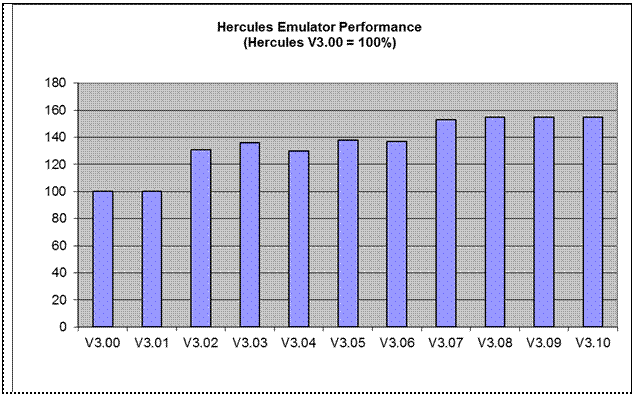 Figure 1: Hercules Emulator
Performance
Although there have been massive performance improvements in the
Hercules Emulator software in recent releases, the current rate of improvement
cannot be expected to continue. On one hand, the maximum performance
improvements available via software improvements will be reached, on the other
hand the developers of Hercules have architectural frameworks that impose
certain limitations, as explained below.
Firstly the Hercules software should be portable and is therefore
written entirely in “C”. The use of assembler to give additional
performance is not exploited. Secondly the developers try to emulate real
hardware as exactly as possible in accordance with IBM's “Principles of
Operations” documentation. This leads to code that may be not optimal for the
underlying hardware, but provides perfect emulation of real mainframe
hardware, avoiding problems when running mainframe operating systems.
The performance of the Hercules Emulator software depends heavily
on the set of executed (mainframe) instructions as detailed in below
(“Emulated Instruction Performance”).
5.3.2 Emulated CKD / CCKD DASD Performance
The type of the emulated DASD devices, either CKD or CCKD, has
direct influence on performance. If using CKD devices there is more data to be
read from the disk and transferred to memory, but the data is directly usable,
and no further processing needs to be done. Using CCKD (compressed CKD) devices
the amount of data to be read from the disk and transferred to memory is
greatly reduced but once in memory the data has to be uncompressed before it
can be processed.
The performance characteristics of DASD types are irrelevant if
host disk space limitations impose the choice of using compressed CKD only.
On a fast machine with fast disks CKD is the best choice. On a fast CPU
with slow disks however, CCKD can give better overall performance. A fast
processor can uncompress the data in less time than that saved by transferring
the data uncompressed. In the less common case of a slow CPU with fast disks
Figure 1: Hercules Emulator
Performance
Although there have been massive performance improvements in the
Hercules Emulator software in recent releases, the current rate of improvement
cannot be expected to continue. On one hand, the maximum performance
improvements available via software improvements will be reached, on the other
hand the developers of Hercules have architectural frameworks that impose
certain limitations, as explained below.
Firstly the Hercules software should be portable and is therefore
written entirely in “C”. The use of assembler to give additional
performance is not exploited. Secondly the developers try to emulate real
hardware as exactly as possible in accordance with IBM's “Principles of
Operations” documentation. This leads to code that may be not optimal for the
underlying hardware, but provides perfect emulation of real mainframe
hardware, avoiding problems when running mainframe operating systems.
The performance of the Hercules Emulator software depends heavily
on the set of executed (mainframe) instructions as detailed in below
(“Emulated Instruction Performance”).
5.3.2 Emulated CKD / CCKD DASD Performance
The type of the emulated DASD devices, either CKD or CCKD, has
direct influence on performance. If using CKD devices there is more data to be
read from the disk and transferred to memory, but the data is directly usable,
and no further processing needs to be done. Using CCKD (compressed CKD) devices
the amount of data to be read from the disk and transferred to memory is
greatly reduced but once in memory the data has to be uncompressed before it
can be processed.
The performance characteristics of DASD types are irrelevant if
host disk space limitations impose the choice of using compressed CKD only.
On a fast machine with fast disks CKD is the best choice. On a fast CPU
with slow disks however, CCKD can give better overall performance. A fast
processor can uncompress the data in less time than that saved by transferring
the data uncompressed. In the less common case of a slow CPU with fast disks

CKD DASD
can perform better as the uncompressed data is transferred faster than the
processor could uncom press it. In the case of a slow machine with slow disks
and possibly space constraints it is recommended to work with CCKD DASD.
Another point to consider is reliability. Although Hercules itself
is very stable, occasional machine crashes such as the Windows “Blue
Screen of Death” can occur. The CKD DASD emulation in these cases is very
stable; it is usually possible to just restart the machine with no problems.
However when working with CCKD DASD emulation, after a crash the CCKD routines
have to perform a recovery during the restart of Hercules. This recovery takes
from seconds to several minutes depending on what happened and the number of
defined DASD devices. Although this recovery is normally successful cases have
been reported where the recovery failed. In this case the only option is to
restore DASD images from previously saved backups.
The
following figure shows a performance comparison of compressed DASD (CCKD)
versus CKD devices. The IPL time with CKD devices was 75 seconds. The IPL time
with CCKD devices is only slightly higher (about 80 seconds).
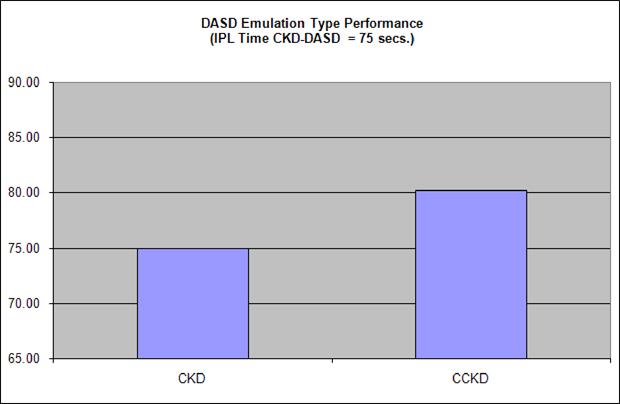 Figure 2:
DASD Emulation Type Performance
Both tests were performed on the same machine (2 x Opteron 280,
2.4 GHz with a Software RAID-0 hard disk configuration). The measured
performance degradation using CCKD emulation over CKD is only approximately 7.0
percent.
5.3.3 Host CPU Performance
The
following diagram shows the CPU related performance results for Hercules. The
base CPU at index = 100% is an Intel Pentium 3 with 500 MHz clock speed.
Figure 2:
DASD Emulation Type Performance
Both tests were performed on the same machine (2 x Opteron 280,
2.4 GHz with a Software RAID-0 hard disk configuration). The measured
performance degradation using CCKD emulation over CKD is only approximately 7.0
percent.
5.3.3 Host CPU Performance
The
following diagram shows the CPU related performance results for Hercules. The
base CPU at index = 100% is an Intel Pentium 3 with 500 MHz clock speed.

All these
tests were performed with the same Hercules release (V3.05) and therefore show
only the influence on performance of the real CPU and I/O devices.
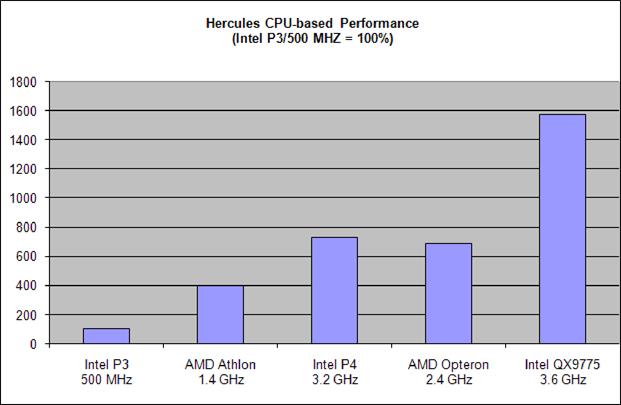 Figure 3:
Hercules CPU-based Performance
The figures shown above are influenced by
the I/O configuration used. As mainframe operating systems running under
Hercules are often heavily I/O based, bare CPU speed is not the only relevant
performance factor. An additional performance boost is achieved using RAID-0
striping and / or using several physical disks in the host system under which
the emulator is running, as discussed in the following section.
5.3.4 Host Disk Performance
The
following table shows the different disk and controller configurations that
have been used for testing the disk transfer rates. The comparison of the
reached transfer rates is visualized in the figure following the configurations
table.
Figure 3:
Hercules CPU-based Performance
The figures shown above are influenced by
the I/O configuration used. As mainframe operating systems running under
Hercules are often heavily I/O based, bare CPU speed is not the only relevant
performance factor. An additional performance boost is achieved using RAID-0
striping and / or using several physical disks in the host system under which
the emulator is running, as discussed in the following section.
5.3.4 Host Disk Performance
The
following table shows the different disk and controller configurations that
have been used for testing the disk transfer rates. The comparison of the
reached transfer rates is visualized in the figure following the configurations
table.

|
Test Scenarios
|
Scenario 1
|
Scenario 2
|
Scenario 3
|
Scenario 4
| |
Disk Type
|
Western Digital WD1500ADFD
|
Western Digital WD1500ADFD
|
Hitachi Ultrastar 15k300
|
Hitachi Ultrastar 15k300
| |
Disk Controller
|
Nvidia
nForce4 SATA
|
Nvidia
nForce4 SATA
|
Adaptec RAID 3405
|
Adaptec RAID 3405
| |
RAID
Configuration
|
none
|
RAID-0
|
none
|
RAID-0
|
Table 2:
Disk Configurations
These
configurations reached the transfer rates as shown in the following figure.
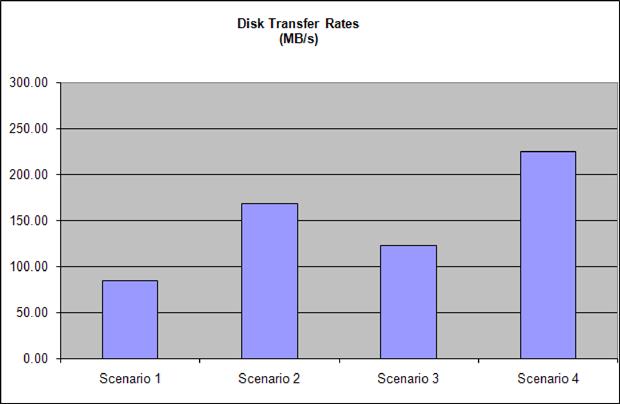 Figure 4:
Disk Transfer Rates
While these
measurements only show the “raw speed” of the disks without direct relationship
to Hercules, the next diagram shows the impact on the IPL time depending on the
used disk configuration. Both tests have been run using the same hardware (2 x
AMD Opteron 280, 2.4 GHz), the only change being the type of disk employed.
Figure 4:
Disk Transfer Rates
While these
measurements only show the “raw speed” of the disks without direct relationship
to Hercules, the next diagram shows the impact on the IPL time depending on the
used disk configuration. Both tests have been run using the same hardware (2 x
AMD Opteron 280, 2.4 GHz), the only change being the type of disk employed.

The first
test was made with a non-RAID disk configuration (Scenario 1, see above) which
reached a transfer rate of 85 MB/s. The second IPL was done with a RAID-0 disk
configuration (Scenario 2, see above) with a transfer rate of 169 MB/s. The IPL
with the RAID-0 disk configuration needed only 75 seconds compared to 81
seconds with the non-RAID setup.
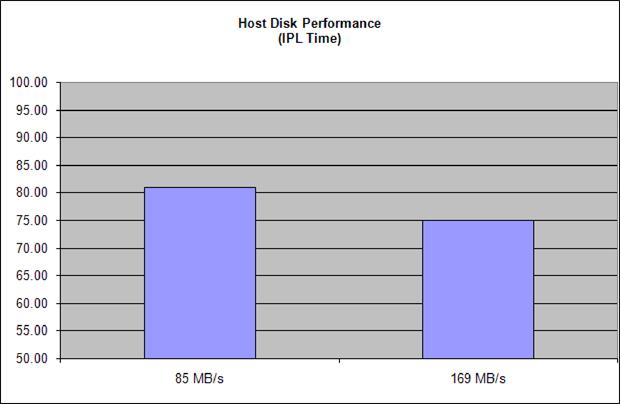 Figure 5:
Host Disk Performance (IPL in seconds)
These tests demonstrate that fast disks and RAID-0 configurations
provide a performance boost from which Hercules will benefit.
5.3.5 Emulated Instruction Performance
As previously stated, Hercules Emulator
performance depends heavily on the mainframe instructions being executed. While
some S/3xx instructions are relatively easy to implement and require only a few
“C” instructions in the emulator, others are quite complicated and
require a lot of instructions to emulate the real hardware. Due to this fact
the performance of each individual S/3xx instruction can vary greatly. There is
a variance of more than 450 times between the fastest and slowest emulated
instructions.
It is known though, that in mainframe operating systems, a small
subset of the available instructions are employed to do most processing. In
Hercules, if most of these instructions are emulated slowly, the overall
performance of the emulator will be poor. Alternatively, if the most commonly
used instructions are emulated quickly the performance of the emulator will
benefit greatly.
An analysis
of mainframe operating systems has shown that only 5 different instructions are
responsible for up to 50% of the executed code. Expanding this analysis to
10-15 instructions will cover up to 75% of executed code and 15-20 instructions
will cover more than 80% of all mainframe code.
Figure 5:
Host Disk Performance (IPL in seconds)
These tests demonstrate that fast disks and RAID-0 configurations
provide a performance boost from which Hercules will benefit.
5.3.5 Emulated Instruction Performance
As previously stated, Hercules Emulator
performance depends heavily on the mainframe instructions being executed. While
some S/3xx instructions are relatively easy to implement and require only a few
“C” instructions in the emulator, others are quite complicated and
require a lot of instructions to emulate the real hardware. Due to this fact
the performance of each individual S/3xx instruction can vary greatly. There is
a variance of more than 450 times between the fastest and slowest emulated
instructions.
It is known though, that in mainframe operating systems, a small
subset of the available instructions are employed to do most processing. In
Hercules, if most of these instructions are emulated slowly, the overall
performance of the emulator will be poor. Alternatively, if the most commonly
used instructions are emulated quickly the performance of the emulator will
benefit greatly.
An analysis
of mainframe operating systems has shown that only 5 different instructions are
responsible for up to 50% of the executed code. Expanding this analysis to
10-15 instructions will cover up to 75% of executed code and 15-20 instructions
will cover more than 80% of all mainframe code.

The
following tables list some different test scenarios and the performance ratios
of individual instructions and real work tests under the Hercules Emulator. The
used hardware for each scenario is listed in the following table. All test jobs
have been run three times under each scenario. The average MIPS rate of these
three runs has been taken into the table.
These tests
are not meant to provide a definitive MIPS rating (your own measurements may be
somewhat different), but serve as a repeatable test for comparing the relative
speeds of different hardware.
|
Test Scenarios
|
Scenario 1
|
Scenario 2
|
Scenario 3
| |
PC Model (month/year)
|
08/2003
|
09/2006
|
06/2008
| |
CPU Type
|
Intel Pentium P4
|
AMD Opteron 280
|
Intel QX9775 EE
| |
CPU Clock Rate
|
3.2 GHz
|
2.4 GHz
|
3.6 GHz
| |
Number of
physical CPUs
|
1
|
2
|
2
| |
Number of CPU
Cores
|
2
|
4
|
8
| |
RAM
|
2 GB
|
8 GB
|
8 GB
| |
Operating System
|
Windows XP Pro
|
Windows XP Pro x64
|
Windows XP Pro x64
| |
Hercules Release
|
V 3.05
|
V 3.05
|
V 3.05
| Table 3: Performance Test Scenarios The first table of performance results shows the reachable MIPS rates of various single instructions. The test is based on a modified INSTRATE program, originally written by Gary Brabiner. |
Executed Instruction
||
Scenario 1
||
Scenario 2
||
Scenario 3
| | |
BCT
|
Rx,LOOP
|
99.55
|
MIPS
|
84.06
|
MIPS
|
82.14
|
MIPS
| |
BCTR
|
RX,RLOOP
|
109.10
|
MIPS
|
93.86
|
MIPS
|
137.74
|
MIPS
| |
NOP
|
R0
|
154.84
|
MIPS
|
144.52
|
MIPS
|
431.59
|
MIPS
| |
LR
|
R1,R0
|
66.33
|
MIPS
|
58.07
|
MIPS
|
101.75
|
MIPS
| |
LTR
|
R1,R0
|
64.76
|
MIPS
|
58.12
|
MIPS
|
102.03
|
MIPS
| |
L
|
R1,0
|
10.09
|
MIPS
|
12.43
|
MIPS
|
18.97
|
MIPS
| |
L
|
R1,DATA
|
39.00
|
MIPS
|
33.87
|
MIPS
|
42.65
|
MIPS
| |
L
|
R1,DATA+1
|
37.95
|
MIPS
|
33.44
|
MIPS
|
41.11
|
MIPS
Executed Instruction
||
Scenario 1
||
Scenario 2
||
|
Scenario 3
| | |
LH
|
R1,DATA
|
37.74
|
MIPS
|
33.93
|
MIPS
|
|
49.96
|
MIPS
| |
ICM
|
R1,15,DATA
|
35.50
|
MIPS
|
33.85
|
MIPS
|
|
39.89
|
MIPS
| |
ICM
|
R1,1,DATA
|
20.28
|
MIPS
|
20.96
|
MIPS
|
|
29.53
|
MIPS
| |
IC
|
R1,DATA
|
37.59
|
MIPS
|
33.77
|
MIPS
|
|
51.27
|
MIPS
| |
LD
|
F0,DATA
|
13.95
|
MIPS
|
25.23
|
MIPS
|
|
51.50
|
MIPS
| |
LM
|
8,6,SAVEREGS+(8*4)
|
18.78
|
MIPS
|
17.98
|
MIPS
|
|
19.34
|
MIPS
| |
STM
|
1,14,DATA
|
24.01
|
MIPS
|
19.21
|
MIPS
|
|
20.12
|
MIPS
| |
ST
|
R1,DATA
|
37.77
|
MIPS
|
32.91
|
MIPS
|
|
44.73
|
MIPS
| |
STH
|
R1,DATA
|
36.84
|
MIPS
|
34.04
|
MIPS
|
|
44.61
|
MIPS
| |
STCM
|
R1,15,DATA
|
35.87
|
MIPS
|
28.04
|
MIPS
|
|
40.87
|
MIPS
| |
STCM
|
R1,1,DATA
|
22.51
|
MIPS
|
19.59
|
MIPS
|
|
36.65
|
MIPS
| |
STCM
|
R1,8,DATA
|
23.05
|
MIPS
|
20.52
|
MIPS
|
|
42.67
|
MIPS
| |
STC
|
R1,DATA
|
39.97
|
MIPS
|
34.02
|
MIPS
|
|
46.95
|
MIPS
| |
MVI
|
DATA,CHAR
|
39.77
|
MIPS
|
35.70
|
MIPS
|
|
56.72
|
MIPS
| |
MVC
|
DATA(8),DATA
|
19.72
|
MIPS
|
15.57
|
MIPS
|
|
28.47
|
MIPS
| |
MVC
|
DATA(32),DATA
|
13.12
|
MIPS
|
11.11
|
MIPS
|
|
15.72
|
MIPS
| |
MVC
|
DATA(32),DATAB
|
2.25
|
MIPS
|
6.05
|
MIPS
|
|
30.65
|
MIPS
| |
MVC
|
DATA(32),0
|
1.94
|
MIPS
|
4.74
|
MIPS
|
|
14.68
|
MIPS
| |
MVC
|
DATA(256),DATA
|
3.56
|
MIPS
|
3.59
|
MIPS
|
|
4.88
|
MIPS
| |
MVC
|
DATA(256),DATAB
|
0.31
|
MIPS
|
1.16
|
MIPS
|
|
15.45
|
MIPS
| |
XC
|
DATA(4),DATA
|
17.58
|
MIPS
|
19.12
|
MIPS
|
|
37.05
|
MIPS
| |
XC
|
DATA(4),DATAB
|
22.61
|
MIPS
|
22.12
|
MIPS
|
|
26.97
|
MIPS
| |
CLI
|
DATA,CHAR
|
39.73
|
MIPS
|
32.00
|
MIPS
|
|
46.08
|
MIPS
| |
CLC
|
DATA(8),DATA
|
26.42
|
MIPS
|
23.25
|
MIPS
|
|
36.16
|
MIPS
| |
CLC
|
DATA(32),DATA
|
22.15
|
MIPS
|
17.85
|
MIPS
|
|
35.87
|
MIPS
| |
CLC
|
DATA(32),DATAB
|
22.53
|
MIPS
|
17.80
|
MIPS
|
|
36.51
|
MIPS
| |
CLC
|
DATA(32),0
|
10.01
|
MIPS
|
10.43
|
MIPS
|
|
15.78
|
MIPS
Executed Instruction
||
Scenario 1
||
|
Scenario 2
||
Scenario 3
| | |
CLC
|
DATA(256),DATA
|
8.84
|
MIPS
|
|
7.89
|
MIPS
|
19.67
|
MIPS
| |
CLC
|
DATA(256),DATAB
|
8.88
|
MIPS
|
|
7.90
|
MIPS
|
19.37
|
MIPS
| |
AR
|
R1,R0
|
49.39
|
MIPS
|
|
37.65
|
MIPS
|
78.44
|
MIPS
| |
ALR
|
R1,R0
|
59.98
|
MIPS
|
|
56.69
|
MIPS
|
78.85
|
MIPS
| |
A
|
R1,F1
|
36.09
|
MIPS
|
|
32.92
|
MIPS
|
41.32
|
MIPS
| |
AH
|
R1,H1
|
35.57
|
MIPS
|
|
30.76
|
MIPS
|
41.28
|
MIPS
| |
LA
|
R1,1(,R1)
|
55.35
|
MIPS
|
|
45.18
|
MIPS
|
71.40
|
MIPS
| |
LA
|
R1,1(R1)
|
55.46
|
MIPS
|
|
48.94
|
MIPS
|
63.86
|
MIPS
| |
AP
|
PL4,PL4
|
1.67
|
MIPS
|
|
1.69
|
MIPS
|
2.61
|
MIPS
| |
AP
|
PL4,PL4B
|
1.87
|
MIPS
|
|
1.80
|
MIPS
|
3.02
|
MIPS
| |
AP
|
PL16,PL16
|
1.46
|
MIPS
|
|
1.52
|
MIPS
|
2.27
|
MIPS
| |
AP
|
PL16,PL16B
|
1.64
|
MIPS
|
|
1.69
|
MIPS
|
3.02
|
MIPS
| |
CVD
|
R1,DATA
|
2.82
|
MIPS
|
|
3.09
|
MIPS
|
21.44
|
MIPS
| |
CVD
|
R15,DATAB
|
6.60
|
MIPS
|
|
7.12
|
MIPS
|
26.17
|
MIPS
| |
AER
|
F0,F4
|
32.26
|
MIPS
|
|
30.40
|
MIPS
|
40.82
|
MIPS
| |
ADR
|
F0,F4
|
25.78
|
MIPS
|
|
25.75
|
MIPS
|
45.64
|
MIPS
| |
AXR
|
F0,F4
|
16.69
|
MIPS
|
|
17.78
|
MIPS
|
43.74
|
MIPS
| |
Move
|
256 Bytes by MVC
|
0.31
|
MIPS
|
|
1.16
|
MIPS
|
15.84
|
MIPS
| |
Move
|
256 Bytes by MVCL
|
3.25
|
MIPS
|
|
4.84
|
MIPS
|
11.48
|
MIPS
| |
Clear
|
256 Bytes by MVC
|
0.93
|
MIPS
|
|
1.32
|
MIPS
|
15.23
|
MIPS
| |
Clear
|
256 Bytes by MVCL
|
3.63
|
MIPS
|
|
6.11
|
MIPS
|
16.54
|
MIPS
|
Table 4:
Emulated Instruction Performance
The next table shows some performance data from the “CPU
Speed Rating Monitor” of IMON (Interactive Monitor IMON/370 and IMON for
OS/390 and z/OS, see<wrap>
http:%%//%%www.prycroft6.com.au</wrap><wrap>)</wrap>.
The eight tests of IMON run the following instructions:
·RR instructions (fast):
ALR, AR,
BCTR, LCR, LR, NR, OR, SLR, SR and XR.

·RR instructions (slow):
ALR, AR, BCTR, DR, LR, MR, NR, OR, SR and
XR.
·RX instructions (fast):
A, AL, BCT, IC, L, N, O, S, SL and X.
·RX instructions (slow):
A, BCT, CVB, CVD, D, L, M, O, S and X.
·SS instructions (fast):
AP, CLC, ED, MVC, NC, OC, SP, TR, UNPK, XC
and ZAP.
·SS instructions (slow):
CLC, DP, ED, MP, MVC, NC, OC, TR, UNPK and
XC.
·Floating Point instructions (E-format, 32-bits wide):
AE, AER, CE, DE, DER, HER, LCER, LE, ME, MER, SE and SER.
·Floating Point instructions (D-format, 64-bits wide):
AD, ADR,
CD, DD, DDR, HDR, LCDR, LD, MD, MDR, SD and SDR.
For the RR instructions tests, the operation codes listed form 10%
of the instruction mix. The main slowing factors of test 2 compared to test 1
are the presence of the Divide instruction (DR) and the Multiply instruction
(MR). Something similar holds true when looking at the differences between
tests 3 and test 4. In tests 5 and 6 again, Divide and Multiply are used to
slow test 6 as well as increasing the length of data processed by the MVC, ED,
UNPK, CLC and TR instructions (one byte in test 5, maximum length in test 6).
According
to IMONs help text, the “official” MIPS rating of a CPU model is
usually about 20% faster than the results of test 2 (RR Slow).
|
Executed Instruction
||
Scenario 1
||
Scenario 2
||
Scenario 3
| | |
IMON RR
|
(Fast)
|
41.98
|
MIPS
|
67.90
|
MIPS
|
165.78
|
MIPS
| |
IMON RR
|
(Slow)
|
36.80
|
MIPS
|
49.16
|
MIPS
|
138.11
|
MIPS
| |
IMON RX
|
(Fast)
|
37.17
|
MIPS
|
40.87
|
MIPS
|
64.85
|
MIPS
| |
IMON RX
|
(Slow)
|
11.20
|
MIPS
|
13.11
|
MIPS
|
40.21
|
MIPS
| |
IMON SS
|
(Fast)
|
6.65
|
MIPS
|
7.03
|
MIPS
|
12.52
|
MIPS
| |
IMON SS
|
(Slow)
|
0.90
|
MIPS
|
0.95
|
MIPS
|
3.95
|
MIPS
| |
IMON FP
|
(Extended)
|
22.81
|
MIPS
|
20.73
|
MIPS
|
41.46
|
MIPS
| |
IMON FP
|
(Double)
|
3.35
|
MIPS
|
4.93
|
MIPS
|
21.60
|
MIPS
|
Table 5: IMON Instruction Performance Data
The last
table shows the results of tests consisting of a tight loop. These tests show
the influence on raw processor speed (only one job running) as well as the
influence of having a multi-processor system and running several jobs in
parallel.

The last test shows the time used
for an IPL of a mainframe operating system from the actual IPL command until
logon to the system is possible. The IPL only contains the mainframe operating
system itself, without any optional subsystems.
|
Executed Instruction
|
Scenario 1
|
Scenario 2
|
Scenario 3
| |
Loop 1 (1 Job)
|
116.04 MIPS
|
105.92 MIPS
|
473.27 MIPS
| |
Loop 1 (2 Jobs)
|
61.30 MIPS
|
210.92 MIPS
|
654.23 MIPS
| |
Loop 1 (4 Jobs)
|
—
|
420.39 MIPS
|
1261.85 MIPS
| |
Loop 1 (8 Jobs)
|
—
|
—
|
1676.32 MIPS
| |
IPL time
|
03:10 (mm:ss)
|
01:15 (mm:ss)
|
00:57 (mm:ss)
|
Table 6: Real Work Performance
These tests
show that, although the raw instruction speed of the four processor machine of
scenario 2 compared to the two processor machine of scenario 1 is somewhat
slower as shown in table 2 above, the system greatly benefits from the four
processors when doing real work, because it can handle more tasks in parallel.

 Part II: Windows Installation
Part II: Windows Installation

 6. Software
Prerequisites
6. Software
Prerequisites
 6.1 Operating System
Hercules is an open source software implementation of the
mainframe System/370, ESA/390 and z/Archi-tecture hardware. Hercules itself is
not an operating system nor does it emulate a mainframe operating system. The
Hercules Emulator runs under Linux on several hardware platforms including the
Intel Pentium PC, under various flavors of Microsoft Windows and under MAC OS
X. From the point of view of the underlying operating system the Hercules
Emulator is just an application program.
Part II of this guide focuses solely on the
installation of Hercules under Microsoft Windows. Details of other host
operating systems are covered in Part III (Linux) and Part IV (Mac OS X) in
this book. The installation of any hosted operating system and software
utilities is beyond the scope of this book.
6.1.1 Windows Versions
The minimum supported Microsoft Windows platform is now Windows XP
SP3 or greater (like Windows Vista, Windows 7, Windows Server 2003 or Windows
Server 2008). Windows 95/98, Windows NT and Windows 2000 are no longer
supported.
Some users experienced problems with TCP/IP functionality when
running under Windows XP with Service Pack 2 while other users did not
encounter these issues. The presenting problem with this configuration is: It
is possible to connect from the Host operating system to the Hercules machine
and vice versa, however it is not possible to get a connection to another
workstation on the LAN or the Internet. Most of these issues are related to
configuration problems with the Windows XP firewall, introduced with Service
Pack 2. Creating correct rules in either the Windows internal firewall or an
alternative firewall product solves these problems.
6.1.2 Stability
As Hercules appears to Windows as just another application
program, it is possible to run other applications simultaneously with
Hercules, however this is not recommended. While the Hercules Emulator is
extremely stable software it is impossible to guarantee that other applications
will not degrade Hercules performance or even crash the Windows system. The less
software you have installed on your system the more stable your emulated
mainframe will be.
Intensive tests have proven the stability of Hercules, one of the
test suites is repeated with every new Hercules release. The tests run a mixed
online and batch workload continuously and at high volumes. The base system
consists of a MVS 3.8J operating system with additional components. During the
test the system is loaded with between four and eight self-submitting
(therefore continuous) batch jobs executing in parallel. These jobs consist of
a mix of large sorts, assemblies, compilation and link jobs.
Additionally there are some TSO sessions active (up to ten
sessions) on which a simulated user presses enter once a second in a
performance monitor application.
This
workload keeps the system (emulated mainframe as well as Hercules and the base
operating system) busy at nearly 100% CPU and a produces a continuous I/O rate
of more than 750 SIOs. In this state the machine runs 7×24 hours during several
days. One of these tests was stopped after more than 12 weeks with the system
still running perfectly.
6.1 Operating System
Hercules is an open source software implementation of the
mainframe System/370, ESA/390 and z/Archi-tecture hardware. Hercules itself is
not an operating system nor does it emulate a mainframe operating system. The
Hercules Emulator runs under Linux on several hardware platforms including the
Intel Pentium PC, under various flavors of Microsoft Windows and under MAC OS
X. From the point of view of the underlying operating system the Hercules
Emulator is just an application program.
Part II of this guide focuses solely on the
installation of Hercules under Microsoft Windows. Details of other host
operating systems are covered in Part III (Linux) and Part IV (Mac OS X) in
this book. The installation of any hosted operating system and software
utilities is beyond the scope of this book.
6.1.1 Windows Versions
The minimum supported Microsoft Windows platform is now Windows XP
SP3 or greater (like Windows Vista, Windows 7, Windows Server 2003 or Windows
Server 2008). Windows 95/98, Windows NT and Windows 2000 are no longer
supported.
Some users experienced problems with TCP/IP functionality when
running under Windows XP with Service Pack 2 while other users did not
encounter these issues. The presenting problem with this configuration is: It
is possible to connect from the Host operating system to the Hercules machine
and vice versa, however it is not possible to get a connection to another
workstation on the LAN or the Internet. Most of these issues are related to
configuration problems with the Windows XP firewall, introduced with Service
Pack 2. Creating correct rules in either the Windows internal firewall or an
alternative firewall product solves these problems.
6.1.2 Stability
As Hercules appears to Windows as just another application
program, it is possible to run other applications simultaneously with
Hercules, however this is not recommended. While the Hercules Emulator is
extremely stable software it is impossible to guarantee that other applications
will not degrade Hercules performance or even crash the Windows system. The less
software you have installed on your system the more stable your emulated
mainframe will be.
Intensive tests have proven the stability of Hercules, one of the
test suites is repeated with every new Hercules release. The tests run a mixed
online and batch workload continuously and at high volumes. The base system
consists of a MVS 3.8J operating system with additional components. During the
test the system is loaded with between four and eight self-submitting
(therefore continuous) batch jobs executing in parallel. These jobs consist of
a mix of large sorts, assemblies, compilation and link jobs.
Additionally there are some TSO sessions active (up to ten
sessions) on which a simulated user presses enter once a second in a
performance monitor application.
This
workload keeps the system (emulated mainframe as well as Hercules and the base
operating system) busy at nearly 100% CPU and a produces a continuous I/O rate
of more than 750 SIOs. In this state the machine runs 7×24 hours during several
days. One of these tests was stopped after more than 12 weeks with the system
still running perfectly.

6.1.3
Installed Software on a Hercules System
It was
recommended earlier to have only a minimum of software installed on a Hercules
host machine. Additional to the software for the Hercules Emulator presented in
this guide, it is recommended to have the following software installed:
·Windows 2000, Windows XP, Windows Server 2003 with latest service
packs and hot fixes
·Software firewall, especially if there is no hardware firewall in
the LAN
·Antivirus software with on demand and on access checks active
Depending on your requirements other commonly used utilities
include:
·Network sniffer
·Performance monitor / Task monitor
·FTP program
In general
though the less software is installed the better the emulated mainframe will
run.
 6.2 Drivers
This Chapter describes the device drivers that are necessary
specifically for the Hercules Emulator. A device driver is a routine or a set
of routines that implement the device-specific aspects of generic I/O operations.
Generally the Hercules Emulator does not need any special device drivers other
than those provided by the operating system. An exception is WinPcap, which is
required under the Microsoft Windows operating systems to enhance networking
capabilities of the native operating system.
6.2.1 WinPcap Packet Capture Driver
WinPcap is an architecture for packet capture and network analysis
for the Win32 platform developed at Politecnico di Torino in Italy. The packet
filter is a device driver that adds to Windows 95, 98, ME, NT, 2000, XP and
Server 2003 the ability to capture and send raw data from a network card with
the possibility to filter and store the captured packets in a buffer.
WinPcap includes an API that can be used to
directly access the functions of the packet driver offering a programming
interface independent from the Windows operating system. It also exports a set
of high level capture primitives that are compatible with libpcap, the
well-known Unix capture library. These functions capture packets in a way
independent from the underlying network hardware and operating system.
WinPcap is
a free, public system and is released under a BSD-style license. It can be
downloaded from <wrap>www.winpcap.org</wrap><wrap></wrap>where the necessary documentation can also be found.
6.2 Drivers
This Chapter describes the device drivers that are necessary
specifically for the Hercules Emulator. A device driver is a routine or a set
of routines that implement the device-specific aspects of generic I/O operations.
Generally the Hercules Emulator does not need any special device drivers other
than those provided by the operating system. An exception is WinPcap, which is
required under the Microsoft Windows operating systems to enhance networking
capabilities of the native operating system.
6.2.1 WinPcap Packet Capture Driver
WinPcap is an architecture for packet capture and network analysis
for the Win32 platform developed at Politecnico di Torino in Italy. The packet
filter is a device driver that adds to Windows 95, 98, ME, NT, 2000, XP and
Server 2003 the ability to capture and send raw data from a network card with
the possibility to filter and store the captured packets in a buffer.
WinPcap includes an API that can be used to
directly access the functions of the packet driver offering a programming
interface independent from the Windows operating system. It also exports a set
of high level capture primitives that are compatible with libpcap, the
well-known Unix capture library. These functions capture packets in a way
independent from the underlying network hardware and operating system.
WinPcap is
a free, public system and is released under a BSD-style license. It can be
downloaded from <wrap>www.winpcap.org</wrap><wrap></wrap>where the necessary documentation can also be found.
 6.3 Runtime Environments
This chapter
describes special runtime environments which act as a base for running the
Hercules Emulator. Under a Linux-like operating system no additional runtime
environment is needed. Under Microsoft Windows however, the necessary Linux
POSIX threads support may be emulated as explained below.
6.3 Runtime Environments
This chapter
describes special runtime environments which act as a base for running the
Hercules Emulator. Under a Linux-like operating system no additional runtime
environment is needed. Under Microsoft Windows however, the necessary Linux
POSIX threads support may be emulated as explained below.

6.3.1
Cygwin
Until release 3.02.0 the Hercules Emulator was designed to run
only under a Linux system with POSIX threads (pthread) support. To be able to
run Hercules releases below 3.03.0 under Windows it is necessary to install a
runtime environment to provide this Linux compatible layer. This is where
Cygwin steps in.
Cygwin is a Linux-like environment for Microsoft Windows. It
consists of several DLLs which act as an emulation layer providing substantial
POSIX system call functionality and a collection of common Linux tools. The
Cygwin environment works with all x86 versions of Windows since Windows 95.
Cygwin is available from<wrap>
www.cygwin.com</wrap><wrap>.</wrap> The Cygwin
development began 1995 at Cygnus Solutions which is now owned by RedHat
Software.
Cygwin is
mentioned in all current Hercules manuals for support purposes only. Since
release 3.02.0 of Hercules it is recommended that Windows users install the
Microsoft Visual C native binaries or Microsoft Installer (MSI) package.
Beginning with Release 3.03.0 the Hercules
Emulator no longer requires Cygwin in order to run under Windows. It is highly
recommended that Windows users of Hercules begin using this new MSVC Win-32
version instead of the Cygwin versions.
 6.4 Hercules Emulator
The
Hercules Emulator consists of the following mandatory and optional components:
·Hercules Emulator (mandatory)
·Hercules Windows GUI (optional)
·CTCI-WIN (optional)
·Additional utilities (optional)
6.4.1 Hercules
The Hercules executables are the heart of the emulator and a
mandatory component. This is the software implementation of the System/370,
ESA/390 and z/Architecture mainframe hardware and processor machine code
instruction set.
Hercules runs as a DOS program and comes with a semi-graphical display
in a DOS window (the Hercules Hardware Console - HMC) consisting of two
screens, switched between using the ESC key. When the Hercules HTTP server is
running then Hercules can also be operated via a web browser interface.
6.4 Hercules Emulator
The
Hercules Emulator consists of the following mandatory and optional components:
·Hercules Emulator (mandatory)
·Hercules Windows GUI (optional)
·CTCI-WIN (optional)
·Additional utilities (optional)
6.4.1 Hercules
The Hercules executables are the heart of the emulator and a
mandatory component. This is the software implementation of the System/370,
ESA/390 and z/Architecture mainframe hardware and processor machine code
instruction set.
Hercules runs as a DOS program and comes with a semi-graphical display
in a DOS window (the Hercules Hardware Console - HMC) consisting of two
screens, switched between using the ESC key. When the Hercules HTTP server is
running then Hercules can also be operated via a web browser interface.

|
|
|
| |
|
|
|
 The following figure shows the initial display, the Hercules console
window:
The following figure shows the initial display, the Hercules console
window:







 Figure 6: Hercules Hardware Console - Console window
Figure 6: Hercules Hardware Console - Console window

|
|
The next
figure shows the Hercules device and status display accessed with the ESC key:
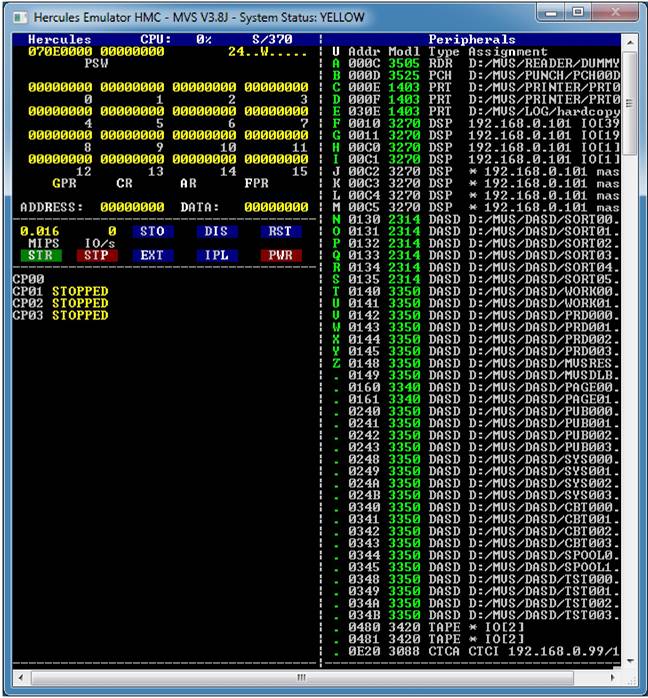 Figure 7:
Hercules Hardware Console - Device and status display
Figure 7:
Hercules Hardware Console - Device and status display

The last
figure shows the Hercules web browser interface which can be accessed when the
Hercules HTTP server is configured and running:
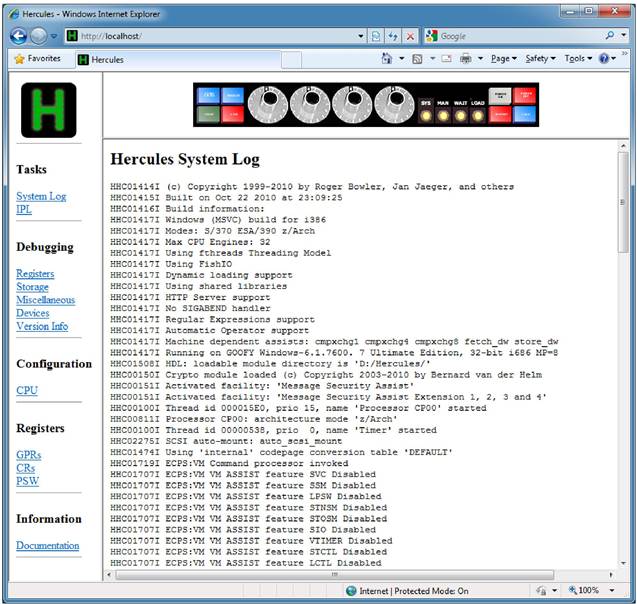 Figure 8:
Hercules web browser interface
6.4.2 Hercules Windows GUI
The Hercules Windows GUI (WinGUI) provides an optional graphical
user interface to the Hercules Emulator replacing the native DOS console
window of Hercules. The Windows GUI program interfaces with Hercules Emulator
directly. It provides an easier way to work with the Hercules Emulator
including interfaces to create / change the Hercules configuration files and
the handling of log files.
The
following figure shows the Hercules WinGUI main panel:
Figure 8:
Hercules web browser interface
6.4.2 Hercules Windows GUI
The Hercules Windows GUI (WinGUI) provides an optional graphical
user interface to the Hercules Emulator replacing the native DOS console
window of Hercules. The Windows GUI program interfaces with Hercules Emulator
directly. It provides an easier way to work with the Hercules Emulator
including interfaces to create / change the Hercules configuration files and
the handling of log files.
The
following figure shows the Hercules WinGUI main panel:

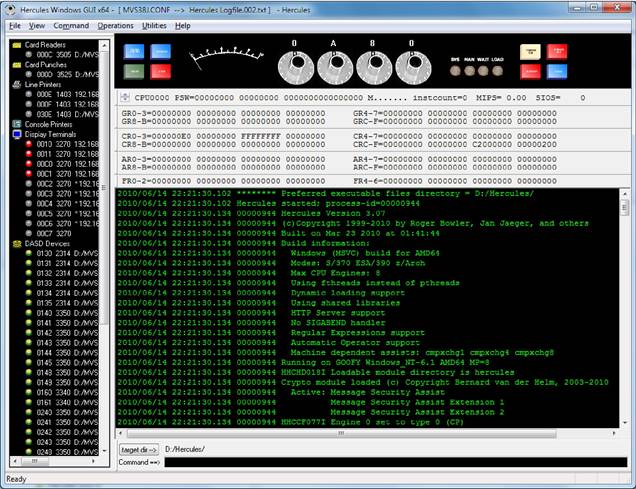 Figure 9: Hercules Windows GUI Main Panel
Using the GUI all of the Hercules DOS utilities are available, it
is no longer necessary to know the exact syntax of each utility. Instead of
having to issue cryptic command lines in native DOS such as
HETUPD -2 -b **<wrap>D:/M</wrap>** VS/TAPE/TLEV009.HET **<wrap>D:/MVS/TAPE/TLEV002.HET</wrap>**
a standard
Windows dialog box can be used to call the utility. The following figure shows
the pop-up window, used to provide information to one of the Hercules utility
programs (HETUPD).
Figure 9: Hercules Windows GUI Main Panel
Using the GUI all of the Hercules DOS utilities are available, it
is no longer necessary to know the exact syntax of each utility. Instead of
having to issue cryptic command lines in native DOS such as
HETUPD -2 -b **<wrap>D:/M</wrap>** VS/TAPE/TLEV009.HET **<wrap>D:/MVS/TAPE/TLEV002.HET</wrap>**
a standard
Windows dialog box can be used to call the utility. The following figure shows
the pop-up window, used to provide information to one of the Hercules utility
programs (HETUPD).

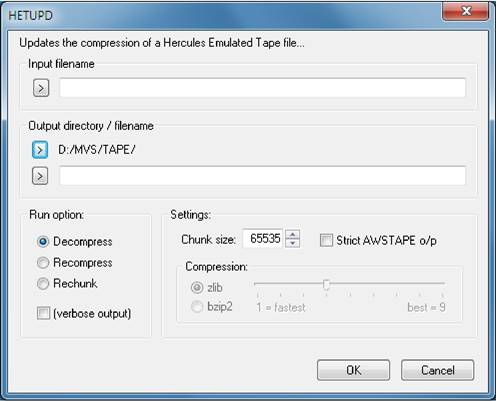 Figure 10:
Hercules Utility Window
The WinGUI has been developed by David B. Trout (Fish). More
detail about the functionality provided by the WinGUI can be found in the
“User Reference Guide” and in Chapter 10 – Installing the Hercules
WinGUI.
6.4.3 CTCI-WIN
Since Hercules runs as a user process under the control of the
host Windows system it does not normally have direct access to the driving
system's network adapter. Until recently this presented a problem in
establishing connectivity between the network and the TCP/IP stack of an operating
system running under Hercules.
Since the
development of device drivers by Fish, employing of the WinPcap's device
driver, it is now possible to establish a virtual point-to-point link between
the TCP/IP stack running under Hercules and Window's TCP/IP stack. This allows
you to use Windows as a router to pass Ethernet frames between the Hercules
TCP/IP stack and the rest of the network.
Figure 10:
Hercules Utility Window
The WinGUI has been developed by David B. Trout (Fish). More
detail about the functionality provided by the WinGUI can be found in the
“User Reference Guide” and in Chapter 10 – Installing the Hercules
WinGUI.
6.4.3 CTCI-WIN
Since Hercules runs as a user process under the control of the
host Windows system it does not normally have direct access to the driving
system's network adapter. Until recently this presented a problem in
establishing connectivity between the network and the TCP/IP stack of an operating
system running under Hercules.
Since the
development of device drivers by Fish, employing of the WinPcap's device
driver, it is now possible to establish a virtual point-to-point link between
the TCP/IP stack running under Hercules and Window's TCP/IP stack. This allows
you to use Windows as a router to pass Ethernet frames between the Hercules
TCP/IP stack and the rest of the network.
 6.5 Additional required and optional Software
As well as
the components described above other software, either required for practical
use of Hercules (e.g. tn3270 client) or that makes common tasks easier (e.g.
XMIT Manager, AWS Browse, ZZSA etc.) may be used.
6.5 Additional required and optional Software
As well as
the components described above other software, either required for practical
use of Hercules (e.g. tn3270 client) or that makes common tasks easier (e.g.
XMIT Manager, AWS Browse, ZZSA etc.) may be used.

6.5.1
tn3270 Client (required)
For virtual 3270 consoles and 3270 terminals a tn3270 client
software application is required. The tn3270 client can run on the same machine
as Hercules or on any Unix or Windows box with a TCP/IP connection to the
Hercules machine. The supported and recommended tn3270 client for Hercules
under Windows is Vista tn3270.
Vista tn3270 can be obtained from<wrap> www.tombrennansoftware.com</wrap><wrap>.</wrap> The license fee charged by
the developer of the software, Tom Brennan, is very modest. A 30 day trial
version can be downloaded from his web site.
Other tn3270 clients, such as QWS3270, IBM Personal
Communications, Attachmate Extra, etc., should also work in most cases. Be aware
that some tn3270 clients have a bug that makes them unusable as an MVS console.
Because the tn3270 client is an independent piece of software
there are no version requirements. You can use any stable release of a tn3270
client although it is recommended to always run with a current release.
6.5.2 XMIT Manager (optional)
The XMIT Manager is a Windows based tool that allows for the
manipulation of IBM mainframe created Xmit format files. With XMIT Manager you
can open Xmit files and view or extract the data within them, whether binary or
text, using a graphical interface. Xmit files containing partitioned or
sequential datasets are supported.
6.5.3 AWS Browse (optional)
The AWS Browse Utility is used to view the contents of tapes from
the Windows desktop without having to start a mainframe operating system and
run tape reading utilities. There are currently two implementations of AWS
browse.
The
original one was created by Rob Storey. The second is an enhanced version
written by Fish, which is faster and has more features.

 7. Component Compatibility Tables
The various components under the Windows operating system that
together make the full Hercules environment have some inter-dependencies on
each other. It is recommended that these components be at a certain release
level for every version of Hercules. The following tables list the combinations
of components for several releases that have been successfully evaluated as
working together.
If a combination is not listed in these tables this does not
necessarily mean that it will not function. However you must asses this
yourself and at your own risk. Although the listed combinations shown below
have been thoroughly tested and proven to provide a stable environment, there
is no guarantee that the components work in every environment and in any case.
Components that have been updated during the lifetime of a
specific Hercules release are shown with their highest release level in each
table. In general it is recommended to work always with the most current
stable release of each component. Beta releases are not shown here. The date(s)
in parenthesis show the release dates of the respective components. If there
was no release of Hercules but updated components, then the word “Components”
can be found before the release date.
In the case of Cygwin the release shown here is the one that
Hercules was built with, rather than the highest. As Cygwin is a runtime
environment, its release level must be the same or higher than the version
Hercules was built with. Therefore the Cygwin release level listed for any
level of Hercules is the minimum level needed for that Hercules release. Any
higher level of Cygwin should also run but experience has shown that this is
not always the case.
Please note
that obsolete components, e.g. Cygwin, or components that were subsequently
included in other packages, e.g. FishPack, TunTap32 and tt32info are mentioned
in the table immediately after the release where the change occurred and are
then removed from the tables.
7. Component Compatibility Tables
The various components under the Windows operating system that
together make the full Hercules environment have some inter-dependencies on
each other. It is recommended that these components be at a certain release
level for every version of Hercules. The following tables list the combinations
of components for several releases that have been successfully evaluated as
working together.
If a combination is not listed in these tables this does not
necessarily mean that it will not function. However you must asses this
yourself and at your own risk. Although the listed combinations shown below
have been thoroughly tested and proven to provide a stable environment, there
is no guarantee that the components work in every environment and in any case.
Components that have been updated during the lifetime of a
specific Hercules release are shown with their highest release level in each
table. In general it is recommended to work always with the most current
stable release of each component. Beta releases are not shown here. The date(s)
in parenthesis show the release dates of the respective components. If there
was no release of Hercules but updated components, then the word “Components”
can be found before the release date.
In the case of Cygwin the release shown here is the one that
Hercules was built with, rather than the highest. As Cygwin is a runtime
environment, its release level must be the same or higher than the version
Hercules was built with. Therefore the Cygwin release level listed for any
level of Hercules is the minimum level needed for that Hercules release. Any
higher level of Cygwin should also run but experience has shown that this is
not always the case.
Please note
that obsolete components, e.g. Cygwin, or components that were subsequently
included in other packages, e.g. FishPack, TunTap32 and tt32info are mentioned
in the table immediately after the release where the change occurred and are
then removed from the tables.
 7.1 Hercules V 4.00.0 (Release date: not yet released)
|
7.1 Hercules V 4.00.0 (Release date: not yet released)
|
Component
|
Release
| |
Hercules Emulator
|
V 4.00.0
| |
WinPcap
|
V 4.1.3
| |
HercGUI
|
V 1.12.6
| |
CTCI-WIN
|
V 3.3.3
| |
AWS Browse
|
V 1.5.4
| |
HercPrt
|
V 1.4.0
|
Table 7:
Hercules Release V4.00.0 Component Compatibility Table

 7.2 Hercules V 3.11.0 (Release date: September 15, 2014)
|
7.2 Hercules V 3.11.0 (Release date: September 15, 2014)
|
Component
|
Release
| |
Hercules Emulator
|
V 3.11.0
| |
WinPcap
|
V 4.1.3
| |
HercGUI
|
V 1.12.6
| |
CTCI-WIN
|
V 3.3.3
| |
AWS Browse
|
V 1.5.4
| |
HercPrt
|
V 1.4.0
|
Table 8:
Hercules Release V 3.11.0 Component Compatibility Table
 7.3 Hercules V 3.10.0 (Release date: February 1, 2014)
|
7.3 Hercules V 3.10.0 (Release date: February 1, 2014)
|
Component
|
Release
| |
Hercules Emulator
|
V 3.10.0
| |
WinPcap
|
V 4.1.3
| |
HercGUI
|
V 1.12.6
| |
CTCI-WIN
|
V 3.3.3
| |
FishLib
|
A separate installation is no longer needed, required components are installed with all SoftDevLabs products
| |
AWS Browse
|
V 1.5.4
| |
HercPrt
|
V 1.4.0
|
Table 9:
Hercules Release V 3.10.0 Component Compatibility Table

 7.4 Hercules V 3.09.0 (Release date: July 15, 2013)
|
7.4 Hercules V 3.09.0 (Release date: July 15, 2013)
|
Component
|
Release
| |
Hercules Emulator
|
V 3.09.0
| |
WinPcap
|
V 4.1.2
| |
HercGUI
|
V 1.11.1
| |
CTCI-WIN
|
V 3.2.1
| |
FishLib
|
V 2.7.1
| |
AWS Browse
|
V 1.5.1
| |
HercPrt
|
V 1.1.0
|
Table 10:
Hercules Release V 3.09.0 Component Compatibility Table
 7.5 Hercules V 3.08.1 (Release date: March 13, 2013)
|
7.5 Hercules V 3.08.1 (Release date: March 13, 2013)
|
Component
|
Release
| |
Hercules Emulator
|
V 3.08.1
| |
WinPcap
|
V 4.1.2
| |
HercGUI
|
V 1.11.1
| |
CTCI-WIN
|
V 3.2.1
| |
FishLib
|
V 2.7.1
| |
AWS Browse
|
V 1.5.1
| |
HercPrt
|
V 1.1.0
|
Table 11:
Hercules Release V 3.08.0 Component Compatibility Table

 7.6 Hercules V 3.08.0 (Release date: December 12, 2012)
|
7.6 Hercules V 3.08.0 (Release date: December 12, 2012)
|
Component
|
Release
| |
Hercules Emulator
|
V 3.08.0
| |
WinPcap
|
V 4.1.2
| |
HercGUI
|
V 1.11.1
| |
CTCI-WIN
|
V 3.2.1
| |
FishLib
|
V 2.7.1
| |
AWS Browse
|
V 1.5.1
| |
HercPrt
|
V 1.1.0
|
Table 12:
Hercules Release V 3.08.0 Component Compatibility Table
 7.7 Hercules V 3.07.0 (Release date: March 10, 2010)
|
7.7 Hercules V 3.07.0 (Release date: March 10, 2010)
|
Component
|
Release
| |
Hercules Emulator
|
V 3.07.0
| |
WinPcap
|
V 4.1.1
| |
HercGUI
|
V 1.11.1
| |
CTCI-WIN
|
V 3.2.1
| |
FishLib
|
V 2.7.1
| |
AWS Browse
|
V 1.5.1
| |
HercPrt
|
V 1.1.0
|
Table 13:
Hercules Release V3.07.0 Component Compatibility Table

 7.8 Hercules V 3.06.0 (Release date: January 11, 2009)
|
7.8 Hercules V 3.06.0 (Release date: January 11, 2009)
|
Component
|
Release
| |
Hercules Emulator
|
V 3.06.0
| |
WinPcap
|
V 4.0.2
| |
HercGUI
|
V 1.11.1
| |
CTCI-WIN
|
V 3.2.1
| |
FishLib
|
V 2.7.1
| |
AWS Browse
|
V 1.5.1
|
Table 14:
Hercules Release V3.06.0 Component Compatibility Table
 7.9 Hercules V 3.05.0 (Release date: June 23, 2007)
|
7.9 Hercules V 3.05.0 (Release date: June 23, 2007)
|
Component
|
Release
| |
Hercules Emulator
|
V 3.05.0
| |
WinPcap
|
V 4.0.1
| |
HercGUI
|
V 1.11.1
| |
CTCI-WIN
|
V 3.2.1
| |
FishLib
|
V 2.7.1
| |
AWS Browse
|
V 1.5.1
|
Table 15:
Hercules Release V3.05.0 Component Compatibility Table

 7.10
Hercules V 3.04.0 (Release date: February 24, 2006)
|
7.10
Hercules V 3.04.0 (Release date: February 24, 2006)
|
Component
|
Release
| |
Hercules Emulator
|
V 3.04.0
| |
WinPcap
|
V 4.0
| |
HercGUI
|
V 1.11.1
| |
CTCI-WIN
|
V 3.2.1
| |
FishLib
|
V2.7.1
| |
AWS Browse
|
V 1.5.1
|
Table 16:
Hercules Release V3.04.0 Component Compatibility Table
 7.11
Hercules V 3.03.1 (Release date: December 31, 2005)
|
7.11
Hercules V 3.03.1 (Release date: December 31, 2005)
|
Component
|
Release
| |
Hercules Emulator
|
V 3.03.1
| |
WinPcap
|
V 3.0
| |
HercGUI
|
V 1.9.5
| |
FishPack
|
V 1.3.0
| |
TunTap32
|
V 2.1.0
| |
tt32info
|
V 1.0.2
| |
AWS Browse
|
V 1.2.0
|
Table 17:
Hercules Release V3.03.1 Component Compatibility Table

 7.12
Hercules V 3.03.0 (Release date: December 20, 2005)
|
7.12
Hercules V 3.03.0 (Release date: December 20, 2005)
|
Component
|
Release
| |
Hercules Emulator
|
V 3.03
| |
Cygwin
|
No longer needed!
| |
WinPcap
|
V 3.0
| |
HercGUI
|
V 1.9.5
| |
FishPack
|
V 1.3.0
| |
TunTap32
|
V 2.1.0
| |
tt32info
|
V 1.0.2
| |
AWS Browse
|
V 1.2.0
|
Table 18:
Hercules Release V3.03.0 Component Compatibility Table
 7.13
Hercules V 3.02.0 (Release date: December 11, 2004)
|
7.13
Hercules V 3.02.0 (Release date: December 11, 2004)
|
Component
|
Release
| |
Hercules Emulator
|
V 3.02
| |
Cygwin
|
V 1.5.12
| |
WinPcap
|
V 3.0
| |
HercGUI
|
V 1.8.8
| |
FishPack
|
V 1.3.0
| |
TunTap32
|
V 2.0.3
| |
tt32info
|
V 1.0.2
| |
AWS Browse
|
V 1.2.0
|
Table 19:
Hercules Release V3.02.0 Component Compatibility Table

 7.14
Hercules V 3.01.0 (Release date: November 30, 2003)
|
7.14
Hercules V 3.01.0 (Release date: November 30, 2003)
|
Component
|
Release
| |
Hercules Emulator
|
V 3.01
| |
Cygwin
|
V 1.5.5
| |
WinPcap
|
V 3.0
| |
HercGUI
|
V 1.6.8
| |
FishPack
|
V 1.3.0
| |
TunTap32
|
V 2.0.3
| |
tt32info
|
V 1.0.2
|
Table 20:
Hercules Release V3.01.0 Component Compatibility Table
 7.15
Hercules V 3.00.0 (Release date: October 2, 2003)
|
7.15
Hercules V 3.00.0 (Release date: October 2, 2003)
|
Component
|
Release
| |
Hercules Emulator
|
V 3.00
| |
Cygwin
|
V 1.5.5
| |
WinPcap
|
V 3.0
| |
HercGUI
|
V 1.6.8
| |
FishPack
|
V 1.3.0
| |
TunTap32
|
V 2.0.3
| |
tt32info
|
V 1.0.2
|
Table 21:
Hercules Release V3.00.0 Component Compatibility Table

 8.
Installation WinPcap
8.
Installation WinPcap
 Figure 11: WinPcap Logo
Figure 11: WinPcap Logo
 8.1 WinPcap Packet Capture Driver
The first component you are required to
install after the operating system is the WinPcap Packet Capture Driver. This
can be downloaded from the website of the Politecnico di Torino<wrap>(</wrap><wrap>http:%%//%%www.WinPcap.org</wrap><wrap>)</wrap>where you will also find comprehensive documentation. Save the
executable in a directory of your choice.
Be sure to
only use the latest version of WinPcap that is supported by CTCI-WIN supplied
with the release of Hercules you are using. The most recent release of WinPcap
may not be compatible with your version of Hercules. See chapter 7 (Component
Compatibility Tables) for details of the supported releases.
8.1 WinPcap Packet Capture Driver
The first component you are required to
install after the operating system is the WinPcap Packet Capture Driver. This
can be downloaded from the website of the Politecnico di Torino<wrap>(</wrap><wrap>http:%%//%%www.WinPcap.org</wrap><wrap>)</wrap>where you will also find comprehensive documentation. Save the
executable in a directory of your choice.
Be sure to
only use the latest version of WinPcap that is supported by CTCI-WIN supplied
with the release of Hercules you are using. The most recent release of WinPcap
may not be compatible with your version of Hercules. See chapter 7 (Component
Compatibility Tables) for details of the supported releases.
 8.2 Installation Steps (Windows Setup)
The installation program for WinPcap creates and then initiates a
kernel driver service. Please note that you need to have administrator privileges in
order to create and to start the Netgroup Packet Filter (NPF)
kernel driver service. You must be logged onto your Windows system as an
“administrator” when you run the TESTAPP program for the first time
and create the NPF service entry, or whenever you run a program that starts
the NPF service. Once the NPF service has been created and / or started
however, any non-administrator user may use the service.
As with
every installation under the Windows operating system, you should stop all
running programs prior to starting the installation process. To start the installation
wizard just double-click on the executable WINPCAP_v_r.EXE (where “v” is the
version and “r” is the release) in the directory where you previously have
saved the file.
8.2 Installation Steps (Windows Setup)
The installation program for WinPcap creates and then initiates a
kernel driver service. Please note that you need to have administrator privileges in
order to create and to start the Netgroup Packet Filter (NPF)
kernel driver service. You must be logged onto your Windows system as an
“administrator” when you run the TESTAPP program for the first time
and create the NPF service entry, or whenever you run a program that starts
the NPF service. Once the NPF service has been created and / or started
however, any non-administrator user may use the service.
As with
every installation under the Windows operating system, you should stop all
running programs prior to starting the installation process. To start the installation
wizard just double-click on the executable WINPCAP_v_r.EXE (where “v” is the
version and “r” is the release) in the directory where you previously have
saved the file.

The information
screen of the WinPcap installation appears.
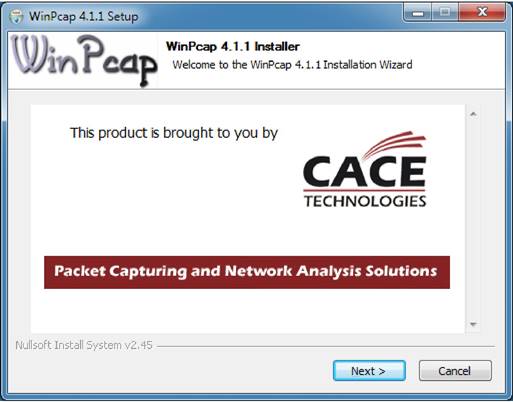 Figure 12:
WinPcap Setup - Information Screen
This screen
gives you an informational about WinPcap. Click on “Next >” to continue with
the installation.
Figure 12:
WinPcap Setup - Information Screen
This screen
gives you an informational about WinPcap. Click on “Next >” to continue with
the installation.

The welcome
screen of the installation wizard appears.
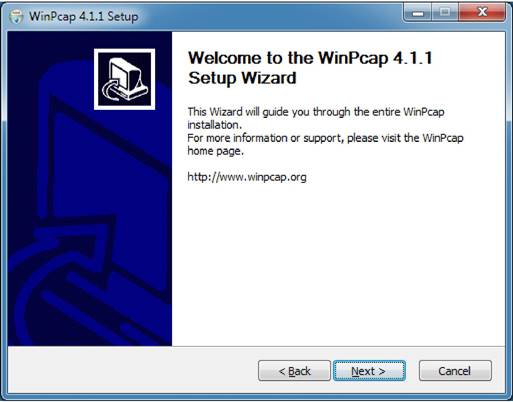 Figure 13: WinPcap Setup - Welcome Screen
This screen gives you the usual
information presented when starting installation programs under Windows. Click
on “Next >” to continue with the installation.
Figure 13: WinPcap Setup - Welcome Screen
This screen gives you the usual
information presented when starting installation programs under Windows. Click
on “Next >” to continue with the installation.

On the
following screen you are presented with the license agreement. Read the license
agreement carefully. You have to accept the license agreement in order to
continue with the installation process.
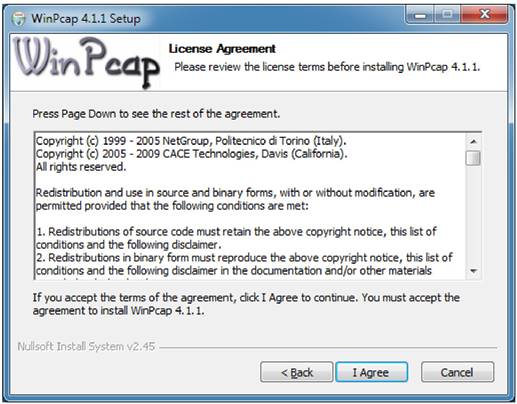 Figure 14:
WinPcap Setup - License Agreement
After reading
the license agreement, accept it by clicking on the “I Agree“ button to
continue the installation process.
Figure 14:
WinPcap Setup - License Agreement
After reading
the license agreement, accept it by clicking on the “I Agree“ button to
continue the installation process.

|
|
|
|
Next the setup program presents some installation options. Be sure
to have selected “Automatically start the WinPcap driver at boot
time” option.
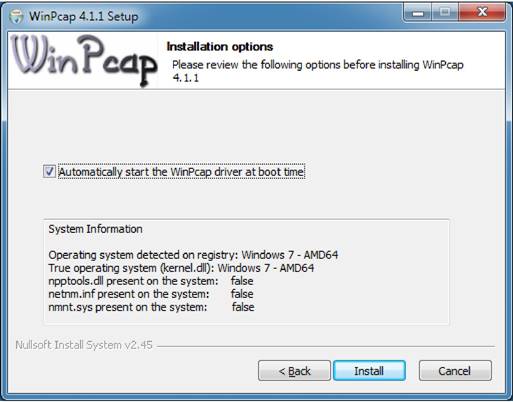 Figure 15:
WinPcap Setup - Installation Options
Figure 15:
WinPcap Setup - Installation Options

The
installation process now automatically begins. You do not have to select a
target directory and there are no other decisions to make. A progress bar in a
new window will appear. On a fast machine it is possible that the progress
window just flickers for a short time, or that you will not see the window at
all as the installation process is very fast.
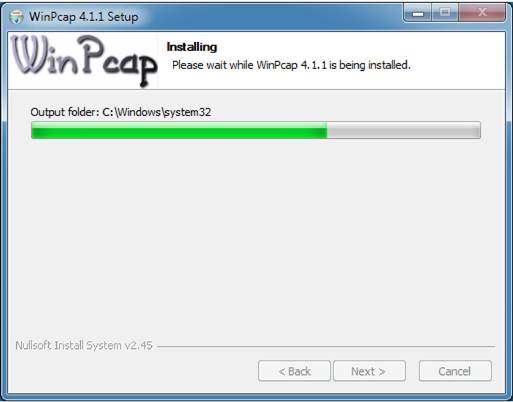 Figure 16:
WinPcap - Setup Status
As soon as
all files are copied to their default destination and the installation process
is complete the final screen shown below is displayed.
Figure 16:
WinPcap - Setup Status
As soon as
all files are copied to their default destination and the installation process
is complete the final screen shown below is displayed.

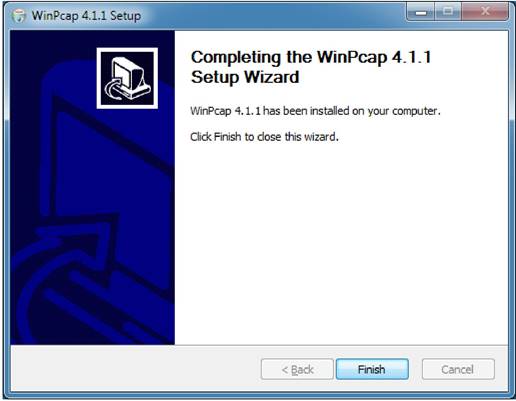 Figure 17:
WinPcap Setup - Installation Complete
If an older
version of WinPcap was installed on the machine it is strongly recommended that
you reboot the system. Click on “Finish” to complete the installation
process, then continue with the customization steps.
Figure 17:
WinPcap Setup - Installation Complete
If an older
version of WinPcap was installed on the machine it is strongly recommended that
you reboot the system. Click on “Finish” to complete the installation
process, then continue with the customization steps.

 9. Installing the Hercules Emulator
9. Installing the Hercules Emulator
 9.1 Downloading the Binaries
The “ready-to-run” binaries can be downloaded from<wrap></wrap><wrap>http:%%//%%www.hercules-390.eu</wrap><wrap>.</wrap> For Windows users there are currently two varieties available:
·MSVC Windows installer package (filename “hercules-v.rr-w64.msi”
or “hercules-v.rr-w64.msi”)
·MSVC binaries only archive (filename “hercules-v.rr-w64.zip”
or “hercules-v.rr-w32.zip”)
Where ‘v.rr’ in the filename specifies the version and
release of the Hercules Emulator contained in the package.
The
difference between these packages and how each is installed are described in
the following sections.
9.1 Downloading the Binaries
The “ready-to-run” binaries can be downloaded from<wrap></wrap><wrap>http:%%//%%www.hercules-390.eu</wrap><wrap>.</wrap> For Windows users there are currently two varieties available:
·MSVC Windows installer package (filename “hercules-v.rr-w64.msi”
or “hercules-v.rr-w64.msi”)
·MSVC binaries only archive (filename “hercules-v.rr-w64.zip”
or “hercules-v.rr-w32.zip”)
Where ‘v.rr’ in the filename specifies the version and
release of the Hercules Emulator contained in the package.
The
difference between these packages and how each is installed are described in
the following sections.
 9.2 Choosing a Package
Which package is the right one for you depends on your needs. The
former Cygwin package is no longer available because since Hercules release
3.03.0 Cygwin is no longer a pre-requisite.
The new MSVC packages, the self-extracting archive (.exe) and the
Windows installer package (.msi), are very similar. The main difference being
that the Windows installer package provides the standard Windows installation
dialog for both installation and removal of the emulator. The Windows installer
package also creates Start Menu entries for both the documentation and to start
the DOS command prompt in the Hercules binary directory.
Some people want to have the full control over the whole
installation process and therefore prefer the self-extracting archive (.exe).
On the other hand however, some people prefer to have a simple installation
routine, similar to other Windows software packages.
Note: Installing
the .msi Windows Installer package ensures the required Microsoft Runtime
components are installed and also provides convenience shortcuts in the
programs menu. If the required components are already present and the shortcuts
are not needed on the target system, the self-extracting or .zip archive may be
used instead.
9.2 Choosing a Package
Which package is the right one for you depends on your needs. The
former Cygwin package is no longer available because since Hercules release
3.03.0 Cygwin is no longer a pre-requisite.
The new MSVC packages, the self-extracting archive (.exe) and the
Windows installer package (.msi), are very similar. The main difference being
that the Windows installer package provides the standard Windows installation
dialog for both installation and removal of the emulator. The Windows installer
package also creates Start Menu entries for both the documentation and to start
the DOS command prompt in the Hercules binary directory.
Some people want to have the full control over the whole
installation process and therefore prefer the self-extracting archive (.exe).
On the other hand however, some people prefer to have a simple installation
routine, similar to other Windows software packages.
Note: Installing
the .msi Windows Installer package ensures the required Microsoft Runtime
components are installed and also provides convenience shortcuts in the
programs menu. If the required components are already present and the shortcuts
are not needed on the target system, the self-extracting or .zip archive may be
used instead.
 9.3 Installation Steps (MSVC Windows Installer Package)
The “MSVC Windows Installer Package” is a standard
Windows installation dialog as used for most Windows application installations.
Using this method the 'C' runtime library files are installed if needed in a
separate directory structure under the Windows system directory (i.e.
”%windir%\WinSxS“).
This new
Windows technique (SxS means “Side by Side”) allows multiple versions
of the same DLL to coexist in the same system. For example should application
“A” need foobar.dll version 1.12 and application “B” needs foobar.dll version
1.14, both DLLs can coexist in the same system.
The
following installation is shown with the 64-bit version of Hercules but applies
also to the 32-bit version.
9.3 Installation Steps (MSVC Windows Installer Package)
The “MSVC Windows Installer Package” is a standard
Windows installation dialog as used for most Windows application installations.
Using this method the 'C' runtime library files are installed if needed in a
separate directory structure under the Windows system directory (i.e.
”%windir%\WinSxS“).
This new
Windows technique (SxS means “Side by Side”) allows multiple versions
of the same DLL to coexist in the same system. For example should application
“A” need foobar.dll version 1.12 and application “B” needs foobar.dll version
1.14, both DLLs can coexist in the same system.
The
following installation is shown with the 64-bit version of Hercules but applies
also to the 32-bit version.

To start the installation dialog run the .MSI executable file. A
welcome window is presented first.
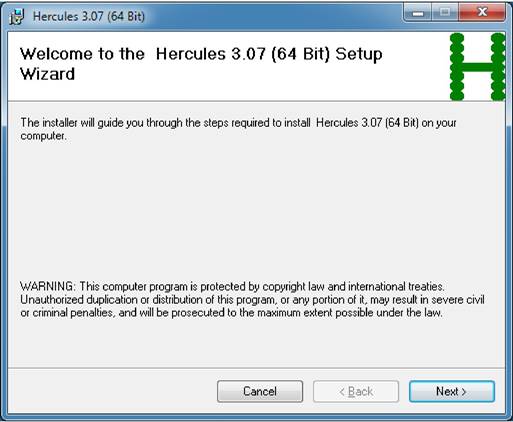 Figure 18: Welcome Window (MSVC Installer Package)
Clicking on
“Next” continues the installation process.
Figure 18: Welcome Window (MSVC Installer Package)
Clicking on
“Next” continues the installation process.

The next
window lets you specify the installation folder. You can use the default or
specify any directory of your choice.
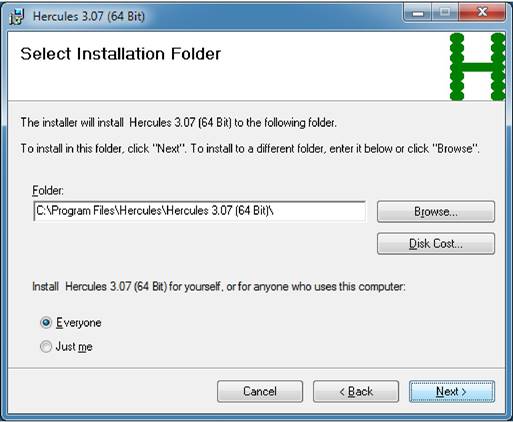 Figure 19:
Installation Directory Selection (MSVC Installer Package)
If you plan
to run different Hercules versions in parallel then the default naming
convention which contains the version and release levels in the directory name
is useful. If your intention is to run one Hercules version at a time then you
may prefer to shorten the directory name to simply “Hercules” as in
the example above.
Figure 19:
Installation Directory Selection (MSVC Installer Package)
If you plan
to run different Hercules versions in parallel then the default naming
convention which contains the version and release levels in the directory name
is useful. If your intention is to run one Hercules version at a time then you
may prefer to shorten the directory name to simply “Hercules” as in
the example above.

Before
installing the package you can examine your available disk space by clicking on
the button “Disk Cost”. This will display all available disk
partitions on which Hercules can be installed and shows the disk space before
and after installing the package. Hercules itself, without a mainframe
operating system installed, uses approximately 11 MB of disk space.
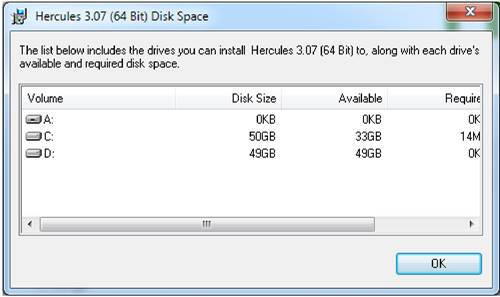 Figure 20:
Disk Space Information (MSVC Installer Package)
When you
are satisfied with the installation options, click on “OK”.
Figure 20:
Disk Space Information (MSVC Installer Package)
When you
are satisfied with the installation options, click on “OK”.

A confirmation dialog is presented, this is a
final opportunity to change any of your selections made in the previous
screens.
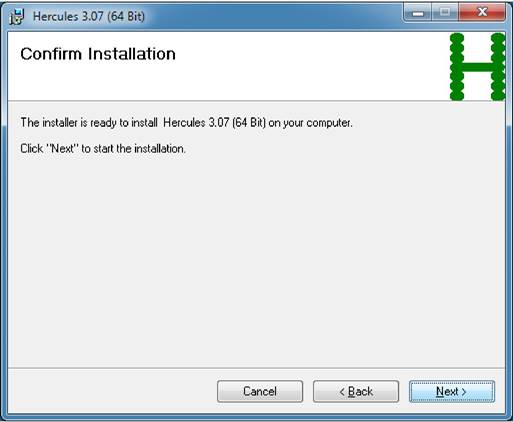 Figure 21:
Installation Confirmation (MSVC Installer Package)
If you do
not want to change any of your choices, click on “Next >” to start
the actual installation process.
Figure 21:
Installation Confirmation (MSVC Installer Package)
If you do
not want to change any of your choices, click on “Next >” to start
the actual installation process.

The
installer now begins to copy files to the destination directories.
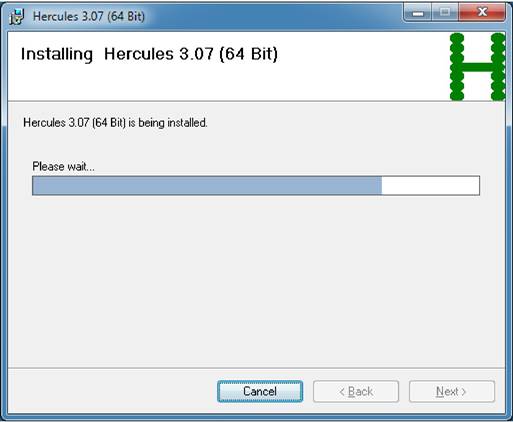 Figure 22: Installation Progress Bar (MSVC Installer Package)
If
necessary the process of copying files can be stopped by clicking on
“Cancel”.
Figure 22: Installation Progress Bar (MSVC Installer Package)
If
necessary the process of copying files can be stopped by clicking on
“Cancel”.

After a few
seconds the installation process will finish and present the final window.
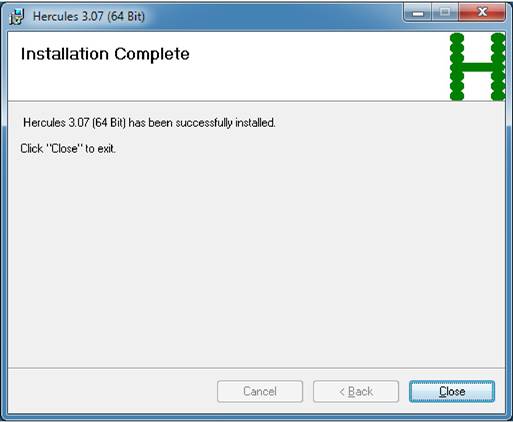 Figure 23:
Installation Complete (MSVC Installer Package)
Click on
“Close” to terminate the installation dialog and proceed to customise
your installation as described in the following sections.
Figure 23:
Installation Complete (MSVC Installer Package)
Click on
“Close” to terminate the installation dialog and proceed to customise
your installation as described in the following sections.
 9.4 The Microsoft Windows Installer
The
Microsoft Windows Installer is an installation and configuration service provided
with Windows. The executable program that interprets packages and installs
products in a Windows environment is called msiexec.exe. The general syntax of
msiexec is as follows:
msiexec /option
<required> [optional]
msiexec This is the
name of the microsoft Windows Installer.
/option This
specifies the options as described in the following sections.
<required> Required
parameter of the specified option.
[optional] Optional
parameter of the specified option.
9.4 The Microsoft Windows Installer
The
Microsoft Windows Installer is an installation and configuration service provided
with Windows. The executable program that interprets packages and installs
products in a Windows environment is called msiexec.exe. The general syntax of
msiexec is as follows:
msiexec /option
<required> [optional]
msiexec This is the
name of the microsoft Windows Installer.
/option This
specifies the options as described in the following sections.
<required> Required
parameter of the specified option.
[optional] Optional
parameter of the specified option.

For more information about syntax and options of the Microsoft
Installer Packages than described in these sections please consult the
Microsoft Installer SDK documentation. Please note that not all switches are
useful for Hercules packages.
9.4.1 Install Options
These are
the install options:
</package | /i> <Product.msi>
/a <Product.msi>
/j<u | m>
<Product.msi> [/t <TransformList>] [/g <LanguageID>]
</uninstall | /x> <Product.msi | ProductCode>
/package Install or
configure a product.
/i Same as
”/package“.
/a Administrative
install - install a product on the network.
<Product.msi> This is the
name of the installer package (e.g.”hercules-3.07-w32.msi“).
/j Advertise a
product:
u – To the current user.
m – To all users.
/t Applies a
the transform list to an advertised product (see below).
<TransformList> Specifies
the transform list.
/g Set the
language ID (see below).
<LanguageID> This specifies the language
ID. To determine the value for languages, consult
Microsofts Platform SDK documentation.
/uninstall Uninstall a product.
/x Same as
/uninstall.
<ProductCode> This is the
GUID (Globally Unique Identifier). The GUID is the principal
identification
of an application or product.
9.4.2 Display Options
These are
the display options:
/help /quiet /passive /q[n | b
| r | f]
/help Display
help information.
/quiet Quiet mode,
no user interaction required.

/passive Unattended
mode, display only the progress bar.
/q Sets the
user interface level:
n – No user
interface.
b – Basic user
interface.
r – Reduced
user interface.
f – Full user
interface (default).
9.4.3 Restart Options
These are
the restart options:
/norestart /promptrestart /forcerestart
/norestart Do not
restart the computer after the installation is complete.
/promptrestart Prompts the user for a
restart of the computer if necessary.
/forcerestart Always restart the computer
after the installation is complete.
9.4.4 Logging Options
These are
the logging options:
|
/l[i | w | e | a | r | u | c | m | o | p | v | x | + | ! | *] <LogFile> /log <LogFile>
|
/l Specifies
the logging options.
i – Status
messages.
w – Nonfatal
warnings.
e – All error
messages.
a – Startup of
actions.
r –
Action-specific records.
u – User
requests.
c – Initial UI
parameters.
m –
Out-of-memory or fatal exit information.
o –
Out-of-disk-space messages.
p – Terminal
properties.
v – Verbose output.

x – Extra
debugging information.
+ – Append to
existing log file.
! – Flush each
line to the log file.
* – Log all information, except for 'v' and 'x' options.
<LogFile> Name and
optional path of the log file.
/log
<LogFile> Equivalent of ”/l*
<LogFile>“.
9.4.5 Update Options
These are
the update options:
/update <Update1.msp>[;Update2.msp]
/uninstall <PatchCodGuid>[;Update2.msp] /package
<Product.msi | ProductCode>
/update Apply
updates.
<Update.msp> This is the
name of the Windows installer patch (not relevant for Hercules because Hercules
does not provide installer patches).
/uninstall Remove
updates for a product.
<PatchCodGuid> This is the GUID (Globally
Unique Identifier) of the patch.
/package Specifies
the package to be updated (see below).
<Product.msi> This is the name of the
installer package (e.g.”hercules-3.07-w32.msi“).
<ProductCode> This is the
GUID (Globally Unique Identifier). The GUID is the principal identification of
an application or product.
9.4.6 Repair Options
These are
the installer package repair options:
/f[p | o | e | d | c | a | u | m | s | v]
<Product.msi | ProductCode>
/f Specifies
the repair options. Repairs a product:
p – Only if a
file is missing.
o – If a file
is missing or an older version is installed (default).
e – If a file
is missing or an equal or an older version is installed.
d – If a file
is missing or a different version is installed.
c – If a file is missing or the checksum does
not match the calculated value.
a – Forces all files to be reinstalled.

u – All required
user-specific registry entries (default).
m – All
required computer-specific registry entries (default).
s – All existing
shortcuts (default).
v – Runs from
source and recaches local package.
<Product.msi> This is the
name of the installer package (e.g.”hercules-3.07-w32.msi“).
<ProductCode> This is the GUID (Globally
Unique Identifier). The GUID is the principal identification of an application
or product.
 9.5 Installation Steps (MSVC Binaries Only Archive)
The MSVC native version of the Hercules Emulator is delivered as a
ZIP archive. In this archive the binaries and all other necessary files (e.g.
html files etc.) are placed in a predefined directory structure required to
run Hercules.
Extracting these files does not invoke the Windows installer
therefore will not install the “Microsoft Visual Studio 8 'C' Runtime
Library” as a system file. Please make sure to have these libraries
installed on your system.
To extract the Hercules files from the archive just run WinZip or
another software which is able to extract ZIP-files. Extract the files to a
folder of your choice. The necessary directory structure is created automatically.
The root directory that is created is called “hercules-v.rr
(64 Bit)” or “hercules-v.rr (32 Bit)”, where v does
stand for the current version and rr for the current release. This
naming convention is useful if you plan to run several Hercules versions in
parallel. If your intention is to run only one Hercules version at a time the
directory can be renamed to “Hercules” without a version or release
indication.
Next
proceed to section 9.6 ‘Customization Steps’ below.
9.5 Installation Steps (MSVC Binaries Only Archive)
The MSVC native version of the Hercules Emulator is delivered as a
ZIP archive. In this archive the binaries and all other necessary files (e.g.
html files etc.) are placed in a predefined directory structure required to
run Hercules.
Extracting these files does not invoke the Windows installer
therefore will not install the “Microsoft Visual Studio 8 'C' Runtime
Library” as a system file. Please make sure to have these libraries
installed on your system.
To extract the Hercules files from the archive just run WinZip or
another software which is able to extract ZIP-files. Extract the files to a
folder of your choice. The necessary directory structure is created automatically.
The root directory that is created is called “hercules-v.rr
(64 Bit)” or “hercules-v.rr (32 Bit)”, where v does
stand for the current version and rr for the current release. This
naming convention is useful if you plan to run several Hercules versions in
parallel. If your intention is to run only one Hercules version at a time the
directory can be renamed to “Hercules” without a version or release
indication.
Next
proceed to section 9.6 ‘Customization Steps’ below.
 9.6 Customization Steps
After the
actual installation is complete there are additional customization steps
required, these include:
·Creating the Hercules configuration file
·Creating the Hercules startup batch file
·Creating the Hercules run-commands file
·Creating the terminal batch file
These manual customization steps are explained in detail over the
following sections.
9.6.1 Creating the Hercules Configuration File
When
starting the Hercules Emulator from either a DOS command line or via the
Hercules Windows GUI, you may specify the name of a configuration file as a
parameter:
HERCULES [
-f filename ] …
9.6 Customization Steps
After the
actual installation is complete there are additional customization steps
required, these include:
·Creating the Hercules configuration file
·Creating the Hercules startup batch file
·Creating the Hercules run-commands file
·Creating the terminal batch file
These manual customization steps are explained in detail over the
following sections.
9.6.1 Creating the Hercules Configuration File
When
starting the Hercules Emulator from either a DOS command line or via the
Hercules Windows GUI, you may specify the name of a configuration file as a
parameter:
HERCULES [
-f filename ] …
HERCGUI [ -f filename ] …
where filename
is the name of the configuration file. The default filename if none is
specified during the startup is ‘hercules.cnf’. The name of the default
configuration file may be overridden via the environment variable HERCULES_CNF.

The configuration file is an ASCII text file that is used to
describe the processor definition, the device layout and any runtime
parameters. Details of the format and acceptable directives that can be made
within the file are found in Chapter 3 of the Hercules User Reference Guide.
9.6.2 Creating the Hercules Startup Batch File
Although the Hercules Emulator can be started manually from a DOS
command prompt it is often easier to establish a batch file to do this. The
batch file can then be executed by double-clicking it from Windows Explorer,
called directly from a DOS command prompt window or it can be integrated as a
shortcut into the Windows start menu or desktop.
9.6.2.1 Hercules Startup Batch File
The
following figure shows an example of a Hercules startup batch file using the
native Hercules console.
|
|
|
|
@ECHO OFF
REM
REM
***********************************************************************
REM
CHECK / SET HERCULES PATH (1)
REM
***********************************************************************
REM
IF %SETHERC%.==1. GOTO RUNIT
SET SETHERC=1
PATH <wrap>D:%%\%%Hercules</wrap>;%PATH%
SET
HERCULES_RC=D:\MVS\CONF\HERCULES.RC
:RUNIT
REM
REM
***********************************************************************
REM
START HERCULES EMULATOR (2)
REM
***********************************************************************
REM
START
<wrap>D:%%\%%Hercules%%\%%Hercules</wrap> -f <wrap>D:/MVS/CONF/MVS38J.CONF</wrap>
>D:\MVS\LOG\Hercules_Log.txt
EXIT
Figure 24:
Hercules Startup Batch File
This example batch file contains two main sections:
(1)In the
first section a check is made to determine if the path to the Hercules binaries
has already been set. If so, then the rest of the first section is skipped. If
not, then the path to the Hercules binaries is set and the environment variable
%SETHERC% is set to ‘1’ to indicate that the path has been successfully set.
(2)In the
second section the Hercules Emulator is started with a configuration file
located in a directory other than the emulator itself. Additionally the path
and filename for the log file is set.

9.6.2.2
Hercules Windows GUI Startup Batch File
The
following figure shows an example of a Hercules startup batch file using the
Hercules Windows GUI.
|
|
|
|
@ECHO OFF
REM
REM
***********************************************************************
REM
CHECK / SET HERCULES PATH (1)
REM
***********************************************************************
REM
IF %SETHERC%.==1. GOTO RUNIT
SET SETHERC=1
PATH <wrap>D:%%\%%Hercules</wrap>;%PATH%
SET
HERCULES_RC=D:\MVS\CONF\HERCULES.RC
:RUNIT
REM
REM
***********************************************************************
REM
START HERCULES WIN GUI AND HERCULES EMULATOR (2)
REM
***********************************************************************
REM
START
<wrap>D:%%\%%Hercules%%\%%HercGui</wrap> -f <wrap>D:/MVS/CONF/MVS38J.CONF</wrap>
EXIT
Figure 25:
Hercules Windows GUI Startup Batch File
This example batch file contains two main sections:
(1)In the
first section a check is make to determine if the path to the Hercules binaries
has been already set. If so, then the rest of the first section is skipped. If
not, then the path to the Hercules binaries is set and the environment variable
%SETHERC% is set to ‘1’ to indicate that the path has been successfully set.
(2)In the
second section the Hercules Windows GUI is started which will in turn start the
Hercules Emulator, using a configuration file located in a separate directory
to the emulator itself. Differently to the first example above, the filename
and path of the log file are not given as a parameter to the Windows GUI,
rather they are configured within the GUI itself.
9.6.3 Creating the Hercules Run-Command File
Hercules also provides the ability to automatically execute
Hercules panel commands after startup via the 'run-commands' file. If the
run-commands file exists when Hercules starts, each line contained in the file
is read and interpreted as panel command.
In the
following example file the Windows telnet program is started in a shell, all
currently valid Hercules panel commands are displayed and MAXRATES is reset.
Finally a couple of tn3270 sessions for con-

soles and TSO terminals are started.
sh startgui telnet localhost 3270
?
maxrates
sh startgui <wrap>C:%%\%%Programs%%\%%Vista32%%\%%vista32.exe</wrap> MVS_MST.ses
pause 3
sh startgui <wrap>C:%%\%%Programs%%\%%Vista32%%\%%vista32.exe</wrap> MVS_OPR.ses
pause 3
sh startgui <wrap>C:%%\%%Programs%%\%%Vista32%%\%%vista32.exe</wrap> MVS_TSO.ses
pause 3
sh startgui <wrap>C:%%\%%Programs%%\%%Vista32%%\%%vista32.exe</wrap> MVS_TSO.ses
pause 3
sh
startgui <wrap>C:%%\%%Programs%%\%%Vista32%%\%%vista32.exe</wrap> MVS_TSO.ses
Figure 26: Hercules Run-Commands File
If the “sh” (shell) command is used in the run-commands
file, then the “startgui” keyword should also be used when starting
external applications if one of the following is true:
a)If starting Windows GUI applications (as
opposed to command-line programs), regardless whether or not the Hercules
Windows GUI is being used.
b)If starting any program, Windows GUI programs or command-line
programs (either via the Hercules panel command-line or via the run-commands
file), when running Hercules via the Hercules Windows GUI.*
* If you wish to capture the output of a shell command however
(e.g. “sh dir”), then you should not use startgui since it prevents
the output from being captured / piped back to Hercules or the Hercules Windows
GUI.
Creative use of the run-commands file can completely automate
Hercules startup and initiate the IPL of the mainframe operating system. For
details about the usage of the run-commands file see the “Hercules User Reference
Guide”.
9.6.4 Creating the Terminal Batch File
When the Hercules Emulator is been started using one of the
previously described batch files, terminals (consoles and terminals) must then
be connected. If they are not automatically started via the rc-file as
described in the section above, the easiest way to do this is also with a
separate batch file, which can start several instances of a terminal emulation
program.
In the
example file below several terminals are connected to the Hercules emulator using
tn3270 emulation software “Vista tn3270” from Tom Brennan. The
initiation of terminal connections to Hercules is particular to the 3270
emulator you chose to use – consult the documentation of your emulator software
for these details.

|
|
|
|
@ECHO OFF
REM
REM
**********************************************************************
REM
Start master console (0700) and wait for connection to Hercules (1)
REM
**********************************************************************
REM
START
”<wrap>C:%%\%%PROGRAMS%%\%%VISTA32%%\%%VISTA32.EXE</wrap><wrap>C:%%\%%PROGRAMS%%\%%VISTA32%%\%%MVS_MST.SES</wrap>“
PAUSE 2
REM
REM
**********************************************************************
REM
Start operator console (0701) and wait for connection to Hercules (2)
REM
**********************************************************************
REM
START
”<wrap>C:%%\%%PROGRAMS%%\%%VISTA32%%\%%VISTA32.EXE</wrap><wrap>C:%%\%%PROGRAMS%%\%%VISTA32%%\%%MVS_OPR.SES</wrap>“
PAUSE 2
REM
REM
**********************************************************************
REM
Start TSO terminals (0702-0704) and wait for connection to Hercules (3)
REM
**********************************************************************
REM
START
”<wrap>C:%%\%%PROGRAMS%%\%%VISTA32%%\%%VISTA32.EXE</wrap><wrap>C:%%\%%PROGRAMS%%\%%VISTA32%%\%%MVS_TSO.SES</wrap>“
PAUSE 2
START
”<wrap>C:%%\%%PROGRAMS%%\%%VISTA32%%\%%VISTA32.EXE</wrap><wrap>C:%%\%%PROGRAMS%%\%%VISTA32%%\%%MVS_TSO.SES</wrap>“
PAUSE 2
START
”<wrap>C:%%\%%PROGRAMS%%\%%VISTA32%%\%%VISTA32.EXE</wrap><wrap>C:%%\%%PROGRAMS%%\%%VISTA32%%\%%MVS_TSO.SES</wrap>“
EXIT
Figure 27:
Terminal Batch File
This example terminal batch file contains three sections:
(1)Connecting
the master console
(2)Connecting
the alternate (operator) console
(3)Connecting
the TSO terminals
Generally
these three sections are identical except for the session profile used. The
number of terminals to be started depends on your needs although it is
recommended that at least three terminal sessions (master console, alternate
console and TSO terminal) be started.

The PAUSE
command is used to define a two second delay and helps ensure that the terminal
sessions connect in the correct sequence to the intended addresses. The length
of this wait interval depends on the speed of the host system CPU and should be
changed to a value appropriate for your environment. You may need to experiment
with this setting in order to discover an appropriate value.

 10. Upgrading the Hercules Emulator
10. Upgrading the Hercules Emulator
 10.1
Upgrading Scenarios
There are many possible scenarios for upgrading Hercules. The four
most common ones are covered in the next few sections. These are:
·Upgrading an existing installation using the “MSVC Windows
Installer Package”
·Upgrading parallel installations using the “MSVC Windows Installer
Package”
·Upgrading an existing “MSVC Binaries Only Archive”
·Upgrading parallel installations using the “MSVC Windows Installer
Package”
While there
are certainly many other upgrading scenarios (especially combinations of the
four above mentioned scenarios) not all possible variants can be described in
this manual.
10.1
Upgrading Scenarios
There are many possible scenarios for upgrading Hercules. The four
most common ones are covered in the next few sections. These are:
·Upgrading an existing installation using the “MSVC Windows
Installer Package”
·Upgrading parallel installations using the “MSVC Windows Installer
Package”
·Upgrading an existing “MSVC Binaries Only Archive”
·Upgrading parallel installations using the “MSVC Windows Installer
Package”
While there
are certainly many other upgrading scenarios (especially combinations of the
four above mentioned scenarios) not all possible variants can be described in
this manual.
 10.2
Downloading the Binaries
The
“ready-to-run” binaries can be downloaded from<wrap></wrap><wrap>http:%%//%%www.hercules-390.eu</wrap><wrap>.</wrap> For Windows users there are currently two varieties available:
·MSVC Windows installer package (filename “hercules-v.rr-w64.msi”
or “hercules-v.rr-w64.msi”)
·MSVC binaries only archive (filename “hercules-v.rr-w64.zip”
or “hercules-v.rr-w32.zip”)
Where ‘v.rr’
in the filename specifies the version and release of the Hercules Emulator
contained in the package.
The
difference between these packages is described in chapter 9.2 (“Choosing a
Package”). The following sections describe how to upgrade an existing Hercules
installation with each of these packages.
10.2
Downloading the Binaries
The
“ready-to-run” binaries can be downloaded from<wrap></wrap><wrap>http:%%//%%www.hercules-390.eu</wrap><wrap>.</wrap> For Windows users there are currently two varieties available:
·MSVC Windows installer package (filename “hercules-v.rr-w64.msi”
or “hercules-v.rr-w64.msi”)
·MSVC binaries only archive (filename “hercules-v.rr-w64.zip”
or “hercules-v.rr-w32.zip”)
Where ‘v.rr’
in the filename specifies the version and release of the Hercules Emulator
contained in the package.
The
difference between these packages is described in chapter 9.2 (“Choosing a
Package”). The following sections describe how to upgrade an existing Hercules
installation with each of these packages.
 10.3
Upgrading using the “MSVC Windows Installer Package”
By default Hercules is installed in
a directory with a folder name containing the release number (see the picture
below), if you did not choose a different name during installation of the “MSVC
Windows Installer Package”.
10.3
Upgrading using the “MSVC Windows Installer Package”
By default Hercules is installed in
a directory with a folder name containing the release number (see the picture
below), if you did not choose a different name during installation of the “MSVC
Windows Installer Package”.



For this
reason the old Hercules version must be uninstalled before installing the new
version. Failing to do this you will end up with two parallel installations of
Hercules. Please see section 10.4 (Parallel Installations with the “MSVC
Windows Installer Package”) if your intention is to have the possibility to run
the old and new version of Hercules in parallel.
To
uninstall the old version of Hercules just start the installation program (the
“.msi” file) once again and chose “Remove Hercules”. The first option (“Repair
Hercules”) will fix a broken installation. See the next picture for the startup
window of the installation program when it detects Hercules is already
installed on the system.
As an
alternative you can start the installer program through the Windows “Control
Panel”. The Control Panel Item is called either “Software” or “Programs and
Features” depending on your version of Microsoft Windows.
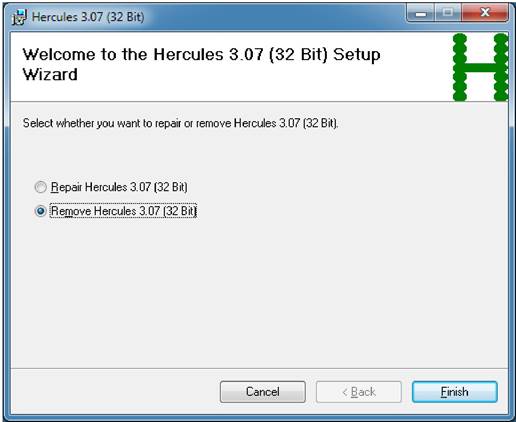 Figure 29: Welcome Window (Removing MSVC Installer Package)
After
clicking to the “Finish” button the next window appears which shows a progress
bar while Hercules is being removed from the system.
Figure 29: Welcome Window (Removing MSVC Installer Package)
After
clicking to the “Finish” button the next window appears which shows a progress
bar while Hercules is being removed from the system.

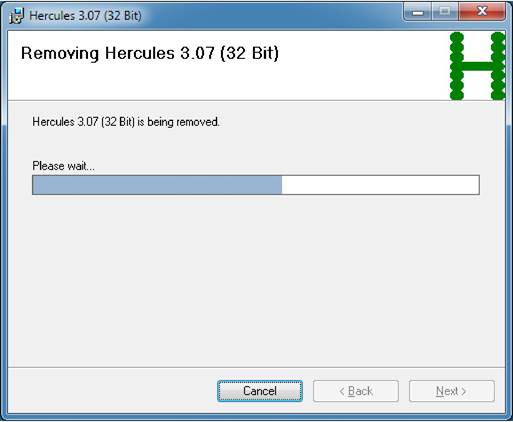 Figure 30: Uninstalling Hercules (MSVC Installer Package)
When the installer has finished its
work the last window is shown which is confirming that Hercules has been
successfully removed from the system.
Figure 30: Uninstalling Hercules (MSVC Installer Package)
When the installer has finished its
work the last window is shown which is confirming that Hercules has been
successfully removed from the system.

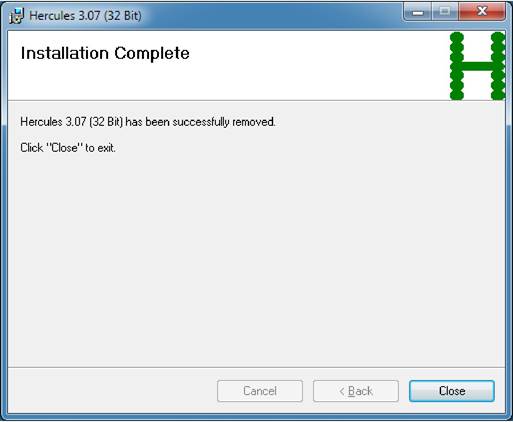 Figure 31:
Uninstallation complete (MSVC Installer Package)
To install the new Hercules version just follow now the
instructions in section 9.3 “Installation Steps (MSVC Windows Installer
Package)”. After installing the new version please make sure to change the
pathname to the new installation path in any batch file or script you are
running.
If you gave the installation directory a “neutral” name (like “drive:\Hercules\”)
that is still the same name as the one in the old installation then no changes
in your batch files or scripts are necessary at all.
Figure 31:
Uninstallation complete (MSVC Installer Package)
To install the new Hercules version just follow now the
instructions in section 9.3 “Installation Steps (MSVC Windows Installer
Package)”. After installing the new version please make sure to change the
pathname to the new installation path in any batch file or script you are
running.
If you gave the installation directory a “neutral” name (like “drive:\Hercules\”)
that is still the same name as the one in the old installation then no changes
in your batch files or scripts are necessary at all.
 10.4
Parallel Installations with the “MSVC Windows Installer Package”
If you prefer to have the new version of Hercules running in
parallel to the old version on your system, then you have to skip the
previously described uninstallation of the old version. In this case just start
the installation program of the new version and follow the instructions in
section 9.3 (“Installation Steps (MSVC Windows Installer Package)”).
Because Hercules is installed by default in a directory with a
folder name containing the release number (if you did not choose a name on your
own), the two versions can coexist on your system.
Take care however, if you gave the old version another installation
path than the default (i.e. a path name without version indicator, like “drive:\Hercules”).
In this case please make sure to give the new installation a different
installation path than you gave to the old version, otherwise the files of the
old versions will be overwritten by the newer ones.
After
installing the new version please make sure to have a second set of any batch
file or script in place that you are using for running Hercules, to be able to
differentiate between the two installations. This is necessary to be able to
start either the old version or the new version of Hercules.
10.4
Parallel Installations with the “MSVC Windows Installer Package”
If you prefer to have the new version of Hercules running in
parallel to the old version on your system, then you have to skip the
previously described uninstallation of the old version. In this case just start
the installation program of the new version and follow the instructions in
section 9.3 (“Installation Steps (MSVC Windows Installer Package)”).
Because Hercules is installed by default in a directory with a
folder name containing the release number (if you did not choose a name on your
own), the two versions can coexist on your system.
Take care however, if you gave the old version another installation
path than the default (i.e. a path name without version indicator, like “drive:\Hercules”).
In this case please make sure to give the new installation a different
installation path than you gave to the old version, otherwise the files of the
old versions will be overwritten by the newer ones.
After
installing the new version please make sure to have a second set of any batch
file or script in place that you are using for running Hercules, to be able to
differentiate between the two installations. This is necessary to be able to
start either the old version or the new version of Hercules.

 10.5
Upgrading using the “MSVC Binaries Only Archive”
The MSVC native version of the Hercules Emulator is delivered as a
ZIP archive. In this archive the binaries and all other necessary files (e.g.
html files etc.) are placed in a predefined directory structure required to
run Hercules.
Extracting
these files does not invoke the Windows installer therefore will not install
the “Microsoft Visual Studio 8 'C' Runtime Library” as a system file.
Please make sure that these libraries are installed on your system.
To extract
the Hercules files from the archive just run WinZip or another software which
is able to extract ZIP-files. Extract the files to a folder of your choice. The
necessary directory structure is created automatically.
The root directory that is created is called “hercules-v.rr (64
Bit)” or “hercules-v.rr (32 Bit)”, where v does
stand for the current version and rr for the current release. This
naming convention is useful if you plan to run several Hercules versions in
parallel (see section below). If your intention is to run only one Hercules
version at a time the directory can be renamed to “Hercules” without
a version or release indication.
If you
follow the predefined naming convention, then don’t forget to delete the folder
with the old version otherwise you have both versions installed on your system.
After installing the new version please make sure to change the pathname to the
new installation path in any batch file or script you are using for running
Hercules.
If you want to install Hercules in a “neutral” directory (like “drive:\Hercules\”)
that has the same name as the one in the old installation then don’t forget to
delete the installation files in the existing directory before extracting the
new files to this same location.
Note: Take care about any possible files from other components
that may also reside in this directory before just deleting the whole folder.
Let them untouched in the folder or do not forget to copy them again into the
folder after installing the new version of Hercules.
In this scenario where the
installation folder does not change, no changes are necessary in any batch file
or script that you are using for running Hercules.
10.5
Upgrading using the “MSVC Binaries Only Archive”
The MSVC native version of the Hercules Emulator is delivered as a
ZIP archive. In this archive the binaries and all other necessary files (e.g.
html files etc.) are placed in a predefined directory structure required to
run Hercules.
Extracting
these files does not invoke the Windows installer therefore will not install
the “Microsoft Visual Studio 8 'C' Runtime Library” as a system file.
Please make sure that these libraries are installed on your system.
To extract
the Hercules files from the archive just run WinZip or another software which
is able to extract ZIP-files. Extract the files to a folder of your choice. The
necessary directory structure is created automatically.
The root directory that is created is called “hercules-v.rr (64
Bit)” or “hercules-v.rr (32 Bit)”, where v does
stand for the current version and rr for the current release. This
naming convention is useful if you plan to run several Hercules versions in
parallel (see section below). If your intention is to run only one Hercules
version at a time the directory can be renamed to “Hercules” without
a version or release indication.
If you
follow the predefined naming convention, then don’t forget to delete the folder
with the old version otherwise you have both versions installed on your system.
After installing the new version please make sure to change the pathname to the
new installation path in any batch file or script you are using for running
Hercules.
If you want to install Hercules in a “neutral” directory (like “drive:\Hercules\”)
that has the same name as the one in the old installation then don’t forget to
delete the installation files in the existing directory before extracting the
new files to this same location.
Note: Take care about any possible files from other components
that may also reside in this directory before just deleting the whole folder.
Let them untouched in the folder or do not forget to copy them again into the
folder after installing the new version of Hercules.
In this scenario where the
installation folder does not change, no changes are necessary in any batch file
or script that you are using for running Hercules.
 10.6
Parallel installations with the “MSVC Binaries Only Archive”
The root directory that is created during installation is called
“hercules-v.rr (64 Bit)” or “hercules-v.rr (32
Bit)” by default, where v does stand for the current version and rr
for the current release. This naming convention is useful if you plan to
run several Hercules versions in parallel.
If you decide for this naming convention
then just unzip all the files. After installing the new version please make
sure to have a second set of any batch file or script in place you are using
for running Hercules to differentiate between the two installations. This is
necessary to be able to start either the old version or the new version of
Hercules. Also do not forget any files from other components that may reside in
your existing Hercules directory. These files must also be copied to the new
installation directory.
If you don’t want to install Hercules in the predefined folder
then make sure to choose a name that is different from the old installation
folder otherwise the old files are overwritten. Also take care about any files
from other components that may reside in the old directory. These files must
also be copied to the new installation directory.
After
finishing the installation please make sure to have a second set of any batch
file or script in place for running Hercules to differentiate between the two
installations. This is necessary to be able to start either the old version or
the new version of Hercules.
10.6
Parallel installations with the “MSVC Binaries Only Archive”
The root directory that is created during installation is called
“hercules-v.rr (64 Bit)” or “hercules-v.rr (32
Bit)” by default, where v does stand for the current version and rr
for the current release. This naming convention is useful if you plan to
run several Hercules versions in parallel.
If you decide for this naming convention
then just unzip all the files. After installing the new version please make
sure to have a second set of any batch file or script in place you are using
for running Hercules to differentiate between the two installations. This is
necessary to be able to start either the old version or the new version of
Hercules. Also do not forget any files from other components that may reside in
your existing Hercules directory. These files must also be copied to the new
installation directory.
If you don’t want to install Hercules in the predefined folder
then make sure to choose a name that is different from the old installation
folder otherwise the old files are overwritten. Also take care about any files
from other components that may reside in the old directory. These files must
also be copied to the new installation directory.
After
finishing the installation please make sure to have a second set of any batch
file or script in place for running Hercules to differentiate between the two
installations. This is necessary to be able to start either the old version or
the new version of Hercules.

 11. Installing the Hercules Windows GUI
11. Installing the Hercules Windows GUI
 11.1
Downloading the Binaries
The Hercules Windows GUI can be downloaded from<wrap> www.softdevlabs.com</wrap><wrap>.</wrap> Several other programs from the
developer (David B. Trout, aka ‘Fish’) require a custom DLL, FishLib.dll, it
may be appropriate to download the FishLib package as well.
The GUI also requires some Microsoft Foundation Classes (MFC) and
C runtime DLLs (MFC42.DLL, MSVCRT.DLL, MSVCP60.DLL and DbgHelp.DLL). It is
possible that these DLLs are already present in the Windows system directory.
If not though, they must be downloaded and copied to the Windows system
directory. These DDLs are all available from <wrap>www.softdevlabs.com</wrap>.
The source code for the Hercules Windows GUI is no longer
available due to current efforts to commercialise this product.
Note: Beginning with release 1.11.1.5265 of the Windows GUI additional DLLs
are required. These are Microsoft MFC and VC Runtime DLLs that you can download
from the address mentioned above. The installation takes a few seconds and does
not require a reboot. There are a 32-bit and a 64-bit version of these DLLs.
Please ensure you are using the correct one according to the product you are
installing (32-bit or 64-bit version of the Windows GUI).
These DLLs
are normally automatically installed as part of a standard Microsoft Installer
program (.msi), however as the Windows GUI does not have an installer program
you will need to do this manually. Note that you only need to install these C
Runtime DLLs once even if new versions of HercGUI are subsequently installed.
11.1
Downloading the Binaries
The Hercules Windows GUI can be downloaded from<wrap> www.softdevlabs.com</wrap><wrap>.</wrap> Several other programs from the
developer (David B. Trout, aka ‘Fish’) require a custom DLL, FishLib.dll, it
may be appropriate to download the FishLib package as well.
The GUI also requires some Microsoft Foundation Classes (MFC) and
C runtime DLLs (MFC42.DLL, MSVCRT.DLL, MSVCP60.DLL and DbgHelp.DLL). It is
possible that these DLLs are already present in the Windows system directory.
If not though, they must be downloaded and copied to the Windows system
directory. These DDLs are all available from <wrap>www.softdevlabs.com</wrap>.
The source code for the Hercules Windows GUI is no longer
available due to current efforts to commercialise this product.
Note: Beginning with release 1.11.1.5265 of the Windows GUI additional DLLs
are required. These are Microsoft MFC and VC Runtime DLLs that you can download
from the address mentioned above. The installation takes a few seconds and does
not require a reboot. There are a 32-bit and a 64-bit version of these DLLs.
Please ensure you are using the correct one according to the product you are
installing (32-bit or 64-bit version of the Windows GUI).
These DLLs
are normally automatically installed as part of a standard Microsoft Installer
program (.msi), however as the Windows GUI does not have an installer program
you will need to do this manually. Note that you only need to install these C
Runtime DLLs once even if new versions of HercGUI are subsequently installed.
 11.2
Installation Steps
The installation involves simply unzipping the executables into the
directory where the Hercules executables reside. No other installation steps
are required. Uninstalling is the reverse, just delete the files.
On its first startup the Hercules Windows GUI adds a new key to
the Windows registry to hold some configuration settings. To completely remove
all trace of the GUI you must manually delete this key using a registry editor
such as the Microsoft “regedit” utility.
The
Hercules Windows GUI uses the following registry key:
“HKEY_CURRENT_USER/Software/Software
Development Laboratories/Hercules”
11.2
Installation Steps
The installation involves simply unzipping the executables into the
directory where the Hercules executables reside. No other installation steps
are required. Uninstalling is the reverse, just delete the files.
On its first startup the Hercules Windows GUI adds a new key to
the Windows registry to hold some configuration settings. To completely remove
all trace of the GUI you must manually delete this key using a registry editor
such as the Microsoft “regedit” utility.
The
Hercules Windows GUI uses the following registry key:
“HKEY_CURRENT_USER/Software/Software
Development Laboratories/Hercules”
 11.3
Customization Steps
The first time the Hercules Windows GUI is started it will open
the Preferences dialog. Completing this dialog is the only customization
required, it adds necessary information (e.g. directory names) required for the
GUI to operate.
The
following topics describe the various dialogs in detail. Please note that this
installation section describes many of the tasks involved in the use of the
GUI in preference to separating this information into the Hercules User
Reference Manual.
11.3
Customization Steps
The first time the Hercules Windows GUI is started it will open
the Preferences dialog. Completing this dialog is the only customization
required, it adds necessary information (e.g. directory names) required for the
GUI to operate.
The
following topics describe the various dialogs in detail. Please note that this
installation section describes many of the tasks involved in the use of the
GUI in preference to separating this information into the Hercules User
Reference Manual.

 11.4 Main
Screen
The various panels of the main screen can be re-located to suit
the user's preferences. The device list bar can be docked on either side of the
screen and the various status bars at either the top or bottom of the screen.
You can float them in a window by themselves or you can hide them altogether.
To do this
just grab the panel using your mouse and drag it to your preferred location.
The screen layout is remembered across sessions. If you place the controls
panel at the bottom of the screen, then it will be in the same place the next
time you start Hercules.
11.4 Main
Screen
The various panels of the main screen can be re-located to suit
the user's preferences. The device list bar can be docked on either side of the
screen and the various status bars at either the top or bottom of the screen.
You can float them in a window by themselves or you can hide them altogether.
To do this
just grab the panel using your mouse and drag it to your preferred location.
The screen layout is remembered across sessions. If you place the controls
panel at the bottom of the screen, then it will be in the same place the next
time you start Hercules.
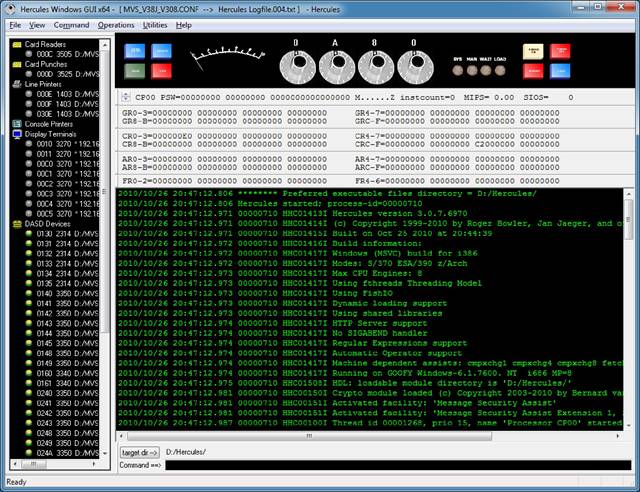 Figure 32: Hercules Windows GUI Main Panel
Since version 1.9.5 the Hercules Windows GUI allows you to specify
the target directory that the 'sh' (shell) command will use. Simply browse to
and select the desired directory using the GUI.
Once this
is set any shell command entered will be processed using the defined directory
as its current working directory. This provides a workaround for the fact that
the Windows GUI's current directory changes depending on the dialog in use.
This also compensates for the fact that prior to version 3.03 Hercules's
current directory normally never changes.
Figure 32: Hercules Windows GUI Main Panel
Since version 1.9.5 the Hercules Windows GUI allows you to specify
the target directory that the 'sh' (shell) command will use. Simply browse to
and select the desired directory using the GUI.
Once this
is set any shell command entered will be processed using the defined directory
as its current working directory. This provides a workaround for the fact that
the Windows GUI's current directory changes depending on the dialog in use.
This also compensates for the fact that prior to version 3.03 Hercules's
current directory normally never changes.

 11.5
Preferences
The Preferences dialog is where directories, file extensions,
logging options etc. are defined. The following subtopics describe each of the
Preferences tabs in detail.
11.5.1 Directories
The
Directories tab allows you to specify the preferred directories for each file
type.
11.5
Preferences
The Preferences dialog is where directories, file extensions,
logging options etc. are defined. The following subtopics describe each of the
Preferences tabs in detail.
11.5.1 Directories
The
Directories tab allows you to specify the preferred directories for each file
type.
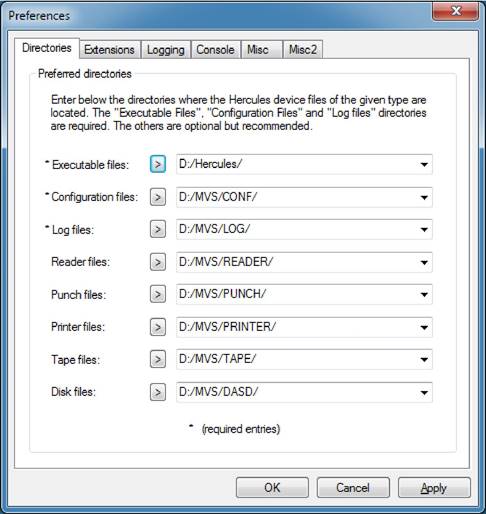 Figure 33:
Preferences Directory Tab
The path
for executable files, configuration files and log files are all required, all
others are optional and provided for convenience. If specified, they are used
as default directories by the various device configuration dialogs.
Figure 33:
Preferences Directory Tab
The path
for executable files, configuration files and log files are all required, all
others are optional and provided for convenience. If specified, they are used
as default directories by the various device configuration dialogs.

11.5.2 File
Extensions
The File Extensions tab allows you to specify the preferred file
extensions used in the “Files of type”
dropdown list in all standard 'Open' and 'Save as' dialog boxes that the
Hercules Windows GUI uses.
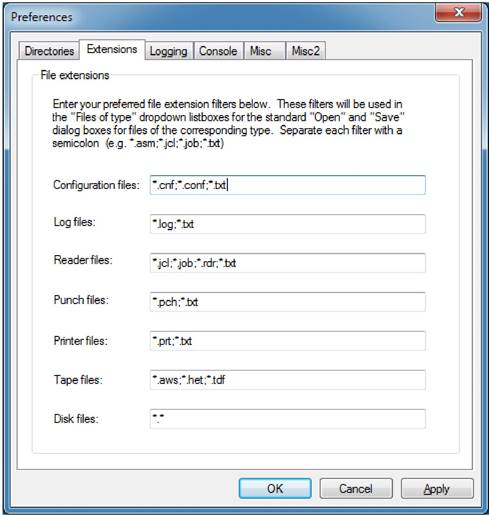 Figure 34:
Preferences Extensions Tab
This
feature allows each user to have different naming conventions for their reader,
punch and disk files etc.
Figure 34:
Preferences Extensions Tab
This
feature allows each user to have different naming conventions for their reader,
punch and disk files etc.

11.5.3 Logging
The Logging
tab allows you to specify the preferred console logging options.
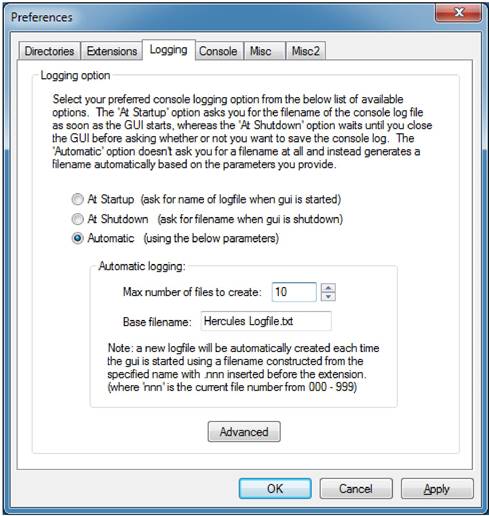 Figure 35:
Preferences Logging Tab
The 'At Startup' option requests the
filename of the console log file when the GUI is started. The 'At Shutdown'
option asks if the console log file should be saved or not when the GUI is
about to be closed.
The
'Automatic' option does not ask for a filename at all and instead generates a
filename automatically based on the parameters provided. For example, if the
base filename is “Hercules Logfile.txt” the generated log filename
will be “Hercules Logfile.000.txt” the first time the GUI is started,
then “Hercules Log-file.001.txt” for the next start of the GUI, etc.
Starting with version 1.4.0, once log files are created by
whichever method, they are written to continuously as new messages arrive.
This removes the need to do a periodic “Save Messages”.
As new
messages are now automatically written to the log file during Hercules
execution, it is recommended to use the “Advanced Logging Options”
dialog to specify the maximum log file size in number of lines. This is meant
to prevent the log file from filling up your hard drive. Use the ‘Advanced’
button on the main Logging preferences tab to access these settings.
Figure 35:
Preferences Logging Tab
The 'At Startup' option requests the
filename of the console log file when the GUI is started. The 'At Shutdown'
option asks if the console log file should be saved or not when the GUI is
about to be closed.
The
'Automatic' option does not ask for a filename at all and instead generates a
filename automatically based on the parameters provided. For example, if the
base filename is “Hercules Logfile.txt” the generated log filename
will be “Hercules Logfile.000.txt” the first time the GUI is started,
then “Hercules Log-file.001.txt” for the next start of the GUI, etc.
Starting with version 1.4.0, once log files are created by
whichever method, they are written to continuously as new messages arrive.
This removes the need to do a periodic “Save Messages”.
As new
messages are now automatically written to the log file during Hercules
execution, it is recommended to use the “Advanced Logging Options”
dialog to specify the maximum log file size in number of lines. This is meant
to prevent the log file from filling up your hard drive. Use the ‘Advanced’
button on the main Logging preferences tab to access these settings.

 |
|
|
|
|


























 Figure 36:
Advanced Logging Options Memory Tab
Figure 36:
Advanced Logging Options Memory Tab
























 Figure 37:
Advanced Logging Options Disk Tab
Figure 37:
Advanced Logging Options Disk Tab

 Figure 38:
Advanced Logging Options Format Tab
Figure 38:
Advanced Logging Options Format Tab
The log
file is a wrap-around file, where the oldest messages will be overwritten by
newer messages when the specified size limit has been reached. Once the
specified maximum number of lines has been written to the log file, the GUI
will reset its file position pointer back to the beginning of the file and
begin writing new log file messages over the top of older ones.
The file is not recreated when full. When it wraps around and
begins to overlay older messages, the messages near the end of the log file are
still present until eventually overwritten.
Note too that the Advanced Logging Options dialog lets you specify
the maximum number of messages to be retained in memory. A limit is required to
prevent run-away memory consumption. This memory limit is a separate value from
the disk log file limit and essentially controls how far back you can scroll
the console to see older messages.
11.5.4 Console
The Console
Tab allows it to specify the preferred console font, font colour and background
colour for the Hercules console message area.

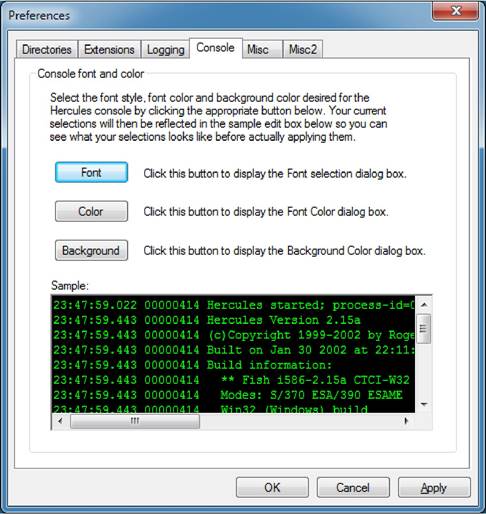 Figure 39:
Preferences Console Tab
Simply click on the appropriate button and select the font or
color. Your selection will then be reflected in the sample edit-box to let you
see what the console would actually look like before your changes are applied.
11.5.5 Misc
The Misc
Tab allows you to specify various miscellaneous preferences, such as how the
GUI should react to your pressing the “Power Off” button.
Figure 39:
Preferences Console Tab
Simply click on the appropriate button and select the font or
color. Your selection will then be reflected in the sample edit-box to let you
see what the console would actually look like before your changes are applied.
11.5.5 Misc
The Misc
Tab allows you to specify various miscellaneous preferences, such as how the
GUI should react to your pressing the “Power Off” button.

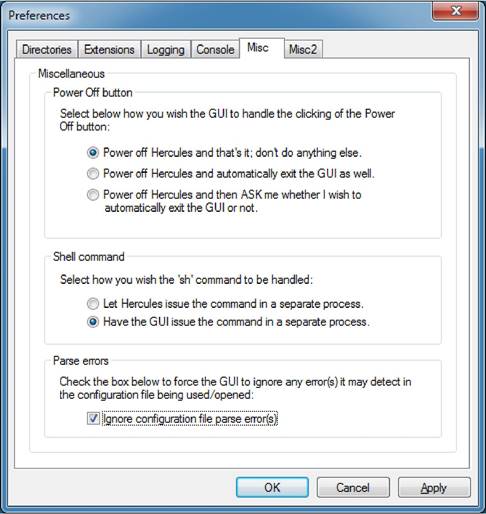 Figure 40:
Preferences Misc Tab
When shell command support was added to Hercules for the Windows
environment a bug was revealed in the manner that Cygwin processed the 'fork'
command. Although a workaround was developed the GUI was also modified to be
able to issue the shell commands directly instead.
In order for the GUI to be able to issue shell commands instead of
Hercules itself a new program called 'conspawn.exe' was developed. The GUI
passes the shell command to conspawn for execution. The conspawn program is
included as part of the GUI package and must reside in the same directory as
the other Hercules executables.
The Ignore Parse Errors option was created to allow you to open
and use a Hercules control file that the GUI would otherwise fail to parse
properly for whatever reason.
When a control file is opened the GUI parses the statements and
saves the information in an internal control area. This information is used
later to complete various fields in the dialogs such as the device configuration
dialog. If the GUI cannot properly parse a given control file statement it
throws a parse error and prevents you from opening or using what it considers
to be a bad control file. This option can be used to bypass this error, for
example when using a device statement containing a new parameter that Hercules
understands but the GUI may not yet support.
The “Ignore Parse Errors” option instructs the GUI to ignore
the parse error and open and use the control file anyway. When this option is
set the GUI ignores all parse errors and will always successfully open whatever
control file you instruct it to. As the GUI can update the Hercules control
file, it is highly recom-
Figure 40:
Preferences Misc Tab
When shell command support was added to Hercules for the Windows
environment a bug was revealed in the manner that Cygwin processed the 'fork'
command. Although a workaround was developed the GUI was also modified to be
able to issue the shell commands directly instead.
In order for the GUI to be able to issue shell commands instead of
Hercules itself a new program called 'conspawn.exe' was developed. The GUI
passes the shell command to conspawn for execution. The conspawn program is
included as part of the GUI package and must reside in the same directory as
the other Hercules executables.
The Ignore Parse Errors option was created to allow you to open
and use a Hercules control file that the GUI would otherwise fail to parse
properly for whatever reason.
When a control file is opened the GUI parses the statements and
saves the information in an internal control area. This information is used
later to complete various fields in the dialogs such as the device configuration
dialog. If the GUI cannot properly parse a given control file statement it
throws a parse error and prevents you from opening or using what it considers
to be a bad control file. This option can be used to bypass this error, for
example when using a device statement containing a new parameter that Hercules
understands but the GUI may not yet support.
The “Ignore Parse Errors” option instructs the GUI to ignore
the parse error and open and use the control file anyway. When this option is
set the GUI ignores all parse errors and will always successfully open whatever
control file you instruct it to. As the GUI can update the Hercules control
file, it is highly recom-

mended that you leave this option disabled and enable it only when
needed to avoid accidentally damaging a file that may not contain valid
Hercules control specifications.
If you do need to enable this option, remember to disable it when
no longer needed as once enabled it will stay that way until you purposely
disable it. Like all preference options it is persistent across executions of
the GUI.
11.5.6 Misc2
The Misc2
Tab provides additional options that would not fit on the original Misc options
tab.
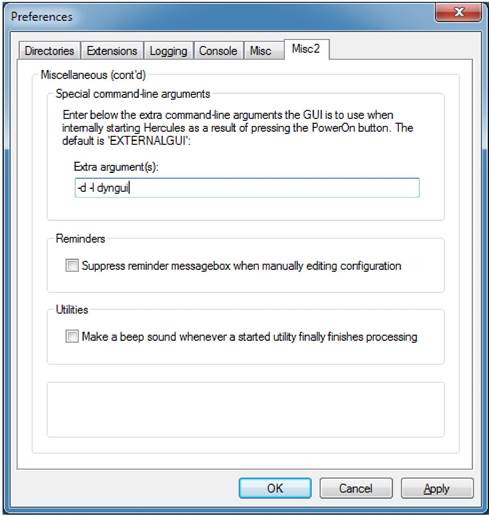 Figure 41:
Preferences Misc2 Tab
Since version 3.0 of Hercules support has been added for
command-line options beyond the existing -f (control file) option. Here you can
enter any of the new command-line options you may wish to have issued whenever
the GUI starts up (“Powers On”) the Hercules emulator.
Note that
you must not specify the -f option here. The GUI constructs the -f option
automatically based on the configuration file previously defined in the
Preferences dialog. You may enter any other command-line options in addition to
the required ones - see the important note immediately below.
Figure 41:
Preferences Misc2 Tab
Since version 3.0 of Hercules support has been added for
command-line options beyond the existing -f (control file) option. Here you can
enter any of the new command-line options you may wish to have issued whenever
the GUI starts up (“Powers On”) the Hercules emulator.
Note that
you must not specify the -f option here. The GUI constructs the -f option
automatically based on the configuration file previously defined in the
Preferences dialog. You may enter any other command-line options in addition to
the required ones - see the important note immediately below.

You must
specify here either “EXTERNALGUI” (without quotes) or – starting with
Hercules Version 3.0 – a new command line option ”-d -l dyngui“. This
option must not be left blank. If you accidentally leave this option blank it
is possible that both Hercules and the GUI will not operate at all and highly
likely that they will not operate as expected.
This is an advanced option and should
not be modified by end users. Please only change this if instructed to by
Hercules Technical Support or Hercules developers.
 11.6 System
Configuration
When a Hercules control file is opened by the GUI it is parsed and
then a “System Configuration” dialog is displayed showing the various
configuration settings.
Since HercGUI version 1.9.5 the System
Configuration dialog information is displayed in three separate property pages:
the Architecture page, the O/S Tailor settings page and the Other / Misc page.
The Identification section simply displays the full pathname of
the configuration file that was opened and provides an input field for a text
description to be associated with this particular configuration file. This is
in case you have multiple system configurations where it is useful to have some
indication that you are modifying the correct one. The description you enter
here is saved as a comment at the beginning of the configuration file.
11.6.1 Architecture Settings
This page of the System Configuration dialog is where you define
various hardware and architectural settings, e.g. how many emulated CPUs, how
much emulated main storage etc.
The Architecture radio buttons allow you to define the default
architectural mode your emulated CPUs will be initially started in. For
emulated z/Architecture machines the actual IPL takes place in ESA/390 mode and
it is the responsibility of the IPL'ed operating system to switch the CPU(s)
into z/Architecture mode when it is ready to use this mode. It does this using
the SIGP instruction.
The
following figure shows the Architecture Settings tab.
11.6 System
Configuration
When a Hercules control file is opened by the GUI it is parsed and
then a “System Configuration” dialog is displayed showing the various
configuration settings.
Since HercGUI version 1.9.5 the System
Configuration dialog information is displayed in three separate property pages:
the Architecture page, the O/S Tailor settings page and the Other / Misc page.
The Identification section simply displays the full pathname of
the configuration file that was opened and provides an input field for a text
description to be associated with this particular configuration file. This is
in case you have multiple system configurations where it is useful to have some
indication that you are modifying the correct one. The description you enter
here is saved as a comment at the beginning of the configuration file.
11.6.1 Architecture Settings
This page of the System Configuration dialog is where you define
various hardware and architectural settings, e.g. how many emulated CPUs, how
much emulated main storage etc.
The Architecture radio buttons allow you to define the default
architectural mode your emulated CPUs will be initially started in. For
emulated z/Architecture machines the actual IPL takes place in ESA/390 mode and
it is the responsibility of the IPL'ed operating system to switch the CPU(s)
into z/Architecture mode when it is ready to use this mode. It does this using
the SIGP instruction.
The
following figure shows the Architecture Settings tab.

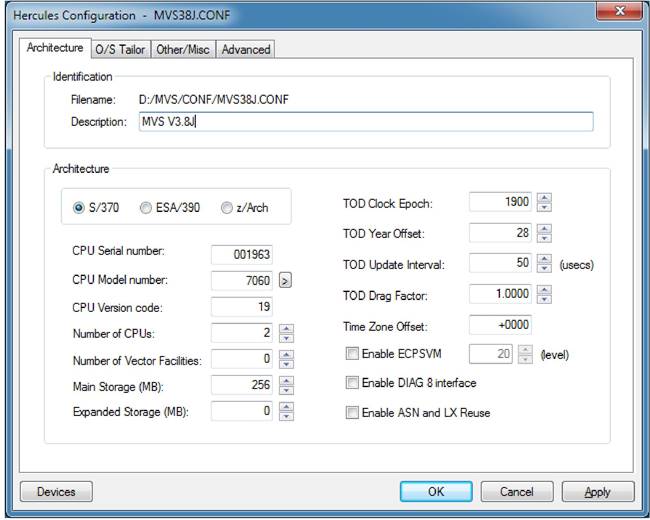 Figure 42: Architecture Settings Tab
In the main
System Configuration dialog, if the GUI finds a specially formatted file called
“cpu-types.txt” in your preferred configuration files directory, a
small '>' button will appear next to the “CPU Model number”
edit-box. This file may contain a list of the various CPU model numbers, their
names and their corresponding STIDP (Store CPU ID instruction) values.
When the System Configuration dialog is initialized, if the GUI
finds this file, it will parse the entries and use them to construct a drop-down
box that will be displayed when you click the '>' button. This allows you to
easily select the desired CPU Model you wish your virtual mainframe to be
reported as.
Neither the GUI nor the Hercules Emulator itself makes any attempt
to try and emulate all aspects or features of a given CPU model. This CPU
model number simply specifies what value to use in the STIDP (Store CPU ID)
instruction.
When your CPU Model is selected in this way the GUI automatically fills
in the “CPU Model number” edit-box field with the corresponding value
it finds in the “cpu-types” file. You have the option of manually
overriding this value. A sample “cpu-types” text file is included
with the distribution of the Hercules GUI.
Figure 42: Architecture Settings Tab
In the main
System Configuration dialog, if the GUI finds a specially formatted file called
“cpu-types.txt” in your preferred configuration files directory, a
small '>' button will appear next to the “CPU Model number”
edit-box. This file may contain a list of the various CPU model numbers, their
names and their corresponding STIDP (Store CPU ID instruction) values.
When the System Configuration dialog is initialized, if the GUI
finds this file, it will parse the entries and use them to construct a drop-down
box that will be displayed when you click the '>' button. This allows you to
easily select the desired CPU Model you wish your virtual mainframe to be
reported as.
Neither the GUI nor the Hercules Emulator itself makes any attempt
to try and emulate all aspects or features of a given CPU model. This CPU
model number simply specifies what value to use in the STIDP (Store CPU ID)
instruction.
When your CPU Model is selected in this way the GUI automatically fills
in the “CPU Model number” edit-box field with the corresponding value
it finds in the “cpu-types” file. You have the option of manually
overriding this value. A sample “cpu-types” text file is included
with the distribution of the Hercules GUI.

11.6.2 O/S Tailor Settings
The O/S Tailor settings page is where you can establish certain
settings related to the type of guest operating system you intend to actually
run on your virtual mainframe. The purpose of the O/S Tailor radio buttons is
to limit the amount of Hercules generated message traffic by selectively
suppressing certain program check and trace type messages which are considered
normal for the specified operating system.
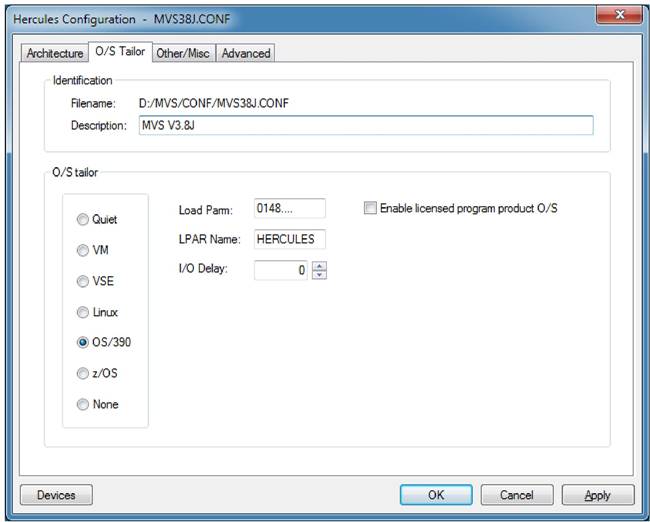 Figure 43:
O/S Tailor Settings Tab
When the
“Enable licensed program product O/S” option is specified for a given
control file any attempt to power on Hercules using that control file will
result in a dialog box being displayed that asks you to verify your true
intentions.
Figure 43:
O/S Tailor Settings Tab
When the
“Enable licensed program product O/S” option is specified for a given
control file any attempt to power on Hercules using that control file will
result in a dialog box being displayed that asks you to verify your true
intentions.

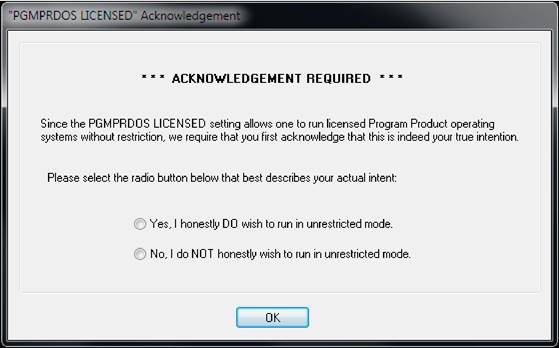 Figure 44:
PGMPRDOS LICENSED Acknowledgment
As soon as this dialog is displayed a 10-minute timer is started.
If you respond before the timer expires your response is accepted as-is. If
your response is “No, I do NOT honestly wish to run in unrestricted
mode” then your virtual mainframe will not be powered on. If your response
is “Yes” - whether explicit or presumed (see next paragraph) - then
Hercules will be powered on.
Please note that if you fail to respond within the 10-minute time
limit your response is presumed to be “Yes, I honestly DO wish to run in
unrestricted mode”. If you do not wish to wait the entire 10 minutes then
you will have to respond to the dialog manually yourself. There is no way to
disable or override this feature.
This dialog is displayed each time you attempt to power on Hercules
during a given Hercules GUI session when using a configuration file with the
“Enable licensed program product O/S” option checked. Although you
only have to respond to this message once during a single session if you
continue to use the same configuration file. If you switch to a different
configuration file and then return later to the first one (or exit the GUI
entirely and start it again), you will be asked once again to confirm your
intent.
11.6.3 Other / Misc Settings
The
“Other / Misc” window allows you to define more system configuration
values, mostly related the internal functioning of the Hercules emulator.
Please refer to the documentation for the Hercules emulator itself for more
information regarding the various values that may be specified here.
Figure 44:
PGMPRDOS LICENSED Acknowledgment
As soon as this dialog is displayed a 10-minute timer is started.
If you respond before the timer expires your response is accepted as-is. If
your response is “No, I do NOT honestly wish to run in unrestricted
mode” then your virtual mainframe will not be powered on. If your response
is “Yes” - whether explicit or presumed (see next paragraph) - then
Hercules will be powered on.
Please note that if you fail to respond within the 10-minute time
limit your response is presumed to be “Yes, I honestly DO wish to run in
unrestricted mode”. If you do not wish to wait the entire 10 minutes then
you will have to respond to the dialog manually yourself. There is no way to
disable or override this feature.
This dialog is displayed each time you attempt to power on Hercules
during a given Hercules GUI session when using a configuration file with the
“Enable licensed program product O/S” option checked. Although you
only have to respond to this message once during a single session if you
continue to use the same configuration file. If you switch to a different
configuration file and then return later to the first one (or exit the GUI
entirely and start it again), you will be asked once again to confirm your
intent.
11.6.3 Other / Misc Settings
The
“Other / Misc” window allows you to define more system configuration
values, mostly related the internal functioning of the Hercules emulator.
Please refer to the documentation for the Hercules emulator itself for more
information regarding the various values that may be specified here.

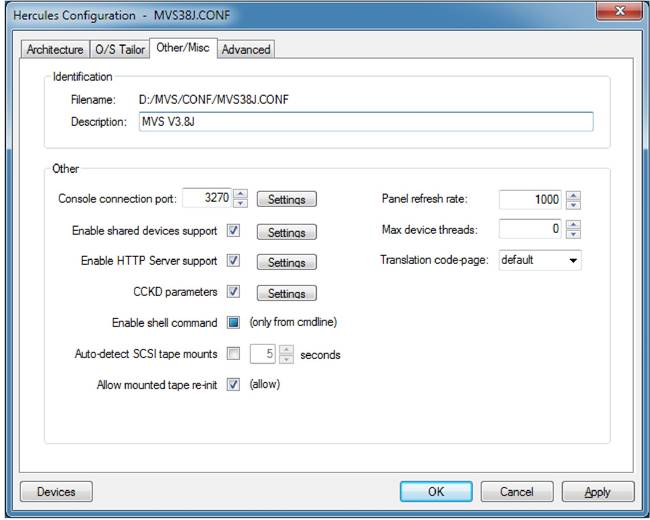 Figure 45:
Other / Misc Tab
Within this
tab several other settings can be specified. If the “Enable shared devices
support” checkbox is marked, then the settings window can be opened which
allows to specify the port for the Shared Devices Server.
Figure 45:
Other / Misc Tab
Within this
tab several other settings can be specified. If the “Enable shared devices
support” checkbox is marked, then the settings window can be opened which
allows to specify the port for the Shared Devices Server.
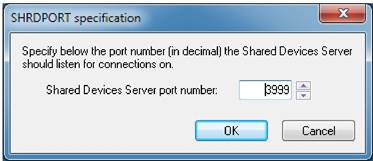 Figure 46:
SHRDPORT specification
Figure 46:
SHRDPORT specification

Hercules's HTTP Server support allows you to control Hercules via any
standards compliant web browser. This dialog allows you to define the HTTP
Server parameters that Hercules is to use.
 Figure 47:
HTTP Server Parameters
Enter the port number for Hercules's HTTP Server to listen on and
if desired specify the authentication criteria needed to connect to the server.
You can also enter the root directory from which the web pages will be served.
If you enter a userid for authentication then you must also enter
a password. If no userid and password are entered then anyone with a browser
that is able to connect to your Windows host system will be able to control
your Hercules system via the HTTP Server interface. The password you enter is
not encrypted in any way and is stored in your Hercules control file, as well
as passed through the network, in unencryp-ted plain text format. You should
therefore take whatever steps are required to secure Hercules control file(s)
that contain HTTP Server passwords.
Since Hercules
version 2.17 the behavior Compressed CKD DASD (CCKD) functionality is
controlled via the setting of certain global parameters. CCKD functionality is
no longer adjustable on an individual device-by-device basis.
Figure 47:
HTTP Server Parameters
Enter the port number for Hercules's HTTP Server to listen on and
if desired specify the authentication criteria needed to connect to the server.
You can also enter the root directory from which the web pages will be served.
If you enter a userid for authentication then you must also enter
a password. If no userid and password are entered then anyone with a browser
that is able to connect to your Windows host system will be able to control
your Hercules system via the HTTP Server interface. The password you enter is
not encrypted in any way and is stored in your Hercules control file, as well
as passed through the network, in unencryp-ted plain text format. You should
therefore take whatever steps are required to secure Hercules control file(s)
that contain HTTP Server passwords.
Since Hercules
version 2.17 the behavior Compressed CKD DASD (CCKD) functionality is
controlled via the setting of certain global parameters. CCKD functionality is
no longer adjustable on an individual device-by-device basis.
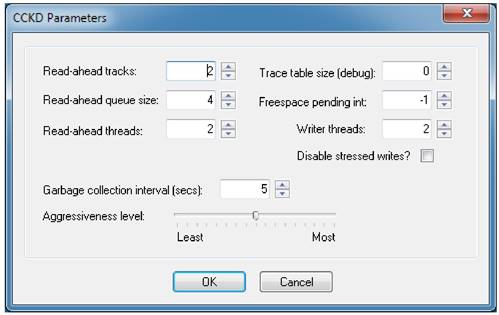 Figure 48:
CCKD Parameters
Figure 48:
CCKD Parameters

11.6.4 Advanced Settings
The Advanced configuration page is where settings for features
that are intended only for more advanced users may be made. If you have a
custom dynamic module (DLL) you wish Hercules to use or wish to modify
Hercules's default priority settings you would do that here.
Please see
the “Hercules User Reference Guide” for more details on the options presented
here.




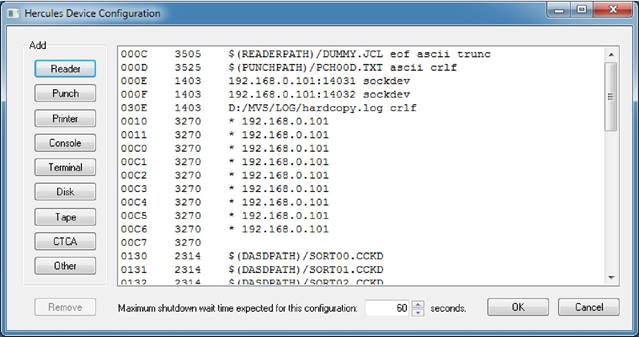 Figure 50:
Device Configuration
The “Maximum shutdown wait time expected for this
configuration” setting defines a time limit to the Hercules GUI. This
limit is the amount of time the GUI is to expect between when the 'quit'
command is issued (or the “Power Off” button is pressed) and when
Hercules finally finishes exiting after completing its shutdown sequence.
When you use compressed disks (CCKD) Hercules needs time to
write-back cached copies of track images and adjust the free space for each
disk before it can safely exit. If the expected wait time is exceeded the GUI
issues a warning asking whether to continue waiting or forcibly terminate the
Hercules Emulator process. If many compressed disks are frequently updated it
can take over a minute to write all cached data to disk.
It is safe to specify a value for this setting that is high enough
for all likely cases in your environment. The Hercules GUI will terminate as
soon as Hercules itself ends regardless of the wait time setting.
Right clicking on a device statement presents a context menu from
which you can select 'Edit' or 'Properties'. Selecting 'Properties' presents
the “Reinitialize Device” dialog, also displayed by double-clicking
the device statement.
When 'Edit'
is selected from the right-click context menu you are presented with a simple
device statement edit dialog. From here you can directly modify raw device
statements.
Figure 50:
Device Configuration
The “Maximum shutdown wait time expected for this
configuration” setting defines a time limit to the Hercules GUI. This
limit is the amount of time the GUI is to expect between when the 'quit'
command is issued (or the “Power Off” button is pressed) and when
Hercules finally finishes exiting after completing its shutdown sequence.
When you use compressed disks (CCKD) Hercules needs time to
write-back cached copies of track images and adjust the free space for each
disk before it can safely exit. If the expected wait time is exceeded the GUI
issues a warning asking whether to continue waiting or forcibly terminate the
Hercules Emulator process. If many compressed disks are frequently updated it
can take over a minute to write all cached data to disk.
It is safe to specify a value for this setting that is high enough
for all likely cases in your environment. The Hercules GUI will terminate as
soon as Hercules itself ends regardless of the wait time setting.
Right clicking on a device statement presents a context menu from
which you can select 'Edit' or 'Properties'. Selecting 'Properties' presents
the “Reinitialize Device” dialog, also displayed by double-clicking
the device statement.
When 'Edit'
is selected from the right-click context menu you are presented with a simple
device statement edit dialog. From here you can directly modify raw device
statements.
 Figure 51:
Edit Device Configuration Statement
Figure 51:
Edit Device Configuration Statement

To add a
new device, click on one of the 'Add' buttons:
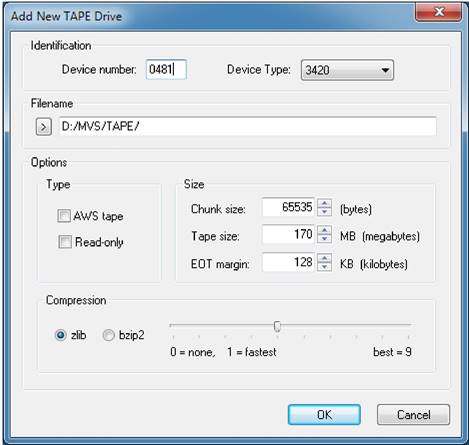 Figure 52:
Add New Device
To delete a
device select the desired device first to highlight it and then click on the
'Remove' button. To modify (reinitialize) an existing device, double-click on
the entry for the desired device:
Figure 52:
Add New Device
To delete a
device select the desired device first to highlight it and then click on the
'Remove' button. To modify (reinitialize) an existing device, double-click on
the entry for the desired device:

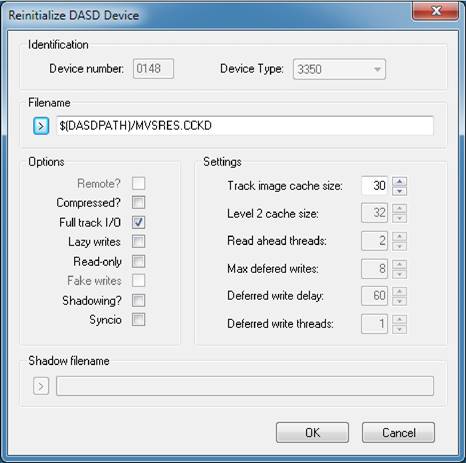 Figure 53:
Reinitialize Device
Note: If
you used any of the new CCKD parameters on the main System Configuration
dialog, some controls in the above dialog will not be displayed. This occurs
because the new System Configuration CCKD parameters modify CCKD functionality
on a system-wide basis and remove the ability to specify these parameters on
per-device basis.
Figure 53:
Reinitialize Device
Note: If
you used any of the new CCKD parameters on the main System Configuration
dialog, some controls in the above dialog will not be displayed. This occurs
because the new System Configuration CCKD parameters modify CCKD functionality
on a system-wide basis and remove the ability to specify these parameters on
per-device basis.
 11.8
Display / Alter Memory
The “Display / Alter Memory” item in the command menu
allows you to display or modify absolute main storage.
It is very important that you keep in mind that when you alter
absolute main storage via this dialog then neither the storage keys nor the CPU
instruction and data caches are updated in the Hercules emulator itself.
Instead the memory of the Hercules emulated operating system is directly
modified without the Hercules Emulator knowing of this.
Please use this feature with caution. It is designed for examining
and searching main storage for emulator debugging purposes and not as a safe
means of modifying hosted operating system storage.
The
following figure shows the “Display / Alter Memory” dialog.
11.8
Display / Alter Memory
The “Display / Alter Memory” item in the command menu
allows you to display or modify absolute main storage.
It is very important that you keep in mind that when you alter
absolute main storage via this dialog then neither the storage keys nor the CPU
instruction and data caches are updated in the Hercules emulator itself.
Instead the memory of the Hercules emulated operating system is directly
modified without the Hercules Emulator knowing of this.
Please use this feature with caution. It is designed for examining
and searching main storage for emulator debugging purposes and not as a safe
means of modifying hosted operating system storage.
The
following figure shows the “Display / Alter Memory” dialog.

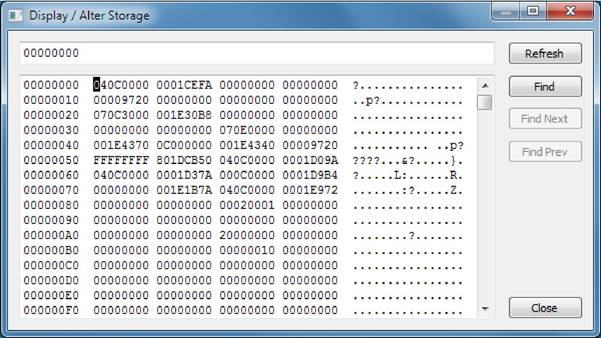 Figure 54:
Display / Alter Memory Dialog
If you need to modify real or virtual storage it is highly recommended
that you use the Hercules Emulator 'r' and 'v' panel commands. These ensure
that the hardware emulator is aware of any changes.
Figure 54:
Display / Alter Memory Dialog
If you need to modify real or virtual storage it is highly recommended
that you use the Hercules Emulator 'r' and 'v' panel commands. These ensure
that the hardware emulator is aware of any changes.
 11.9 Load
Card Reader, Load Tape, Unload Tape
These menu
items provide a quick and easy way to do just as their descriptions suggest.
The 'Load Reader' command is provides an interface to submit jobs to the
system. It displays the “Reinitialize Device” dialog for the card
reader. From here you can use standard Windows 'Open File' dialogs to browse
for a file that you want to submit. The selected file will be loaded into the
card reader. Clicking OK issues the appropriate Hercules ‘devinit’ panel
command.
11.9 Load
Card Reader, Load Tape, Unload Tape
These menu
items provide a quick and easy way to do just as their descriptions suggest.
The 'Load Reader' command is provides an interface to submit jobs to the
system. It displays the “Reinitialize Device” dialog for the card
reader. From here you can use standard Windows 'Open File' dialogs to browse
for a file that you want to submit. The selected file will be loaded into the
card reader. Clicking OK issues the appropriate Hercules ‘devinit’ panel
command.

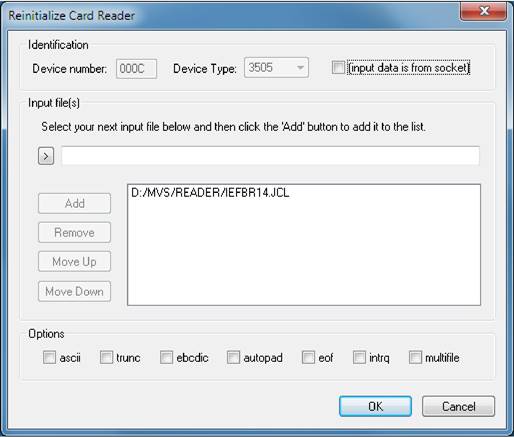 Figure 55:
Reinitialize Card Reader Dialog
The
“input data is from socket” option is found to the right of the
device type field. It allows you to tell Hercules to obtain card reader input
from a specified socket instead of a disk file as by default. This allows you
to submit card decks remotely using a simple utility that connects to the
specified socket and writes card images directly to Hercules. Recent releases
of the GUI provide a DOS program “HercRdr” to support this
capability. For more information on the HercRdr utility and the 'sockdev' option
refer to the Hercules User Reference Guide.
Figure 55:
Reinitialize Card Reader Dialog
The
“input data is from socket” option is found to the right of the
device type field. It allows you to tell Hercules to obtain card reader input
from a specified socket instead of a disk file as by default. This allows you
to submit card decks remotely using a simple utility that connects to the
specified socket and writes card images directly to Hercules. Recent releases
of the GUI provide a DOS program “HercRdr” to support this
capability. For more information on the HercRdr utility and the 'sockdev' option
refer to the Hercules User Reference Guide.
 11.10
Device List Bar
The
“Device List” bar, similarly to its non-GUI console mode counterpart,
lists the devices in the current configuration and their status.
11.10
Device List Bar
The
“Device List” bar, similarly to its non-GUI console mode counterpart,
lists the devices in the current configuration and their status.

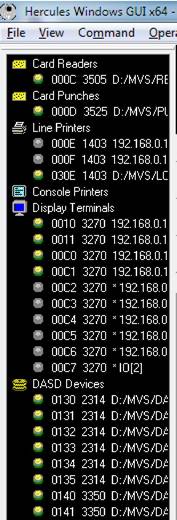 Figure 56:
Device List Bar
A grey diode indicates that the device is offline and not open. A
green diode indicates it is online or open. The green diode changes to yellow
whenever the device is busy and changes to red when there is an interrupt
pending for the device.
As the hosted system runs and performs I/O
to the devices in your configuration you will see the diodes change between
yellow, red and green. This shows that there is I/O activity taking place on
the device.
Devices are displayed in a tree-list with a branch for each class
of device. Right-clicking the Devices within a branch presents a context
sensitive menu. You can also right-click each branch.
To add a
new disk drive to your configuration right-click on the “DASD
Devices” branch and select 'Add device' from the menu that appears. To
delete (“detach”), rename (“define”), reinitialize
(“devinit”) or present an attention interrupt (“i”) for a
particular device, right-click the device and select the appropriate option
from the context menu presented.
Figure 56:
Device List Bar
A grey diode indicates that the device is offline and not open. A
green diode indicates it is online or open. The green diode changes to yellow
whenever the device is busy and changes to red when there is an interrupt
pending for the device.
As the hosted system runs and performs I/O
to the devices in your configuration you will see the diodes change between
yellow, red and green. This shows that there is I/O activity taking place on
the device.
Devices are displayed in a tree-list with a branch for each class
of device. Right-clicking the Devices within a branch presents a context
sensitive menu. You can also right-click each branch.
To add a
new disk drive to your configuration right-click on the “DASD
Devices” branch and select 'Add device' from the menu that appears. To
delete (“detach”), rename (“define”), reinitialize
(“devinit”) or present an attention interrupt (“i”) for a
particular device, right-click the device and select the appropriate option
from the context menu presented.

 11.11
Utilities Menu
All of the Hercules utility programs can be run by completing the
appropriate dialog. Both Hercules and these utilities run as separate
processes, so it is possible to run more than one utility at the same time as
Hercules images.
A progress dialog is displayed as each utility runs, all messages
generated by the utility are displayed on the GUI console just as Hercules
messages are. Each message is prefixed with its process ID to differentiate
between utility program messages and a timestamp.
The
following figures show an example of the DASDINIT utility window.
11.11
Utilities Menu
All of the Hercules utility programs can be run by completing the
appropriate dialog. Both Hercules and these utilities run as separate
processes, so it is possible to run more than one utility at the same time as
Hercules images.
A progress dialog is displayed as each utility runs, all messages
generated by the utility are displayed on the GUI console just as Hercules
messages are. Each message is prefixed with its process ID to differentiate
between utility program messages and a timestamp.
The
following figures show an example of the DASDINIT utility window.





Note that
changing the values of these registry entries will not necessarily change the
actual function of the Hercules Emulator. If the GUI accepts the new value this
does not necessarily mean that Hercules itself will accept the value.
|
Name
|
Default
|
Description
| |
MaxCPUs
|
32
|
Maximum allowable number of central processors
| |
MaxVectors
|
4
|
Maximum allowable number of vector facilities
| |
MaxMainMem
|
2048
|
Maximum allowable amount of central storage (MB)
| |
MaxExpandedMem
|
1024
|
Maximum allowable amount of expanded storage (MB)
| |
MinEpoch
|
1801
|
Minimum allowable clock epoch year
| |
MaxEpoch
|
2099
|
Maximum allowable clock epoch year
| |
MinPanRate
|
10
|
Minimum allowable panel refresh rate (milliseconds)
| |
MaxPanRate
|
5000
|
Maximum allowable panel refresh rate (milliseconds)
| |
MaxTapeSizeMB
|
2048
|
Maximum allowable emulated tape size (MB)
| |
MaxEOTMarginKB
|
2048
|
Maximum allowable emulated tape 'end-of-tape warning area' margin-size (KB)
| |
MaxECPSVMLevel
|
99
|
Maximum allowable ECPSVM value
| |
DefECPSVMLevel
|
20
|
Default ECPSVM value
| |
MinTODDrag
|
0.0001
|
Minimum allowable TOD clock drag factor
| |
MaxTODDrag
|
10000
|
Maximum allowable TOD clock drag factor
| |
MinCCKDgcparm
|
-8
|
Minimum allowable CCKD parameters garbage- collection aggressiveness level
| |
MaxCCKDgcparm
|
+8
|
Maximum allowable CCKD parameters garbage- collection aggressiveness level
| |
DefCCKDgcparm
|
0
|
Default CCKD parameters garbage- collection aggressiveness level
| |
MaxCCKDfreepend
|
4
|
Maximum allowable CCKD freespace pending interval value
| |
DefCCKDfreepend
|
-1
|
Default CCKD freespace pending interval value
| |
MaxCCKDrat
|
16
|
Maximum allowable CCKD read-ahead tracks
| |
DefCCKDrat
|
2
|
Default CCKD read-ahead tracks
| |
MaxCCKDraq
|
16
|
Maximum allowable CCKD read-ahead queue size
Name
|
Default
|
Description
| |
DefCKDraq
|
4
|
Default CCKD read-ahead queue size
| |
MaxCCKDra
|
9
|
Maximum allowable CCKD read-ahead threads
| |
DefCCKDra
|
2
|
Default CCKD read-ahead threads
| |
MaxCCKDwr
|
9
|
Maximum allowable CCKD writer threads
| |
DefCCKDwr
|
2
|
Default CCKD writer threads
| |
MaxCCKDgcint
|
60
|
Maximum allowable CCKD garbage-collection interval (seconds)
| |
DefCCKDgcint
|
5
|
Default CCKD garbage-collection interval (seconds)
| |
MaxCCKDtrace
|
200000
|
Maximum allowable CCKD trace table size (number of entries)
| |
DefCCKDtrace
|
0
|
Default CCKD trace table size (number of entries)
| |
MaxCCKDcache
|
64
|
Maximum allowable CCKD cache size (MB)
| |
MaxCCKDl2cache
|
2048
|
Maximum allowable CCKD level-2 cache size (MB)
| |
MeterThreadRate
|
1000
|
CPU
percent utilization meter update interval
(milliseconds)
| |
NagleThreadNagleRate
|
75
|
Maximum 'continue buffering' (to prevent screen refresh) message reception rate (milliseconds)
| |
NagleThreadMaxNagleRate
|
375
|
Maximum allowable delay before displaying buffered messages (milliseconds)
| |
MinCaptureBuffsize
|
64
|
Minimum allowable TunTap32 WinPcap device driver capture buffer size (KB)
| |
MaxCaptureBuffsize
|
16384
|
Maximum allowable TunTap32 WinPcap device driver capture buffer size (KB)
| |
DefCaptureBuffsize
|
1024
|
Default TunTap32 WinPcap device driver capture buffer size (KB)
| |
MinPacketBuffsize
|
16
|
Minimum allowable TunTap32 DLL I/O buffer size (KB)
| |
MaxPacketBuffsize
|
1024
|
Maximum allowable TunTap32 DLL I/O buffer size (KB)
| |
DefPacketBuffsize
|
64
|
Default TunTap32 DLL I/O buffer size (KB)
|
Table 22:
Hercules Windows GUI Registry Keys

 12. Installation of HercPrt
12. Installation of HercPrt
 12.1
Downloading the Binaries
The HercPrt
utility can be downloaded from<wrap></wrap><wrap>http:%%//%%www.softdevlabs.com/Hercules/hercprt.html</wrap><wrap>.</wrap> There is a 32-bit and a 64-bit version available. The 64-bit
version contains and installs also the 32-bit binaries, so there is no need to
download both versions.
12.1
Downloading the Binaries
The HercPrt
utility can be downloaded from<wrap></wrap><wrap>http:%%//%%www.softdevlabs.com/Hercules/hercprt.html</wrap><wrap>.</wrap> There is a 32-bit and a 64-bit version available. The 64-bit
version contains and installs also the 32-bit binaries, so there is no need to
download both versions.
 12.2
Installation Steps
After selecting the correct
binaries as described above, double click on the downloaded setup file to start
the installation process. A welcome screen appears with displays some general
advices for installing the HercPrt utility.
12.2
Installation Steps
After selecting the correct
binaries as described above, double click on the downloaded setup file to start
the installation process. A welcome screen appears with displays some general
advices for installing the HercPrt utility.
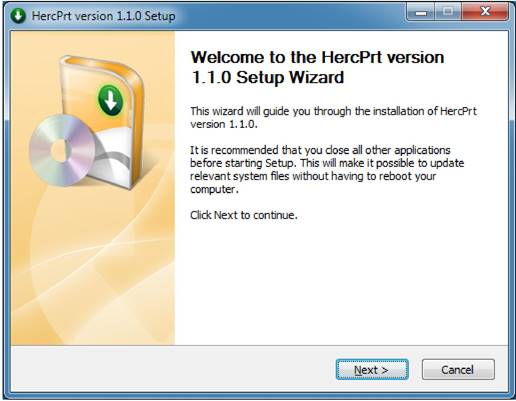 Figure 58:
HercPrt – Welcome Screen
Click on
the “Next” button to continue the installation process.
Figure 58:
HercPrt – Welcome Screen
Click on
the “Next” button to continue the installation process.

The next
screen displays the HercPrt license agreement.
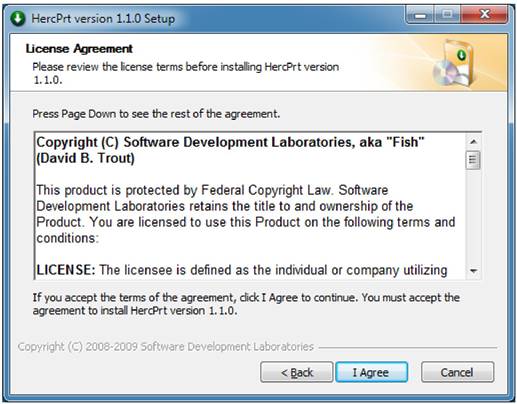 Figure 59:
HercPrt – License Agreement
Scroll through the license
agreement and read it carefully. Next, click on the “I Agree” button to
continue with the next step.
Figure 59:
HercPrt – License Agreement
Scroll through the license
agreement and read it carefully. Next, click on the “I Agree” button to
continue with the next step.

In the next
screen the “Pre-Installation ReadMe” is shown. This file contains some
instructions that is useful to know before actually installing the HercPrt
utility. Please read carefully the part about the prerequisites (e.g.
“FishLib” etc.).
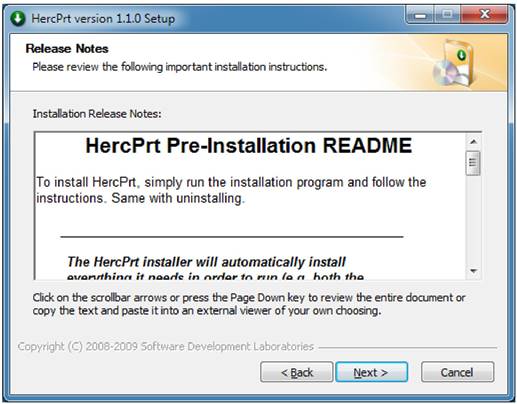 Figure 60:
HercPrt – Pre-Installation ReadMe
If you have
read the instructions, then click on the “Next” button to proceed.
Figure 60:
HercPrt – Pre-Installation ReadMe
If you have
read the instructions, then click on the “Next” button to proceed.

The installation dialog now
presents the section where normally the components to install are chosen. Because
HercPrt consists of only the main binaries you are not able to actually choose
something here. The check box to deselect the main binaries is greyed out.
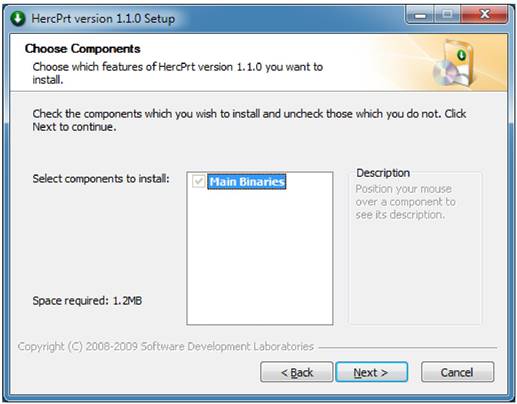 Figure 61:
HercPrt – Choose Components
Click again
on the “Next” button to continue with the installation dialog.
Figure 61:
HercPrt – Choose Components
Click again
on the “Next” button to continue with the installation dialog.

|
|
|
|
On the next screen you can specify the destination folder for the
program files. You can work with the recommended installation path or you can
choose a destination on your own. Clicking on “Browse” you are presented with a
standard Windows dialog, for selecting another destination folder.
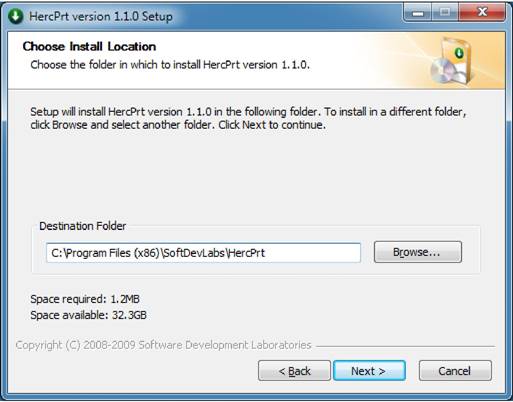 Figure 62:
HercPrt – Choose Install Location
When you
are satisfied with your choice of the destination folder then click on the
“Next” button to continue with the next step.
Figure 62:
HercPrt – Choose Install Location
When you
are satisfied with your choice of the destination folder then click on the
“Next” button to continue with the next step.

On this screen you can select the start menu
folder in which you would like to create the program’s shortcuts. As per
default the shortcuts will be created under “SoftDevLabs\HercPrt”.
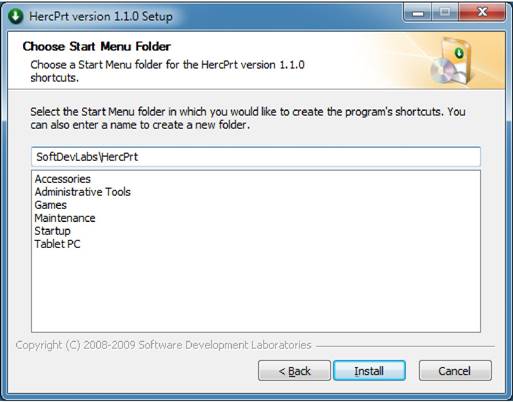 Figure 63: HercPrt – Choose Start Menu Folder
Clicking on
the “Install” button the actual installation begins.
Figure 63: HercPrt – Choose Start Menu Folder
Clicking on
the “Install” button the actual installation begins.

A scrolling window shows the detailed log about the running
installation and a green bar shows the progress of the installation process.
After the installation is completed this windows remains on the screen, so you
can scroll through and read the installation log.
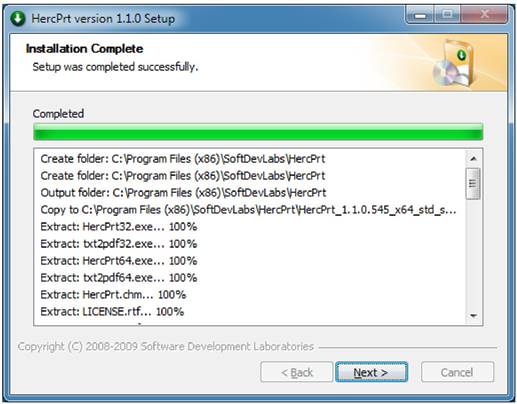 Figure 64:
HercPrt – Installation Progress Bar
Click on
the “Next” button to proceed with the last step of the installation.
Figure 64:
HercPrt – Installation Progress Bar
Click on
the “Next” button to proceed with the last step of the installation.

This is the
final window of the installation. You have the possibility to have shown a
“ReadMe” file containing the latest information about HercPrt when exiting the
installation dialog. If you are not interested in having this information
presented then deselect the “Show Readme” check box.
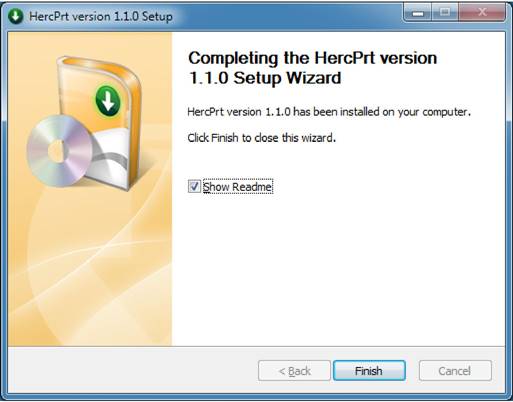 Figure 65:
HercPrt – Completing the Setup Wizard
After
clicking on the “Finish” button the installation dialog is terminated. The
HercPrt utility is now installed successfully on your computer. To start the
utility look in the Windows start menu under the menu point you just selected
some steps before. If you installed the 32-bit version of HercPrt you will find
only an entry to “HercPrt32”, if you however installed the 64-bit version you
will see an entry to “HercPrt64” as well as an entry to “HercPrt32”.
Figure 65:
HercPrt – Completing the Setup Wizard
After
clicking on the “Finish” button the installation dialog is terminated. The
HercPrt utility is now installed successfully on your computer. To start the
utility look in the Windows start menu under the menu point you just selected
some steps before. If you installed the 32-bit version of HercPrt you will find
only an entry to “HercPrt32”, if you however installed the 64-bit version you
will see an entry to “HercPrt64” as well as an entry to “HercPrt32”.
 12.3
Starting HercPrt
The HercPrt
utility is started through clicking on the “HercPrt32” or “HercPrt64” entry in
the Windows start menu folder you have chosen through the installation process.
12.3
Starting HercPrt
The HercPrt
utility is started through clicking on the “HercPrt32” or “HercPrt64” entry in
the Windows start menu folder you have chosen through the installation process.
 12.4
Customization Steps
This
section covers only the most important customization steps. A more detailed
information that covers all aspects of the HercPrt utility can be found in the
Hercules “Utilities Guide”.
12.4
Customization Steps
This
section covers only the most important customization steps. A more detailed
information that covers all aspects of the HercPrt utility can be found in the
Hercules “Utilities Guide”.

12.4.1
Hercules Definitions
On the Hercules side some changes in the configuration file are
needed to be able to use HercPrt. In the device definition section you will
find probably some entries for currently defined printers, similar to these
statements:
devaddr devtype
filename options
Example:
|
000E
|
1403
|
<wrap>D:/MVS/Printer/PRT00E.TXT</wrap>
|
CRLF NOCLEAR
| |
000F
|
1403
|
<wrap>D:/MVS/Printer/PRT00F.TXT</wrap>
|
CRLF NOCLEAR
|
These statements have to be changed to:
devaddr devtype
ipaddress:port sockdev
Example:
|
000E
|
1403
|
192.168.0.101:14031
|
sockdev
| |
000F
|
1403
|
192.168.0.101:14032
|
sockdev
|
The value ‘ipaddress:port’ is the
TCP/IP address and the port number at which the Hercules socket printer will
listen for incoming connections. The IP address is typically the IP address of
the Windows system where HercPrt is running on and the port number can be any
value from 1024 to 65535.
Note that Hercules socket printers do not support any other
options besides “SOCKDEV”, the “clrf” and “noclear” options for example are
invalid when defining a socket printer. For details on how to define printers
in a Hercules configuration file please see the Hercules “User Reference”
manual.
12.4.2 HercPrt Program Options
In order to use HercPrt at least the following definitions have to
be made in the “Program Options Panel” (see figure below). All other fields can
be left unchanged before the first usage of the utility.
Detailed information about configuring HercPrt, including both the
“Program Options Panel” and the “PDF Options Panel” can be found in the
Hercules “Utilities Guide”.
Printer ID This field
is used to enter a descriptive name for the Hercules printer you are defining.
The value can be anything that uniquely identifies the printer being defined.
If you already have some printers defined you can select one of these
previously defined printers from the dropdown list to automatically populate
the remaining controls with the values for the chosen printer.
IP Address This must
be the IP address where your Hercules printer is listening for incoming
connections.
Port Number This must
be the port number where your Hercules printer is listening for incoming
connections.
Control File This is the filename of the “Job Separator Control File” for the
printer. The job separator control file defines what your Hercules guest
operating system’s job separator pages look like and allows HercPrt to detect
where one print job ends and the next

print job begins.
This allows HercPrt to break spooled output
into separate Windows files, one for each printout, and to name the files using
information from the job accounting fields
extracted from the print fields on the actual job separator page
itself.
Click on the arrow to display a standard Windows file open dialog
where you can select the job separator control file you want to use for this
printer.
Spooler Dir Enter here the name of the
directory where you want the print files to be placed.
Click on
the arrow to display a standard Windows file open dialog where you can select
the directory for the print files of this printer.



 13. Installation of CTCI-WIN
13. Installation of CTCI-WIN
 13.1
Downloading the Binaries
The CTCI-WIN components can be downloaded from<wrap></wrap><wrap>http:%%//%%www.softdevlabs.com</wrap><wrap>.</wrap> Two packages are required, CTCI-WIN and FishLib.
CTCI-WIN consists of FishPack.dll, TunTap32.dll and TT32Test.exe
packaged together as one product. The FishLib package is required with all
recent versions of Fish's software. It contains common routines used throughout
the packages.
Note: Beginning with release 3.2.1.160 of CTCI-WIN additional DLLs
are required. These are Microsoft MFC and VC Runtime DLLs that you can download
from the address mentioned above. The installation takes a few seconds and does
not require a reboot. There are a 32-bit and a 64-bit version of these DLLs.
Please ensure you are using the correct one according to the product you are
installing (32-bit or 64-bit version of the Windows GUI).
If you
previously installed the Hercules Windows GUI as described earlier in this
manual then these DLLs are already present on your system. Note that you only
need to install these C Runtime DLLs once even if new versions of CTCI-WIN are
subsequently installed.
13.1
Downloading the Binaries
The CTCI-WIN components can be downloaded from<wrap></wrap><wrap>http:%%//%%www.softdevlabs.com</wrap><wrap>.</wrap> Two packages are required, CTCI-WIN and FishLib.
CTCI-WIN consists of FishPack.dll, TunTap32.dll and TT32Test.exe
packaged together as one product. The FishLib package is required with all
recent versions of Fish's software. It contains common routines used throughout
the packages.
Note: Beginning with release 3.2.1.160 of CTCI-WIN additional DLLs
are required. These are Microsoft MFC and VC Runtime DLLs that you can download
from the address mentioned above. The installation takes a few seconds and does
not require a reboot. There are a 32-bit and a 64-bit version of these DLLs.
Please ensure you are using the correct one according to the product you are
installing (32-bit or 64-bit version of the Windows GUI).
If you
previously installed the Hercules Windows GUI as described earlier in this
manual then these DLLs are already present on your system. Note that you only
need to install these C Runtime DLLs once even if new versions of CTCI-WIN are
subsequently installed.
 13.2
Installation Steps
The installation of the CTCI-WIN packages is straightforward. Unzip the
executables and DLLs from the downloaded ZIP files into the same directory as
the Hercules executables and the installation is complete.
13.2
Installation Steps
The installation of the CTCI-WIN packages is straightforward. Unzip the
executables and DLLs from the downloaded ZIP files into the same directory as
the Hercules executables and the installation is complete.
 13.3
Customization Steps
The customization of the CTCI-WIN consists of three major steps
described further below:
·Configuring Windows Networking
·Configuring Hercules
·Configuring the Guest Operating Systems TCP/IP Settings
For details on how CTCI-WIN works internally see the Hercules
“General Information” manual.
13.3.1 Configuring Windows Networking
Only minor configuration of Windows networking is required in
order to use CTCI-WIN, beginning with WinPcap (see chapter 8). Next verify that
the network adapter has an IP address assigned and default gateway assigned. In
most installations this will already be the case and no further configuration
will be required.
If you are
using DHCP rather than assigning a static IP address to the network card, then
it will be necessary to tell Hercules the exact hardware (MAC) address of the
network adapter Hercules is to use. See section “Configuring
Hercules” below for further information.
13.3
Customization Steps
The customization of the CTCI-WIN consists of three major steps
described further below:
·Configuring Windows Networking
·Configuring Hercules
·Configuring the Guest Operating Systems TCP/IP Settings
For details on how CTCI-WIN works internally see the Hercules
“General Information” manual.
13.3.1 Configuring Windows Networking
Only minor configuration of Windows networking is required in
order to use CTCI-WIN, beginning with WinPcap (see chapter 8). Next verify that
the network adapter has an IP address assigned and default gateway assigned. In
most installations this will already be the case and no further configuration
will be required.
If you are
using DHCP rather than assigning a static IP address to the network card, then
it will be necessary to tell Hercules the exact hardware (MAC) address of the
network adapter Hercules is to use. See section “Configuring
Hercules” below for further information.

To verify
the IP address of your network interface open the network card properties and
double-click on the “Internet Protocol (TCP/IP)” component. The
following properties dialog will appear:
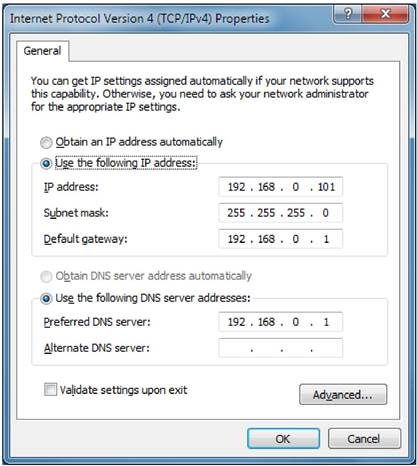 Figure 67:
Windows TCP/IP Properties
Make sure you have entered a valid IP address, subnet mask and
default gateway. This is all that is necessary on the Windows system side, the
remaining configuration of the CTCI-WIN functionality is controlled via
Hercules device statements.
13.3.1.1 IP Forwarding
You may or may not need to have “IP Forwarding” enabled
on your Windows system. Whether this is required or not depends on your use of
a router within your network. If you are using a router to define routes to
hosts on your LAN, then you should not need “IP Forwarding” enabled
on your Windows system. If however you are not using a physical hardware
router then you will likely need to enable IP Forwarding.
To allow
your Hercules guest operating system to communicate with hosts on the LAN apart
from the host machine itself (where Hercules is running), TCP/IP requires
routes to and from the Hercules hosted operating system. This is necessary so
that the Hercules virtual guest OS's packets can be properly routed to their
final destination. This is typically the role performed by a hardware router.
If you do not use a hardware router then Windows “IP Forwarding”,
together with appropriate ROUTE statements, will perform this role.
Figure 67:
Windows TCP/IP Properties
Make sure you have entered a valid IP address, subnet mask and
default gateway. This is all that is necessary on the Windows system side, the
remaining configuration of the CTCI-WIN functionality is controlled via
Hercules device statements.
13.3.1.1 IP Forwarding
You may or may not need to have “IP Forwarding” enabled
on your Windows system. Whether this is required or not depends on your use of
a router within your network. If you are using a router to define routes to
hosts on your LAN, then you should not need “IP Forwarding” enabled
on your Windows system. If however you are not using a physical hardware
router then you will likely need to enable IP Forwarding.
To allow
your Hercules guest operating system to communicate with hosts on the LAN apart
from the host machine itself (where Hercules is running), TCP/IP requires
routes to and from the Hercules hosted operating system. This is necessary so
that the Hercules virtual guest OS's packets can be properly routed to their
final destination. This is typically the role performed by a hardware router.
If you do not use a hardware router then Windows “IP Forwarding”,
together with appropriate ROUTE statements, will perform this role.

Without a router or “IP Forwarding” enabled you will
only be able to communicate with your Hercules guest OS from the same Windows
computer that Hercules is running on and the hosted OS will only be able to
communicate with the Windows system it is running on.
To enable
“IP Forwarding” on Windows, make the following registry change:
[HKEY_LOCAL_MACHINE\SYSTEM\CurrentControlSet\Services\Tcpip\Parameters]
“IPEnableRouter”=“1”
Figure 68:
Windows “IP Forwarding” Registry Key
If the “IPEnableRouter” (or “EnableRouting”)
registry value does not yet exist under the mentioned registry key then you
will have to add it manually. Select 'New' from the 'Edit' menu and add a new
DWORD value with the indicated name.
13.3.2 Configuring Hercules
Two IP addresses must ultimately be assigned, one for the Hercules
end of the link and another for the driving system's (host systems) end of the
link.
Note that
the format of the Hercules configuration file statements for networking
emulation has changed from previous releases of Hercules. The older 'CTCI-WIN'
format has been deprecated. Please ensure your CTC device statements are
updated to use the newer 'CTCI' or 'LCS' format in order to remain compatible
with current and future releases of Hercules. For example:
|
0E20
|
3088
|
CTCI
|
192.168.0.4
|
192.168.0.2
| |
0E21
|
3088
|
CTCI
|
192.168.0.4
|
192.168.0.2
|
Figure 69:
Sample CTCI definition for static IP addresses
The first IP address (192.168.0.4) is the IP address of your
Hercules system, i.e. the guest operating system running under Hercules. The
second IP address (192.168.0.2) identifies the CTCI-WIN logic, i.e. the network
adapter that CTCI-WIN is to use in order to reach the Windows TCP/IP stack.
It is recommended that the IP address you choose for your virtual
guest (like 192.168.0.4 in the above example) is in the same subnet as your
Windows host in order for CTCI-WIN to work properly. The simplest way to approach
things is to configure your guest as if it were a real system connected to your
network. Thus it would normally be assigned an IP address within the same
subnet as all the other workstations on your LAN.
Note that it is possible to place the guest OS in a separate
subnet to your Windows host if you are prepared to define the proper routing
entries. However it is usually a lot simpler and less problematic to define
all hosts in the one IP subnet.
If your
network adapter does not have a static IP address then instead of specifying an
IP address as the second parameter in the Hercules device statement, you must
specify the MAC address of the adapter you wish to use:

|
|
|
|











 The DEFAULTNET
statement instructs what path the IP stack should take to look for address it
doesn't know about. IP assumes the next hop will be able to resolve the IP address
the stack is trying to connect to.
DEFAULTNET 192.168.0.2 = CTC1L 1492 0
The
final statement needed in the profile is the command to instruct TCPIP to start
the device.
START CTC1
Figure 71:
Sample TCP/IP Configuration for CTCI-WIN
If you wish
to try using an LCS (LAN Channel Station) device instead then the following
sample may be useful. LCS can handle any Ethernet packet rather than just IP
packets:
|
The DEFAULTNET
statement instructs what path the IP stack should take to look for address it
doesn't know about. IP assumes the next hop will be able to resolve the IP address
the stack is trying to connect to.
DEFAULTNET 192.168.0.2 = CTC1L 1492 0
The
final statement needed in the profile is the command to instruct TCPIP to start
the device.
START CTC1
Figure 71:
Sample TCP/IP Configuration for CTCI-WIN
If you wish
to try using an LCS (LAN Channel Station) device instead then the following
sample may be useful. LCS can handle any Ethernet packet rather than just IP
packets:
|
|
|
|
Sample regular / normal LCS device definitions
0E20-0E21 LCS -n 172.16.9.163 -m 00-00-5e-90-09-5d
172.16.9.93
 Sample LCS
device definitions for Enterprise Extender
0E20-0E23 LCS -n 172.16.9.163 -o oatfile.txt
Sample LCS
device definitions for Enterprise Extender
0E20-0E23 LCS -n 172.16.9.163 -o oatfile.txt
 oatfile.txt:
*********************************************************
* Dev Mode Port Entry specific information *
*********************************************************
oatfile.txt:
*********************************************************
* Dev Mode Port Entry specific information *
*********************************************************

|
0E20 IP
|
00
|
PRI
|
172.16.9.93
| |
HWADD
|
00
|
|
00-00-5E-90-09-5D
| |
0E22 IP
|
01
|
SEC
|
172.16.10.93
| |
HWADD
|
01
|
|
00-00-5E-90-0A-5D
|
Sample
TCPIP PROFILE statements for Enterprise Extender
(Note: not all statements are shown)
IPCONFIG DATAGRAMFWD VARSUBNETTING SYSPLEXROUTING
DEVICE
LCS1 LCS E20 AUTORESTART
LINK ETH1 ETHERNET 0 LCS1




 DEVICE VDEV1 VIRTUAL 0
LINK VLINKA VIRTUAL 0 VDEV1
DEVICE
IUTSAMEH MPCPTP
LINK EELINK
MPCPTP IUTSAMEH
START LCS1
START IUTSAMEH
HOME
172.16.9.93 ETH1
DEVICE VDEV1 VIRTUAL 0
LINK VLINKA VIRTUAL 0 VDEV1
DEVICE
IUTSAMEH MPCPTP
LINK EELINK
MPCPTP IUTSAMEH
START LCS1
START IUTSAMEH
HOME
172.16.9.93 ETH1
172.16.10.93 VLINKA
BEGINROUTES
ROUTE
172.16.0.0 255.255.0.0 = ETH1 MTU 1492
ROUTE
DEFAULT 172.16.13.1 ETH1 MTU 1492
ENDROUTES
PORT
12000
UDP VTAM
12001 UDP VTAM
12002 UDP VTAM
12003 UDP VTAM
12004 UDP VTAM
 (Not shown: VTAM definitions)
Figure 72:
Sample LCS Configuration for CTCI-WIN
13.3.3.1 Defining the Guest's Default Gateway
The correct definition of your guest operating systems default
gateway depends on whether or not you are using a real router. If you do not
have a real router and are instead using the Windows “IP Forwarding”
(IP Routing) feature to perform routing, then your default gateway should be
the physical adapter on your Windows system that your virtual interface is
using.
Alternatively if you do have a real router then your default
gateway should be the IP address of your actual router. In the sample LCS
configuration immediately above 172.16.13.1 is a real network router and thus
knows how to route traffic to the other end of the guest's Enterprise Extender
link. Note that, as recommended, the guest's IP addresses (172.16.9.93 and
172.16.10.93) are within the same subnet (255.255.0.0) as the Windows host that
Hercules is running under (172.16.9.163).
13.3.4 Tweaking CTCI-WIN
The CTCI-WIN protocol supports some additional tuning parameters in
addition to the required parameters. You can adjust the size of the WinPcap
kernel device driver's internal packet buffer, as well as the size of
TunTap32.dll's own packet I/O buffer to try and increase the performance of
your network:
(Not shown: VTAM definitions)
Figure 72:
Sample LCS Configuration for CTCI-WIN
13.3.3.1 Defining the Guest's Default Gateway
The correct definition of your guest operating systems default
gateway depends on whether or not you are using a real router. If you do not
have a real router and are instead using the Windows “IP Forwarding”
(IP Routing) feature to perform routing, then your default gateway should be
the physical adapter on your Windows system that your virtual interface is
using.
Alternatively if you do have a real router then your default
gateway should be the IP address of your actual router. In the sample LCS
configuration immediately above 172.16.13.1 is a real network router and thus
knows how to route traffic to the other end of the guest's Enterprise Extender
link. Note that, as recommended, the guest's IP addresses (172.16.9.93 and
172.16.10.93) are within the same subnet (255.255.0.0) as the Windows host that
Hercules is running under (172.16.9.163).
13.3.4 Tweaking CTCI-WIN
The CTCI-WIN protocol supports some additional tuning parameters in
addition to the required parameters. You can adjust the size of the WinPcap
kernel device driver's internal packet buffer, as well as the size of
TunTap32.dll's own packet I/O buffer to try and increase the performance of
your network:

|
0E20
|
3088
|
CTCI
|
-n
|
00-80-B3-E1-DF-69
|
-k
|
1024
|
-i
|
64
|
192.168.1.99
|
0.0.0.0
| |
0E21
|
3088
|
CTCI
|
-n
|
00-80-B3-E1-DF-69
|
-k
|
1024
|
-i
|
64
|
192.168.1.99
|
0.0.0.0
| Figure 73: CTCI-WIN Tuning Parameters The numbers 1024 and 64 in the above statements are the size of the WinPcap kernel device driver's internal packet buffer (in KB), and the size of TunTap32 DLL's internal packet I/O buffer (in KB) respect-tively. Please note that memory for WinPcap's kernel device driver's packet buffer is taken from Windows “non-paged” memory pool (i.e. from your system's real physical memory). The size of this buffer has a direct impact on Windows performance. If you choose a ridiculously large number here Windows will have little memory left to work with and the overall performance of your Windows system will be degraded. The second number (64 in the above example) is the size in KB of the I/O buffer allocated inside the TunTap32 DLL. This defines how much data TunTap32 will request from the device driver each time it needs to do an I/O operation to the physical adapter and therefore how much data will be transferred from the device driver's internal buffer to TunTap32's I/O buffer. The memory for this buffer is allocated in virtual memory from the Hercules process's address space and should not impact Windows's performance unless a ridiculously large number is specified. If too high a number is specified then Windows will likely ‘thrash’ attempting to page the entire Hercules address space and performance will be degraded. The TunTap32 DLL passes packets to Hercules one at a time. When it runs out of packets in its internal I/O buffer it requests more data from the WinPcap device driver via the FishPack DLL. The TunTap32 I/O buffer size determines how much data and therefore how many packets it will receive from WinPcap for each request. The larger this buffer, the fewer actual I/O's TunTap32 will perform to WinPcap via FishPack, but at the same time the longer the interval between those I/O's. This implies that the WinPcap device driver will have to buffer its data for a longer period between less frequent I/O's. This requires a larger kernel buffer in order to ensure that no packets are lost during periods of high network activity. Conversely, the larger the actual I/O (i.e. the more bytes transferred per I/O), the longer each I/O takes. Although this is measured in microseconds, the delay holds up the entire Windows operating system during transfers of data from kernel-space to a user-space. It is good to perform as little I/O as possible as these can be expensive, but the benefit drops quickly if each I/O has significant impact on the overall system, so choose these settings carefully. Unless you are using a Gigabit or faster network it is usually best to leave these at their default settings. The currently implemented minimum, maximum and default values are: |
Buffer Type
|
Minimum
|
Default
|
Maximum
| |
WinPcap device driver capture buffer size
|
64 KB
|
1 MB
|
16 MB
| |
TunTap32 DLL I/O buffer size
|
16 KB
|
64 KB
|
1 MB
|
Table 23:
CTCI-WIN Buffer Sizes
If you decide to adjust these buffer size values to try and
increase network throughput and performance, you may find the Hercules
“tt32stats” command useful.
The
tt32stats command shows the actual tt32 statistics as shown below:

|
23:59:11.098
23:59:11.098
|
0000066C 0000066C
|
tt32 stats e20
TunTap32.dll Statistics:
||
| |
23:59:11.118
|
0000066C
|
Size
|
of Kernel Hold Buffer:
|
1024K
| |
23:59:11.118
|
0000066C
|
Size
|
of DLL I/O Buffer:
|
64K
| |
23:59:11.128
|
0000066C Maximum DLL I/O Bytes Received:
|||
2K
| |
23:59:11.138
|
0000066C
|
|
7 Write Calls
|
| |
23:59:11.148
|
0000066C
|
|
8 Write I/Os
|
| |
23:59:11.148
|
0000066C
|
|
319 Read Calls
|
| |
23:59:11.158
|
0000066C
|
|
259 Read I/Os
|
| |
23:59:11.168
|
0000066C
|
|
282 Packets Read
|
| |
23:59:11.168
|
0000066C
|
|
8 Packets Written
|
| |
23:59:11.178
|
0000066C
|
|
38172 Bytes Read
|
| |
23:59:11.178
|
0000066C
|
|
542 Bytes Written
|
| |
23:59:11.188
|
0000066C
|
|
1 Internal Packets
|
| |
23:59:11.198
|
0000066C
|
|
2 Ignored Packets
|
|
Figure 74:
tt32 Statistics
If the reported “Maximum DLL I/O Bytes Received” value
is identical to the value specified for the “Size of DLL I/O Buffer”,
then each time TunTap32 requested more packets the WinPcap device driver had at
least a full buffer worth waiting to be delivered to TunTap32.
This
generally indicates that the default buffer size is too small or that your
network is extremely busy. This would be the least common situation though.
TunTap32 is rarely unable to deliver an entire buffer of packets to Hercules
before another buffer arrives unless Hercules is performing extremely poorly or
your network really is under heavy load.

 14. Installation of Vista tn3270
14. Installation of Vista tn3270
 Figure 75:
Vista tn3270 Logo
Figure 75:
Vista tn3270 Logo
 14.1 Vista
tn3270
Vista
tn3270 is a Windows program designed to emulate IBM 3270 terminals connected to
a host via an IP. It is written by Tom Brennan, is currently available as a
free 30 day trial and a perpetual license costs approximately $30 US dollars.
This emulator was created with mainframe programmers in mind and has some
unique features unavailable on even the most expensive commercial emulators.
Vista has features designed especially for programmers such as
built-in multiple cut and paste buffers, fully customizable keyboard, extensive
select/copy/paste functions – especially the “SelectJCL” function that is used
to select dataset names, parameters, and similar items with a single mouse
click.
Vista uses bitmapped raster fonts for the clearest text possible.
There are 2 sets, “Thick” and “Thin”, in 73 sizes each from
4×6 to 16×36. With so many sizes you can easily setup Vista to suit your
monitor size and terminal model preferences in either full-screen or windowed
mode.
Parts of
the following sections about the Vista tn3270 installation have been taken from
the original Vista tn3270 documentation with the kind permission of Tom
Brennan.
14.1 Vista
tn3270
Vista
tn3270 is a Windows program designed to emulate IBM 3270 terminals connected to
a host via an IP. It is written by Tom Brennan, is currently available as a
free 30 day trial and a perpetual license costs approximately $30 US dollars.
This emulator was created with mainframe programmers in mind and has some
unique features unavailable on even the most expensive commercial emulators.
Vista has features designed especially for programmers such as
built-in multiple cut and paste buffers, fully customizable keyboard, extensive
select/copy/paste functions – especially the “SelectJCL” function that is used
to select dataset names, parameters, and similar items with a single mouse
click.
Vista uses bitmapped raster fonts for the clearest text possible.
There are 2 sets, “Thick” and “Thin”, in 73 sizes each from
4×6 to 16×36. With so many sizes you can easily setup Vista to suit your
monitor size and terminal model preferences in either full-screen or windowed
mode.
Parts of
the following sections about the Vista tn3270 installation have been taken from
the original Vista tn3270 documentation with the kind permission of Tom
Brennan.
 14.2
Downloading the Installation Routine
The binaries for the Vista tn3270 Terminal Emulation can be
downloaded directly from Tom Brennan's Vista tn3270 webpage using the following
link:
<wrap>www.tombrennansoftware.com</wrap>
The downloaded version of Vista tn3270 can be used for a free trial for
30 days following installation. After this free trial period a license key must
be entered for continued use of the software.
14.2
Downloading the Installation Routine
The binaries for the Vista tn3270 Terminal Emulation can be
downloaded directly from Tom Brennan's Vista tn3270 webpage using the following
link:
<wrap>www.tombrennansoftware.com</wrap>
The downloaded version of Vista tn3270 can be used for a free trial for
30 days following installation. After this free trial period a license key must
be entered for continued use of the software.
 14.3
Install Vista tn3270
To start
the installation process, just double-click on the downloaded executable file.
14.3
Install Vista tn3270
To start
the installation process, just double-click on the downloaded executable file.

The
installation welcome screen is presented:
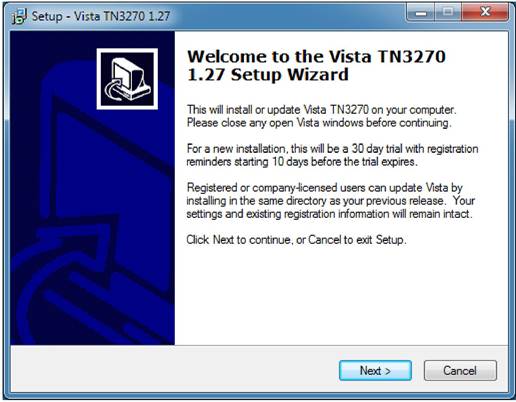 Figure 76:
Vista tn3270 – Welcome Screen
Click on
“Next >” to continue the installation process.
Figure 76:
Vista tn3270 – Welcome Screen
Click on
“Next >” to continue the installation process.

The following screen prompts you for the
installation directory. Select a destination directory of your choice and click
“Next” to continue.
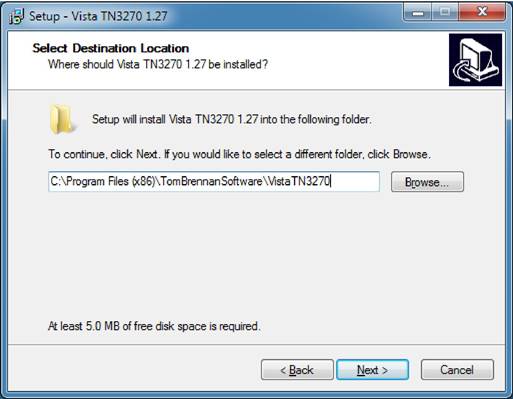 Figure 77:
Vista tn3270 – Select Destination Directory
Figure 77:
Vista tn3270 – Select Destination Directory

The screen presented next
allows you to choose the Windows Start Menu Group to which the emulator icons
should be added. The default group is usually acceptable. Click on “Next” again
to continue.
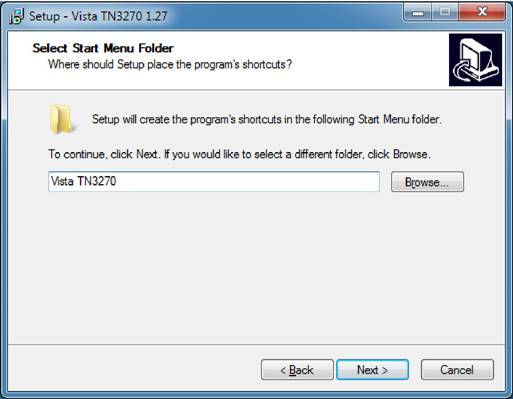 Figure 78:
Vista tn3270 – Select Program Group
Figure 78:
Vista tn3270 – Select Program Group

Now the
installation program is ready to copy the necessary files to your hard disk. A
confirmation screen appears where you can change your previous selections. If
you do not want to change any of these click on “Install” and the
setup program begins the actual installation.
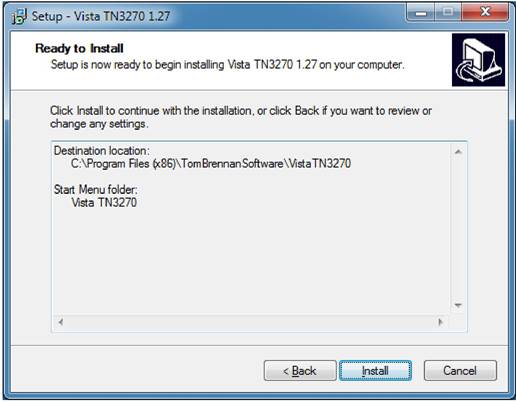 Figure 79:
Vista tn3270 – Ready to Install Screen
Figure 79:
Vista tn3270 – Ready to Install Screen

Next the setup program installs Vista tn3270 according to your previous
settings.
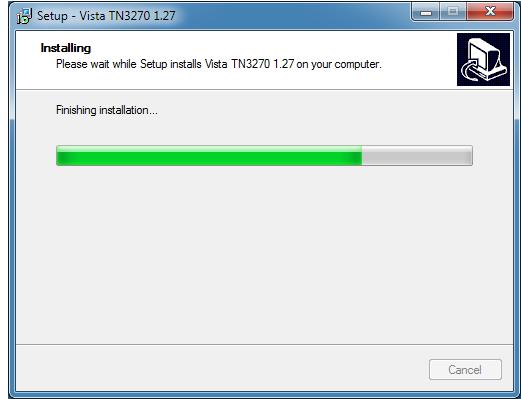 Figure 80:
Vista tn3270 - Installation Progress
Figure 80:
Vista tn3270 - Installation Progress

When the
installation process is finished the “Setup Completed” screen will appear. You
must confirm by clicking “Finish”.
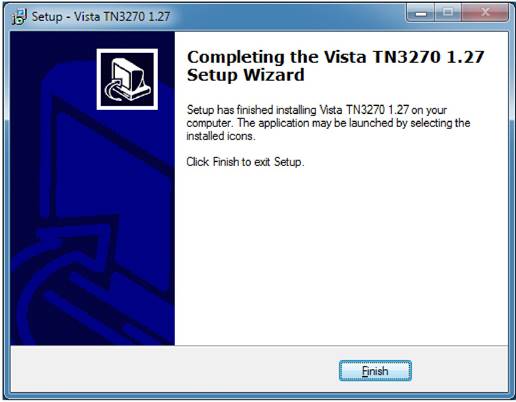 Figure 81: Vista tn3270 – Setup Completed
14.4 Activation of the Software
The Vista tn3270 software creator, Tom Brennan, allows you to try
the product for 30 days. When this period expires a licence key must to be
entered to enable the product for use again. You can purchase the product via
the online purchasing system at the product website. After purchase a license
key is sent by email, normally within 24 hours.
14.5 Creating Sessions
The detailed process of creating terminal emulation sessions and
the impact of all possible options within Vista tn3270 is beyond the scope of
this manual. For details regarding these please refer to the printed Vista
tn3270 documentation or the online help within the product. A short
introduction to creating Vista sessions for connection to a Hercules hosted OS
follows.
Start a Vista
tn3270 window by clicking on “Vista” in the Vista program folder or
wherever you chose to install the product. This creates a new Vista instance
and immediately opens the “Start a new Terminal Session” dialog,
where you can specify IP address and port number. If instead you click on
“Vista Standard Session”, then Vista immediately attempts to connect to the
last used IP address and port.
Figure 81: Vista tn3270 – Setup Completed
14.4 Activation of the Software
The Vista tn3270 software creator, Tom Brennan, allows you to try
the product for 30 days. When this period expires a licence key must to be
entered to enable the product for use again. You can purchase the product via
the online purchasing system at the product website. After purchase a license
key is sent by email, normally within 24 hours.
14.5 Creating Sessions
The detailed process of creating terminal emulation sessions and
the impact of all possible options within Vista tn3270 is beyond the scope of
this manual. For details regarding these please refer to the printed Vista
tn3270 documentation or the online help within the product. A short
introduction to creating Vista sessions for connection to a Hercules hosted OS
follows.
Start a Vista
tn3270 window by clicking on “Vista” in the Vista program folder or
wherever you chose to install the product. This creates a new Vista instance
and immediately opens the “Start a new Terminal Session” dialog,
where you can specify IP address and port number. If instead you click on
“Vista Standard Session”, then Vista immediately attempts to connect to the
last used IP address and port.
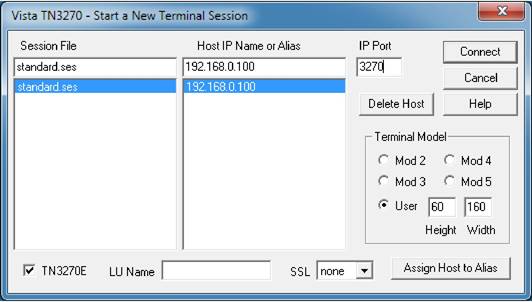 Figure 82:
Vista tn3270 - New Terminal Session Dialog
The following options can be specified in this dialog:
Session File Select an
existing session file or type a new name. A session file contains most of the
parameters for a session such as font size, screen colours and other options.
Multiple Vista windows can share the same session file but that each window
stores parameters when it is closed. This means that the parameters will be set
to those of the last window closed.
Host IP Name/Alias This name
is usually a dot address like 206.85.100.23 or a DNS (Domain Name Server) name,
such as ”<wrap>tn3270.company.com</wrap>“. It
can also be an Alias name that points to either a DNS or dot address (see
Assign Host to Alias below). IP names and their associated port numbers are
stored in the VISTA.INI file rather than the session file so that they can be
shared among sessions.
The special host name “localhost” or the IP address
“127.0.0.1” means the local machine.
IP Port Each Host
IP Name has an associated IP Port number which you can change using this field.
Normally TN3270 is defined to port 23 but in some cases your connection may
need to use a different port number. This port number has to be the same as
that specified for the CNSLPORT system parameter in the Hercules Configuration
File.
If you need to logon to the same hostname using various port
numbers create multiple Alias names which point to the same host but use
different ports. Additionally you can define aliases for IP addresses. This can
help you remember which host Vista is connecting to.
Delete Host This button can be used to
delete the selected Host IP Name if you want to clean up the list.
Figure 82:
Vista tn3270 - New Terminal Session Dialog
The following options can be specified in this dialog:
Session File Select an
existing session file or type a new name. A session file contains most of the
parameters for a session such as font size, screen colours and other options.
Multiple Vista windows can share the same session file but that each window
stores parameters when it is closed. This means that the parameters will be set
to those of the last window closed.
Host IP Name/Alias This name
is usually a dot address like 206.85.100.23 or a DNS (Domain Name Server) name,
such as ”<wrap>tn3270.company.com</wrap>“. It
can also be an Alias name that points to either a DNS or dot address (see
Assign Host to Alias below). IP names and their associated port numbers are
stored in the VISTA.INI file rather than the session file so that they can be
shared among sessions.
The special host name “localhost” or the IP address
“127.0.0.1” means the local machine.
IP Port Each Host
IP Name has an associated IP Port number which you can change using this field.
Normally TN3270 is defined to port 23 but in some cases your connection may
need to use a different port number. This port number has to be the same as
that specified for the CNSLPORT system parameter in the Hercules Configuration
File.
If you need to logon to the same hostname using various port
numbers create multiple Alias names which point to the same host but use
different ports. Additionally you can define aliases for IP addresses. This can
help you remember which host Vista is connecting to.
Delete Host This button can be used to
delete the selected Host IP Name if you want to clean up the list.

Terminal
Model Vista can emulate 5 standard terminal models:
Mod 2 (24 lines by 80 columns)
Mod 3 (32 lines by 80 columns)
Mod 4 (43 lines by 80 columns)
Mod 5 (27 lines by 132 columns)
User (variable up to 72 lines by 200 columns)
Assign Host to Alias Dot
addresses and DNS IP names can be cryptic to look at. Instead you can type a
more descriptive name such as “P390” in the Host IP Name or Alias
field then press the Assign Host to Alias button to relate the alias name to a
real DNS name or dot address. Alias names can also provide the ability to logon
to the same hostname using different port or LU names.
TN3270E TN3270E is the default
protocol for Vista connections.
LU Name When in
TN3270E mode, you have the option of specifying a VTAM 8 character LUNAME to be
used when establishing the connection. If you need to logon to the same
hostname using various LU names, create multiple Alias names which point to the
same host but have different LU’s.
Connect Button When this button is pressed, Vista
attempts to connect to the specified Host IP. If all is correct Vista connects
to Hercules and presents the Hercules welcome screen. If however there is a
problem you may see an error window such as the following one:
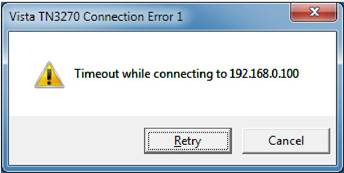 Figure 83:
Vista tn3270 - Connection Error
Figure 83:
Vista tn3270 - Connection Error

 15. Installation of XMIT Manager
15. Installation of XMIT Manager
 Figure 84:
XMIT Manager Logo
Figure 84:
XMIT Manager Logo
 15.1 XMIT
Manager Basics
The XMIT
Manager is a Windows based application that allows you to manipulate Xmit
format files generated on an IBM mainframe. With XMIT Manager you can open
Xmit files and view or extract both, binary or text data contained within them.
Xmit Manager will process both partitioned and sequential datasets using a
graphical interface.
15.1 XMIT
Manager Basics
The XMIT
Manager is a Windows based application that allows you to manipulate Xmit
format files generated on an IBM mainframe. With XMIT Manager you can open
Xmit files and view or extract both, binary or text data contained within them.
Xmit Manager will process both partitioned and sequential datasets using a
graphical interface.
 15.2
Downloading the Binaries
The binaries for the XMIT manager can be
downloaded from various locations. The most reliable and therefore recommended
source is the CBT website which can be accessed with the following link:
<wrap>http:%%//%%www.cbttape.org/njw/</wrap>
15.2
Downloading the Binaries
The binaries for the XMIT manager can be
downloaded from various locations. The most reliable and therefore recommended
source is the CBT website which can be accessed with the following link:
<wrap>http:%%//%%www.cbttape.org/njw/</wrap>
 15.3
Installation Steps
Installation
of the XMIT Manager is straight forward. First extract the ZIP-file you
downloaded from the CBT website to a directory on your harddisk. This creates
some files after which you start the installation by running the SETUP.EXE
program.
15.3
Installation Steps
Installation
of the XMIT Manager is straight forward. First extract the ZIP-file you
downloaded from the CBT website to a directory on your harddisk. This creates
some files after which you start the installation by running the SETUP.EXE
program.

The setup program first presents a screen showing the Software
License Agreement.
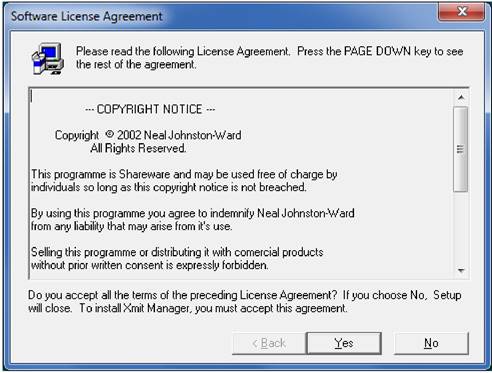 Figure 85:
XMIT Manager Setup – Software License Agreement
Read the
“Software License Agreement” and accept it by clicking on “Yes”.
Figure 85:
XMIT Manager Setup – Software License Agreement
Read the
“Software License Agreement” and accept it by clicking on “Yes”.

The destination location screen
will be shown, from here choose the directory where you want the setup program
to install the software. The default location “C:\Program Files\Xmit Manager”
is usually satisfactory. If you wish to install the software somewhere else
click on “Browse” and chose your preferred drive and directory, or type a path
directly in the panel.
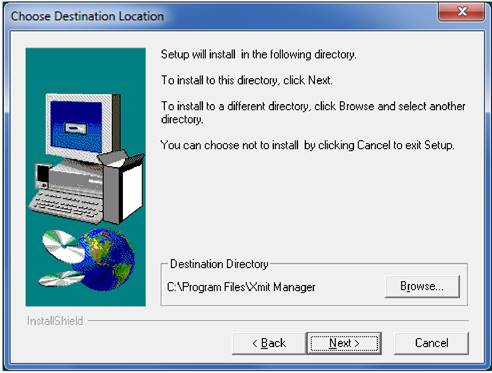 Figure 86:
XMIT Manager Setup – Destination Location
When you
are satisfied with your choice of the installation directory click on
“Next >” to continue.
Figure 86:
XMIT Manager Setup – Destination Location
When you
are satisfied with your choice of the installation directory click on
“Next >” to continue.

The setup program will ask you to select a program folder, the
default is normally acceptable.
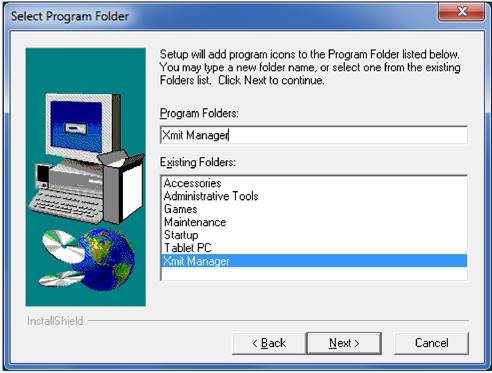 Figure 87:
XMIT Manager Setup – Select Program Folder
Click on
“Next >” again to proceed with the installation.
Figure 87:
XMIT Manager Setup – Select Program Folder
Click on
“Next >” again to proceed with the installation.

The
following screen gives you a chance to review your selections and to go back
and correct any, if necessary.
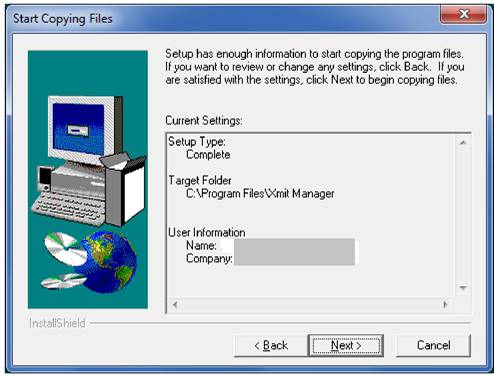 Figure 88:
XMIT Manager Setup – Review Settings
When you
are satisfied with your installation choices, continue by clicking “Next”. The
installer will start copying files to your harddisk, creating icons and
updating registry settings.
Figure 88:
XMIT Manager Setup – Review Settings
When you
are satisfied with your installation choices, continue by clicking “Next”. The
installer will start copying files to your harddisk, creating icons and
updating registry settings.

The final setup screen will then be displayed.
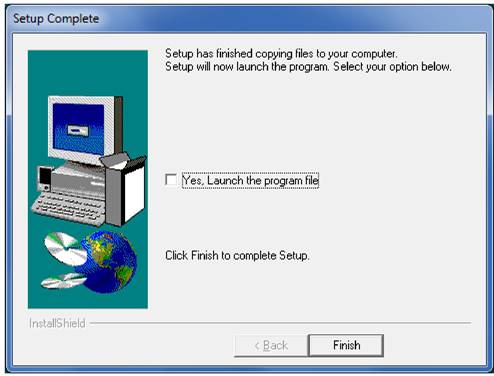 Figure 89:
XMIT Manager Setup – Setup Complete
You can now
either exit the setup program or optionally select to launch the application as
you exit setup. Click on “Finish” to complete.
Figure 89:
XMIT Manager Setup – Setup Complete
You can now
either exit the setup program or optionally select to launch the application as
you exit setup. Click on “Finish” to complete.

 16. AWS
Browse
16. AWS
Browse
 16.1 AWS
Browse Basics
The AWS Browse Utility can be used to view the contents of
emulated mainframe tapes (AWS and HET) directly from the Windows desktop
without having to start a mainframe operating system. There are currently two
implementation of AWS browse.
The first
and older one from Rob Storey is no longer supported. The second one is from
David B. Trout (Fish), which has more features and is the subject of the rest
of this chapter.
16.1 AWS
Browse Basics
The AWS Browse Utility can be used to view the contents of
emulated mainframe tapes (AWS and HET) directly from the Windows desktop
without having to start a mainframe operating system. There are currently two
implementation of AWS browse.
The first
and older one from Rob Storey is no longer supported. The second one is from
David B. Trout (Fish), which has more features and is the subject of the rest
of this chapter.
 16.2
Downloading the Binaries
The binaries for the AWS Browse utility can be downloaded from
various locations. However the recommended source is the developers to ensure
you have the latest version. The following link leads you directly to the
download page:
<wrap>http:%%//%%www.softdevlabs.com/Hercules/hercgui-index.html</wrap>
Note: Beginning with release 1.5.1.1805 of AWS Browse additional DLLs
are required. These are Microsoft MFC and VC Runtime DLLs that you can
download from the address mentioned above. The installation takes a few
seconds and does not require a reboot. There are a 32-bit and a 64-bit version
of these DLLs. Please ensure you are using the correct one according to the
product you are installing (32-bit or 64-bit version of the Windows GUI).
If you
previously installed the Hercules Windows GUI as described earlier in this
manual then these DLLs are already present on your system. Note that you only
need to install these C Runtime DLLs once even if new versions of AWS Browse
are subsequently installed.
16.2
Downloading the Binaries
The binaries for the AWS Browse utility can be downloaded from
various locations. However the recommended source is the developers to ensure
you have the latest version. The following link leads you directly to the
download page:
<wrap>http:%%//%%www.softdevlabs.com/Hercules/hercgui-index.html</wrap>
Note: Beginning with release 1.5.1.1805 of AWS Browse additional DLLs
are required. These are Microsoft MFC and VC Runtime DLLs that you can
download from the address mentioned above. The installation takes a few
seconds and does not require a reboot. There are a 32-bit and a 64-bit version
of these DLLs. Please ensure you are using the correct one according to the
product you are installing (32-bit or 64-bit version of the Windows GUI).
If you
previously installed the Hercules Windows GUI as described earlier in this
manual then these DLLs are already present on your system. Note that you only
need to install these C Runtime DLLs once even if new versions of AWS Browse
are subsequently installed.
 16.3
Installation Steps
Download
the file called “AWSBrowse-version.zip” to your harddisk. ‘Version’ is
the version number of the utility in the form “v.r.m.b”
(version.release.modification.build), e.g. AWSBrowse-1.2.0.1278.zip.
The archive
contains several files; the actual AWSBrowse EXE files (32-bit and 64-bit
versions) and some DLLs. Please check the README file for the latest
instructions.
Unzip these files and copy them to either your Hercules directory
(see Chapter 8. Hercules Emulator Installation), or a directory of your choice
from where you wish to run the utility. Be sure to you place the executable and
the DLLs in the same directory. The Installation is now complete.
Clicking on
the desired executable starts AWS Browse with the initial screen showed below.
16.3
Installation Steps
Download
the file called “AWSBrowse-version.zip” to your harddisk. ‘Version’ is
the version number of the utility in the form “v.r.m.b”
(version.release.modification.build), e.g. AWSBrowse-1.2.0.1278.zip.
The archive
contains several files; the actual AWSBrowse EXE files (32-bit and 64-bit
versions) and some DLLs. Please check the README file for the latest
instructions.
Unzip these files and copy them to either your Hercules directory
(see Chapter 8. Hercules Emulator Installation), or a directory of your choice
from where you wish to run the utility. Be sure to you place the executable and
the DLLs in the same directory. The Installation is now complete.
Clicking on
the desired executable starts AWS Browse with the initial screen showed below.

|
C. 801963.aws-AWSBmw/se64
File Edit View Help
|
|
|
la
|
| |
|
| |
alEalEmaloloa 'R
|
11 1
|
4N lUI2IIIIMII51 ?I
|
|
| |
File Block Bytes A
|
00000000
|
00151755 5820B0C8 5830B0CC 8D200008
|
“P”, ”,“11 ^ ') ,
| | |
O
|
00000010
|
18128810 00185410 CDEA1845 14414344
|
h
| | |
File:1 Block:1 800bytes
|
00000O20
|
CE1C1AA4 16518D20 00088E20 00004770
|
lu 1 1 1
| | |
File:1 Block:2 800bytes
|
00000030
|
C31A18E5 4050D084 18F51AFF 57FOCDEE
|
C?.V &}d.5??.0..
| | |
File:1 Modc3 800 bytes
|
00000040
|
145F88F0 0002145F 4355CE1C 1A851388
|
..h0 ',e h
| | |
File:1 Block:4 800 bytes
|
00000050
|
001613AA 17555820 B0285830 B02C8C20
|
…. ? .. ?”?..“?.?
| | |
Filel Block5 800bytes
|
00000O60
|
00081813 5410CDEA 18451441 4344CE1C ..
|
| | |
Filel Block 6 800bytes
|
00000070
|
1AA41651 8C200008 8E200000 4770C36A
|
?u '' ')…… ”' C
| | |
|
00000O80
|
4050D086 18F51AFF 57FOCDEE 145F88F0
|
&)£.5??.0….h0
| | |
Filel Block 7 800bytes
|
00000O90
|
0002145F 4355CE1C 1A8518FA 50FOCDOA
|
“,e &O.?
| | |
Niel Blocb8 800bytes
|
000000A0
|
00175CE0 CDOE1AOF 18F850F0 CCFE5CE0
|
.?*\ 18&0.. *\
| | |
Filel Blocic9 800bytes
|
000000B0
|
CD021A0F 17AA5820 B0085830 B0CC1842
|
.”,o “,“11..”
| | |
Filel Block l0 800bytes
|
00000000
|
18535420 CDF25430 CDF28D20 00011424
|
2 2…..
|
| |
Filel Blockll 800bytes
|
000000D0
|
14351812 16131841 89400010 16141841 ..
|
i ……
|
=
| |
|
000000E0
|
89400008 16148810 00184311 CE1C1AA1
|
i h
|
| |
Filel Block 12 800bytes
|
000000F0
|
001813AA 5820B028 5830B02C 18421853
|
-,….) ….)
|
| |
Filel Block13 800bytes
|
00000100
|
5420CDF2 5430CDF2 8D200001 14241435
|
.?.2…2 . ? … ? . ?
| | |
Filel Block 14 800bytes
|
00000110
|
18121613 18418940 00101614 18418940 ..
|
i ….. i
| | |
Filel Modc15 800bytes
|
00000120
|
00081614 88100018 43110E1C 1AA118FA
|
.?..h ……. ?-
| | |
File]. Block l6 800bytes
|
00000130
|
50F0CD16 SCEOCD1A 1A0F4110 CE1C58F0
|
&0.. *\ ”P,0
| | |
|
00000140
|
0019CDF6 05EF18FA 50F0CD2E SCE0CD32
|
…6….&0..*\..
| | |
Filel Block 17 800bytes
|
00000150
|
1AOF18F9 50FOCD5E SCE0CD62 1AOF18F8
|
?..9&0.;*\ “' 8
| | |
File]. Block18 800 bytes
|
00000160
|
50F0CD52 5CE0CD56 1AOF18F7 50F0CD22
|
&0.. *\ ”' 7&0.?
| | |
Filel Modc19 800bytes
|
00000170
|
SCE0CD26 1A0F1788 17995860 D0505870
|
ook .. ? . ?h?r.—)&..
| | |
File]. Blocic 20 800 bytes
|
00000180
|
D0545820 B0085830 B0CC1462 14731842
|
)..?“11 ^
| | |
Filel Blocic21 800bytes
|
00000190
|
001A1853 5440CDFA 5450CDFA 8C400009
|
. ? … …&… ..
| | |
Filel Blocic22 800bytes
|
000001A0
|
5420CDF2 5430CDF2 8C200007 17241735
|
.?.2…2 . ? .. ????
| | |
|
000001B0
|
58E08028 58F0B02C 184E185F 5440CDFA
|
.\^?.0^?.+… ..
| | |
Filel Blocic23 800bytes
|
000001C0
|
5450CDFA 8D400007 54E0CDF2 54F0CDF2
|
.&… …\.2.0.2
| | |
Filel Bbdc24 800bytes
|
000001D0
|
8DE00009 144E145F 14241435 58E0B100
|
.\…+ … ? . ? . \..
| | |
Filel Blocic25 800bytes
|
000001E0
|
001B58F0 B10457E0 CDFE57F0 CDFE5060
|
…0.2.\…0. &-
| | |
Niel Blocic26 800bytes
|
000001F0
|
D0585070 D05C186E 187F14E4 14F58DE0
|
).&.)*.>.”.13.5.\
| | |
Filel Block 27 800bytes
|
00000200
|
0008181E 18AE18BF 14A614B7 8DA00008
|
“' w .,
| | |
|
00000210
|
14A614B7 16EA16FB 8DA00008 14A614B7
|
.w ' w
| | |
Filel Blocic23 800bytes
|
00000220
|
16EA16FB 18B154E0 D05854F0 D05C181E ……..
|
\}..0}*..
| | |
Filel BlocicN 800bytes
|
00000230
|
001C161F 18A189A0 0010161A 18A189A0 ..
|
—i…..
| | |
Filel Blocic30 800bytes
|
00000240
|
0008161A 88100018 43110E1C 1A815740
|
.?.?h ……. ?a.
| | |
Filel Block31 800bytes ,
|
00000250
|
B0605750 B06458E0 B10058F0 B10457E0
|
”-.&“..\…0.?.\
|
-
| |
Ready
||
|
I
|
|
Figure 90:
AWS Browse - Initial Screen

 17. Hercules “MSVC” Build Instructions
17. Hercules “MSVC” Build Instructions
 17.1
Introduction
This
section provides instructions on how to build the MSVC version of Hercules.
Once you have successfully set up the build environment (which you only need
to do once) the process of actually building Hercules is very simple. Just open
the provided ‘Hercules.sln’ solution file and click the ‘Build’ or ‘Rebuild
All’ button.
17.1
Introduction
This
section provides instructions on how to build the MSVC version of Hercules.
Once you have successfully set up the build environment (which you only need
to do once) the process of actually building Hercules is very simple. Just open
the provided ‘Hercules.sln’ solution file and click the ‘Build’ or ‘Rebuild
All’ button.
 17.2
Setting up the Hercules build environment
The overall
setup and build process consists of the following steps:
1. Download and install Visual C2010 Express \\ </wrap>[[http://www.microsoft.com/express/download/
17.2
Setting up the Hercules build environment
The overall
setup and build process consists of the following steps:
1. Download and install Visual C2010 Express \\ </wrap>[[http://www.microsoft.com/express/download/
\$(ZLIB_DIR)
zlib1.dll
zlib1.pdb
\Debug
\include
zconf.h
zlib.h
\lib
zdll.lib
\x64
zlib1.dll
zlib1.pdb
\Debug
\include
zconf.h
zlib.h
\lib
zdll.lib
|
Figure 91:
ZLIB directory layout
When building a 64-bit (x64) version of Hercules the above ‘x64’
subdirectories are automatically searched, so as long as the above directory
structure is adhered to then Hercules should build fine.

 17.4
Setting up BZIP2 Support
BZIP2 is a freely available open source, BSD-style license, patent
free, high-quality data compressor written by Julian R. Seward. It typically
compresses files to within 10% to 15% of the best available techniques from the
PPM family of statistical compressors, and performs approximately twice as fast
at compression and six times faster at decompression than comparable
implementations.
In source form the Hercules project does not contain any BZIP2
source code at all. In binary form however the Hercules project may include an
unmodified version of the BZIP2 runtime DLL in addition to its own distribution
binaries.
The BZIP2_DIR environment variable defines the location where the
files required for building a version of Hercules with BZIP2 compression
support are found. The makefile used by the Hercules build process tests
whether this environment variable is defined and acts accordingly to build
Hercules with or without BZIP2 compression support.
If BZIP2_DIR is undefined when building Hercules then an attempt
is made to locate the BZIP2 library in a predefined default directory. If
it does not find it then BZIP2 support will not be generated. Otherwise
BZIP2_DIR must point to a valid directory where the BZIP2 package is installed.
BZIP2_DIR
should contain the path of the BZIP2 directory, where the following file /
directory layout is expected:
|
17.4
Setting up BZIP2 Support
BZIP2 is a freely available open source, BSD-style license, patent
free, high-quality data compressor written by Julian R. Seward. It typically
compresses files to within 10% to 15% of the best available techniques from the
PPM family of statistical compressors, and performs approximately twice as fast
at compression and six times faster at decompression than comparable
implementations.
In source form the Hercules project does not contain any BZIP2
source code at all. In binary form however the Hercules project may include an
unmodified version of the BZIP2 runtime DLL in addition to its own distribution
binaries.
The BZIP2_DIR environment variable defines the location where the
files required for building a version of Hercules with BZIP2 compression
support are found. The makefile used by the Hercules build process tests
whether this environment variable is defined and acts accordingly to build
Hercules with or without BZIP2 compression support.
If BZIP2_DIR is undefined when building Hercules then an attempt
is made to locate the BZIP2 library in a predefined default directory. If
it does not find it then BZIP2 support will not be generated. Otherwise
BZIP2_DIR must point to a valid directory where the BZIP2 package is installed.
BZIP2_DIR
should contain the path of the BZIP2 directory, where the following file /
directory layout is expected:
|
\$(BZIP2_DIR)
\Debug
bzlib.h
libbz2.dll
libbz2.lib
libbz2.pdb
\x64
\Debug
bzlib.h
libbz2.dll
libbz2.lib
libbz2.pdb
|
Figure 92:
BZIP2 directory layout
When building a 64-bit (x64) version of Hercules the above ‘x64’
subdirectories are automatically searched, so as long as the above directory
structure is adhered to then Hercules should build fine.
 17.5
Setting up PCRE Support
PCRE
(Perl-Compatible Regular Expressions) is a set of functions that implement
regular expression pattern matching using the same syntax and semantics as Perl
5. PCRE has its own native API as well as a set of wrapper functions that
correspond to the POSIX regular expression API. The PCRE library is free,
including use in commercial software.
17.5
Setting up PCRE Support
PCRE
(Perl-Compatible Regular Expressions) is a set of functions that implement
regular expression pattern matching using the same syntax and semantics as Perl
5. PCRE has its own native API as well as a set of wrapper functions that
correspond to the POSIX regular expression API. The PCRE library is free,
including use in commercial software.

In source form the Hercules project does not contain any PCRE
source code at all. In binary form however, the Hercules project may include an
unmodified version of the PCRE runtime DLLs in addition to its own distribution
libraries.
The Perl-Compatible Regular Expressions library is needed only to
support the Hercules Automatic Operator (HAO) Facility. If you do not plan to
use the Hercules Automatic Operator Facility then you do not need to install
PCRE support and you may skip this step.
The PCRE_DIR environment variable defines
the location where the files required for building a version of Hercules with
PCRE support are found. The makefile used by the Hercules build process tests
whether this environment variable is defined and acts accordingly to build
Hercules with or without PCRE support.
If PCRE_DIR is undefined when building Hercules then an attempt is
made to locate the PCRE library in a predefined default directory. If it
does not find it the regular expression support will not be generated.
Otherwise PCRE_DIR must point to a valid directory where the PCRE package is
installed.
PCRE_DIR
should contain the path of the PCRE directory, where the following file /
directory layout is expected:
|
\$(PCRE_DIR)
\bin
pcre3.dll
pcre3.pdb
pcreposix3.dll
pcreposix.pdb
\include
pcre.h
pcreposix.h
\lib
pcre.lib
pcreposix.lib
\x64
\bin
pcre3.dll
pcre3.pdb
pcreposix3.dll
pcreposix.pdb
\include
pcre.h
pcreposix.h
\lib
pcre.lib
pcreposix.lib
|
Figure 93:
PCRE directory layout

When building a 64-bit (x64) version of Hercules the above ‘x64’
subdirectories are automatically searched, so as long as the above directory
structure is adhered to then Hercules should build fine.
 17.6
Setting up REXX support (Regina REXX)
To enable REXX support for Hercules you first have to download one
of the Regina REXX packages from “<wrap>sourceforge.net</wrap>”<wrap>(</wrap><wrap>http:%%//%%regina-rexx.sourceforge.net/</wrap><wrap>)</wrap>. There are
two packages “regina35w32” (for 32-bit Windows systems) and “regina35w64” (for
64-bit Windows systems). The two-digit number after “regina” denotes the
version of the REXX package, version 3.5 is the current one.
After downloading the appropriate package Regina REXX has to be
installed on your system. Follow the Regina documentation for details on
installing the packages. During the installation a directory structure similar
to the one shown in the following figure is created on your system.
By default the Hercules build routines are looking for the
following default directories to determine if the optional REXX packages are
available and the REXX support can be included into Hercules:
·winbuild\rexx (for 32-bit systems)
·winbuild\rexx\x64 (for 64-bit systems)
To override
the default locations you can define an evironment variable (REXX_DIR) which
should contain the path of the REXX package. After installing the REXX
packages the following directory structure is expected:
|
17.6
Setting up REXX support (Regina REXX)
To enable REXX support for Hercules you first have to download one
of the Regina REXX packages from “<wrap>sourceforge.net</wrap>”<wrap>(</wrap><wrap>http:%%//%%regina-rexx.sourceforge.net/</wrap><wrap>)</wrap>. There are
two packages “regina35w32” (for 32-bit Windows systems) and “regina35w64” (for
64-bit Windows systems). The two-digit number after “regina” denotes the
version of the REXX package, version 3.5 is the current one.
After downloading the appropriate package Regina REXX has to be
installed on your system. Follow the Regina documentation for details on
installing the packages. During the installation a directory structure similar
to the one shown in the following figure is created on your system.
By default the Hercules build routines are looking for the
following default directories to determine if the optional REXX packages are
available and the REXX support can be included into Hercules:
·winbuild\rexx (for 32-bit systems)
·winbuild\rexx\x64 (for 64-bit systems)
To override
the default locations you can define an evironment variable (REXX_DIR) which
should contain the path of the REXX package. After installing the REXX
packages the following directory structure is expected:
|
\$(REXX_DIR) or winbuild\rexx
\demo
\doc
\include
\lib
\x64
\demo
\doc
\include
\lib
|
Figure 94:
Regina REXX directory layout
The existence of the “x64” path is dependent on the chosen Regina
REXX package (32-bit or 64-bit version).
If the
Hercules build routines can find the REXX package in the default location or
the location specified through the REXX_DIR environment variable then REXX
support is automatically built into Hercules, there is no source change
necessary (e.g. no change from “#undef xxx” to “#define xxx”).

 17.7
Building Hercules using the Visual Studio IDE
Default Visual Studio 9.0 (Visual C2008 Express) solution and
project files are included as part of the Hercules source-code distribution.</wrap>
<wrap>To build
Hercules just open the ‘Hercules.sln’ solution file and click the ‘Build’ or
‘Rebuild All’ button. When you click the ‘Rebuild All’ button the makefile
project simply invokes ‘makefile.bat’ which in turn invokes the ‘nmake’ command
for ‘makefile.msvc’ after calling few batch files to define the MSVC build
environment.</wrap>
<wrap>\\ </wrap><wrap><wrap>{{:hercules:inst:bf:image005.gif
17.7
Building Hercules using the Visual Studio IDE
Default Visual Studio 9.0 (Visual C2008 Express) solution and
project files are included as part of the Hercules source-code distribution.</wrap>
<wrap>To build
Hercules just open the ‘Hercules.sln’ solution file and click the ‘Build’ or
‘Rebuild All’ button. When you click the ‘Rebuild All’ button the makefile
project simply invokes ‘makefile.bat’ which in turn invokes the ‘nmake’ command
for ‘makefile.msvc’ after calling few batch files to define the MSVC build
environment.</wrap>
<wrap>\\ </wrap><wrap><wrap>{{:hercules:inst:bf:image005.gif
|
|
|
Once you have started the management tool, navigate to the Group
management section or tab and select “Add”. In Ubuntu, this is the “Manage
Groups” button.
Enter a
name for the Hercules group and enter the GID you have allocated. In this
example we have chosen “hercgrp” as the group name and a GID of 5000.
Click OK to add the group then “Close” to end the dialog.
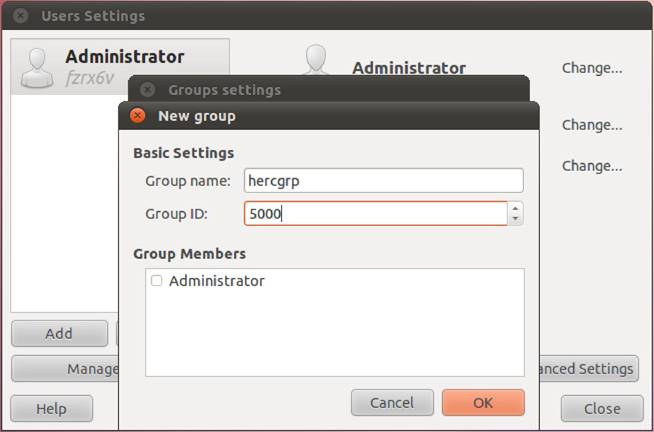 Figure 99: Creating Linux Group
Now navigate to the User management section or tab and click “Add”.
In Ubuntu, just click “Add” from the “Users Settings” dialog.
In the “Create New User” dialog, enter the Name and
Username of the account to be created and click “OK”. In this example,
we are creating a userid of “hercules”.
You will
normally be asked to set a password for the new account. Enter your chosen
password and click “OK” to complete the dialog.
Figure 99: Creating Linux Group
Now navigate to the User management section or tab and click “Add”.
In Ubuntu, just click “Add” from the “Users Settings” dialog.
In the “Create New User” dialog, enter the Name and
Username of the account to be created and click “OK”. In this example,
we are creating a userid of “hercules”.
You will
normally be asked to set a password for the new account. Enter your chosen
password and click “OK” to complete the dialog.

|
|
|
|
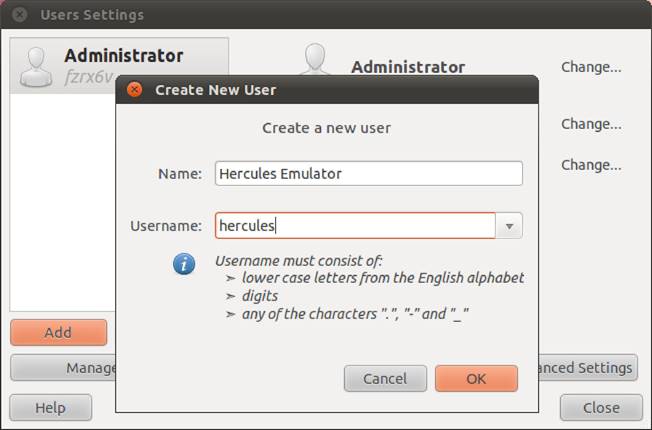 Figure 100: Create Linux User
Now click on the “Advanced Settings” tab and set the
default group to the one you created previously (in this case, “hercgrp”).
In Ubuntu, this setting is available under the “Advanced” tab by
selecting the group from the “Main group” drop-down list.
If you wish, you can also set a UID for the account. In this
example we have set 5000 as the UID (not to be confused with the GID of 5000
for the group).
Click “OK”
and then “Close” to complete the dialog.
Figure 100: Create Linux User
Now click on the “Advanced Settings” tab and set the
default group to the one you created previously (in this case, “hercgrp”).
In Ubuntu, this setting is available under the “Advanced” tab by
selecting the group from the “Main group” drop-down list.
If you wish, you can also set a UID for the account. In this
example we have set 5000 as the UID (not to be confused with the GID of 5000
for the group).
Click “OK”
and then “Close” to complete the dialog.

|
|
|
|
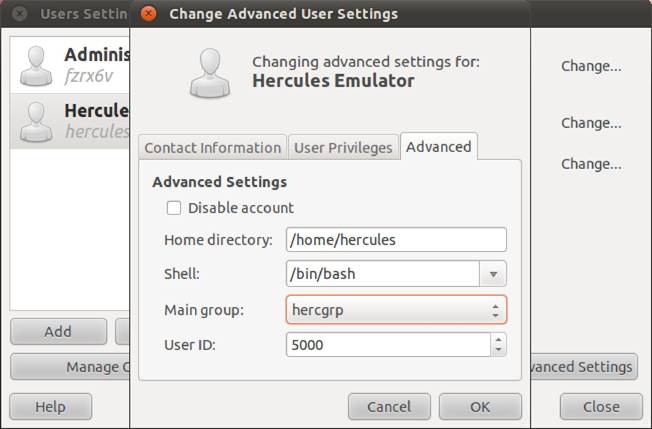 Figure 101: Advanced User Settings
19.2 Installation Methods
There are a number of ways to install Hercules on Linux and your
choice of method may depend both on your flavour of Linux and your attitude to
the Hercules software itself.
The different variants of Linux each have their own approach to
application software management and many provide excellent tools for installing
application packages. If your Linux variant has such a management tool (most
do), then this could be the simplest way of installing the Hercules binaries.
Our reference Linux system for this document, Ubuntu 10.10, contains such a
facility and we will run through the necessary steps to install Hercules using
this technique.
If such a plug-and-play approach to software installation does not
suite you, or you require greater flexibility when installing software
packages, the Hercules web site at<wrap></wrap><wrap>http:%%//%%www.hercules-390.eu</wrap><wrap></wrap>contains
RPM packages for both binary and source installation.
Both of the above techniques result in the currently released
stable version of the Hercules binaries being installed. This is normally the
best practice, so either of these two techniques is normally recommended. Some
people however, need the latest software being developed by the Hercules
engineers and more up-to-date packages can also be implemented.
19.3 Software Management Installation
Ubuntu provides a package management facility called the “Synaptic
Package Manager” which can be found under System → Administration from
the panels bar. To use a program like a Package Management facility, you will
normally need to have access to “sudo” and provide your password when you call
it.
Figure 101: Advanced User Settings
19.2 Installation Methods
There are a number of ways to install Hercules on Linux and your
choice of method may depend both on your flavour of Linux and your attitude to
the Hercules software itself.
The different variants of Linux each have their own approach to
application software management and many provide excellent tools for installing
application packages. If your Linux variant has such a management tool (most
do), then this could be the simplest way of installing the Hercules binaries.
Our reference Linux system for this document, Ubuntu 10.10, contains such a
facility and we will run through the necessary steps to install Hercules using
this technique.
If such a plug-and-play approach to software installation does not
suite you, or you require greater flexibility when installing software
packages, the Hercules web site at<wrap></wrap><wrap>http:%%//%%www.hercules-390.eu</wrap><wrap></wrap>contains
RPM packages for both binary and source installation.
Both of the above techniques result in the currently released
stable version of the Hercules binaries being installed. This is normally the
best practice, so either of these two techniques is normally recommended. Some
people however, need the latest software being developed by the Hercules
engineers and more up-to-date packages can also be implemented.
19.3 Software Management Installation
Ubuntu provides a package management facility called the “Synaptic
Package Manager” which can be found under System → Administration from
the panels bar. To use a program like a Package Management facility, you will
normally need to have access to “sudo” and provide your password when you call
it.
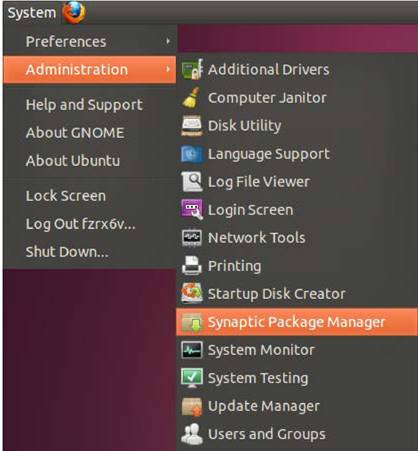 Figure 102:
Synaptic Package Manager Selection
The package management software allows you
to search for which applications you would like to install.
In this case, enter “hercules” into the quick search box and the
software will display a list of applications which contain this name in either
the package name or description.
As you can see in the illustration “Package Manager Selection” on
page 158, the package manager has responded with a list which contains the
Hercules software and a description of “System/370, ESA/390 and z/Architecture
Emulator”.
By clicking
on the check-box to the left of the selection, the system will respond with a
properties list detailing the actions that you can perform. In this case, we
wish to mark the application for installation which we can do by clicking on
this option.
Figure 102:
Synaptic Package Manager Selection
The package management software allows you
to search for which applications you would like to install.
In this case, enter “hercules” into the quick search box and the
software will display a list of applications which contain this name in either
the package name or description.
As you can see in the illustration “Package Manager Selection” on
page 158, the package manager has responded with a list which contains the
Hercules software and a description of “System/370, ESA/390 and z/Architecture
Emulator”.
By clicking
on the check-box to the left of the selection, the system will respond with a
properties list detailing the actions that you can perform. In this case, we
wish to mark the application for installation which we can do by clicking on
this option.

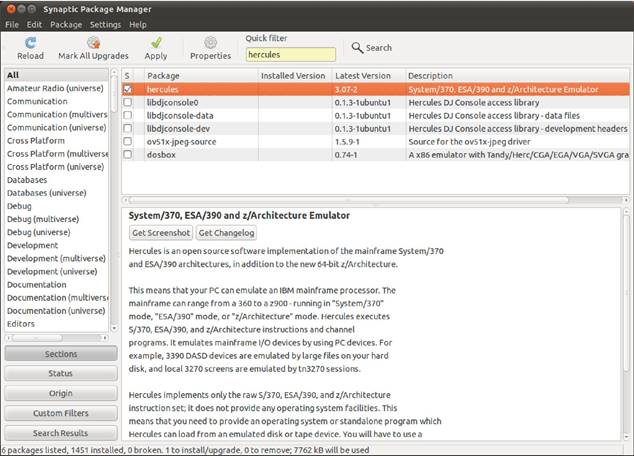 Figure 103:
Package Manager Selection
Once you
have completed your selection of applications to be installed, click the
“Apply” icon which you will see on the action bar above the package
information. The package manager will respond with a summary showing what will
be installed.
Figure 103:
Package Manager Selection
Once you
have completed your selection of applications to be installed, click the
“Apply” icon which you will see on the action bar above the package
information. The package manager will respond with a summary showing what will
be installed.

|
|
|
|
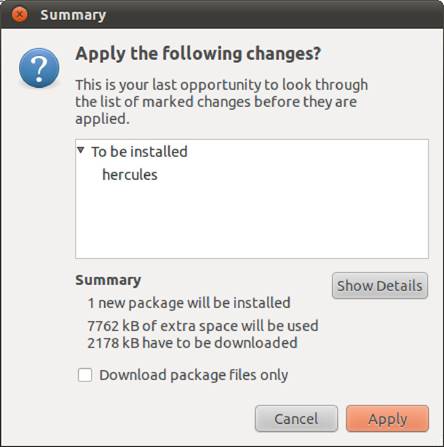 Figure 104: Applying Application Changes
Click “Apply” on this panel to complete the installation. Once
complete, the system will respond with:
Figure 104: Applying Application Changes
Click “Apply” on this panel to complete the installation. Once
complete, the system will respond with:
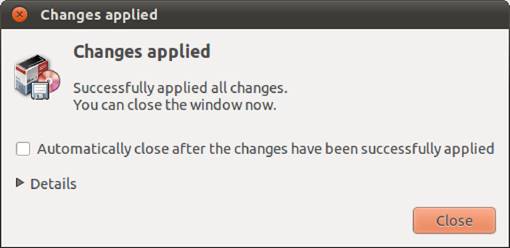 Figure 105:
Changes Applied
Figure 105:
Changes Applied

The
Hercules binaries are now installed, so you can skip to “Verifying the Hercules
Installation” on page 172 to continue.
 19.4
Building from Source
The second
main installation option is to build the Hercules binaries from the available
source distribution. Despite the extra effort involved, this method has a
significant advantage over the more automated installation options.
The
configure and build process allows the installer to specify a number of
configuration and optimization flags to control how the binaries are built.
·Configuration options can, for example, enable the external GUI
interface that is required for the excellent Hercules Studio offering from
Jacob Dekel. They can also provide a mechanism to control where the Hercules
binaries are installed. This can be used to easily integrate one of the daily
snapshots of the Hercules binaries available from Ivan Warrens indispensable
build site.
·Optimization options can build the binaries in such a way that
they better exploit the hardware used to run them.
Lastly,
this is the only method I suspect a true dyed-in-the-wool system programmer
would sanction!
19.4.1 The Build Process
We will start the build process by locating and downloading the
source package from the Hercules web site. Use one of the following procedures
to download the source tarball (Currently described as “hercules-3.07.tar.gz”)
package to your local software directory (or /tmp if you don’t plan to keep
it):
1.Point your
favorite Browser to<wrap></wrap><wrap>http:%%//%%www.hercules-390.eu/</wrap><wrap></wrap>and
right-click the source tarball link. Then select “Save Link As…” to download
it.
2.Use the
“wget” command to download the source package:
19.4
Building from Source
The second
main installation option is to build the Hercules binaries from the available
source distribution. Despite the extra effort involved, this method has a
significant advantage over the more automated installation options.
The
configure and build process allows the installer to specify a number of
configuration and optimization flags to control how the binaries are built.
·Configuration options can, for example, enable the external GUI
interface that is required for the excellent Hercules Studio offering from
Jacob Dekel. They can also provide a mechanism to control where the Hercules
binaries are installed. This can be used to easily integrate one of the daily
snapshots of the Hercules binaries available from Ivan Warrens indispensable
build site.
·Optimization options can build the binaries in such a way that
they better exploit the hardware used to run them.
Lastly,
this is the only method I suspect a true dyed-in-the-wool system programmer
would sanction!
19.4.1 The Build Process
We will start the build process by locating and downloading the
source package from the Hercules web site. Use one of the following procedures
to download the source tarball (Currently described as “hercules-3.07.tar.gz”)
package to your local software directory (or /tmp if you don’t plan to keep
it):
1.Point your
favorite Browser to<wrap></wrap><wrap>http:%%//%%www.hercules-390.eu/</wrap><wrap></wrap>and
right-click the source tarball link. Then select “Save Link As…” to download
it.
2.Use the
“wget” command to download the source package:
- Change to a local software directory
cd <local_software_directory>
- Extract
the name of the current Hercules source tarball
wget -q0 – **<wrap>http:%%//%%www.hercules-390.eu</wrap>** | egrep
“hercules-.*tar.gz”
- Download
the file identified by the previous command
wget http://www.hercules-390.eu/<identified_file>

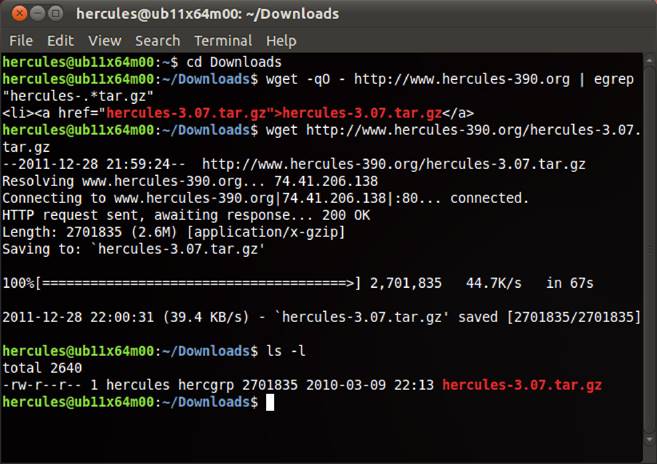 Figure
106: Download Hercules Using “wget”
Now
change to a work area (either your home directory or /tmp will do) and run the
following command to unpack the downloaded source package:
tar -xzvf <local_software_directory>/<identified_file>
This will
extract all the required files into a sub-directory of your current location
which should have the name of the “identified_file“ (without the
suffixes).
Figure
106: Download Hercules Using “wget”
Now
change to a work area (either your home directory or /tmp will do) and run the
following command to unpack the downloaded source package:
tar -xzvf <local_software_directory>/<identified_file>
This will
extract all the required files into a sub-directory of your current location
which should have the name of the “identified_file“ (without the
suffixes).

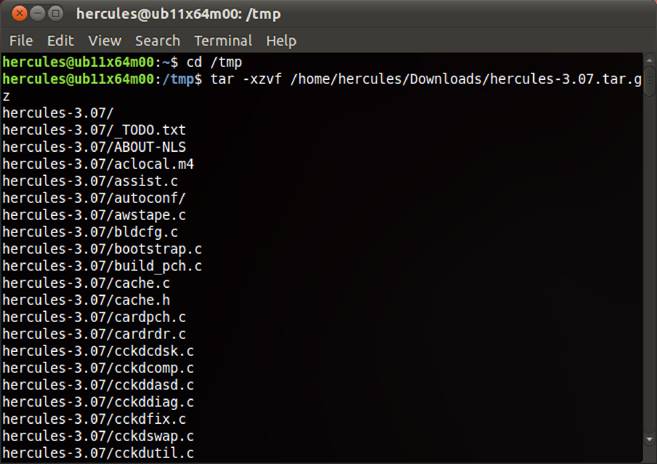 Figure
107: Unpack Binaries using “tar”
Change
into the directory shown after the unpack process is complete. Now issue the
following command:
./util/cvslvlck
This is a handy script provided
by the Hercules developers to let us know what we need (that we don’t already
have) to build the binaries. If any of the software packages that it requires
are missing, we will need to use the Software Manager on the Linux system to
install them.
The
following example output snippet shows one of the packages that the script has
identified the following packages as being not present or at a too low level.
Figure
107: Unpack Binaries using “tar”
Change
into the directory shown after the unpack process is complete. Now issue the
following command:
./util/cvslvlck
This is a handy script provided
by the Hercules developers to let us know what we need (that we don’t already
have) to build the binaries. If any of the software packages that it requires
are missing, we will need to use the Software Manager on the Linux system to
install them.
The
following example output snippet shows one of the packages that the script has
identified the following packages as being not present or at a too low level.

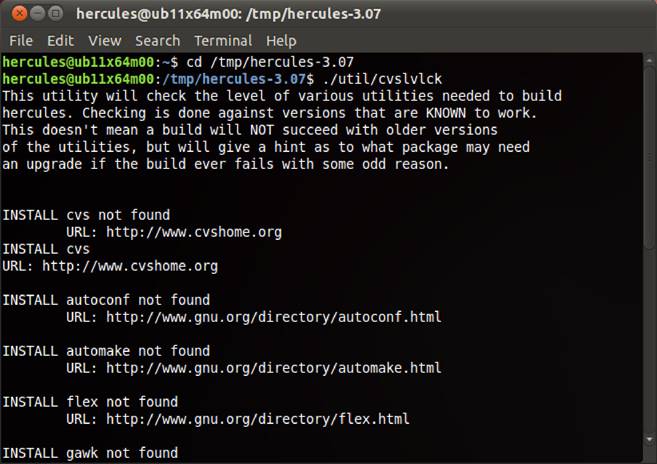 Figure
108: Missing Package
Open the Package Manager and select all the required packages.
As a suggestion add g//(the GNU C++ compiler) to this list.</wrap>
<wrap>Apply
these updates to the system to complete the pre-requisites to configuring and
building the binary installation process as shown in the figure below.</wrap>
<wrap>\\ </wrap><wrap><wrap>{{:hercules:inst:bf:image186.gif
Figure
108: Missing Package
Open the Package Manager and select all the required packages.
As a suggestion add g//(the GNU C++ compiler) to this list.</wrap>
<wrap>Apply
these updates to the system to complete the pre-requisites to configuring and
building the binary installation process as shown in the figure below.</wrap>
<wrap>\\ </wrap><wrap><wrap>{{:hercules:inst:bf:image186.gif
|
|
|
echo
”***************************************************************************************“
ver=$(rpm
-qip ${pkg} | grep -e ”^Version“ | tr -s ' ' | cut -d ' '
-f 3)
rel=$(rpm
-qip ${pkg} | grep -e ”^Release“ | tr -s ' ' | cut -d ' '
-f 3)
retline=$(alien
-s “${pkg}” 2> /dev/null || (echo >&2 “alien failed
for package: ${pkg}”;exit 1))
dir=$(echo “${retline}” | cut -d ' ' -f 2)
cd
${dir} || (echo >&2 “Unable to locate output directory:
${dir}”;exit 2)
mv
debian DEBIAN
cat
DEBIAN/conffiles | sed 's/^_prefix//' > DEBIAN/conffilet || (echo
>&2 “Unable to update conffiles in DEBIAN subdir”;exit 3)
&& mv DEBIAN/conffilet DEBIAN/conffiles
mv
_prefix/* .
rmdir _prefix/
cat
DEBIAN/control | awk -v VERSION=“${ver}.${rel}” '{ if ( NR < 8
&& $0 == ”“ ) print “Version:”, VERSION; else if (
substr($0,1,8) == “Depends:” ) print “Depends:”;
else print $0 }' > DEBIAN/controlt || (echo >&2
“Unable to update control in DEBIAN subdir”;exit 3) && mv
DEBIAN/controlt DEBIAN/control
cd ..
dpkg -b ${dir}
$(echo “${pkg}” | sed 's/^\(.*\)\..*$/\1.deb/')
Figure 117:
RPM Conversion Script
 19.6
Verifying the Hercules Installation
To verify the Hercules binaries installation following either the
Software Management or RPM Installation methods, open a telnet window and run
the following command to show the Hercules version:
hercules 2>&1 | grep Version
The command, like all Linux
commands, is case sensitive. It starts the Hercules program and combines the
two resulting output streams together (“2>&1”) before
piping that through a filter (“grep”) searching for the text string “Version”.
19.6
Verifying the Hercules Installation
To verify the Hercules binaries installation following either the
Software Management or RPM Installation methods, open a telnet window and run
the following command to show the Hercules version:
hercules 2>&1 | grep Version
The command, like all Linux
commands, is case sensitive. It starts the Hercules program and combines the
two resulting output streams together (“2>&1”) before
piping that through a filter (“grep”) searching for the text string “Version”.
 Figure 118:
Verify Hercules Version
Next
display the man pages with the following command:
man Hercules
Figure 118:
Verify Hercules Version
Next
display the man pages with the following command:
man Hercules

This displays the “man” page that is installed as part of the
binary package. Use “q” to exit this display. The next figure shows an extract
of the Hercules man pages.
If both
of these commands return the expected output, then the installation was
successful.
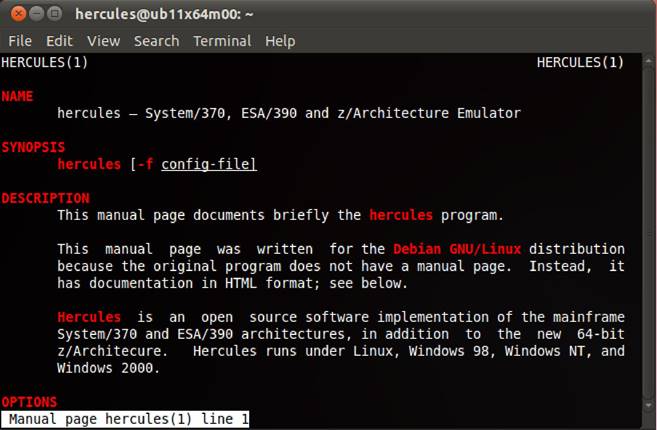 Figure
119: Verify Hercules “man” pages
19.7 Completing the Hercules installation
Once the Hercules binaries have been installed and verified, the
following additional tasks should be completed before starting to configure
your new Hercules environment.
19.7.1 Configuring the Network Interface
In order to support IP routing to a Hercules guest system, a
network tunnel is created using the native Linux “tun<n>” device. This
device simulates a network layer 3 device and routes IP packets between the
Linux operating system and Hercules.
The tunneling device is not active (as a configurable device
object) until it is opened by Hercules. The definition of a 3988 CTC device in
the Hercules configuration file will cause Hercules to call a special program
specifically to start and configure the “tun<n>” device.
This
program is called “hercifc” and is installed as part of the Hercules binaries.
As we are not running Hercules with root authority and this network device
program will require to issue system calls, we need to run some additional
commands to allow it to work correctly.
Figure
119: Verify Hercules “man” pages
19.7 Completing the Hercules installation
Once the Hercules binaries have been installed and verified, the
following additional tasks should be completed before starting to configure
your new Hercules environment.
19.7.1 Configuring the Network Interface
In order to support IP routing to a Hercules guest system, a
network tunnel is created using the native Linux “tun<n>” device. This
device simulates a network layer 3 device and routes IP packets between the
Linux operating system and Hercules.
The tunneling device is not active (as a configurable device
object) until it is opened by Hercules. The definition of a 3988 CTC device in
the Hercules configuration file will cause Hercules to call a special program
specifically to start and configure the “tun<n>” device.
This
program is called “hercifc” and is installed as part of the Hercules binaries.
As we are not running Hercules with root authority and this network device
program will require to issue system calls, we need to run some additional
commands to allow it to work correctly.
|
Command
|
Description
| |
whereis hercifc
|
Display the location of the hercifc program. This “whereis” command is a Linux program that searches in well-known locations for programs or source files.
| |
cd /usr/bin
|
Change to the directory containing the “hercifc” program
| |
ls –l hercifc
|
List the current attributes of the hercifc program.
| |
sudo chown root:hercgrp hercifc
|
Use “sudo” to change the ownership of the “hercifc” program to “root” with a group of “hercgrp”.
| |
sudo chmod 4750 hercifc
|
Use “sudo” to change the attributes of the “hercifc” program to be setuid to the owner (root) and executable only by root and the group (hercgrp).
|
Table 24:
Configuring the Network Interface
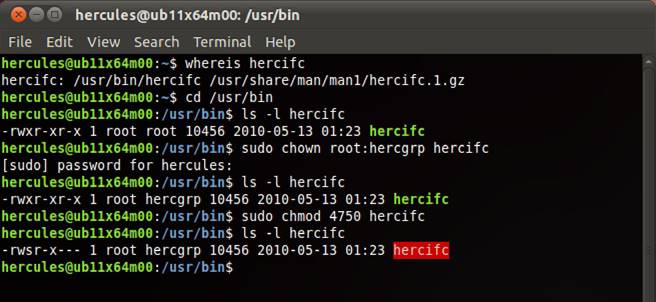 Figure
120: Configuring the Network Interface
The result of these commands is to allow the “hercifc” program
to execute with root authority (that is what the chmod command above does) but
restrict the execution of the program only to the file owner (user “root”) and
any user connected to the “hercgrp” group.
This will
allow the tunnelling device to open and configure correctly when initiated by
user “hercules” but reduce the security exposure of having a program
setuid-to-root to the minimum.
Figure
120: Configuring the Network Interface
The result of these commands is to allow the “hercifc” program
to execute with root authority (that is what the chmod command above does) but
restrict the execution of the program only to the file owner (user “root”) and
any user connected to the “hercgrp” group.
This will
allow the tunnelling device to open and configure correctly when initiated by
user “hercules” but reduce the security exposure of having a program
setuid-to-root to the minimum.

19.7.2 Installing a 3270 Terminal Client
If you don’t have your own 3270 Terminal Client, use the procedure
detailed in “Software Management” on page 156 to install the x3270
Terminal Client included in almost all Linux distributions.
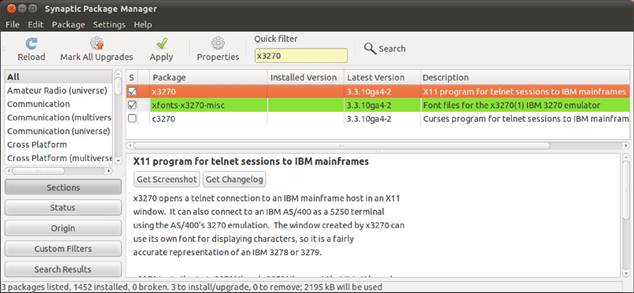 Figure 121:
Installing a 3270 Terminal Client
Figure 121:
Installing a 3270 Terminal Client

 20.
Customization Steps
After the actual installation is complete there are some
additional customization steps, some of which are required and some optional,
these include:
·Creating the Hercules Configuration File
·Creating the Hercules Startup Script File
·Creating the Hercules Run-Command File
·Creating a Hercules desktop Launcher
·Using the “screen” command to virtualize the Hercules console
These
manual customization steps are explained in detail over the following sections.
20.
Customization Steps
After the actual installation is complete there are some
additional customization steps, some of which are required and some optional,
these include:
·Creating the Hercules Configuration File
·Creating the Hercules Startup Script File
·Creating the Hercules Run-Command File
·Creating a Hercules desktop Launcher
·Using the “screen” command to virtualize the Hercules console
These
manual customization steps are explained in detail over the following sections.
 20.1
Directory Locations
Before we
create the runtime files to execute our Hercules emulator, it is probably
useful to identify what files we are going to create and where they should be
created.
Up to this
point in the process, we have created the Hercules binaries in locations either
controlled by the software package management facility or by specifying a
target directory.
Now we are
going to create some script and configuration files and we need to identify
where we need to create them. Additionally, we will need to identify a location
for our target operating system, for example MVS 3.8.
|
20.1
Directory Locations
Before we
create the runtime files to execute our Hercules emulator, it is probably
useful to identify what files we are going to create and where they should be
created.
Up to this
point in the process, we have created the Hercules binaries in locations either
controlled by the software package management facility or by specifying a
target directory.
Now we are
going to create some script and configuration files and we need to identify
where we need to create them. Additionally, we will need to identify a location
for our target operating system, for example MVS 3.8.
|
\usr
\bin Hercules binaries are stored here after a Package Manager installation. \lib
\hercules Hercules shared object (or linked library) files.
\local System defined location for local modifications.
\bin Location for local scripts (e.g. start-up script).
\hercules Completely separate directory for the Hercules guest operating system.
\mvs Location for Hercules configuration file and run-command script file.
\dasd Location for operating system disk files.
\tape Location for operating system tape files.
\printer Location for operating system printer files.
\log Location for Hercules log files.
|
Figure 122:
Linux Directory Structure Example

 20.2 The
Hercules Configuration File
When
starting the Hercules Emulator from either a telnet shell or via a launcher,
you must specify the name of a configuration file as a parameter:
hercules –f filename …
where filename is the name of the configuration file. The
default filename if none is specified during the start-up is ‘hercules.cnf’.
The name of the default configuration file may be overridden via the
environment variable HERCULES_CNF.
The configuration file is an ASCII text file that is used to
describe the processor definition, the device layout and any runtime
parameters. Details of the format and acceptable directives that can be made
within the file are found in the Hercules “User Reference Guide”.
Using the directory structure example outlined in “Directory
Locations” on page176, we would create this file in:
/hercules/mvs/
20.2 The
Hercules Configuration File
When
starting the Hercules Emulator from either a telnet shell or via a launcher,
you must specify the name of a configuration file as a parameter:
hercules –f filename …
where filename is the name of the configuration file. The
default filename if none is specified during the start-up is ‘hercules.cnf’.
The name of the default configuration file may be overridden via the
environment variable HERCULES_CNF.
The configuration file is an ASCII text file that is used to
describe the processor definition, the device layout and any runtime
parameters. Details of the format and acceptable directives that can be made
within the file are found in the Hercules “User Reference Guide”.
Using the directory structure example outlined in “Directory
Locations” on page176, we would create this file in:
/hercules/mvs/
 20.3 The
Hercules Start-up Script File
Although the Hercules Emulator can be started manually from a
shell, it is often easier to establish a script file to do this. The script
file can then be executed by running it from the shell or creating a launcher
to start it from the desktop. We shall use the name “<wrap>hercules.sh</wrap>” for our start-up script.
Using the
directory structure example outlined in “Directory Locations” on page 176, we
would create this file in:
/usr/local/bin/
20.3.1 Create the Hercules Start-up Script File
The
following figure shows an example of a Hercules start-up script file using the
native Hercules console. You should use one of the installed editors (or “vi”
if you are feeling adventurous):
#!/bin/sh
#export
PATH=/usr/local/hercules/bin:${PATH}
#export LIBPATH=/usr/local/hercules/lib:${LIBPATH}
cd /hercules/mvs
hercules –f mvs.cnf
Figure 123:
Hercules Startup Script File
This example script file contains only two commands:
·The first two commands have been commented out but can be
activated if the binaries have been installed into a non-standard location.
20.3 The
Hercules Start-up Script File
Although the Hercules Emulator can be started manually from a
shell, it is often easier to establish a script file to do this. The script
file can then be executed by running it from the shell or creating a launcher
to start it from the desktop. We shall use the name “<wrap>hercules.sh</wrap>” for our start-up script.
Using the
directory structure example outlined in “Directory Locations” on page 176, we
would create this file in:
/usr/local/bin/
20.3.1 Create the Hercules Start-up Script File
The
following figure shows an example of a Hercules start-up script file using the
native Hercules console. You should use one of the installed editors (or “vi”
if you are feeling adventurous):
#!/bin/sh
#export
PATH=/usr/local/hercules/bin:${PATH}
#export LIBPATH=/usr/local/hercules/lib:${LIBPATH}
cd /hercules/mvs
hercules –f mvs.cnf
Figure 123:
Hercules Startup Script File
This example script file contains only two commands:
·The first two commands have been commented out but can be
activated if the binaries have been installed into a non-standard location.

·The next command changes the current directory to the location
where the configuration and run-command files can be found (see “Directory
Locations” on page 176)
·The last command runs Hercules with a specified configuration
file.
To create this file using “vi”, try the following in a telnet shell:
|
Command, Input
|
Description
| |
cd /usr/local/bin
|
Change to the correct directory.
| |
sudo vi <wrap>hercules.sh</wrap>
|
Use “vi” to edit the new file. Use “sudo” because we probably don’t have the authority otherwise.
| |
i
|
Enter „insert“ mode.
| |
#!/bin/sh
|
Type line and <enter>.
| |
#export PATH=/usr/local/hercules/bin:${PATH}
|
Type line and <enter>.
| |
#export LIBPATH=/usr/local/hercules/lib:${LIBPATH}
|
Type line and <enter>.
| |
cd /hercules/mvs
|
Type line and <enter>.
| |
hercules –f mvs.cnf
|
Type line and <enter>.
| |
<esc>:wq
|
Hit the escape key (which will put you in command mode) and type :wq to write the file and quit.
|
Table 25:
Create Hercules Start-up Script File
20.3.2 Making the Hercules Startup Script executable
Now we have created our start-up script file, we need to make it
executable. This is necessary as Linux can executable a file only when it is
marked as executable. This is a security feature to try to reduce the chance of
creating a dangerous command file by mistake.
If you use a standard umask, the file will have been created with
attributes of “644”, which means that you cannot execute it.
Don’t worry too much about what this is if you don’t know. You can
type “umask” into a shell to see what the current setting is. Using our
recommended security environment, we are going to issue two commands:
First we
change the ownership of the file to the Hercules userid and its group:
sudo chown hercules:hercgrp **<wrap>hercules.sh</wrap>**

Now we
change the attributes to make it executable:
sudo chmod u+x,g+x **<wrap>hercules.sh</wrap>**
You can
also set the attributes directly using the command:
chmod 754 **<wrap>hercules.sh</wrap>**
 20.4 The
Hercules Run-Commands File
Hercules also provides the ability to automatically execute
Hercules panel commands after start-up via the 'run-commands' file. If the
run-commands file exists when Hercules starts, each line contained in the file
is read and interpreted as panel command. We shall use the name “hercules.rc” for our
run-commands script.
Using the directory structure example outlined in “Directory
Locations” on page 176, we would create this
file in:
/hercules/mvs/
20.4.1 Create the Hercules Run-Commands File
In the
following example file, an x3270 command is run to start a session for the
console and then all the currently valid Hercules panel commands are displayed
and MAXRATES is reset. Finally a couple of further x3270 sessions for consoles
and TSO terminals are started.
sh x3270 –model 3278-3 –once 127.0.0.1:3270 &
?
maxrates
pause 1
sh x3270 –model 3279-4 –once –color 127.0.0.1:3270
&
pause 1
sh x3270 –model 3279-4 –once –color 127.0.0.1:3270 &
Figure 124:
Hercules Run-Commands File
Creative use of the run-commands
file can completely automate Hercules start-up and initiate the IPL of the
mainframe operating system. For details about the usage of the run-commands
file see the Hercules “User Reference Guide”.
20.4 The
Hercules Run-Commands File
Hercules also provides the ability to automatically execute
Hercules panel commands after start-up via the 'run-commands' file. If the
run-commands file exists when Hercules starts, each line contained in the file
is read and interpreted as panel command. We shall use the name “hercules.rc” for our
run-commands script.
Using the directory structure example outlined in “Directory
Locations” on page 176, we would create this
file in:
/hercules/mvs/
20.4.1 Create the Hercules Run-Commands File
In the
following example file, an x3270 command is run to start a session for the
console and then all the currently valid Hercules panel commands are displayed
and MAXRATES is reset. Finally a couple of further x3270 sessions for consoles
and TSO terminals are started.
sh x3270 –model 3278-3 –once 127.0.0.1:3270 &
?
maxrates
pause 1
sh x3270 –model 3279-4 –once –color 127.0.0.1:3270
&
pause 1
sh x3270 –model 3279-4 –once –color 127.0.0.1:3270 &
Figure 124:
Hercules Run-Commands File
Creative use of the run-commands
file can completely automate Hercules start-up and initiate the IPL of the
mainframe operating system. For details about the usage of the run-commands
file see the Hercules “User Reference Guide”.

 21. Optional Customization
There are a few additional (optional) customization steps that can
simplify the daily work with the Hercules Emulator. These steps are:
·Creating a Hercules Desktop Launcher
·Using the Screen Command
21. Optional Customization
There are a few additional (optional) customization steps that can
simplify the daily work with the Hercules Emulator. These steps are:
·Creating a Hercules Desktop Launcher
·Using the Screen Command
 21.1
Creating a Hercules Desktop Launcher
Although the Hercules Emulator can be started manually from a
telnet shell, it is often easier to create a desktop launcher to do this. The
creation of the launcher can vary from Linux variant to variant, but will be
similar to the following process for our reference Ubuntu system.
Right-click
on the desktop and then click on the “Create Launcher …”
21.1
Creating a Hercules Desktop Launcher
Although the Hercules Emulator can be started manually from a
telnet shell, it is often easier to create a desktop launcher to do this. The
creation of the launcher can vary from Linux variant to variant, but will be
similar to the following process for our reference Ubuntu system.
Right-click
on the desktop and then click on the “Create Launcher …”
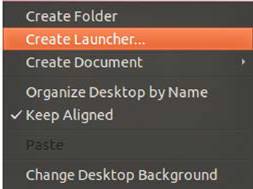 Figure 125:
Create Launcher
In the following window, enter the required information:
·In the “Type” drop-down list, select “Application in
Terminal”.
·Enter a name for the launcher.
·Enter the Hercules start-up script that you created earlier. In
our example, this would be: /usr/local/bin/<wrap>hercules.sh</wrap>
·Enter an optional comment.
You can
also select a different icon if you wish.
Figure 125:
Create Launcher
In the following window, enter the required information:
·In the “Type” drop-down list, select “Application in
Terminal”.
·Enter a name for the launcher.
·Enter the Hercules start-up script that you created earlier. In
our example, this would be: /usr/local/bin/<wrap>hercules.sh</wrap>
·Enter an optional comment.
You can
also select a different icon if you wish.

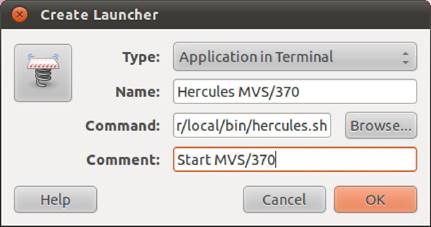 Figure 126:
Create Desktop Launcher Properties
Figure 126:
Create Desktop Launcher Properties
 21.2
Running Hercules via Desktop Launcher
Once these
command and configuration files have been created, clicking on the launcher
will start the Hercules program and the required 3270 sessions:
21.2
Running Hercules via Desktop Launcher
Once these
command and configuration files have been created, clicking on the launcher
will start the Hercules program and the required 3270 sessions:



 21.3
Using the Screen Command
A useful extension to the already described methods of running
the Hercules command is to augment the chosen method with the Linux “screen”
command.
The screen command is a full-screen window manager that builds a
virtual terminal providing VT100 emulation and allowing it to be shared between
multiple processes.
The advantage of using this facility is that the Hercules
console can be created in a “screen“ virtual terminal and then moved from
one client to another, even to a different host. Of course, only the Hercules
console is moved with the virtual screen. The Hercules process itself remains
running where it was started.
To use
the “screen” command, open a shell window and type the following command:
screen –d –r –S Hercules –t
“Hercules MVS/370”
This
command will create a virtual terminal and wait for input to the new window:
21.3
Using the Screen Command
A useful extension to the already described methods of running
the Hercules command is to augment the chosen method with the Linux “screen”
command.
The screen command is a full-screen window manager that builds a
virtual terminal providing VT100 emulation and allowing it to be shared between
multiple processes.
The advantage of using this facility is that the Hercules
console can be created in a “screen“ virtual terminal and then moved from
one client to another, even to a different host. Of course, only the Hercules
console is moved with the virtual screen. The Hercules process itself remains
running where it was started.
To use
the “screen” command, open a shell window and type the following command:
screen –d –r –S Hercules –t
“Hercules MVS/370”
This
command will create a virtual terminal and wait for input to the new window:
 Figure
128: Screen Command
The first command shown in the figure
displays the active virtual screens. Currently there are no screens. Then enter
the command shown above to build a new virtual screen with the given name and
title.
Once the
new virtual screen opens, you can list the available virtual screens which
should now include the newly define one active in our shell.
Figure
128: Screen Command
The first command shown in the figure
displays the active virtual screens. Currently there are no screens. Then enter
the command shown above to build a new virtual screen with the given name and
title.
Once the
new virtual screen opens, you can list the available virtual screens which
should now include the newly define one active in our shell.
 Figure
129: List Available Screens
From this
virtual screen, you can start the Hercules process. Once started, you can
detach this screen using the following commands:
Figure
129: List Available Screens
From this
virtual screen, you can start the Hercules process. Once started, you can
detach this screen using the following commands:

“Alt-a d” from within the virtual screen or with the following command
from another process:
screen –d Hercules

 22. Installing the Hercules Studio GUI
The Hercules Studio provides a graphical user interface under
Linux to the Hercules Emulator itself. Hercules itself has only a
semi-graphical user interface, the Hercules Studio gives a full graphical user
interface.
The Hercules Studio is the Linux counterpart to the Hercules
Windows GUI described in the previous sections. If you are already familiar
with the Hercules Windows GUI then you will have no problems working with the
Hercules Studio.
Hercules Studio is written and maintained by Jacob Dekel. The
Hercules Studio GUI can be downloaded from<wrap> www.jacobdekel.com/hercstudio</wrap><wrap>.</wrap>
The Hercules Studio GUI can be treated much like the Hercules
binaries themselves. It can be installed using the Software Management package
or built from the source tarball that has been made available on the same web
site.
There are both 32-bit and 64-bit versions of the binaries package
available and they can be installed by clicking on the appropriate link. There
is also each version available in RPM format (RedHat, CentOS, Fedora, SUSE,
OpenSUSE, …) and DEB format (Debian, Ubuntu, Linux Mint, …).
For our
reference Ubuntu 64-bit system, we click on the “Hercules Studio 1.3.0 in
Deb 64-bit format” link.
22. Installing the Hercules Studio GUI
The Hercules Studio provides a graphical user interface under
Linux to the Hercules Emulator itself. Hercules itself has only a
semi-graphical user interface, the Hercules Studio gives a full graphical user
interface.
The Hercules Studio is the Linux counterpart to the Hercules
Windows GUI described in the previous sections. If you are already familiar
with the Hercules Windows GUI then you will have no problems working with the
Hercules Studio.
Hercules Studio is written and maintained by Jacob Dekel. The
Hercules Studio GUI can be downloaded from<wrap> www.jacobdekel.com/hercstudio</wrap><wrap>.</wrap>
The Hercules Studio GUI can be treated much like the Hercules
binaries themselves. It can be installed using the Software Management package
or built from the source tarball that has been made available on the same web
site.
There are both 32-bit and 64-bit versions of the binaries package
available and they can be installed by clicking on the appropriate link. There
is also each version available in RPM format (RedHat, CentOS, Fedora, SUSE,
OpenSUSE, …) and DEB format (Debian, Ubuntu, Linux Mint, …).
For our
reference Ubuntu 64-bit system, we click on the “Hercules Studio 1.3.0 in
Deb 64-bit format” link.
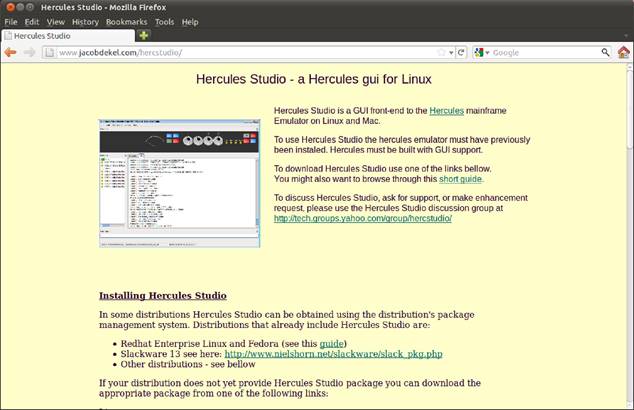 Figure 130:
Hercules Studio WebSite
Figure 130:
Hercules Studio WebSite

 22.1
Installation Steps
Clicking on
the package link should start the Software Management facility which will
initiate the installation of the package.
22.1
Installation Steps
Clicking on
the package link should start the Software Management facility which will
initiate the installation of the package.
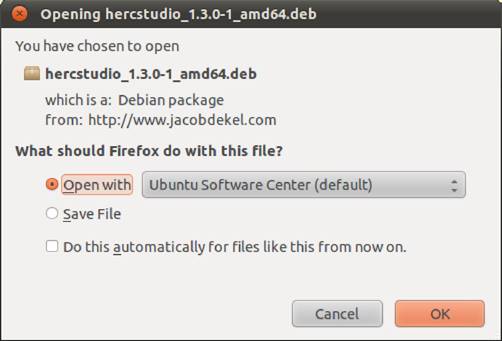 Figure 131:
Initiate Hercules Studio Installation
Clicking
“OK” will start the Software Management installation process. Clicking
“Install” will download the selected package and complete the installation:
Figure 131:
Initiate Hercules Studio Installation
Clicking
“OK” will start the Software Management installation process. Clicking
“Install” will download the selected package and complete the installation:

|
|
|
|







HerculesStudio –f mvs.cnf
The next
figure shows the running Hercules Studio. A detailed description about working
with the Hercules Studio can be found in the “Operations and Utilities Guide”.
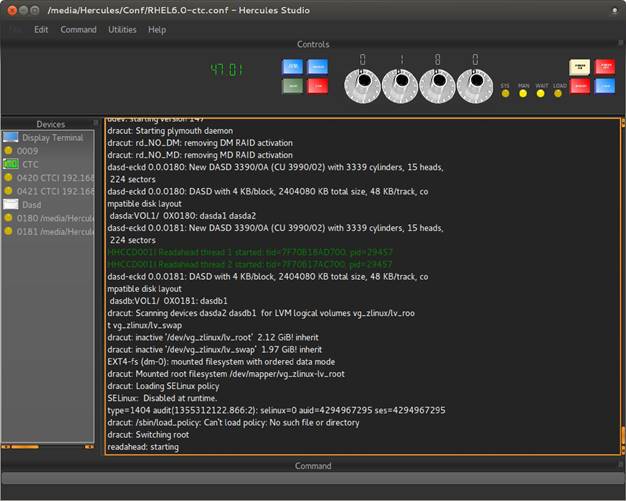 Figure 133:
Running the Hercules Studio
Figure 133:
Running the Hercules Studio

 Part IV: Mac OS X Installation
Part IV: Mac OS X Installation

 23. Software Prerequisites
23. Software Prerequisites
 23.1
Operating System
Hercules is an open source software implementation of the
System/370, ESA/390 and z/Architecture hardware. Hercules itself is not an
operating system nor does it emulate a mainframe operating system. The Hercules
Emulator runs under Linux on several hardware platforms including the Intel
Pentium PC, under various flavours of Microsoft Windows and under Apple Mac OS
X. From the point of view of the underlying operating system the Hercules
Emulator is just an application program.
Part IV of this guide focuses solely on the installation of
Hercules under Apple Mac OS X. Details of other host operating systems are
covered in Part II (Windows) and Part III (Linux) in this book. The
installation of any hosted operating system and software utilities is beyond
the scope of this book.
23.1.1 Mac OS X Versions
The Hercules Emulator runs under Mac OS X since Mac OS X 10.2
(Jaguar), native support became available with Hercules Release 2.17. With Mac
OS X 10.3 (Panther) a Tun/Tap driver became available. Starting with Mac OS X
10.4 (Tiger) and Hercules Release 3.03, Mac OS X became a suitable platform for
the Hercules Emulator too.
The Hercules Emulator supports PPC and Intel Macs with 32-Bit and
64-Bit CPUs. Be aware that there is a performance penalty when Hercules emulates
a 64-bit architecture on a 32-bit processor. If you are serious about running
64-bit guests you should probably use Hercules for a 64-bit processor.
Generally it is a good idea to have a current operating system
running, maintained with the latest updates. Have also a look at the Tun/Tap
driver that is not part of the Mac OS X.
23.1.2 Stability
Hercules appears to Mac OS X as just another application program.
Although it is possible to run other applications simultaneously with Hercules,
this is not recommended.
While the Hercules Emulator is extremely stable, it is impossible
to guarantee that other applications will not degrade the Hercules performance.
The less software you have running on your Mac, the more stable your emulated
mainframe will be running. Prevent any heavy workload changes. Hercules will
get no problems indeed, but the guest system will however.
23.1.3 System Slow Down
In typical use cases Hercules has a little to no impact on the Mac
OS X system overall performance. The impact on performance will mainly depend
on the amount of applications and guest systems running at the same time, and
how much RAM is available on your Mac OS X system.
23.1.4 Installed Software on a Hercules System
It is recommended to have only a minimum of
software installed on a Hercules host machine. Installation disk images are
available for Mac OS X 10.4 (Tiger), 10.5 (Leopard) and 10.6 (Snow Leopard).
Additional
to the software for the Hercules Emulator presented in this guide, it is
recommended to have the following software installed:
23.1
Operating System
Hercules is an open source software implementation of the
System/370, ESA/390 and z/Architecture hardware. Hercules itself is not an
operating system nor does it emulate a mainframe operating system. The Hercules
Emulator runs under Linux on several hardware platforms including the Intel
Pentium PC, under various flavours of Microsoft Windows and under Apple Mac OS
X. From the point of view of the underlying operating system the Hercules
Emulator is just an application program.
Part IV of this guide focuses solely on the installation of
Hercules under Apple Mac OS X. Details of other host operating systems are
covered in Part II (Windows) and Part III (Linux) in this book. The
installation of any hosted operating system and software utilities is beyond
the scope of this book.
23.1.1 Mac OS X Versions
The Hercules Emulator runs under Mac OS X since Mac OS X 10.2
(Jaguar), native support became available with Hercules Release 2.17. With Mac
OS X 10.3 (Panther) a Tun/Tap driver became available. Starting with Mac OS X
10.4 (Tiger) and Hercules Release 3.03, Mac OS X became a suitable platform for
the Hercules Emulator too.
The Hercules Emulator supports PPC and Intel Macs with 32-Bit and
64-Bit CPUs. Be aware that there is a performance penalty when Hercules emulates
a 64-bit architecture on a 32-bit processor. If you are serious about running
64-bit guests you should probably use Hercules for a 64-bit processor.
Generally it is a good idea to have a current operating system
running, maintained with the latest updates. Have also a look at the Tun/Tap
driver that is not part of the Mac OS X.
23.1.2 Stability
Hercules appears to Mac OS X as just another application program.
Although it is possible to run other applications simultaneously with Hercules,
this is not recommended.
While the Hercules Emulator is extremely stable, it is impossible
to guarantee that other applications will not degrade the Hercules performance.
The less software you have running on your Mac, the more stable your emulated
mainframe will be running. Prevent any heavy workload changes. Hercules will
get no problems indeed, but the guest system will however.
23.1.3 System Slow Down
In typical use cases Hercules has a little to no impact on the Mac
OS X system overall performance. The impact on performance will mainly depend
on the amount of applications and guest systems running at the same time, and
how much RAM is available on your Mac OS X system.
23.1.4 Installed Software on a Hercules System
It is recommended to have only a minimum of
software installed on a Hercules host machine. Installation disk images are
available for Mac OS X 10.4 (Tiger), 10.5 (Leopard) and 10.6 (Snow Leopard).
Additional
to the software for the Hercules Emulator presented in this guide, it is
recommended to have the following software installed:

·Mac OS X 10.4 or later maintained with the latest updates.
·Tun/Tap driver (this is not a part of Mac OS X).
·TN3270 terminal emulation (a Telnet terminal emulation is
available with Mac OS X).
·Hercules Studio GUI (optional).
In general
though the less software is installed and running, the better the emulated
mainframe will run.
 23.2
Runtime Environments
This chapter describes special runtime environments that act as a
base for running the Hercules Emulator. Under Mac OS X the BSD subsystem
package is used.
23.2.1 BSD Environment
Before using Mac OS X as a Hercules system, you should make sure
that the BSD subsystem is installed. On OS X 10.4 (Tiger), this option is
installed by default, but on previous versions it was not. You can check for
this by looking for the BSD package receipt (BSD.pkg, in “/Library/Receipts”).
If this receipt is not present on your system, you must reinstall Mac OS X.
When you do this, you must customise the installation by checking the BSD
Subsystem check-box.
If you have already installed software updates, you cannot simply
go back and reinstall over the existing system because of the potential for
version conflicts with the software updates. If the BSD subsystem package is
not installed, you will have to do an “archive and install”
installation and then reinstall the software updates.
The Mac OS X Developer Tools package (XCode Tools Package)
provides additional tools that you will need to install to complete your
development environment. These are not part of the default installation. They
contain some of the most important tools, such as the compiler (gcc) and
debugger (gdb) in the Unix development component package. This package is
provided for compatibility with shell scripts and makefiles that require access
to the Developer Tools. Starting with Mac OS X 10.7 (Lion) the Command Line
Tools package enables Unix style development. The Developer Tools are essential
for you only to build Hercules by yourself.
The terminal application is located in the Utilities folder (which
is within the Applications folder at the root level of your hard drive).
Once you have a terminal window open, you can take advantage of a
basic selection of common tools and lots of Hercules line command tools,
assuming that Hercules was installed.
With the BSD subsystem package installed, a look through “/bin”
and “/usr/bin” should reveal a familiar environment for BSD and Unix user. The
Hercules command line tools are installed through “/usr/local/bin”.
23.2.2 Runtime Security
The Hercules Emulator can run under a root user (any user with a UID of
0), but it is recommended to run it under its own user. To do this you have to
create a new user under which to run the Hercules Emulator.
23.2
Runtime Environments
This chapter describes special runtime environments that act as a
base for running the Hercules Emulator. Under Mac OS X the BSD subsystem
package is used.
23.2.1 BSD Environment
Before using Mac OS X as a Hercules system, you should make sure
that the BSD subsystem is installed. On OS X 10.4 (Tiger), this option is
installed by default, but on previous versions it was not. You can check for
this by looking for the BSD package receipt (BSD.pkg, in “/Library/Receipts”).
If this receipt is not present on your system, you must reinstall Mac OS X.
When you do this, you must customise the installation by checking the BSD
Subsystem check-box.
If you have already installed software updates, you cannot simply
go back and reinstall over the existing system because of the potential for
version conflicts with the software updates. If the BSD subsystem package is
not installed, you will have to do an “archive and install”
installation and then reinstall the software updates.
The Mac OS X Developer Tools package (XCode Tools Package)
provides additional tools that you will need to install to complete your
development environment. These are not part of the default installation. They
contain some of the most important tools, such as the compiler (gcc) and
debugger (gdb) in the Unix development component package. This package is
provided for compatibility with shell scripts and makefiles that require access
to the Developer Tools. Starting with Mac OS X 10.7 (Lion) the Command Line
Tools package enables Unix style development. The Developer Tools are essential
for you only to build Hercules by yourself.
The terminal application is located in the Utilities folder (which
is within the Applications folder at the root level of your hard drive).
Once you have a terminal window open, you can take advantage of a
basic selection of common tools and lots of Hercules line command tools,
assuming that Hercules was installed.
With the BSD subsystem package installed, a look through “/bin”
and “/usr/bin” should reveal a familiar environment for BSD and Unix user. The
Hercules command line tools are installed through “/usr/local/bin”.
23.2.2 Runtime Security
The Hercules Emulator can run under a root user (any user with a UID of
0), but it is recommended to run it under its own user. To do this you have to
create a new user under which to run the Hercules Emulator.

23.2.3 Firewall
The Hercules Emulator acts as server application, you must allow
incoming connections in the Mac OS X firewall for the Hercules Emulator. The
best time to do this is the first time you start Hercules. The Mac OS X
firewall requests you to authorise the access for the Hercules Emulator.
Note: On Mac OS X 10.4 (Tiger), open the TCP ports 3270, 3505, 3990 and
8081 (depending on your ports set in the Hercules configuration file) in the
firewall of your Mac. On Mac OS X 10.5 (Leopard) and above, you'll just have to
click on “Always Allow” the first time you start the Hercules
Emulator if the fire-wall is set.
By default the Hercules Emulator use TCP Port 3270 for terminal
access and 8081 for the internal HTTP server.
23.2.4 Time Machine
If you use Time Machine, exclude the Hercules guest DASDs from the
backup. Any change to a guest DASD file results in the entire file being backed
up. When you have a guest with 20 GB DASD files space, having Time Machine back
it up every hour, you can fill a hard disk very quickly.
Exclude all guest DASD files from Time Machine to prevent problems
with your guest and to save space on your backup media, you should not back up
guest DASD files with Time Machine when the guest system is running. But in
general backup your data, backups are one area where paranoia is prudent!
There are many ways to do a backup, depending on how much data you
have, how often it changes and how valuable it is for you.
23.2.5 Endianness
If you move a Hercules guest system from a PPC to an Intel Mac,
the CCKD DASD files are converted once at the Hercules start-up:
HHC00414I
0:0148 CKD file dasd/mvsres.148: cyls 560 heads 30 tracks 16800 trklen 19456
HHC00357I 0:0148 CCKD file 'dasd/mvsres.148': converting to 'little-endian'
If you move the CCKD DASD files back to a PPC Mac again then you
will see the following messages:
HHC00414I
0:0148 CKD file dasd/mvsres.148: cyls 560 heads 30 tracks 16800 trklen 19456
HHC00357I 0:0148 CCKD file 'dasd/mvsres.148': converting to 'big-endian'
This is normal behavior all the time you switch between processor
architectures that use the little-endian format (the Intel format), like Intel
x86 and x86-64, and processor architectures that use the big-endian format (the
Motorola format or network order format), like Motorola PPC and 680×0 or IBM
PPC and POWER.
The mainframe System/360 and its successors such as System/370,
ESA/390 and z/Architecture hardware use the big-endian format too.
Note: See
Hercules utility “CCKDSWAP” for more information.
 23.3
Hercules Emulator
The Hercules Emulator consists of the following mandatory and
optional components.
·Hercules Emulator package.
23.3
Hercules Emulator
The Hercules Emulator consists of the following mandatory and
optional components.
·Hercules Emulator package.

·Tun/Tap driver package.
·3270 client application.
·Hercules Studio GUI (optional).
23.3.1 Hercules
The Hercules executables are the heart of the emulator and a
mandatory component. This is the software implementation of the System/370,
ESA/390 and z/Architecture mainframe hardware and processor machine code
instruction set.
Hercules runs as a shell program and comes with a semi-graphical
display in a shell terminal (the Hercules Hardware Console - HMC) consisting
of two screens, switched between using the Esc key. When the Hercules HTTP
server is running, Hercules can also be operated via a web browser.
The
following figure shows the initial display in the Hercules Console Window.
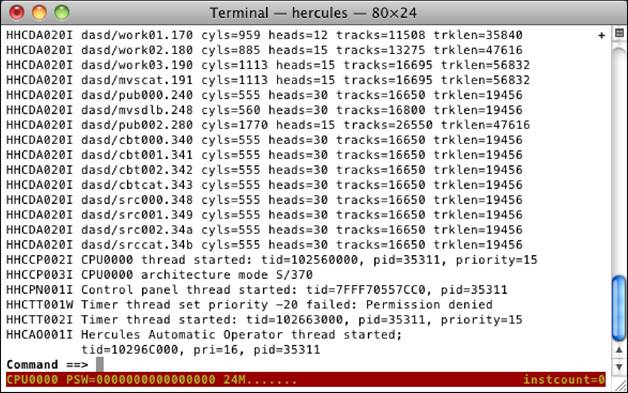 Figure 134:
Hercules Console Window
The next
figure shows the Hercules device and status display accessed with the Esc key.
Figure 134:
Hercules Console Window
The next
figure shows the Hercules device and status display accessed with the Esc key.

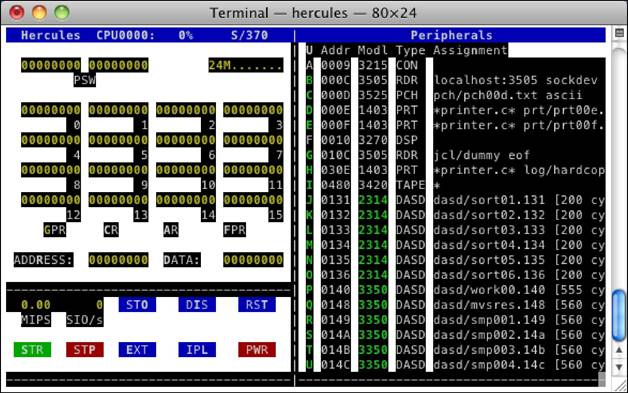 Figure 135:
Hercules Device and Status Display
The following figure shows the Hercules web browser interface that can
be accessed when the Hercules HTTP server is configured and running. This is
the only graphical user interface beneath the Hercules Studio GUI for Hercules
on Mac OS X today, but it is very useful to get access to the Hercules console.
Figure 135:
Hercules Device and Status Display
The following figure shows the Hercules web browser interface that can
be accessed when the Hercules HTTP server is configured and running. This is
the only graphical user interface beneath the Hercules Studio GUI for Hercules
on Mac OS X today, but it is very useful to get access to the Hercules console.

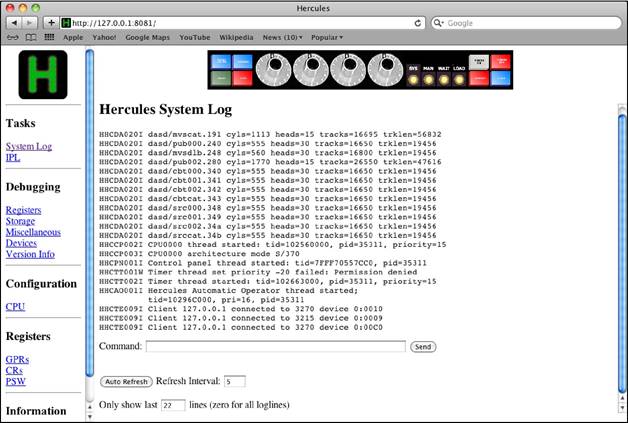 Figure 136:
Hercules Web Browser Interface
Optionally the Hercules Studio GUI is available. Hercules Studio
GUI is not part of the Hercules Emulator and it is necessary to build Hercules
yourself to support this GUI.
23.3.2 Tun/Tap Driver
You need a tunnel driver to provide networking from your Hercules
guest system. If you have not installed it already, then install a Tun/Tap
driver. Hercules can use this driver to provide networking functions to the
guest system running on the Hercules emulator.
The Tun/Tap driver from Mattias Nissler is shipped with the Hercules
Emulation installation disk images. The installation package<wrap>(</wrap><wrap>http:%%//%%downloads.sourceforge.net/tuntaposx/tuntap_20111101.tar.gz</wrap><wrap>)</wrap> should work with Mac OS X 10.6 (Snow
Leopard) and above. Older versions of the Tun/Tap Driver and the source code
are available also (see<wrap>
http:%%//%%sourceforge.net/projects/tuntaposx/files/</wrap><wrap>)</wrap>. Have also a look at the web site<wrap>
http:%%//%%tuntaposx.sourceforge.net</wrap><wrap>.</wrap>
Figure 136:
Hercules Web Browser Interface
Optionally the Hercules Studio GUI is available. Hercules Studio
GUI is not part of the Hercules Emulator and it is necessary to build Hercules
yourself to support this GUI.
23.3.2 Tun/Tap Driver
You need a tunnel driver to provide networking from your Hercules
guest system. If you have not installed it already, then install a Tun/Tap
driver. Hercules can use this driver to provide networking functions to the
guest system running on the Hercules emulator.
The Tun/Tap driver from Mattias Nissler is shipped with the Hercules
Emulation installation disk images. The installation package<wrap>(</wrap><wrap>http:%%//%%downloads.sourceforge.net/tuntaposx/tuntap_20111101.tar.gz</wrap><wrap>)</wrap> should work with Mac OS X 10.6 (Snow
Leopard) and above. Older versions of the Tun/Tap Driver and the source code
are available also (see<wrap>
http:%%//%%sourceforge.net/projects/tuntaposx/files/</wrap><wrap>)</wrap>. Have also a look at the web site<wrap>
http:%%//%%tuntaposx.sourceforge.net</wrap><wrap>.</wrap>
 23.4
Additional required and optional software
Additional
software to the components described above are also required for practical use
of Hercules (e.g. 3270 client) or makes common tasks easier (e.g. netcat,
submit).
23.4
Additional required and optional software
Additional
software to the components described above are also required for practical use
of Hercules (e.g. 3270 client) or makes common tasks easier (e.g. netcat,
submit).

23.4.1 3270
Client
You need a 3270 client to get access to guest systems like MVS 3.8
or VM 6.0 for System/370. For virtual 3270 consoles and 3270 terminals a 3270
client software application is required. The 3270 client can run on the same
machine as Hercules or on any other Mac OS X, iPhone, iPad, Linux or Windows
system with a TCP/IP connection to the system where Hercules is running.
One of the most common 3270 clients for Mac OS X is the Brown
TN3270 terminal emulation. The 3270 client is written and maintained by Peter
DiCamillo. Brown TN3270 terminal emulation is a freely available 3270 client
and can be obtained from<wrap>
http:%%//%%www.brown.edu/cis/tn3270/</wrap><wrap>.</wrap>
Mochasoft TN3270 for Mac OS X is a nice 3270 client for Mac OS X
too, but not freely available. Currently available is a free 30-day trial and
the single user license costs approximately 30 USD. Mochasoft TN3270 is
available for iPhone/iPad or Android, Blackberry and Windows Vista, Windows 7
or Windows 8 and some other platforms too. Mochasoft TN3270 can be downloaded
from the following web site: <wrap>http:%%//%%www.mochasoft.dk/tn3270macx.htm</wrap><wrap>.</wrap>
EMTec ZOC Terminal is a 3270 client for Mac OS X and Windows.
Currently available is a free 30-day trial and the single user license costs
approximately 80 USD. EMTec ZOC Terminal can be downloaded from web site<wrap> http:%%//%%www.emtec.com/zoc/index.html</wrap><wrap>.</wrap>
Suite 3270 is a nice and freely available 3270 client for BSD and
Unix, therefore usable for Mac OS X too. Build c3270, s3270 and pr3287 from the
available source code and you get a stable 3270 client and a 3287 printer. The
3270 client and 3287 printer is maintained by Paul Mattes. Suite 3270 can be
downloaded from web site<wrap></wrap><wrap>http:%%//%%sourceforge.net/projects/x3270/</wrap><wrap></wrap>or
installed with the MacPorts or Homebrew package management software.
Because the 3270 client is an independent
piece of software there are no version requirements. You can use any stable
release of a 3270 client although it is recommended to always run with a
current release.
Additional information can be found in the Hercules “General
Information” manual, chapter “TN3270 Client”.
23.4.2 Telnet Client
If you are interested in using Linux as a guest system a telnet
client is required to get access to. A telnet client and SSH client is part of
Mac OS X. The Brown TN3270 terminal emulation acts as a telnet client too.
23.4.3 Graphical User Interface
Hercules Studio GUI is an optional graphical user interface for
the Hercules Emulator. Up to version 3.07 is was necessary to build Hercules by
yourself to enable GUI support to use the Hercules Studio GUI. Beginning with
version 3.08 Hercules has enabled GUI support for all platforms by default.
Hercules Studio GUI is written and maintained by Jacob Dekel.
Have a look
at web site<wrap></wrap><wrap>http:%%//%%www.jacobdekel.com/hercstudio</wrap><wrap>.</wrap> Additional information can be found in the Hercules “General
Information” manual, chapter “Hercules Studio”.

 24. Installing the Hercules Emulator
24. Installing the Hercules Emulator
 24.1
Installation Preparation
Before we start to install the Hercules binaries and associated
software, a word needs to be said about security.
Although installing Hercules in a single-user Mac OS X system,
this does not mean to remove the necessity of defining a security environment for
it and it is recommended that the security environment is established in order
to better show how Hercules relates to the host operating environment.
To create
the security environment for Hercules, we will establish a new standard user
account “hercules” that will primarily be used for file ownership.
The created user can also be used to run the Hercules process.
24.1
Installation Preparation
Before we start to install the Hercules binaries and associated
software, a word needs to be said about security.
Although installing Hercules in a single-user Mac OS X system,
this does not mean to remove the necessity of defining a security environment for
it and it is recommended that the security environment is established in order
to better show how Hercules relates to the host operating environment.
To create
the security environment for Hercules, we will establish a new standard user
account “hercules” that will primarily be used for file ownership.
The created user can also be used to run the Hercules process.
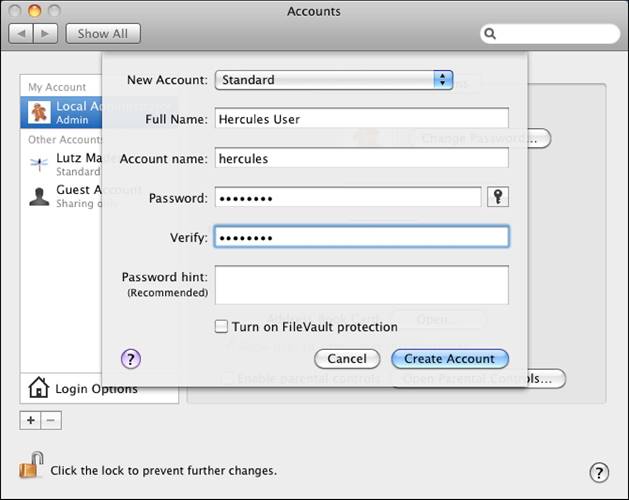 Figure 137:
Add Hercules account
To reflect
to the Hercules package installation file use “dseditgroup” to assign
the Hercules user to the “wheel” group as shown in the following
command:
Figure 137:
Add Hercules account
To reflect
to the Hercules package installation file use “dseditgroup” to assign
the Hercules user to the “wheel” group as shown in the following
command:

$ sudo dseditgroup -o edit -a hercules -t user wheel
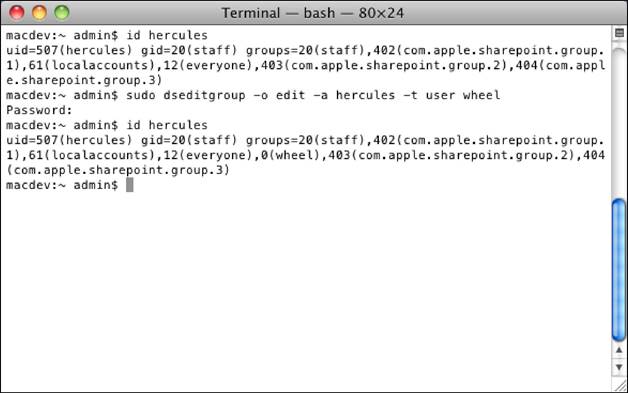 Figure 138:
Assign the wheel group
Read the chapter “Configuring
the Network Interface” to get more information about the Hercules network
interface.
Figure 138:
Assign the wheel group
Read the chapter “Configuring
the Network Interface” to get more information about the Hercules network
interface.
 24.2
Installation methods
There are two ways to install Hercules on Mac OS X and your choice
of method may depend on your version of Mac OS X and your attitude to the
Hercules software itself.
·Download and install the Hercules package from a disk image.
·Download the Hercules source code and build the binaries by
yourself.
If such a plug-and-play approach to software installation does not
suit you or you require greater flexibility when installing software packages,
the Hercules web site at<wrap></wrap><wrap>http:%%//%%www.hercules-390.eu</wrap><wrap></wrap>contains
packages for both binary and source code installation.
Both of the above techniques result in the
currently released stable version of the Hercules binaries being installed.
This is normally the best practice, so either of these two techniques is
normally recommended.
Some people
however, need the latest software being developed by the Hercules engineers and
more up-to-date packages can also be implemented.
24.2
Installation methods
There are two ways to install Hercules on Mac OS X and your choice
of method may depend on your version of Mac OS X and your attitude to the
Hercules software itself.
·Download and install the Hercules package from a disk image.
·Download the Hercules source code and build the binaries by
yourself.
If such a plug-and-play approach to software installation does not
suit you or you require greater flexibility when installing software packages,
the Hercules web site at<wrap></wrap><wrap>http:%%//%%www.hercules-390.eu</wrap><wrap></wrap>contains
packages for both binary and source code installation.
Both of the above techniques result in the
currently released stable version of the Hercules binaries being installed.
This is normally the best practice, so either of these two techniques is
normally recommended.
Some people
however, need the latest software being developed by the Hercules engineers and
more up-to-date packages can also be implemented.

 24.3
Software installation
This is the easiest and the preferred way to install Hercules on
Mac OS X.
Note: Unfortunately the available ready-to-run binaries are not
available at this time. As of writing this chapter the only way to install
Hercules on Mac OS X is building Hercules from source as described in chapter
24.4.1 “Building from Source”.
24.3.1 Downloading the Binaries
The ready-to-run binaries can be downloaded from web site<wrap></wrap><wrap>http:%%//%%www.hercules-390.eu</wrap><wrap>.</wrap> For Mac OS X users there are currently three installation disk images
available.
·Mac OS X 10.4 (Tiger) universal binary version, 32-bit Intel and
PowerPC (file hercules-v.rr-tiger.dmg).
·Mac OS X 10.5 (Leopard) universal binary version, 32- and 64-bit
Intel and PowerPC (file hercules-v.rr-leopard.dmg).
·Mac OS X 10.6 (Snow Leopard) universal binary version, 32- and
64-bit Intel (file hercules-v.rr-snowleopard.dmg).
“v.rr” in the filename specifies the version and release
of the Hercules Emulator.
There is no difference between these
installation packages in general, except of the supported Mac OS X. Which one
of these installation disk images is the right one for you depends on your Mac
OS X only.
The Hercules installation disk image for Mac OS X 10.6 should work
with Mac OS X 10.7 (Lion) and Mac OS X 10.8 (Mountain Lion) too. But do not
install the Tun/Tap driver contained in the Hercules installation disk image,
see chapter 25.1 “Installing the tun/tap driver” for more
information.
24.3.2 Installation Steps
To start
the installation dialog, open the Hercules installation disk image .dmg file
and double click the .pkg package file. Hercules itself, without a mainframe
operating system installed, uses approximately 12 MB of disk space of your
system disk “Macintosh HD”. A welcome window is presented first.
24.3
Software installation
This is the easiest and the preferred way to install Hercules on
Mac OS X.
Note: Unfortunately the available ready-to-run binaries are not
available at this time. As of writing this chapter the only way to install
Hercules on Mac OS X is building Hercules from source as described in chapter
24.4.1 “Building from Source”.
24.3.1 Downloading the Binaries
The ready-to-run binaries can be downloaded from web site<wrap></wrap><wrap>http:%%//%%www.hercules-390.eu</wrap><wrap>.</wrap> For Mac OS X users there are currently three installation disk images
available.
·Mac OS X 10.4 (Tiger) universal binary version, 32-bit Intel and
PowerPC (file hercules-v.rr-tiger.dmg).
·Mac OS X 10.5 (Leopard) universal binary version, 32- and 64-bit
Intel and PowerPC (file hercules-v.rr-leopard.dmg).
·Mac OS X 10.6 (Snow Leopard) universal binary version, 32- and
64-bit Intel (file hercules-v.rr-snowleopard.dmg).
“v.rr” in the filename specifies the version and release
of the Hercules Emulator.
There is no difference between these
installation packages in general, except of the supported Mac OS X. Which one
of these installation disk images is the right one for you depends on your Mac
OS X only.
The Hercules installation disk image for Mac OS X 10.6 should work
with Mac OS X 10.7 (Lion) and Mac OS X 10.8 (Mountain Lion) too. But do not
install the Tun/Tap driver contained in the Hercules installation disk image,
see chapter 25.1 “Installing the tun/tap driver” for more
information.
24.3.2 Installation Steps
To start
the installation dialog, open the Hercules installation disk image .dmg file
and double click the .pkg package file. Hercules itself, without a mainframe
operating system installed, uses approximately 12 MB of disk space of your
system disk “Macintosh HD”. A welcome window is presented first.


 |
|
|
|
|
|
|
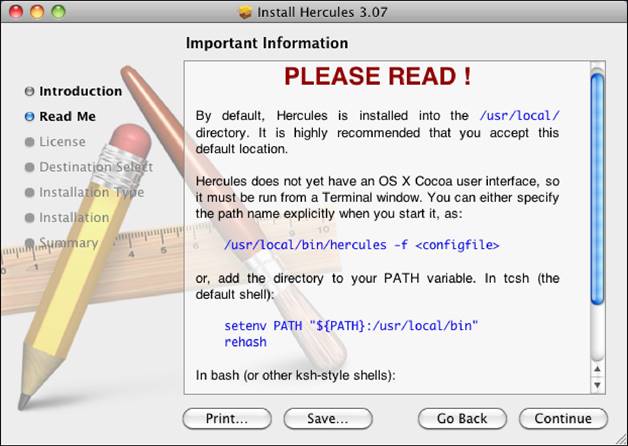 Figure 140:
Read Me Window
Read the
important information and click on “Continue” to continue the
installation process. If you are not familiar with Unix or BSD save the
information first, click on “Save…”.
Figure 140:
Read Me Window
Read the
important information and click on “Continue” to continue the
installation process. If you are not familiar with Unix or BSD save the
information first, click on “Save…”.

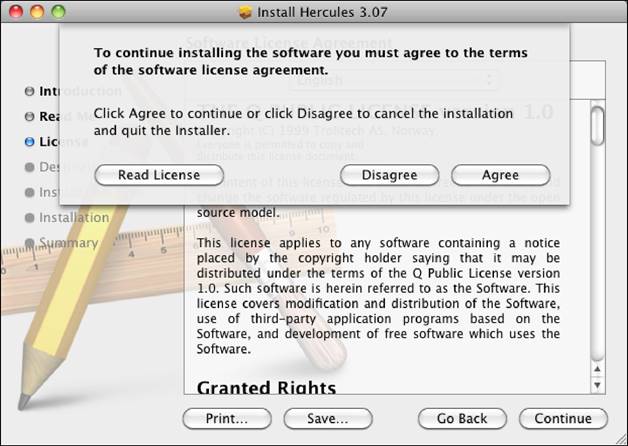 Figure 141:
License Window
Read the
licence agreement and click on “Continue”, then click on
“Agree” to accept the licence agreement and to continue the
installation process.
Figure 141:
License Window
Read the
licence agreement and click on “Continue”, then click on
“Agree” to accept the licence agreement and to continue the
installation process.


 |
|
|
|
|
















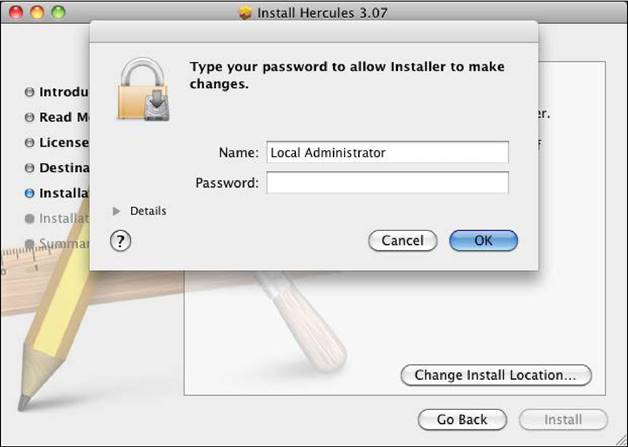 Figure 143:
Installation Type Window
Click on “Install” to continue the installation process and
then enter the name for an administrator and the password and click
“OK” to perform the standard installation process. You cannot select
the installation destination at this time. The installer now begins to copy
files to the system disk “Macintosh HD”.
Figure 143:
Installation Type Window
Click on “Install” to continue the installation process and
then enter the name for an administrator and the password and click
“OK” to perform the standard installation process. You cannot select
the installation destination at this time. The installer now begins to copy
files to the system disk “Macintosh HD”.

 |
|
|
|
|
|
|
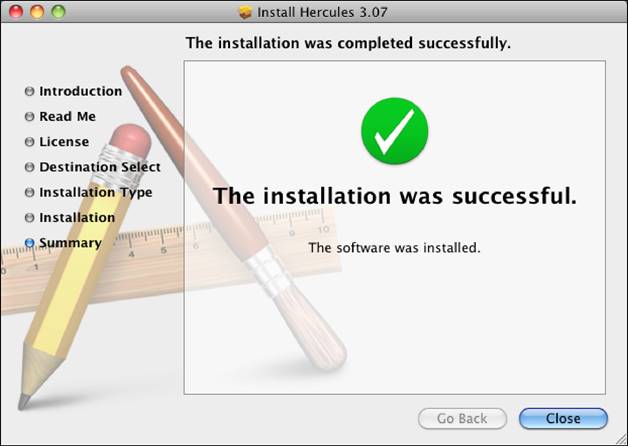 Figure 145:
Summary Window
Click on “Close” to terminate the installation process
and proceed to customise your installation as described in the following
sections. You can skip to chapter 26 “Customization steps” or to
chapter 27 “Installation Verification Procedure” to continue.
If you need
the tunnel driver or link layer driver to provide networking from your Hercules
guest system and have not installed it already, a tun/tap driver is in the
tuntap folder. Hercules can use this driver to provide networking functions to
the guest system running on the emulator. Read chapter 25.1 “Installing
the tun/tap driver” to get more information about the installation package
in the tuntap folder.
Figure 145:
Summary Window
Click on “Close” to terminate the installation process
and proceed to customise your installation as described in the following
sections. You can skip to chapter 26 “Customization steps” or to
chapter 27 “Installation Verification Procedure” to continue.
If you need
the tunnel driver or link layer driver to provide networking from your Hercules
guest system and have not installed it already, a tun/tap driver is in the
tuntap folder. Hercules can use this driver to provide networking functions to
the guest system running on the emulator. Read chapter 25.1 “Installing
the tun/tap driver” to get more information about the installation package
in the tuntap folder.
 24.4
Building from Source
The second installation option is to build the Hercules binaries
from the available source distribution. Despite the extra effort involved, this
method has a significant advantage over the more automated installation
options.
The
configure and build process allows the installer to specify a number of
configuration and optimization flags to control how the binaries are built.
Configuration
options can provide a mechanism to control where the Hercules binaries are
installed. This can be used to easily integrate one of the daily snapshots of
the Hercules source code available from Dave Wades build site (see next
chapter).
24.4
Building from Source
The second installation option is to build the Hercules binaries
from the available source distribution. Despite the extra effort involved, this
method has a significant advantage over the more automated installation
options.
The
configure and build process allows the installer to specify a number of
configuration and optimization flags to control how the binaries are built.
Configuration
options can provide a mechanism to control where the Hercules binaries are
installed. This can be used to easily integrate one of the daily snapshots of
the Hercules source code available from Dave Wades build site (see next
chapter).

Optimization options can build the binaries in such a way that
they better exploit the hardware on which they run. Finally, this is the only
method I assume a true dyed-in-the-wool system programmer would sanction!
24.4.1 Downloading the Source
The source code can be downloaded from the Hercules web site<wrap>(</wrap><wrap>http:%%//%%www.hercules-390.eu</wrap><wrap>)</wrap>. The file is named
“hercules-v.rr.tar.gz”, where the “v.rr” in the filename specifies
the version and release of the Hercules Emulator
The developers source code snapshots, that are updated daily
whenever the source code changed, are available from Dave Wades website at<wrap>http:%%//%%www.smrcc.org.uk/members/g4ugm/snapshots/</wrap><wrap>.</wrap> Read the
“README.SVN” file included with the source code for additional and
updated instructions to build a development version.
To unpack the source code archive file double click the .tar.gz
archive file. This will extract all the required files into a new folder in the
current folder location that should have the name “hercules-v.rr”,
the name of the source package file without the suffixes, where
“v.rr” specifies the version and release.
Open the new folder and drop “README.OSX” to the
TextEdit application to get the updated additional how-to build information.
You are welcome to the undiscovered country, now we enter the
environment a Mac OS X user has never seen before, welcome home BSD and Unix
user.
Note: Before Apple came up with the user-friendly term folder to
represent a holding tank for files, folders were called directories. This means
the same thing; in this part you'll encounter the term folder exclusively. In
any discussion of Unix and BSD, “directory” is simply the correct
term.
Open the
Terminal application, located in the Utilities folder (which is within the
Applications folder at the root level of your system disk “Macintosh
HD”). You are inside your Mac OS X now.The Terminal application is the
doorway to the BSD.

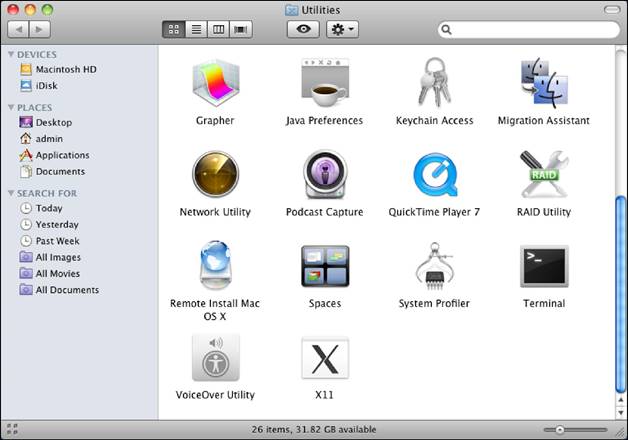 Figure 146: Utilities Folder
Enter
“cd ” (cd with a trailing blank), switch to your previous download
folder, select the new folder and drop the folder to the Terminal. Select the
Terminal window and press the Enter key, to change into the folder with the
extracted source code.
Figure 146: Utilities Folder
Enter
“cd ” (cd with a trailing blank), switch to your previous download
folder, select the new folder and drop the folder to the Terminal. Select the
Terminal window and press the Enter key, to change into the folder with the
extracted source code.

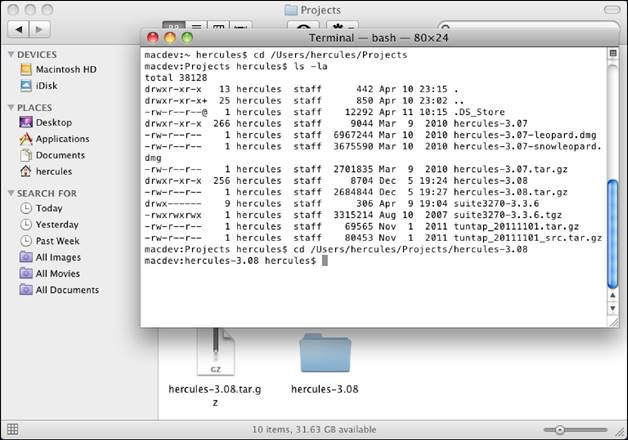 Figure 147: Project Folder
24.4.2 Verify the Environment
Issue the
following command to verify you have all of the correct versions of all of the
required packages installed now:
$ ./util/bldlvlck
Until
Hercules 3.07 issue the following command.
$ ./util/cvslvlck
Figure 147: Project Folder
24.4.2 Verify the Environment
Issue the
following command to verify you have all of the correct versions of all of the
required packages installed now:
$ ./util/bldlvlck
Until
Hercules 3.07 issue the following command.
$ ./util/cvslvlck

|
|
|
|
A fl (3 Terminal — bash — 80×24
 macdev:-.
hercules$ cd /Users/hercules/Projects/hercules-3.08 macdev:hercules-3.08
hercules$ ./util/bldlvlck
This
utility will check the level of various utilities needed to build hercules.
Checking is done against versions that are KNOWN to work. This doesn't mean a
build will NOT succeed with older versions
macdev:-.
hercules$ cd /Users/hercules/Projects/hercules-3.08 macdev:hercules-3.08
hercules$ ./util/bldlvlck
This
utility will check the level of various utilities needed to build hercules.
Checking is done against versions that are KNOWN to work. This doesn't mean a
build will NOT succeed with older versions
 |
|
of the utilities, but will give a hint as to what package may need an upgrade if the build ever fails with some odd reason.
OK svn requires 0, found 1.6.17
||| | |
OK
|
autoconf requires
|
2.5,
|
found 2.61
| |
OK
|
automake requires
|
1.9,
|
found 1.10
| |
OK
|
flex requires 2.5,
|
found 2.5.35
| |
INSTALL gawk not found
URL: <wrap>http:%%//%%www.gnu.org/dtrectory/gawk.html</wrap>
OK gcc requires 2.95, found 4.2.1
INSTALL gettext not found
URL: <wrap>http:%%//%%www.gnu.org/dtrectory/gettext.html</wrap>
Figure 148:
Verify the packages







 Figure 149:
Find missing packages
Figure 149:
Find missing packages

In general
everything looks fine with Mac OS X. If not, install the updates to the system
to complete the prerequisites to configure and build the binaries. Do not
install or update the “gawk” or “perl” package, a
“gettext” and “sed” update is not necessary too.
Updates are available from the GNU Project (a Free Software
Foundation project), have a look at the GNU Project web site<wrap> http:%%//%%www.gnu.org</wrap><wrap>.</wrap>
The updates
are installed in the same manner like Hercules, as usual for GNU packages.
$ ./configure –prefix=/usr/local
$ make
$ sudo make install
Note: Do not install updates to a Mac OS X directory or replace a Mac OS
X library.
On the other hand MacPorts and Homebrew are nice tools to keep
your Mac OS X up-to-date too. To get more information how to do this, keep a
closer look at the MacPorts web site<wrap></wrap><wrap>http:%%//%%www.macports.org</wrap> or the Homebrew web site<wrap> http:%%//%%mxcl.github.com/homebrew/</wrap><wrap>.</wrap>
24.4.3 The Build Process
Issue the
following command to configure Hercules for your system.
$ ./configure –enable-setuid-hercifc=yes
By default,
the configure script will attempt to guess appropriate compiler optimization
flags for your system. If its guesses turn out to be wrong, you can disable
all optimization by passing the “–disable-optimization” option to configure or
specify your own optimization flags with the “–enable-optimization” option.
For additional configuration options, run “./configure –help”
Do not use “—prefix” with “/usr”, this is a Mac OS X directory,
use “/usr/local” instead (this is the default option).
Note: In the following examples “./configure –disable-nls
–enable-setuid-hercifc” or “./configure –disable-nls –enable-setuid-hercifc
–enable-optimization=”-O3 -fomit-frame-pointer“” have been used to
configure Hercules for a Mac OS X system on a PPC PowerBook and a Intel MacBook
or MacMini.
Use
“./configure with –enable-external-gui” to make GUI support available for
applications like Hercules Studio GUI.

|
|
|
|
A fl Terminal — bash — 80×24
 macdev:hercules-3.08 hercules$ ./configure –disable-nts
–enable-setuid-hercifc
–enable—external—gui
checking for a BSD-compatible install…
/usr/bin/install -c
checking whether build environment is
sane… yes
checking for a thread-safe mkdir —p…
autoconf/install—sh —c —d
checking for gawk… no
checking for mawk… no
checking for nawk… no
checking for awk… awk
checking whether make sets $(MAKE)… yes
checking whether to enable
maintainer—specific portions of Makefiles… no
checking build system type…
x86_64-apple-darwin10.8.0
checking host system type…
x86_64-apple-darwin10.8.0
checking for gcc… gcc
checking whether the C compiler works…
yes
checking for C compiler default output file
name… a.out
checking for suffix of executables…
checking whether we are cross compiling…
no
checking for suffix of object files… o
checking whether we are using the GNU C
compiler… yes
checking whether gcc accepts —g… yes
checking for gcc option to accept ISO C89… none needed •
checking for style of include used by make… GNU •
checking dependency style of gcc… gcc3
Figure
150: Configure the install process
|
macdev:hercules-3.08 hercules$ ./configure –disable-nts
–enable-setuid-hercifc
–enable—external—gui
checking for a BSD-compatible install…
/usr/bin/install -c
checking whether build environment is
sane… yes
checking for a thread-safe mkdir —p…
autoconf/install—sh —c —d
checking for gawk… no
checking for mawk… no
checking for nawk… no
checking for awk… awk
checking whether make sets $(MAKE)… yes
checking whether to enable
maintainer—specific portions of Makefiles… no
checking build system type…
x86_64-apple-darwin10.8.0
checking host system type…
x86_64-apple-darwin10.8.0
checking for gcc… gcc
checking whether the C compiler works…
yes
checking for C compiler default output file
name… a.out
checking for suffix of executables…
checking whether we are cross compiling…
no
checking for suffix of object files… o
checking whether we are using the GNU C
compiler… yes
checking whether gcc accepts —g… yes
checking for gcc option to accept ISO C89… none needed •
checking for style of include used by make… GNU •
checking dependency style of gcc… gcc3
Figure
150: Configure the install process
|
Terminal — bash — 80×24
fiaci.
|
-ON-
|
B
—
| |
Li
configure:
|
| |
configure: Package destination directory prefixes:
|
|
| |
configure:
|
|
| |
configure: Libraries: /usr/local/lib/hercules
configure: Data: /usr/local/share/hercules
configure: Locale: /usr/local/share/locale
configure:
|
|
| |
configure: creating ./config.status
config.status: creating Makefile
config.status: creating util/Makefile
config.status: creating html/Makefile
config.status: creating crypto/Makefile
config.status: creating po/Makefile. in
config.status: creating po/Makefile
config.status: creating man/Makefile
config.status: creating m4/Makefile
config.status: creating decNumber/Makefile
config.status: creating
config.h
config.status: executing depfiles commands
config.status: executing default-1 commands
config.status: creating po/P0TFILES
config.status: creating po/Makefile
macdev:hercules-3.08 hercules$ I
|
|
ID
•
•
_
|
Figure
151: Create the makefiles

If everything works well, the
“configure” command ends with creating a lot of Makefile files and
the corresponding messages.
Now issue
the following command to build the executables.
$ make
Some
minutes later, the “make” command should complete, without error
messages similar to those shown in this snippet, some warning messages are
normal.
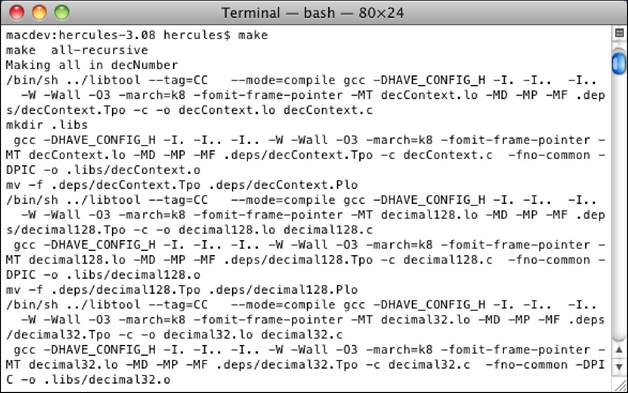 Figure 152:
Make the executables
The final step of the build process is to link the compiled object
files into their binary forms and install them into our target directory.
Issue the
following command to install the executables.
$ sudo make install
We will run
the “make install” command under root authority so that we can be
sure that any required folder can be created. The command should finish
without error and the final messages will be similar to those shown in this
snippet. Switch to a user with local administrator authority first.
Figure 152:
Make the executables
The final step of the build process is to link the compiled object
files into their binary forms and install them into our target directory.
Issue the
following command to install the executables.
$ sudo make install
We will run
the “make install” command under root authority so that we can be
sure that any required folder can be created. The command should finish
without error and the final messages will be similar to those shown in this
snippet. Switch to a user with local administrator authority first.

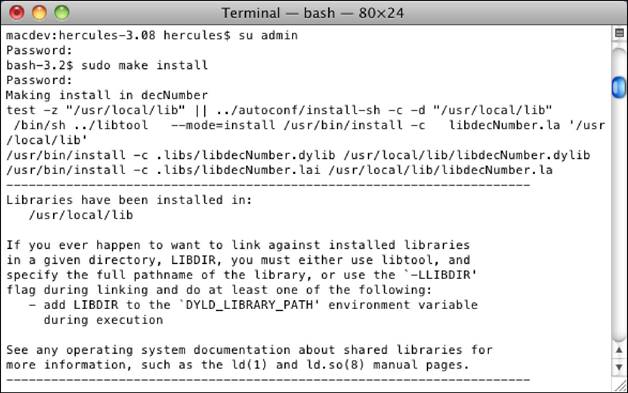 Figure 153:
Make install the executables
“hercifc”
get the appropriate attributes if you use configure with option
“–enable-setuid-hercifc”, see chapter 24.6 “Configuring the network
interface” for more information.
Figure 153:
Make install the executables
“hercifc”
get the appropriate attributes if you use configure with option
“–enable-setuid-hercifc”, see chapter 24.6 “Configuring the network
interface” for more information.

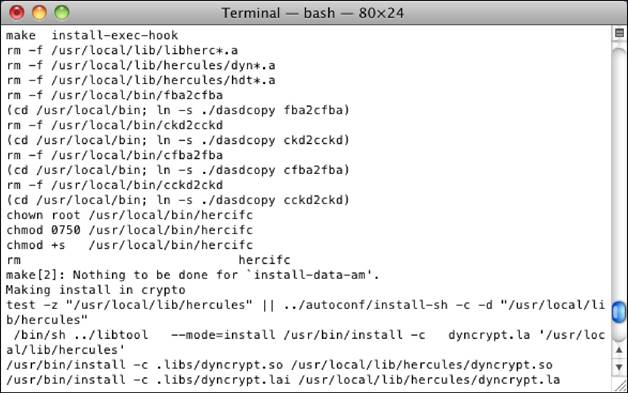 Figure 154:
Change the attributes
The Hercules binaries are now installed, so you can skip to
chapter 27 “Installation Verification Procedure” to continue.
By the way, the Hercules Emulator is available via the MacPorts
and Homebrew package management software too. Have a look at the MacPorts web
site<wrap></wrap><wrap>http:%%//%%www.macports.org</wrap><wrap></wrap>or the Homebrew web site to get a list of the available packages.
With the MacPorts Profile and the Homebrew Formula some dependent
libraries are installed too. But the configure option –enable-setuid-hercifc
is not used.
MacPorts
and Homebrew install packages to their own directory structure. MacPorts use
“/opt/local” by default, but unfortunately Homebrew sym links their files into
“/usr/local”. In general you can install your own stuff to “/usr/local” too,
but be aware that if you install some libraries and tools yourself, it may
cause some trouble when trying to build certain Homebrew Formula. As a result
the Homebrew Doctor will warn you about this.
Figure 154:
Change the attributes
The Hercules binaries are now installed, so you can skip to
chapter 27 “Installation Verification Procedure” to continue.
By the way, the Hercules Emulator is available via the MacPorts
and Homebrew package management software too. Have a look at the MacPorts web
site<wrap></wrap><wrap>http:%%//%%www.macports.org</wrap><wrap></wrap>or the Homebrew web site to get a list of the available packages.
With the MacPorts Profile and the Homebrew Formula some dependent
libraries are installed too. But the configure option –enable-setuid-hercifc
is not used.
MacPorts
and Homebrew install packages to their own directory structure. MacPorts use
“/opt/local” by default, but unfortunately Homebrew sym links their files into
“/usr/local”. In general you can install your own stuff to “/usr/local” too,
but be aware that if you install some libraries and tools yourself, it may
cause some trouble when trying to build certain Homebrew Formula. As a result
the Homebrew Doctor will warn you about this.
 24.5
Verifying the Hercules installation
To verify
the Hercules binaries installation open a new Terminal application and run the
following Hercules command to show the Hercules version.
$ hercules 2>&1 | grep
-i Version
24.5
Verifying the Hercules installation
To verify
the Hercules binaries installation open a new Terminal application and run the
following Hercules command to show the Hercules version.
$ hercules 2>&1 | grep
-i Version

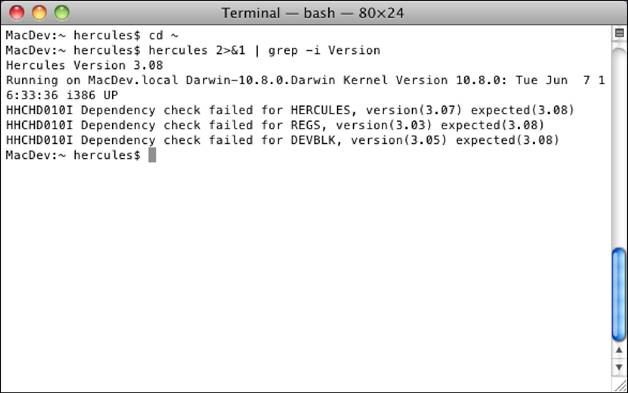 Figure 155:
Display the Hercules version
The command, like all BSD or Unix commands, is case sensitive. It
starts the Hercules program and combines the two resulting output streams
together (“2>&1”) before piping that through a filter
(“grep”) searching for the text string “Version”. As a
result you get something like this:
Hercules Version v.rr
“v.rr” specifies the version and release of the Hercules
Emulator.
But, if you get some messages similar to the following, some old
libraries are not replaced correctly or another copy of Hercules was installed
in the past:
HHCHD010I Dependency check failed for
HERCULES, version(3.07) expected(3.08) HHCHD010I Dependency check failed for
REGS, version(3.03) expected(3.08) HHCHD010I Dependency check failed for
DEVBLK, version(3.05) expected(3.08)
Note: Check the
MODPATH path in your Hercules configuration file and have a look at the shell
environment variable “DYLD_LIBRARY_PATH”.
Figure 155:
Display the Hercules version
The command, like all BSD or Unix commands, is case sensitive. It
starts the Hercules program and combines the two resulting output streams
together (“2>&1”) before piping that through a filter
(“grep”) searching for the text string “Version”. As a
result you get something like this:
Hercules Version v.rr
“v.rr” specifies the version and release of the Hercules
Emulator.
But, if you get some messages similar to the following, some old
libraries are not replaced correctly or another copy of Hercules was installed
in the past:
HHCHD010I Dependency check failed for
HERCULES, version(3.07) expected(3.08) HHCHD010I Dependency check failed for
REGS, version(3.03) expected(3.08) HHCHD010I Dependency check failed for
DEVBLK, version(3.05) expected(3.08)
Note: Check the
MODPATH path in your Hercules configuration file and have a look at the shell
environment variable “DYLD_LIBRARY_PATH”.
 24.6
Configuring the network interface
Once the
Hercules binaries have been installed and verified, the following additional
tasks should be completed before starting to configure your new Hercules
environment.
24.6
Configuring the network interface
Once the
Hercules binaries have been installed and verified, the following additional
tasks should be completed before starting to configure your new Hercules
environment.

In order to
support IP routing to a Hercules Guest system, a network tunnel is created
using the native Mac OS X “tunx” device. This device simulates a
network layer 3 device and routes IP packets between the Mac OS X operating
system and Hercules.
The definition of a 3088 CTC device in the Hercules configuration
file will make Hercules call a special program specifically to start and
configure the “tunx” device.
Alternatively a network link layer device is created using the
native Mac OS X “tapx” device. This device simulates a network layer
2 device and routes ethernet frames between the Mac OS X operating system and
Hercules.
The definition of a 3172 / OSA LCS device in the Hercules
configuration file will make Hercules call a special program specifically to
start and configure the “tapx” device too.
The tunnelling device (tunx) or link layer device (tapx) is not
active (as a configurable device object) until it is opened by Hercules.
The program to start and configure is called “hercifc”
and is installed as part of the Hercules binaries. As we are not running
Hercules with root authority and this network device program will require root
authority to issue system calls, we need to run some additional commands to
allow it to work correctly.
Note: If you use option –enable-setuid-hercifc with “yes”,
configure adds the necessary commands to do this to the make install process.
You can use a group name instead of “yes” to change the group.
Issue the
following commands in the Terminal application window.
Change to the directory containing the “hercifc” program.
$ cd /usr/local/bin
List the
current attributes of the hercifc program.
$ ls -la hercifc
Use
“sudo” to change the ownership of the “hercifc” program to
user “root” and group “admin”.
$ sudo chown root:admin hercifc
Use
“sudo” to change the attributes of the “hercifc” program to
be setuid to the owner (“root”) and executable only by root and the
“admin” group. Switch to a user with local administrator authority
first.
$ sudo chmod 6750 hercifc

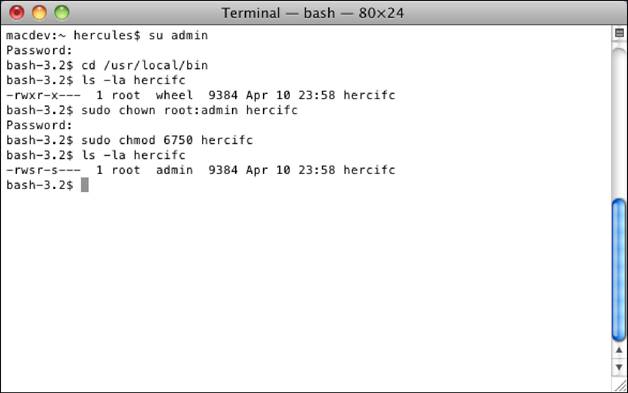 Figure 156:
Configure the Network Interface
The result of these commands is to allow the “hercifc”
program to execute with root authority (that is what the chmod command above
does) but restrict the execution of the program only to the file owner (user
“root”) and any user connected to the “admin” group.
This will allow the tunnelling device to open and configure
correctly when initiated by user “hercules” but reduce the security
exposure of having a program setuid-to-root to the minimum.
Note: We should use the Administrators Group “admin” or the System
Group “wheel”. On the other hand, with the Users Group
“staff” everyone is authorised to open the tunnelling device.
Finally use
“dseditgroup” to assign the Hercules user to the corresponding group.
$ sudo dseditgroup -o edit -a hercules -t user admin
Otherwise,
you can define the Hercules user as a local administrator.
To reflect
to the Hercules package file use “dseditgroup” to assign the Hercules
user to the “wheel” group. This is the preferred way.
$ sudo dseditgroup -o edit -a hercules -t user wheel
Figure 156:
Configure the Network Interface
The result of these commands is to allow the “hercifc”
program to execute with root authority (that is what the chmod command above
does) but restrict the execution of the program only to the file owner (user
“root”) and any user connected to the “admin” group.
This will allow the tunnelling device to open and configure
correctly when initiated by user “hercules” but reduce the security
exposure of having a program setuid-to-root to the minimum.
Note: We should use the Administrators Group “admin” or the System
Group “wheel”. On the other hand, with the Users Group
“staff” everyone is authorised to open the tunnelling device.
Finally use
“dseditgroup” to assign the Hercules user to the corresponding group.
$ sudo dseditgroup -o edit -a hercules -t user admin
Otherwise,
you can define the Hercules user as a local administrator.
To reflect
to the Hercules package file use “dseditgroup” to assign the Hercules
user to the “wheel” group. This is the preferred way.
$ sudo dseditgroup -o edit -a hercules -t user wheel

|
|
|
|






 25. Installing additional software
25. Installing additional software
 25.1
Installing the tun/tap driver
You need
the Tun/Tap driver to provide networking from your Hercules Guest system.
25.1.1 Downloading the binaries
The ready-to-run binaries can be downloaded from<wrap></wrap><wrap>http:%%//%%tuntaposx.sourceforge.net</wrap><wrap>.</wrap> For Mac OS X users there is currently one installation disk image
available.
The installation package<wrap>(</wrap><wrap>http:%%//%%downloads.sourceforge.net/tuntaposx/tuntap_20111101.tar.gz</wrap><wrap>)</wrap> should work with 10.6 (Snow Leopard) and
above. The source code to build the Tun/Tap driver is also available.
The Hercules installation disk images contain an older Tun/Tap
Driver installation package.
25.1.2 Installation steps
To start
the installation dialog, unpack the “.tar.gz” archive file and double click the
“.pkg” package file. As an alternative you can open the Hercules installation
disk image “.dmg” file again and switch to the tuntap folder and double click
the “.pkg” package file. Tun/Tap use less than 1 MB of disk space of your
system disk “Macintosh HD”. First a welcome window is presented.
25.1
Installing the tun/tap driver
You need
the Tun/Tap driver to provide networking from your Hercules Guest system.
25.1.1 Downloading the binaries
The ready-to-run binaries can be downloaded from<wrap></wrap><wrap>http:%%//%%tuntaposx.sourceforge.net</wrap><wrap>.</wrap> For Mac OS X users there is currently one installation disk image
available.
The installation package<wrap>(</wrap><wrap>http:%%//%%downloads.sourceforge.net/tuntaposx/tuntap_20111101.tar.gz</wrap><wrap>)</wrap> should work with 10.6 (Snow Leopard) and
above. The source code to build the Tun/Tap driver is also available.
The Hercules installation disk images contain an older Tun/Tap
Driver installation package.
25.1.2 Installation steps
To start
the installation dialog, unpack the “.tar.gz” archive file and double click the
“.pkg” package file. As an alternative you can open the Hercules installation
disk image “.dmg” file again and switch to the tuntap folder and double click
the “.pkg” package file. Tun/Tap use less than 1 MB of disk space of your
system disk “Macintosh HD”. First a welcome window is presented.

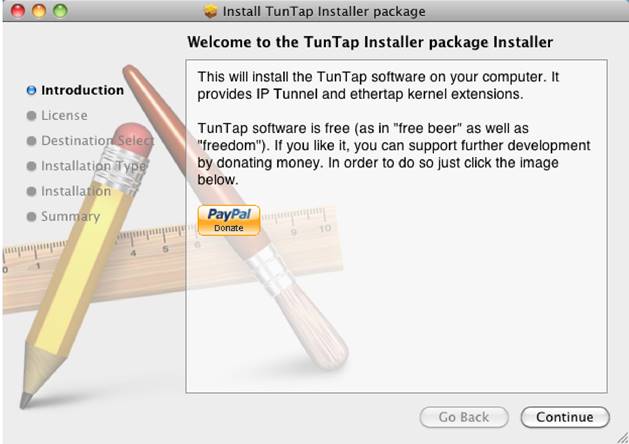 Figure 158:
Tun/Tap welcome window
Click on “Continue” twice to continue the installation
process then click “Agree” to accept the licence agreement.
Click to “Install” and then enter
the name for an administrator and the password and click “OK” to
perform the standard installation process. The installer now begins to copy
files to the system disk “Macintosh HD”.
After a few seconds the installation process will finish and
present the final window. Click on “Close” to terminate the
installation process.
25.1.3 IP Forwarding
You may or may not need to have “IP Forwarding” enabled
on your Mac OS X system. To allow your Hercules guest operating system to
communicate with hosts on the LAN apart from the host machine itself (where
Hercules is running), TCP/IP requires routes to and from the Hercules Guest
operating system.
This is necessary so that the Hercules Guest packets can be
properly routed to their final destination. This is typically the role
performed by a hardware router. If you do not use a hardware router then Mac OS
X “IP Forwarding”, together with appropriate route statements, will
perform this role.
Add the
following to the “mvs38.csh” start-up script before the Hercules
command, see “Shell start-up script”.
Figure 158:
Tun/Tap welcome window
Click on “Continue” twice to continue the installation
process then click “Agree” to accept the licence agreement.
Click to “Install” and then enter
the name for an administrator and the password and click “OK” to
perform the standard installation process. The installer now begins to copy
files to the system disk “Macintosh HD”.
After a few seconds the installation process will finish and
present the final window. Click on “Close” to terminate the
installation process.
25.1.3 IP Forwarding
You may or may not need to have “IP Forwarding” enabled
on your Mac OS X system. To allow your Hercules guest operating system to
communicate with hosts on the LAN apart from the host machine itself (where
Hercules is running), TCP/IP requires routes to and from the Hercules Guest
operating system.
This is necessary so that the Hercules Guest packets can be
properly routed to their final destination. This is typically the role
performed by a hardware router. If you do not use a hardware router then Mac OS
X “IP Forwarding”, together with appropriate route statements, will
perform this role.
Add the
following to the “mvs38.csh” start-up script before the Hercules
command, see “Shell start-up script”.

#
ifconfig en0 alias 192.168.200.254
#
sysctl -w net.inet.ip.forwarding=1
#
# ifconfig tun0 192.168.200.254 192.168.200.20
netmask 255.255.255.0
# ifconfig tun0 up
# ifconfig tap0 192.168.201.0 netmask 255.255.255.0
# ifconfig tap0 up
(sleep 5; route add -net 192.168.201.0 -interface
tap0 &» log/start.log) &
#
Note: Use
“sudo” to start the start-up script.
25.1.4 Configuring Hercules
Two IP
addresses must be assigned, one for the Hercules end of the link and another
for the guest system end of the link. Add the following to your configuration
file.
#
# CTCI Device
0400.2 CTCI -n /dev/tun0 -s 255.255.255.255
192.168.200.20 192.168.200.254
#
# OSA Devices
0440.2 LCS -n /dev/tap0 192.168.201.20
#
The first
IP addresses (192.168.200.20 and 192.168.201.20) are the IP addresses of your
Hercules guest system, the operating system running under Hercules. The second
IP address (192.168.200.254) itself identifies the host machine (where Hercules
is running).
Read the “README.NETWORKING” file included with the
source code for additional and updated instructions to networking.
Note: The name of the virtual interfaces cannot be left unspecified in
Mac OS X. The driver would not pick a name by trying to allocate the next free
device of that kind. Consider a virtual interface cannot be used twice!
Details of
the configuration file are found in the Hercules “User Reference
Guide”.

 25.2
Installing the 3270 client
You need a 3270 client to get access to guest systems that are
running guest operating systems like MVS 3.8, VM 6.0 or any other classic
mainframe System/370 guest system.
25.2.1 Downloading the binaries
The ready-to-run binaries for the Brown TN3270 Terminal Emulation
tn3270 X can be downloaded from <wrap>http:%%//%%www.brown.edu/cis/tn3270/</wrap><wrap>.</wrap> For Mac OS X users there
are currently some installation disk images available.
The installation package (see<wrap>
http:%%//%%www.brown.edu/cis/tn3270/tn3270_X_3.2.4.dmg</wrap><wrap>)</wrap> should
work with Mac OS X 10.6 (Snow Leopard) and below, the newer installation
package (see <wrap>http:%%//%%www.brown.edu/cis/tn3270/tn3270_X_3.3b6-cs.dmg</wrap><wrap>)</wrap> should
work with Mac OS X 10.6 (Snow Leopard) and above.
25.2.2 Installation steps
Open the Applications folder at the root level of your hard drive
and create a new folder named “TN3270 X”. Then open the disk image
and copy the tn3270 X application and the other files and folder to the new
folder in the Application folder.
tn3270 X
uses 6 MB of disk space of your system disk “Macintosh HD” or any
other disk where you copy the tn3270 X application.
25.2
Installing the 3270 client
You need a 3270 client to get access to guest systems that are
running guest operating systems like MVS 3.8, VM 6.0 or any other classic
mainframe System/370 guest system.
25.2.1 Downloading the binaries
The ready-to-run binaries for the Brown TN3270 Terminal Emulation
tn3270 X can be downloaded from <wrap>http:%%//%%www.brown.edu/cis/tn3270/</wrap><wrap>.</wrap> For Mac OS X users there
are currently some installation disk images available.
The installation package (see<wrap>
http:%%//%%www.brown.edu/cis/tn3270/tn3270_X_3.2.4.dmg</wrap><wrap>)</wrap> should
work with Mac OS X 10.6 (Snow Leopard) and below, the newer installation
package (see <wrap>http:%%//%%www.brown.edu/cis/tn3270/tn3270_X_3.3b6-cs.dmg</wrap><wrap>)</wrap> should
work with Mac OS X 10.6 (Snow Leopard) and above.
25.2.2 Installation steps
Open the Applications folder at the root level of your hard drive
and create a new folder named “TN3270 X”. Then open the disk image
and copy the tn3270 X application and the other files and folder to the new
folder in the Application folder.
tn3270 X
uses 6 MB of disk space of your system disk “Macintosh HD” or any
other disk where you copy the tn3270 X application.



25.2.3
Customization steps
There is
one setting that must be changed to use the terminal emulation with some
operating systems, especially for MVS 3.8 for System/370. The first time open a
connection to Hercules before IPL’ing the system, go to the “Session”,
“Features” menu and set “Change embedded nulls to blanks”
to “No”. Then click on “OK”. Now click on “File”,
“Save default settings…” to make the settings permanent.
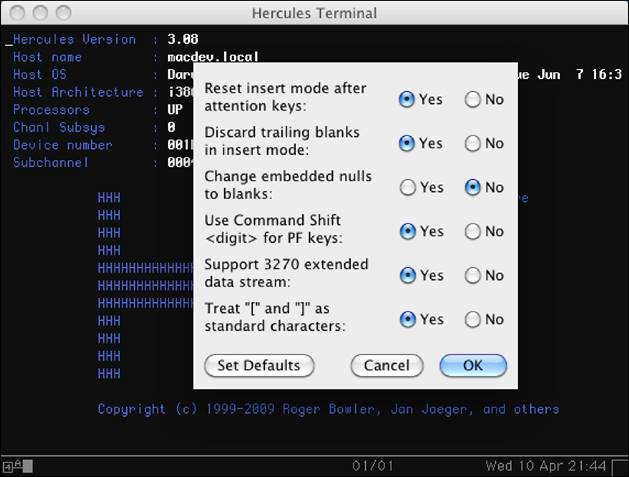 Figure 160:
TN3270 X terminal settings
Unfortunately the 3270 Client tn3270 X was shipped with a limited
set of keyboard mappings. In the tn3270 customization folder are some short
manuals available to give you some help to customize the tn3270 X application.
The
keyboard customization folder contains the built-in keyboard mappings and a
sample Austrian and German keyboard mapping. To add your preferred keyboard
mapping, modify one of the shipped built-in keyboard mapping files. Change the
“name:” operand to your own keyboard name otherwise you replace an
existing keyboard mapping.
Figure 160:
TN3270 X terminal settings
Unfortunately the 3270 Client tn3270 X was shipped with a limited
set of keyboard mappings. In the tn3270 customization folder are some short
manuals available to give you some help to customize the tn3270 X application.
The
keyboard customization folder contains the built-in keyboard mappings and a
sample Austrian and German keyboard mapping. To add your preferred keyboard
mapping, modify one of the shipped built-in keyboard mapping files. Change the
“name:” operand to your own keyboard name otherwise you replace an
existing keyboard mapping.

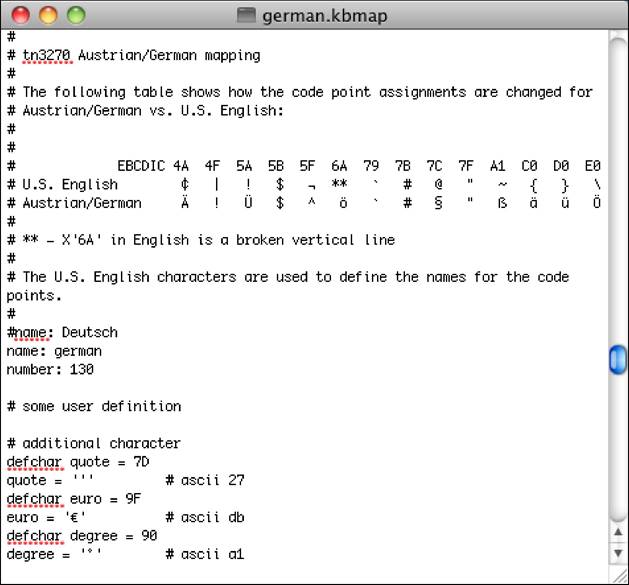 Figure 161:
German keyboard mapping
To get more information about the key codes used, start the KeyMap
application from the keyboard customization folder and enable “Display
Keystroke Information” in the “File” menu.
Choose “Open definition file” from the “File”
menu, and open your keyboard mapping file. Then choose “Write resource to
application package” from the “File” menu. When the standard
file dialog appears, choose the tn3270 X application to update.
Note: The
current version of the KeyMap application does not provide a method for deleting
keyboard mappings from tn3270 X, but adding and replacing keyboard mappings
will usually be sufficient.
25.2.4 Building from source
In order to
build a 3270 Client have a look at the web site<wrap></wrap><wrap>http:%%//%%sourceforge.net/projects/x3270/</wrap><wrap></wrap>where you get the Suite 3270 source code from. Download and unpack
the source code and build the c3270, s3270 and pr3287 in the same manner like
Hercules.
Figure 161:
German keyboard mapping
To get more information about the key codes used, start the KeyMap
application from the keyboard customization folder and enable “Display
Keystroke Information” in the “File” menu.
Choose “Open definition file” from the “File”
menu, and open your keyboard mapping file. Then choose “Write resource to
application package” from the “File” menu. When the standard
file dialog appears, choose the tn3270 X application to update.
Note: The
current version of the KeyMap application does not provide a method for deleting
keyboard mappings from tn3270 X, but adding and replacing keyboard mappings
will usually be sufficient.
25.2.4 Building from source
In order to
build a 3270 Client have a look at the web site<wrap></wrap><wrap>http:%%//%%sourceforge.net/projects/x3270/</wrap><wrap></wrap>where you get the Suite 3270 source code from. Download and unpack
the source code and build the c3270, s3270 and pr3287 in the same manner like
Hercules.

The used
Suite 3270 uses less than 2 MB of disk space of your system disk
“Macintosh HD”. Additional information is available from web site<wrap> http:%%//%%x3270.bgp.nu</wrap><wrap>.</wrap>
$ ./configure –without-readline –disable-nls –disable-dbcs
$ make
$ sudo make install
For additional configuration options, run “./configure –help”
Note: Do not install the commands into a Mac OS X directory, use
–prefix with “/usr/local” (this is also the default option).
If
everything works well, you can start the 3270 Client or the 3287 Printer from
the terminal application to verify the installation. It is assumed that
Hercules is already running.
$ c3270 localhost:3270
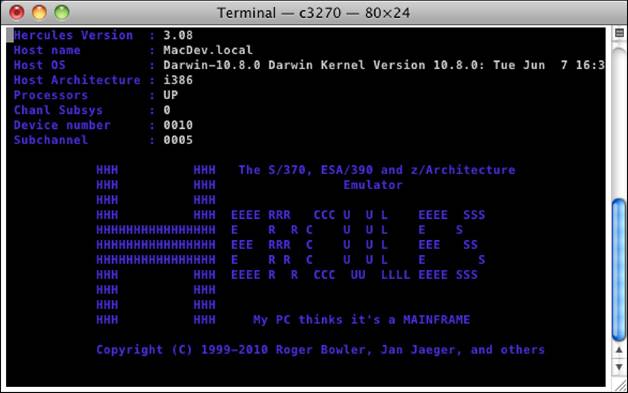 Figure 162:
C3270 terminal
MacPorts and Homebrew are not only nice tools to keep your Mac OS X
up-to-date, you can also install tools like the Suite 3270 with MacPorts or
Homebrew. To get more information how to use MacPorts or
Figure 162:
C3270 terminal
MacPorts and Homebrew are not only nice tools to keep your Mac OS X
up-to-date, you can also install tools like the Suite 3270 with MacPorts or
Homebrew. To get more information how to use MacPorts or

Homebrew,
keep a closer look at the MacPorts web site<wrap></wrap><wrap>http:%%//%%www.macports.org</wrap><wrap></wrap>or the Homebrew web site<wrap> http:%%//%%mxcl.github.com/homebrew/</wrap><wrap>.</wrap>
 25.3
Installing the Hercules Studio GUI
The Hercules Studio GUI provides a graphical user interface under
Mac OS X to the Hercules Emulator itself. Hercules itself has only a
semi-graphical user interface, the Hercules Studio GUI provides a full
graphical user interface.
You cannot use Hercules Studio GUI with the ready-to-run Hercules
Emulator binaries up to version 3.07. You must build the Hercules Emulator
yourself, see “Building from Source” to get more information. Beginning
with Hercules version 3.08 GUI support is built-in by default for all
platforms.
25.3.1 Downloading the binaries
The ready-to-run binaries can be downloaded from<wrap></wrap><wrap>http:%%//%%www.jacobdekel.com/hercstudio/</wrap><wrap>.</wrap> For Mac OS X users there is currently one installation disk image
available.
The installation package (see<wrap>
http:%%//%%www.jacobdekel.com/hercstudio/hercstudio-1.4.0-snowleopard.dmg</wrap><wrap>)</wrap>should work
with Mac OS X 10.6 (Snow Leopard) and above. The used Qt runtime libraries are
included now.
25.3.2 Installation steps
Open the applications folder at the root level of your hard drive.
Then open the disk image and copy the Hercules Studio application to the
application folder.
Hercules Studio GUI uses 38 MB of disk space of your system disk
“Macintosh HD” or any other disk where you copy the Hercules Studio
application to.
25.3.3 Running the Hercules Studio GUI
To start the Hercules Studio GUI start the Hercules Studio application.
If you install the Hercules Emulator to the default directory structure,
Hercules Studio GUI will become a graphical user interface for Hercules.
25.3
Installing the Hercules Studio GUI
The Hercules Studio GUI provides a graphical user interface under
Mac OS X to the Hercules Emulator itself. Hercules itself has only a
semi-graphical user interface, the Hercules Studio GUI provides a full
graphical user interface.
You cannot use Hercules Studio GUI with the ready-to-run Hercules
Emulator binaries up to version 3.07. You must build the Hercules Emulator
yourself, see “Building from Source” to get more information. Beginning
with Hercules version 3.08 GUI support is built-in by default for all
platforms.
25.3.1 Downloading the binaries
The ready-to-run binaries can be downloaded from<wrap></wrap><wrap>http:%%//%%www.jacobdekel.com/hercstudio/</wrap><wrap>.</wrap> For Mac OS X users there is currently one installation disk image
available.
The installation package (see<wrap>
http:%%//%%www.jacobdekel.com/hercstudio/hercstudio-1.4.0-snowleopard.dmg</wrap><wrap>)</wrap>should work
with Mac OS X 10.6 (Snow Leopard) and above. The used Qt runtime libraries are
included now.
25.3.2 Installation steps
Open the applications folder at the root level of your hard drive.
Then open the disk image and copy the Hercules Studio application to the
application folder.
Hercules Studio GUI uses 38 MB of disk space of your system disk
“Macintosh HD” or any other disk where you copy the Hercules Studio
application to.
25.3.3 Running the Hercules Studio GUI
To start the Hercules Studio GUI start the Hercules Studio application.
If you install the Hercules Emulator to the default directory structure,
Hercules Studio GUI will become a graphical user interface for Hercules.

/Users/Shared/Hercules/rnvs38.cnf - Hercules
Studio
|
Controls O
|| | |
|
La, n n n n
·• • • E –
|
|
| | | |
n,1,1-, ,VII VbCI CU/
fICILUIC,III”J0/ Lyob-OVO II
cO-Rb—.1.3J-IL II RIeIi-aJJac
Devices HHCDA020I
/Users/Shared/Hercules/mvs38/dasd/hasp00.152 cyls=404 heads=19 tracks=7676
trklen= 13312 Display Terminal.. HHCDA020I
/Users/Shared/Hercules/mvs38/dasd/page00.160 cyls=698 heads=12 tracks=8376
trklen=8704
·0010 HHCDAO2OI /Users/Shared/Hercules/mvs38/dasd/page01.161
cyls=698 heads=12 tracks=8376 trklen=8704
·0000 HHCDA0201/Users/Shared/Hercules/mys38/dasd/work01.170
cyls=959 heads=12 tracks=11508 trklen=35840
·00C1 HHCDA020I
/Users/Shared/Hercules/mvs38/dasd/work02.180 cyls=885 heads=15 tracks=13275 trklen=47616
·00C2 HHCDA020I
/Users/Shared/Hercules/mvs38/dasd/work03.190 cyls=1113 heads=15 tracks= 16695
trklen= 56832
·00C3 HHCDAO2OI
/Users/Shared/Hercules/mvs38/dasd/rnvscat.191 cyls=1113 heads=15 tracks= 16695
trklen=56832
·00C4 HHCDAO2OI /Users/Shared/Hercules/mvs38/dasd/pub000.240
cyls=555 heads=30 tracks= 16650 trklen= 19456
·0005 r HHCDAO2OI
/Users/Shared/Hercules/mvs38/dasd/rnvsdlb.248 cyls=560 heads=30 tracks=16800
trklen= 19456
·0006 HHCDAO2OI
/Users/Shared/Hercules/mvs38/dasd/pub002.280 cyls=1770 heads=15 tracks=26550
trklen=47616
·0007 HHCDAO2OI
/Users/Shared/Hercules/mvs38/dasd/cbt000.340 cyls=555 heads=30 tracks= 16650
trklen= 19456
·01C0 HHCDAO2OI
/Users/Shared/Hercules/mvs38/dasd/cbt001.341 cyls=555 heads=30 tracks= 16650
trklen= 19456
·01C1 HHCDAO2OI
/Users/Shared/Hercules/mvs38/dasd/cbt002.342 cyls=555 heads=30 tracks= 16650
trklen= 19456
·01C2 HHCDAO2OI
/Users/Shared/Hercules/mvs38/dasd/cbtcat.343 cyls=555 heads=30 tracks= 16650 trklen=
19456
·01C3 HHCDAO2OI
/Users/Shared/Hercules/mvs38/dasd/src000.348 cyls=555 heads=30 tracks= 16650
trklen= 19456
·01C4 HHCDAO2O1
JUsers/Shared/Hercules/mvs38/dasdisrc001.349 cyls=555 heads=30 tracks= 16650
trklen= 19456
·0105 HHCDAO2OI
/Users/Shared/Hercules/mvs38/dasd/src002.34a cyls=555 heads=30 tracks= 16650
trklen= 19456
·0106 HHCDA020I
/Users/Shared/Hercules/mvs38/dasd/srccat.34b cyls=555 heads=30 tracks= 16650
trklen= 19456
·01C7 HHCCP002I CPU0000 thread started:
tid=10235A000, pid=35491, priority=15
Consoles I HHCCP003I CPU0000 architecture mode S/370
·0009
I I . 20 failed: Permission denied
g!, Printers HHCTTOO2I Timer thread
started: tid=10245D000, pid=35491, priority=15
·000E 'printer.c' ,;- HHCDGO011 dyngui.dll
initiated
. HHCA0001I
Hercules Automatic Operator thread started:
tid=102766000,
pri =16, pid=35491
Command
 Figure 163: Hercules Studio GUI
Figure 163: Hercules Studio GUI

 26. Customization steps
After the
actual installation is completed there are some additional customization steps
required.
·Creating the Hercules guest folder.
·Creating the Hercules configuration file.
·Creating a Hercules guest start-up script.
·Creating a Hercules run-commands file.
·Creating a Hercules console link file.
These
manual customization steps are explained in a short form during the following
sections. The details are explained in the Hercules “User Reference
Guide”.
26. Customization steps
After the
actual installation is completed there are some additional customization steps
required.
·Creating the Hercules guest folder.
·Creating the Hercules configuration file.
·Creating a Hercules guest start-up script.
·Creating a Hercules run-commands file.
·Creating a Hercules console link file.
These
manual customization steps are explained in a short form during the following
sections. The details are explained in the Hercules “User Reference
Guide”.
 26.1
Creating the Hercules guest folder
We are going to create some script and configuration files and we
need to identify where we need to create them now. Additionally, we will need
to identify a location for our guest operating system, for example MVS 3.8 for
System/370.
Use a
completely separate directory for the Hercules Guest operating system.
|
26.1
Creating the Hercules guest folder
We are going to create some script and configuration files and we
need to identify where we need to create them now. Additionally, we will need
to identify a location for our guest operating system, for example MVS 3.8 for
System/370.
Use a
completely separate directory for the Hercules Guest operating system.
|
/Users/Hercules Hercules user home directory.
/Users/Shared/Hercules Guest operating system files.
/mvs38 Guest configuration file and the run-command script file.
/jcl JCL files
/dasd DASD files
/tape Tape files
/prt Printer files
/rdr Reader files
/pch Punch files
/log Log files
/tools Various tools
|
Figure 164:
Mac OS X Directory Structure Example
Note: Exclude the
guest operating system from Time Machine to prevent problems with your guest
and to save space on your backup media.
The Mac OS
X file system, in contrast to BSD or Unix file systems, is not case sensitive.

 26.2
Creating the Hercules configuration file
When starting the Hercules Emulator
from either the terminal application or via a launcher, you must specify the
name of a configuration file as a parameter.
$ Hercules –f filename
”filename“ is the name of the configuration file.
The default filename is “hercules.cnf” if none is specified during the
start-up.
The configuration file is an ASCII text file that is used to
describe the processor definition, the device layout and any runtime
parameters. Details can be found in the Hercules “User Reference Guide”.
Using the
directory structure example outlined before, we create this file in the
following folder.
/Users/Shared/Hercules/mvs38
26.2
Creating the Hercules configuration file
When starting the Hercules Emulator
from either the terminal application or via a launcher, you must specify the
name of a configuration file as a parameter.
$ Hercules –f filename
”filename“ is the name of the configuration file.
The default filename is “hercules.cnf” if none is specified during the
start-up.
The configuration file is an ASCII text file that is used to
describe the processor definition, the device layout and any runtime
parameters. Details can be found in the Hercules “User Reference Guide”.
Using the
directory structure example outlined before, we create this file in the
following folder.
/Users/Shared/Hercules/mvs38
 26.3
Creating a Hercules guest start-up script
Although the Hercules Emulator can be started manually from the
terminal application, it is often easier to establish a script file to do this.
The script file can be executed by running it from the shell or starting it
from the Finder.
Using the
directory structure example outlined before, we create these files in the
following folder.
/Users/Shared/Hercules
26.3
Creating a Hercules guest start-up script
Although the Hercules Emulator can be started manually from the
terminal application, it is often easier to establish a script file to do this.
The script file can be executed by running it from the shell or starting it
from the Finder.
Using the
directory structure example outlined before, we create these files in the
following folder.
/Users/Shared/Hercules

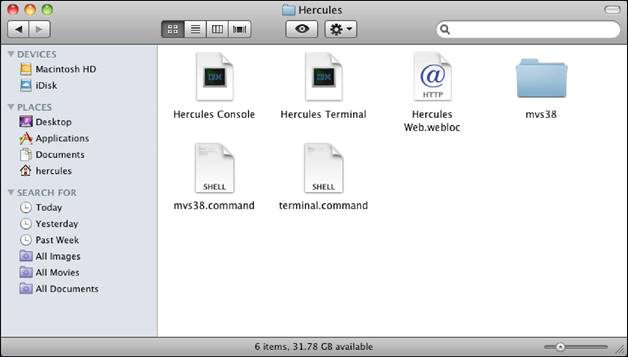 Figure 165:
The shared Hercules folder
26.3.1 Finder launcher script
We should
use the name “mvs38.command” for our Finder launcher script. The
following shows an example of a Hercules start-up script file. You should use
the TextEdit application or one of the installed editors (or “vi” if
you feel adventurous).
|
Figure 165:
The shared Hercules folder
26.3.1 Finder launcher script
We should
use the name “mvs38.command” for our Finder launcher script. The
following shows an example of a Hercules start-up script file. You should use
the TextEdit application or one of the installed editors (or “vi” if
you feel adventurous).
|
|
|
|
#!/bin/tcsh
#setenv PATH
“${PATH}:/usr/local/bin”
setenv DYLD LIBRARY PATH ”/usr/local/lib/hercules“
_ _
rehash
#
cd /Users/Shared/Hercules/mvs38/
/usr/local/bin/hercules -f mvs38.cnf > log/hercules.log
#
exit
Figure 166:
Finder launcher script

26.3.2
Shell startup script
We should
use the name “mvs38.csh” for our startup script.
|
|
|
|
#!/bin/tcsh
#setenv PATH
“${PATH}:/usr/local/bin”
setenv DYLD LIBRARY PATH ”/usr/local/lib/hercules“
_ _
rehash
#
cd mvs38
/usr/local/bin/hercules -f mvs38.cnf > log/hercules.log
#
Figure 167:
Shell startup script
26.3.3 Make the scripts executable
We have created our script files, now we need to make them
executable. This is necessary as Mac OS X can execute a file only when it is
marked to be executable. This is a security feature to try to reduce the chance
of creating a dangerous command file by mistake.
We are
going to issue four commands, start the Terminal application again.
$ cd /Users/Shared/Hercules
$ chmod 750 mvs38.command
$ chmod 750 mvs38.csh
$ exit
Figure 168:
Making the scripts executable
 26.4
Creating a Hercules run-commands file
Hercules
also provides the ability of automatically executing Hercules panel commands
after start-up. If a “hercules.rc” file exists when Hercules starts,
each line contained in the file is read and interpreted as panel command.
Using the
directory structure example outlined in “Creating the Hercules Guest
folder”, we create this file in the following folder.
/Users/Shared/Hercules/mvs38
26.4
Creating a Hercules run-commands file
Hercules
also provides the ability of automatically executing Hercules panel commands
after start-up. If a “hercules.rc” file exists when Hercules starts,
each line contained in the file is read and interpreted as panel command.
Using the
directory structure example outlined in “Creating the Hercules Guest
folder”, we create this file in the following folder.
/Users/Shared/Hercules/mvs38

We should
use the name “hercules.rc” for our run-command script.
pause 3
# sh open
”../Console“ &
# pause 1
sh open
”../Terminal“ &
pause 1
sh open
”../Terminal“ &
# pause 1
# sh open ”**<wrap>http:%%//%%127.0.0.1:8081</wrap>**“ &
pause 5
# ipl 148
Note: “Console”
and “Terminal” are tn3270 X application configuration files. The last “open”
starts the Safari application to connect to the Hercules HTTP server (commented
out in this example).
 26.5
Creating a Hercules console link file
Create a
link file to connect to the Hercules HTTP server with the Safari application.
Using the directory structure example outlined before, we create this file in
the following folder.
/Users/Shared/Hercules
We should
use the name “hercules.webloc” for our console link. The three dots
on the second line in the console link file are to show a continuation on the
following line. The dots itself must not be coded.
|
26.5
Creating a Hercules console link file
Create a
link file to connect to the Hercules HTTP server with the Safari application.
Using the directory structure example outlined before, we create this file in
the following folder.
/Users/Shared/Hercules
We should
use the name “hercules.webloc” for our console link. The three dots
on the second line in the console link file are to show a continuation on the
following line. The dots itself must not be coded.
|
|
|
|
<?xml version=“1.0” encoding=“UTF-8”?>
<!DOCTYPE plist PUBLIC ”-//Apple Computer//DTD PLIST
1.0//EN“ … ”**<wrap>http:%%//%%www.apple.com/DTDs/PropertyList-1.0.dtd</wrap>**“>
<plist version=“1.0”>
<dict>
<key>URL</key>
<string>http://127.0.0.1:8081/</string>
</dict>
</plist>
Figure 169:
Console link file

 27. Installation Verification Procedure
To check if
everything works well, try to start the ZZSA Cards with the Hercules
configuration shipped with the Hercules source code.
27. Installation Verification Procedure
To check if
everything works well, try to start the ZZSA Cards with the Hercules
configuration shipped with the Hercules source code.
 27.1 Start
ZZSA
Open the
Terminal application again and switch to your source code folder and start
Hercules with the following command.
$ hercules
27.1 Start
ZZSA
Open the
Terminal application again and switch to your source code folder and start
Hercules with the following command.
$ hercules
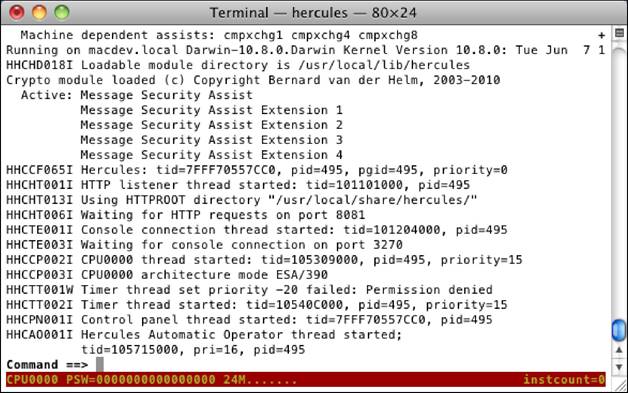 Figure 170:
Hercules Console Window
Have a look
at the second view of the Hercules console, switch to the second view with the
Esc key and back again.
Figure 170:
Hercules Console Window
Have a look
at the second view of the Hercules console, switch to the second view with the
Esc key and back again.

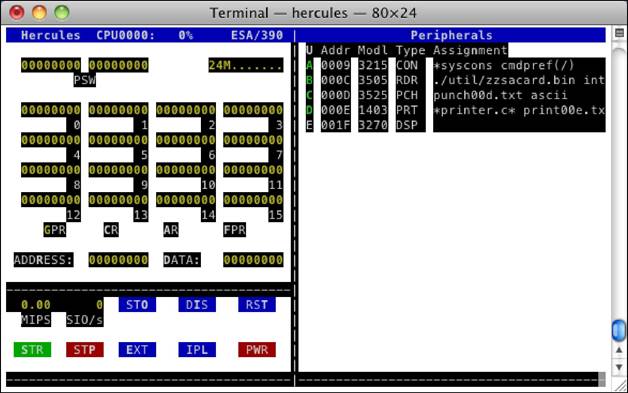 Figure 171:
Hercules Device and Status Display
Start your
preferred 3270 Client application and connect to Hercules (try “localhost” with
port 3270).
Figure 171:
Hercules Device and Status Display
Start your
preferred 3270 Client application and connect to Hercules (try “localhost” with
port 3270).

|
|
|
| “Th Hercules Terminal |
|
|
|
_Hercules Uersion : 3.08
Host name macdev.local
Host OS : Darwin-10.8.8
Darwin Kernel Uersion 18.8.8: Tue Jun ? 16:3 Host Architecture : i366
Processors : UP
Chan!
Subsys : 0
Device number : BB1F
Subchannel : 0884
HHH HHH The S/370, ESA/390 and
z/Architecture
HHH HHH Emulator
HHH HHH
HHH HHH EEEE
RRR CCC U U L EEEE SSS
HHHHHHHHHHHHHHHH E R R C U U L ES
HHHHHHHHHHHHHHHH EEE RRR C U U L EEE SS
HHHHHHHHHHHHHHHH E RAC U U L E
HHH HHH EEEE R R CCC UU LLLL EEEE
SSS
HHH HHH
HHH HHH
HHH HHH My PC
thinks it's a MAINFRAME
Copyright © 1999-2009 Roger Bowler, Jan Jaeger, and others
 en. 01/01 Wed 10 Apr 21:53
en. 01/01 Wed 10 Apr 21:53

 Figure 172: TN3270 Terminal
Start the Safari application and open the
link to Hercules (“<wrap>http:%%//%%localhost:8081</wrap>”).
Figure 172: TN3270 Terminal
Start the Safari application and open the
link to Hercules (“<wrap>http:%%//%%localhost:8081</wrap>”).

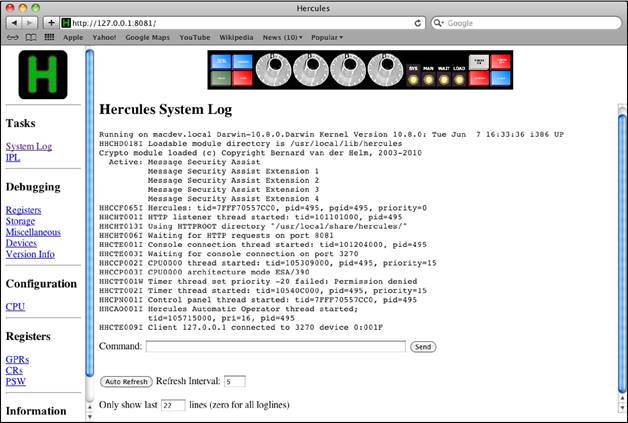 Figure 173:
Hercules Web Browser Interface
Start (IPL) the ZZSA editor card deck from the 3505 device 000C on
the Hercules console or from Safari.
If you are
interested in using Hercules Studio GUI for testing purpose, it is necessary to
change the ZZSA card file relative path to an absolute path name in the
“hercules.cnf” sample file.
000C 3505 ./util/zzsacard.bin
000C 3505
/Users/hercules/Projects/hercules-3.08/util/zzsacard.bin
Figure 173:
Hercules Web Browser Interface
Start (IPL) the ZZSA editor card deck from the 3505 device 000C on
the Hercules console or from Safari.
If you are
interested in using Hercules Studio GUI for testing purpose, it is necessary to
change the ZZSA card file relative path to an absolute path name in the
“hercules.cnf” sample file.
000C 3505 ./util/zzsacard.bin
000C 3505
/Users/hercules/Projects/hercules-3.08/util/zzsacard.bin







 Figure 175:
ZZSA Password Screen
Next the
ZZSA Primary Menu becomes available.
Figure 175:
ZZSA Password Screen
Next the
ZZSA Primary Menu becomes available.

|
|
|
| |
|
|
| Hercules Terminal 22SRPRIM Stand Alone Utilities Option ==⇒ _ 0 ListOev - List all devices 1 Browse - Browse dataset or member Console 881F/3278 2 Edit - Edit dataset or member IPL Device 080C/3585 3 ListVTOC - List Volume Table Of Contents IPL CPU 8808 |
4 ListPDS
|
- List PDS directory
|
CPU Versior FD
| | |
5 OispUol
|
- Display DASD volume label
|
CPU Serial
|
882623
| |
6 Oump
|
- Dump DASD record by CCHHR
|
CPU Model
|
3098
| |
7 Zap
|
- Alter DASD record by CCHHR
|
Date (TOD)
|
18/84/2813
| |
X Exit
|
- Terminate program
|
Time (TOD)
|
19:56:17
|
Jan Jaeger - Version 02/27/06-20.44
 en. 03/14 Wed 10 Apr
21:56
en. 03/14 Wed 10 Apr
21:56

 Figure 176: ZZSA Primary Menu
Select option “0” and
press the “Enter” key to get the ZZSA device list.
Figure 176: ZZSA Primary Menu
Select option “0” and
press the “Enter” key to get the ZZSA device list.

|
|
|
| |
|
|
| frs or) (Th Hercules Terminal 22SABROW Device List Command ==⇒ _ Line 8888 Col 8881 ********************************* Top of Data ********************************** SCH=0:0000 DEU=0009 CHP=00 CT=3215 |
SCH=0:000I DEU.000C CHP=00
|
CT=2821-01
|
01=3505-01
| |
SCH=0:0002 DEU=0000 CHP=00
|
CT=2821-01
|
DT=3525-01
| |
SCH=0:0003 DEU=000E CHP=00
|
CT=2821-01
|
01=1483-01
| |
SCH=0:0004 DEU=001F CHP=00
|
CT=3274-10
|
DT=3278-02
|
******************************** Bottom of Data ********************************
F3=End F5=RFind F7=Up F8=Down F10=Left
F11=Right
 BA. 02/15 Wed 10 Apr
21:56
BA. 02/15 Wed 10 Apr
21:56

 Figure 177:ZZSA Device List
Press “PF3” to end the current panel and going
back to the previous screen again.
Figure 177:ZZSA Device List
Press “PF3” to end the current panel and going
back to the previous screen again.

|
|
|
| |
|
|
|
rt, Hercules Terminal
22SRPRIM Stand Alone Utilities
Option ==⇒ _
0 ListOev - List all devices
1 Browse - Browse dataset or member Console 881F/3278
2 Edit - Edit
dataset or member IPL Device 080C/3585
3 ListVTOC - List Volume Table Of Contents IPL CPU 8808
|
4 ListPDS
|
- List PDS directory
|
CPU Versior FD
| | |
5 OispUol
|
- Display DASD volume label
|
CPU Serial
|
882623
| |
6 Oump
|
- Dump DASD record by CCHHR
|
CPU Model
|
3098
| |
7 Zap
|
- Alter DASD record by CCHHR
|
Date (TOD)
|
18/84/2813
| |
X Exit
|
- Terminate program
|
Time (TOD)
|
19:56:48
|
Jan Jaeger - Version 02/27/06-20.44
 en. 03/14 Wed 10 Apr 21:57
en. 03/14 Wed 10 Apr 21:57

 Figure 178: ZZSA Primary Screen
Figure 178: ZZSA Primary Screen
 27.3 Quit
ZZSA
Select option “X” and
press the “Enter” key to terminate the ZZSA program.
27.3 Quit
ZZSA
Select option “X” and
press the “Enter” key to terminate the ZZSA program.

|
|
| |
|
Hercules Terminal
| |
|
22SAWAIT Stand Alone Utilities
Loading disabled wait PSW
Program terminated.
Jan Jaeger - Uers i on 02/27/06-20.44
cal 01/01 Wed 10 Apr 2 I:57
|
Figure 179: Quit ZZSA
Finally
type “QUIT” or “EXIT” on the
Hercules console or from Safari to stop Hercules. Hercules will shut down now.

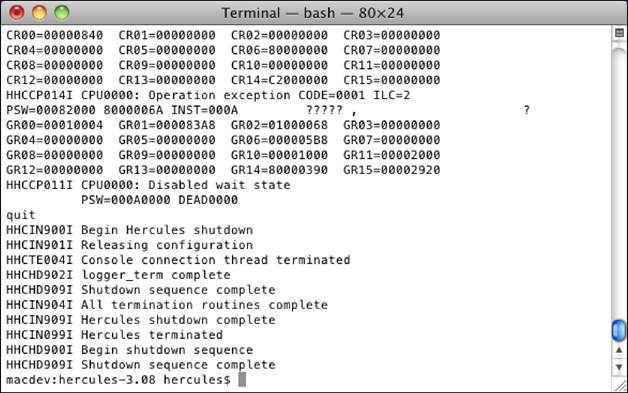 Figure 180:
Hercules Shutdown
If you
successfully followed the previous procedures then it can be assumed that
Hercules is working correctly.
Figure 180:
Hercules Shutdown
If you
successfully followed the previous procedures then it can be assumed that
Hercules is working correctly.

 Appendix A.
HQA – Hercules Build Configuration Quality Assurance
The HQA (Hercules Build Configuration Quality Assurance) feature
provides the ability to override the Hercules default build settings without
having to modify any of the Hercules source header files.
Please note that currently not all build settings can be
overwritten at this time. The HQA feature is still a work in progress.
Additionally
it is possible on Windows systems to override virtually any of the compiler
settings as well.
Appendix A.
HQA – Hercules Build Configuration Quality Assurance
The HQA (Hercules Build Configuration Quality Assurance) feature
provides the ability to override the Hercules default build settings without
having to modify any of the Hercules source header files.
Please note that currently not all build settings can be
overwritten at this time. The HQA feature is still a work in progress.
Additionally
it is possible on Windows systems to override virtually any of the compiler
settings as well.
 A.1 Build Options
Through HQA the Hercules build options can be overridden without
having to modify any of the Hercules source header files.
To override Hercules’s default build options, define an
environment variable called ‘HQA_DIR’, pointing to the directory where the
optional “hqa.h” override header file can be found.
Note: If the HQA_DIR path contains blanks, then do not surround it
with quaotes. The makefile will do that if it needs to. Just define the
variable with the path as-is. Example:
HQA_DIR = <wrap>C:%%\%%My</wrap>
Projects\Hercules\My HQA directory
Instead of defining an environment variable it’s also possible to
specify the new “–enable-hqa” configure option (under Linux) or new “-hqa”
makefile.bat option (under Windows).
Within the “hqa.h” override header either #define the
‘HQA_SCENARIO’ macro to one of the pre-defined values in Hercules’s “hqadefs.h”
header file or simply define (“#define”) an own custom build scenario. These
values will then override the default values of Hercules.
The
pre-defined scenarios are:
|
A.1 Build Options
Through HQA the Hercules build options can be overridden without
having to modify any of the Hercules source header files.
To override Hercules’s default build options, define an
environment variable called ‘HQA_DIR’, pointing to the directory where the
optional “hqa.h” override header file can be found.
Note: If the HQA_DIR path contains blanks, then do not surround it
with quaotes. The makefile will do that if it needs to. Just define the
variable with the path as-is. Example:
HQA_DIR = <wrap>C:%%\%%My</wrap>
Projects\Hercules\My HQA directory
Instead of defining an environment variable it’s also possible to
specify the new “–enable-hqa” configure option (under Linux) or new “-hqa”
makefile.bat option (under Windows).
Within the “hqa.h” override header either #define the
‘HQA_SCENARIO’ macro to one of the pre-defined values in Hercules’s “hqadefs.h”
header file or simply define (“#define”) an own custom build scenario. These
values will then override the default values of Hercules.
The
pre-defined scenarios are:
|
·
|
Scenario 0
|
Reserved for normal builds
| |
·
|
Scenario 1
|
System/370 support only
| |
·
|
Scenario 2
|
ESA/390 support only
| |
·
|
Scenario 3
|
System/370 and ESA/390 support only
| |
·
|
Scenario 4
|
z/Architecture and ESA/390 support only
| |
·
|
Scenario 5
|
Windows fthreads
| |
·
|
Scenario 6
|
Windows posix threads
| |
·
|
Scenario 7
|
Vista fthreads
| |
·
|
Scenario 8
|
Vista posix threads
| |
·
|
Scenario 9
|
INLINE == forced inline
| |
·
|
Scenario 10
|
INLINE == inline
| |
·
|
Scenario 11
|
INLINE == null
|

 A.2
Compiler Settings (Windows)
Note: The following section applies only to Windows.
On Windows
systems it is possible to override virtually any of the compiler settings via a
‘HQA.msvc’ nmake include override file. In the ‘HQA.msvc’ file the ‘$(cflags)’
variable can be modified to add, remove or change every compiler option to the
desired value.
A.2
Compiler Settings (Windows)
Note: The following section applies only to Windows.
On Windows
systems it is possible to override virtually any of the compiler settings via a
‘HQA.msvc’ nmake include override file. In the ‘HQA.msvc’ file the ‘$(cflags)’
variable can be modified to add, remove or change every compiler option to the
desired value.

 Appendix B. Links
·The Hercules System/370, ESA/390, and z/Architecture Emulator
Appendix B. Links
·The Hercules System/370, ESA/390, and z/Architecture Emulator
<wrap>http:%%//%%www.hercules-390.eu</wrap>
·Hercules source code repositories
<wrap>https:%%//%%github.com/rbowler/spinhawk</wrap> (release
3.xx development stream)
<wrap>https:%%//%%github.com/rbowler/sandhawk</wrap> (release
4.xx development stream)
<wrap>https:%%//%%github.com/hercules-390/hyperion</wrap> (cutting-edge
developer sandbox)
·Hercules Developer Snapshots (Dave Wade)
<wrap>http:%%//%%www.smrcc.org.uk/members/g4ugm/snapshots/</wrap>
·Hercules PDF Documentation (Peter Glanzmann)
<wrap>http:%%//%%hercdoc.glanzmann.org</wrap>
·The MVS Tur(n)key System, Version 3 (Volker Bandke)
<wrap>http:%%//%%www.bsp-gmbh.com/turnkey/index.html</wrap>
·Hercules WinGUI (“Fish”, David B. Trout)
<wrap>http:%%//%%www.softdevlabs.com/Hercules/hercgui-index.html</wrap>
·CTCI-WIN (“Fish”, David B. Trout)
<wrap>http:%%//%%www.softdevlabs.com/Hercules/CTCI-WIN-index.html</wrap>
·Hercules Studio (Jacob Dekel)
<wrap>http:%%//%%www.mvsdasd.org/hercstudio</wrap>

·Hebe – Hercules Image Manager (Robin Atwood)
<wrap>http:%%//%%kde-apps.org/content/show.php/Hebe?content=126738</wrap>
·WinPcap, Politecnico di Torino
<wrap>http:%%//%%www.winpcap.org</wrap>
·Vista tn3270, Tom Brennan Software <wrap>http:%%//%%www.tombrennansoftware.com</wrap>
·X3270, Paul Mattes
<wrap>http:%%//%%x3270.bgp.nu</wrap>
·AWSBROWSE (“Fish”, David B. Trout)
<wrap>http:%%//%%www.softdevlabs.com/Hercules/hercgui-index.html</wrap>
·XMIT Manager
<wrap>www.cbttape.org</wrap>
·CBT MVS Utilities Tape (CBTTAPE)
<wrap>www.cbttape.org</wrap>
·Microsoft Visual C++ 2008 Express <wrap>http:%%//%%www.microsoft.com/express/download/</wrap>

·ZLIB
<wrap>http:%%//%%www.zlib.net</wrap>
<wrap>http:%%//%%www.softdevlabs.com/Hercules/ZLIB1-1.2.3-bin-lib-inc-vc2008-x86-x64.zip</wrap>
·BZIP2
<wrap>http:%%//%%www.bzip.org</wrap>
<wrap>http:%%//%%www.softdevlabs.com/Hercules/BZIP2-1.0.5-bin-lib-inc-vc2008-x86-x64.zip</wrap>
·PCRE
<wrap>http:%%//%%www.pcre.org</wrap>
<wrap>http:%%//%%www.softdevlabs.com/Hercules/PCRE-6.4.1-bin-lib-inc-vc2008-x86-x64.zip</wrap>
·Regina REXX
<wrap>http:%%//%%regina-rexx.sourceforge.net/</wrap>
·Open Object Rexx (ooRexx)
<wrap>http:%%//%%www.oorexx.org/</wrap>

|
Hercules Emulator
|||| | |
|
|||
| |
|
|
| |
|| | |
Hercules System/370, ESA/390,
z/Architecture Emulator
Installation Guide
Version 4 Release 00
|||| | |
HEIG040000-00









